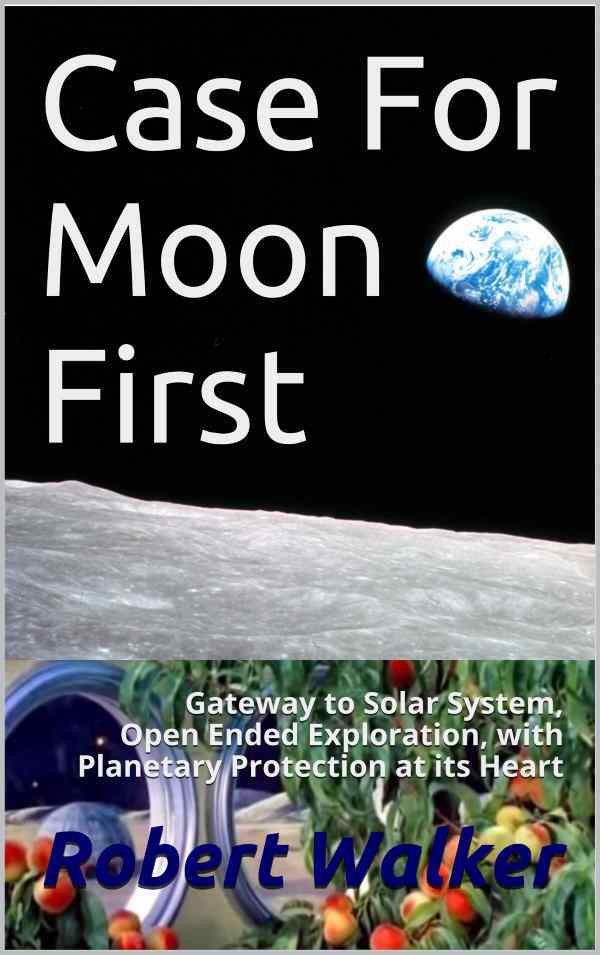
Gateway to Entire Solar System - Open Ended Exploration, Planetary Protection at its Heart
Copyright © Robert Walker
(UK). All rights reserved.
(See high resolution version of this cover picture)
Cover picture shows the famous Earthrise photograph taken by Apollo 8, the first mission to orbit the Moon, on Christmas eve, 1968, together with a detail from the 1965 Russian film Luna).
First Publishing on Kindle: April 2016
You can also get this on kindle - first published 2016. You can read an extended executive summary on my Science20 blog. For my other kindle booklets, see my author page on Amazon.com. You might be especially interested in my related books:
You don't need a kindle device to read these books. Amazon has developed kindle reading apps, These run as a separate application, and lets you use any computer (iOS, Android, Mac or PC) in the same way as the kindle device, with the book set out in the same way, turning pages in the same way etc. You can get them here: Free Kindle App.
You can also buy the book on kindle as a way of showing your support and appreciation. Every sale boosts its ranking in the kindle bookstore temporarily. For instance, two or three sales are enough to put it on the first or second page of kindle best sellers for Mars, for a few days.
You can also support my work as a science blogger and writer of these books via Patreon.
The main sections of this book are:
(skip to detailed contents)
(skip to contents) (Links in the text in this preface take you to other sections of this book)
You may have heard advocates say we should ignore the Moon, and head straight for Mars, and they may even say that the Moon is as dull as a ball of concrete. But what about the other view, put forward by many enthusiasts for the Moon, that we should start there instead,as the first place to send humans after LEO? As you read this book, you may be surprised to learn that the Moon is resource rich, and fascinating, with many new discoveries since the time of Apollo, as well as many mysteries still to solve. It may have potential for exports of metals and volatiles. It's also far more promising for tourist hotels, and human research stations, because it is so much easier to get to than Mars, it's a great place for radio and infrared telescopes, and it's potentially valuable as a place to make computer chips and solar cells that require high vacuum, amongst other benefits. And it may surprise you a lot to learn that the Moon has many advantages over Mars as a place to create habitats for humans too.
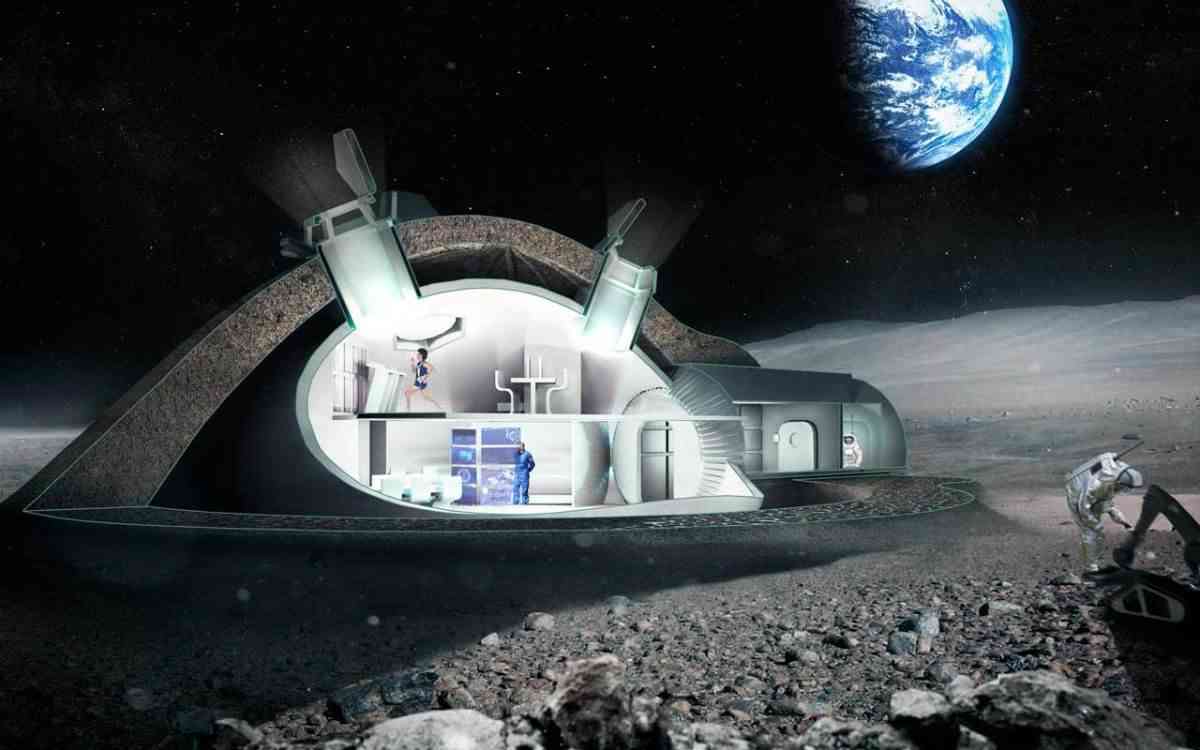
Inside look at one of the ideas for the ESA moon village, using 3D printing on the Moon for the radiation shielding. Image credit Foster + Partners / ESA. Their new director, Professor Johann-Dietrich Woerner is keen on taking us back to the Moon first, and has an exciting vision for a lunar village on the Moon as a multinational venture involving astronauts, Russian cosmonauts, maybe even Chinese taikonauts, and private space as well.
That's actually the plan of the ESA, India, Japan, China etc, they all want to send humans back to the Moon first. Many US astronauts and space enthusiasts think the same way, but their voice doesn't get heard so much in the States. Even Buzz Aldrin, a keen Mars colonization advocate, didn't entirely agree with the way Obama quoted his "Been there and done that" saying he meant it facetiously.
You need to look at the Moon with "Moon spectacles" and when you do, in one comparison after another, the Moon comes out top. It's also close enough to scout out with robots controlled in near to real time from Earth. Then once we decide on a site for our base, we can use them again to get our lunar village ready, with the habitats, utilities, landing beacon and landing pad all in place, before our first astronauts arrive.
The Apollo astronauts were like the early Antarctic explorers, who set their first footprints on an almost entirely unexplored territory, this time in space. Though none of them died in space or on the Moon, their missions were risky and new missions back to the Moon will be also.
Nevertheless, the Moon is a far safer destination than Mars. We know we can do it, and we can set off at any time, with lifeboats to get us back to Earth within three days in an emergency. A mission to Mars would be a multi-year journey with no lifeboats. An Apollo 13 type accident could not be survived, and a mistake which just leads to the crew abandoning their base on the Moon would kill everyone at the distance of Mars. This also makes the Moon a place where we can try much more adventurous ideas and experiments with methods of living there.
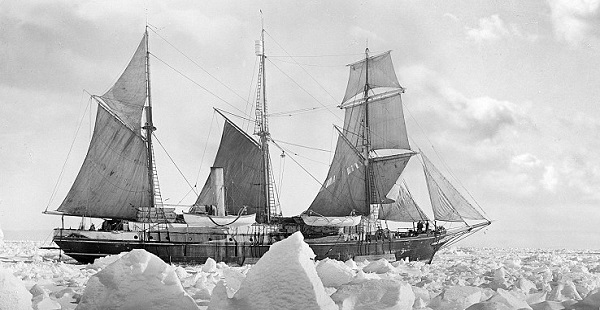
Shackleton's Endurance trapped in the ice in Antarctica before it sunk. Shackleton's part overwintered huddled beneath boats and hunting seals for food. Antarctica is far more habitable than Mars, and back then, before the Antarctic treaty, the whole continent was open for colonization, if anyone had been interested, but there were no efforts by any nation to colonize Antarctica. We don't colonize all the possible places where humans could survive.
The enthusiasts for Mars colonization present a rosy picture of a colonized Mars and they think that we will succeed in colonizing their favourite planet, so long as we start on it quickly. But there are many places on Earth that we don't colonize. Indeed, to date, we have only tried to colonize places where humans can survive with stone age technology. What's more, many colonization attempts even of those places have failed.
To go to space to colonize, right now, is like Shackleton saying "Great, we have overwintered on Antarctica, hunting seals and huddling under boats, we must be ready to colonize it!".
Let's go to space like the early Antarctic explorers instead, to find out what's there. Along the way we can discover if there is anywhere to set up home, and we don't know in advance that Mars is that place. For instance, perhaps we may find vast lunar caves, kilometers wide and over 100 kilometers in length, as the Grail data suggests, as vast as an O'Neil Cylinder. If so, these could be amongst the easiest and safest places to build habitats in space. Or perhaps habitats at the lunar poles are best, because of the volatiles we know are there, or as a more out there proposal, the idea of Venus cloud colonies may have more to recommend it than you think. Then there's the 1970s idea of living in large slowly spinning habitats built with materials from the Moon and the asteroids.
Another reason given to head off to Mars as quickly as possible is to "backup Earth". But what plausible near future disaster could end up with an Earth less habitable than Mars, with its perchlorate laced dust storms, solar storms of deadly radiation, half the sunlight of Earth, all fresh water frozen into ice like Antarctica, no oxygen to breathe, and the air so thin that the moisture lining your lungs would boil, without a full body pressurized spacesuit?
If we ever need to restore anywhere with a backup of seeds, technology, and knowledge, it's Earth that we'd restore, not Mars. That makes the Earth itself, or the Moon, the ideal places to keep these repositories.
And if we do send humans to Mars, why not study it telerobotically from its moons or from orbit first, in a shirt sleeves environment? Why rush to the surface as quickly as possible, and risk a human crash in the one place in the inner solar system most vulnerable to Earth microbes? I would be the worst possible anti-climax in the search for life in our solar system to get there only to discover life that we brought ourselves.
In this vision, human space exploration is open ended. We have the entire solar system to explore with our missions, from Mercury all the way out to Jupiter's moons and beyond. The Moon is our gateway and natural starting point for this exploration. And there's no rush; we can afford to keep our future options open as we explore and find out what the possibilities are.
This book is also available on kindle
Skip to contents list. (Most of the links in this section take you to appropriate sections of this booklet)
If you prefer to listen to it, here I am reading out the executive summary:
The Moon is our nearest unexplored territory outside Earth. To ignore it is like ignoring Antarctica after the first few landings in the nineteenth century. Why rush humans as quickly as possible to distant Mars, the one place in the inner solar system most vulnerable to Earth microbes?
"If such capabilities were to become available, one advantage is that the experiment would not be limited by the small amount of material that a Mars sample return mission would provide. What is more, with the use of rovers, an in situ experiment could be conducted over a wide range of locations." (Page 41 of Safe on Mars)These are now the most effective way to search for Mars life, past and present (as eight exobiologists said in a white paper for the decadal review). With our recent complex understanding of Mars processes, a sample return will not prove that Mars is safe for humans, or that humans are safe for Mars. Find out more
The Moon in this vision is a gateway to the solar system, a place to develop new techniques and explore a celestial body that is proving much more interesting than expected. Along the way, we are bound to get human outposts in space, and colonization may happen also.
However, settlement in space doesn't need to be the driving force, any more than it is the driving force behind the study and exploration of Antarctica. If we try to turn Mars and other places in space into the closest possible imitations of Earth as quickly as possible, this may close off other futures, like the discovery of vulnerable early life on Mars, or better future ways to transform Mars.
Once we develop the ability to live in space for years at a time, the whole solar system will open out to us. While keeping future options open on Mars we can explore Venus, Mercury, asteroids, Jupiter's Callisto and further afield, and Mars itself via telepresence. We also have many experiments in human settlement to try closer to hand on the Moon. This can be an exciting future, with humans working together with robots for remote exploration, as our mobile sense organs and hands in the solar system and galaxy.
If you are keen on Mars colonization, it is not hard to find a future vision to inspire you. Elon Musk has plans to send a hundred people at a time in his proposed "Mars Colonial Transporter" and to found a city of 80,000, and eventually a million. He is due to reveal these plans at the IAC conference this September. And NASA, though they don't have such a large scale vision, aim to land human boots on Mars, with an eye to permanent Mars settlement in the future. You can also join the Mars society and read the books of Robert Zubrin.
But what if you are keen on humans in space, but don't think we have any realistic chance of colonizing the planet? What if you love science, and think "boots on Mars" has significant planetary protection issues? What can your future vision be? You have to go back perhaps to O'Neil's "Colonies in Space" vision of the 1970s to find an alternative that has the same level of positive inspiration as this Mars colonization idea.
This book presents a gradually evolving alternative that I think can be a positive future inspiration, based on the Moon as our next place to visit and start permanent settlement rather than Mars. Although it builds on the detailed plans of "Moon firsters", such as Paul Spudis, Dennis Wingo, Madhu Thangavelu and David Schrunk, this vision is perhaps more open ended, with new goals that we discover along the way, and has planetary protection as a core principle, indeed as one of the many reasons for focusing on the Moon before Mars, and Mars exploration from orbit before we consider sending humans to the surface.
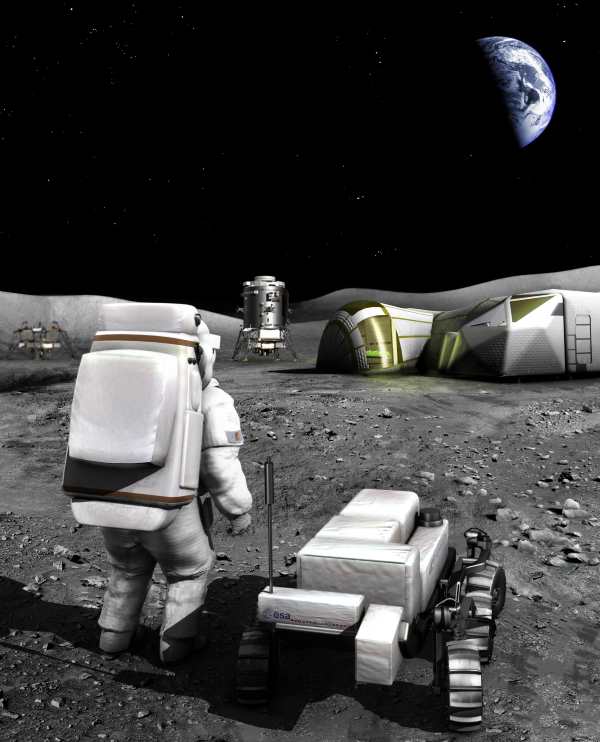
ESA image from blog post: Lunar Surprises - ESA rocket science blog
Are you keen on humans in space, but think Mars could be a step too far right now? Do you think we are bound to need to support our space settlements from Earth for a fair while into the future, just as we do for inhospitable places such as Antarctica? Do you think our exploration should be open ended with science as a core objective, and planetary protection and reversible biological exploration as core principles?
Do you see the Moon as an exciting first place to visit and explore, and see robots as our mobile sense organs in the solar system? Do you think that it's not quite yet the right time to relax planetary protection guidelines, and don't want to make Mars more vulnerable to Earth life?
Then this may be a vision for you. And if not, well I think you may still find much here of interest and perhaps may get many surprises.
This is the ESA video about ideas for small robotic missions first, followed by Antarctic base type settlements on the peaks of (almost) eternal light at the lunar poles.
I use ESA as my main example here and throughout this book, because they seem to have the most developed ideas for a Moon base of any of the space agencies currently. What's more, they are actively pursuing their idea of a moon village, with a reasonable chance of success, since it's based on many established international partnerships.
That includes their partnership with Russia. Then, though currently NASA say that they won't send any astronauts to the lunar surface, they are open to partnerships in other ways. ESA are already committed to partner with the US in their Exploration Mission 1 / 2 to enter a distant retrograde orbit around the Moon, and they can also partner with India, Japan, and even China, which I think adds to their chances of success.
They are also open to partnership with commercial space and private ventures as well as government space agencies. Of course we could get many surprises in the future, for instance who can tell whether the next president of the US might change direction again and decide to go "back to the Moon", but on the basis of the situation as of writing this, I'd bet on ESA as the most likely to set up a Moon colony, if I was a betting man.
This is the ESA director general Jan Woerner talking about his ideas.
This is their plan for the base itself
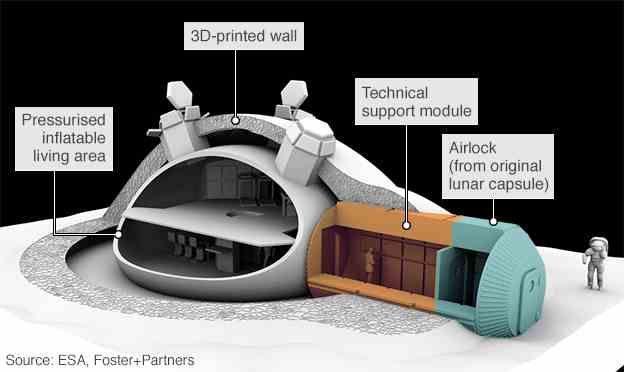
And this is how they would build the base with 3D printers on the Moon
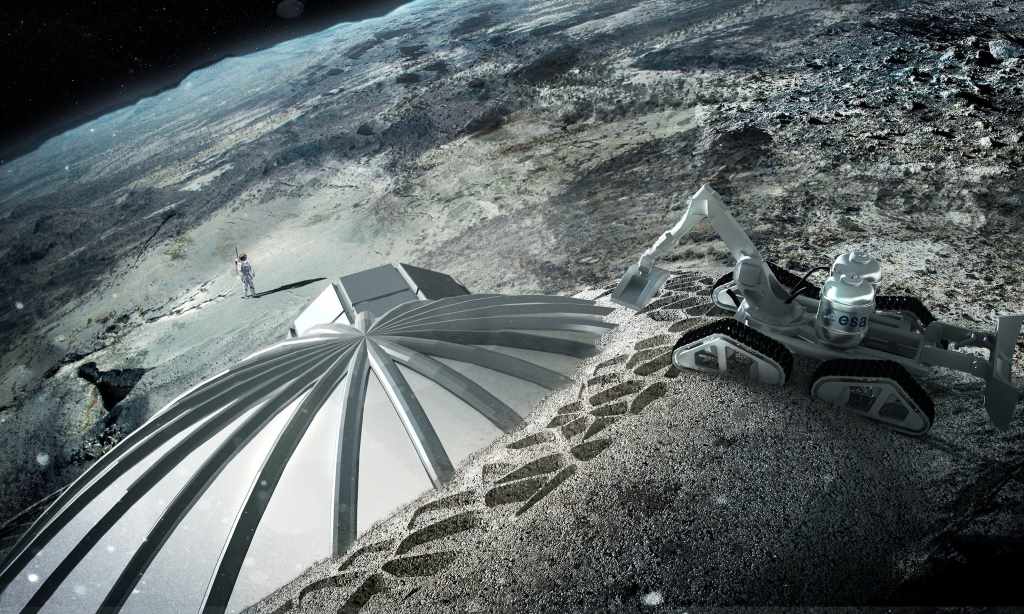
Adding regolith shielding to one of the habitats (using robots controlled telerobotically from Earth). Photograph ESA / Foster + Partners.
For techy details see: Lunar Outpost Design, 3D printing regolith as a construction technique for environmental shielding on the moon
For more about the advantages of this village idea, see also the section below: How an international lunar village saves money, and is safer than separate bases spread out over the Moon, through use of communal resources
In the process we will find out what humans do best, and what robots do best, starting off with robots first, and then humans on the Moon. Then we can continue outwards in an open fashion, building on what we've learnt.
Meanwhile, we continue to explore Mars robotically from Earth, as well as many other interesting places in our solar system, including Venus, Mercury, Europa, Enceladus, Titan, comets, asteroids and so on. Later, once we have the capability, we can send humans to explore Mars telerobotically, perhaps first though "free return" flyby missions, then from orbit, then perhaps explore Mars from bases on its two moons Phobos and Deimos, and explore its moons themselves. These would be only some of many future human based missions, eventually spanning the entire solar system.
In this approach, science and planetary protection is central. Space settlement happens because you are there for a purpose. As with the Antarctic bases - once we are there with good science as the motivation, it would naturally become a permanent outpost and a first step into space.
Missions motivated by science continue to grow, and engage the public. There is no suggestion that we should stop exploring Antarctica because of the cost of doing science there. What's more, scientifically motivated missions can have overwhelmingly positive outcomes too, especially if we make new discoveries about biology and evolution.
However it's not enough to just say this. We need to try to provide a much more detailed vision. It needs to address the idea that Mars is the obvious next place to go, and somehow provide an alternative vision that is as compelling as that to the human imagination. That's quite a tough task.
If you don't think we have a realistic chance of colonizing Mars, you can present your reasons for skepticism to colonization enthusiasts. You can say that it is sure to be much harder to live on Mars than to set up home in Antarctica, the Atacama desert, or the top of Mount Everest. You can point out that Mars is currently far more like the Moon than it is like Earth in terms of habitability, with its laboratory vacuum for an atmosphere (similar to Earth's atmosphere at 30 kilometers upwards), hard radiation, and extremes of cold.
You can mention that (though it can get warm in the daytime), it gets so cold at night that carbon dioxide freezes out in dry ice / water ice frosts for 200 nights of the year even at the equator. You can point to the additional issues of the global dust storms that can sometimes blank out the sun for weeks on end, and harmful perchlorates in the dust.
I think everyone agrees with all those points. The difference is that prospective colonists see them all as challenges to be overcome, rather than as reasons not to colonize the place. They will point you in the direction of Robert Zubrin's books explaining how it would be done.
You can go on to ask, would that really work as a place where a million people, or even a thousand people could live and be self sufficient without constant expensive resupply from Earth? Would we really colonize the near vacuum extreme conditions of Mars, when we don't even colonize deserts on Earth? However, a keen Mars colonization enthusiast will answer "Yes!" emphatically. Somehow all these problems will be solved, they say, and we will have colonies on Mars.
I found, when writing this book , that the Moon is resource rich, and often beats Mars in habitability comparisons. Yet photos of Mars released to the press look so much more Earth-like, because of the brightening of the landscape and boosting of blue in the scene (white balancing) done to help geologists read the rocks. Many of them even have blue skies instead of the grayish brown skies natural to Mars.
So, what if we did the same with photos of the Moon, gave it blue skies too, like many of the Mars press photos? It's easy to do because the surface is already lit up just as it would be for a sunny day on Earth. We don't need to do anything else, just colour the sky blue instead of black, and it looks Earth-like already. I was amazed at what a difference such a simple change makes to the feel of the scene. You can read it as if illuminated on a sunny day, which is indeed what it was like for the Apollo astronauts.
So, here they are. These images are not altered in any way. All I've done is to crop them, and replace the black skies with photographs of blue skies and clouds from Earth.
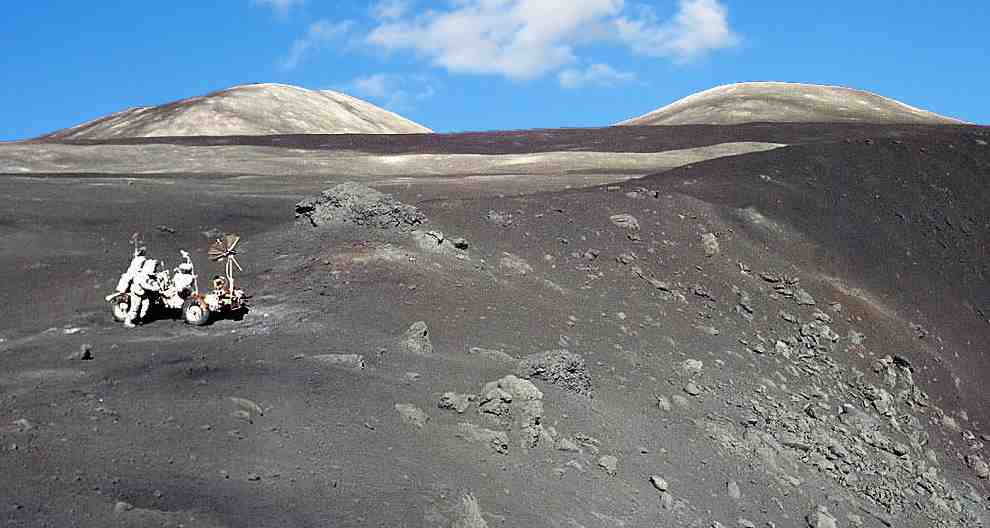
Original here Apollo 17 at Shorty Crater - blue sky from here
Original here, sky from here

Original here, sky from here
For more examples, see my article: What If The Moon Had Blue Skies? One Small Change To Apollo Photos
It suddenly looks much more Earth-like. Yet it's a vacuum there. The thing is that of course it was a sunny day for the astronauts - you tend to forget when you see the black sky. On Earth some of the light comes to the landscape from the sun and some reaches us indirectly from the blue sky and the clouds.
On the Moon, much of the light comes from the sun, but a lot of light also comes indirectly from the landscape itself. That's why you can see detail in the shadows, and why they aren't completely black on the Moon. So - it's not quite so surprising as you'd think, but fun.
You can make the photos look even more like Earth by reducing the contrast - shadows are not quite so contrasty on Earth. I tried that and it worked. You could also fuzz the edges of the shadows as they are never so sharp edged on Earth, and you'd need to do something about the black sky reflected in astronaut's helmets. However I'm not trying to simulate an Earth illumination on the Moon. I don't have the skills anyway, there are graphics designers, artists, 3D modelers etc who could do a much better job.
But that wasn't my aim here. The aim was to show how the Moon is as Earth like as Mars in photographs, and indeed more so, with minimal processing, not even the white balancing they use for Mars photos. So to do additional processing to make it look more Earth like would rather defeat the point in the article. Perhaps others will do that in the future.
It's similar on the Mars surface, it is nearly as much of a vacuum as the Moon as far as humans are concerned. The moisture lining your lungs would boil there. Mars is not really significantly more "Earth like" than the Moon, I think.
This is a colour enhanced Mars image as you would see it in most press photos - enhanced for the purposes of geologists, so that the rocks look like the same types of rocks under Earth illumination. There are two ways to do this. The most common method is white balancing which takes the brightest patch in the scene, and adjusts it in brightness and hue until it is white. The other method, occasionally used, is natural colour which uses a calibration based on photographs of a colour swatch on Curiosity that was previously photographed on Earth.
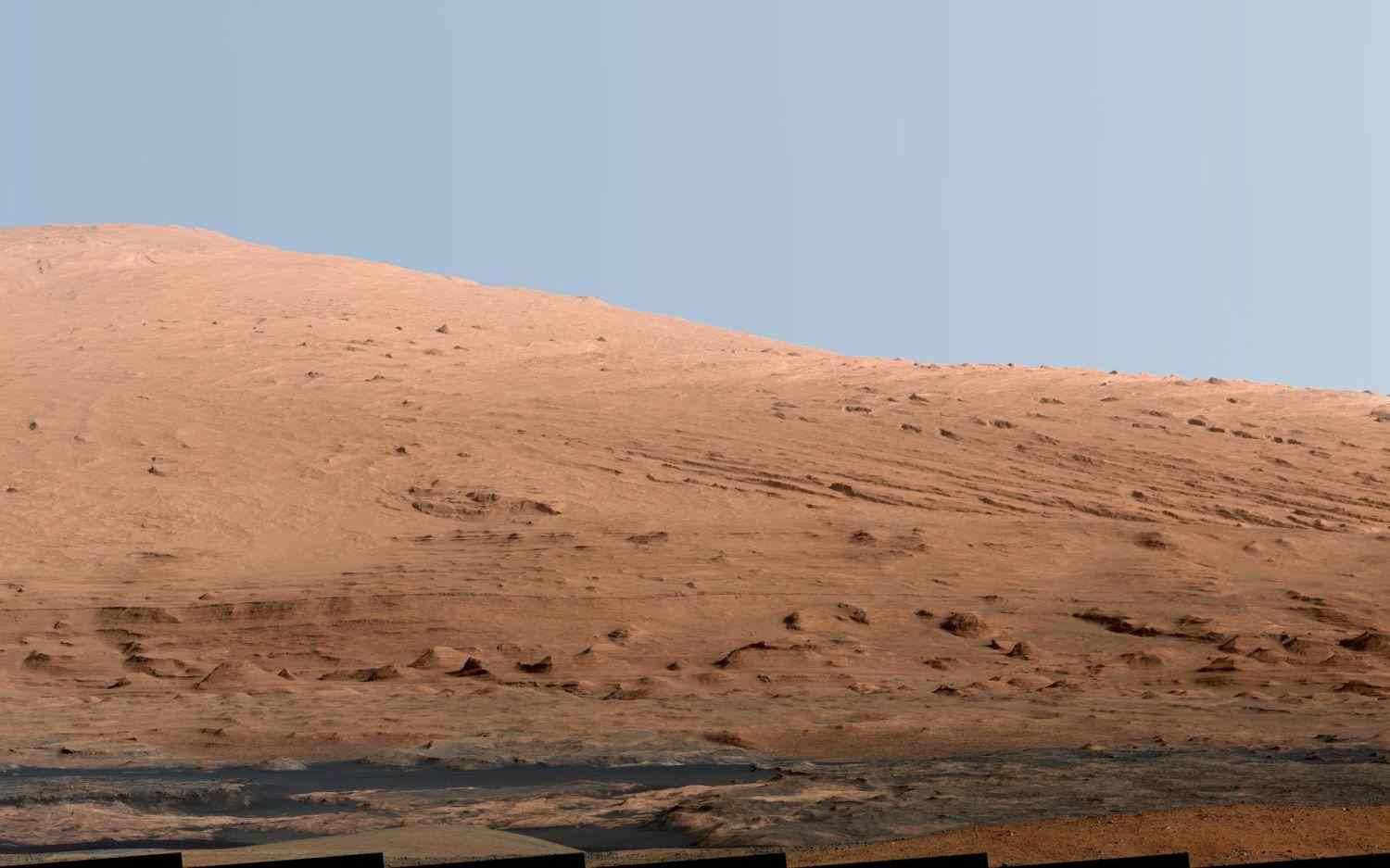
This is what Mars would look like to a typical smartphone camera, the raw image from Curiosity (both these photos are of Mount Sharp)
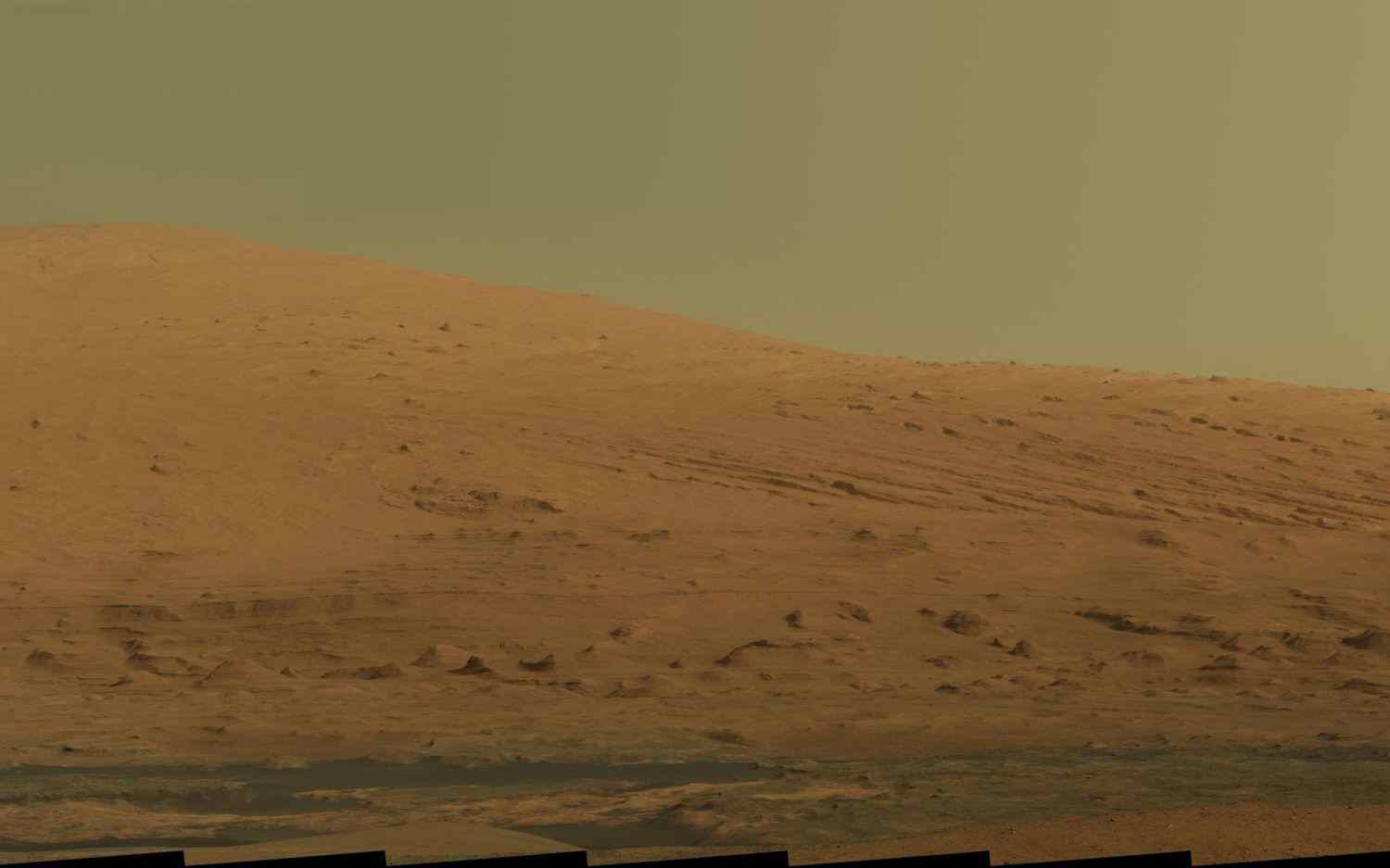
Photos from here
I think the Moon would be a more interesting landscape to a human eye. Much brighter - which tends to make humans feel cheerful. While the sunlight on Mars at its brightest is half the illumination of Earth, and as well, it's a dull brown in colour with the Mars dust suspending in the air filtering out the blue. It has no blue sky except around the sun at sunset. Also there is very little variation in colour in the landscape. It's mainly dull grayish browns, with no blue and none of the bright glints catching the sunlight we have on Earth. I think that any Mars colonists would have a tendency towards depression just because of the rather gloomy sky and dull coloured landscape.
I'll go into other aspects of this later on, but perhaps we should address this right away as it's become the top reason to attempt to colonize Mars for many people. Elon Musk has been promoting it strongly. Stephen Hawking has also said this is an important reason to go multiplanetary. In this account of an interview with Elon Musk, the author Ross Anderson presents it as:
"A billion years will give us four more orbits of the Milky Way galaxy, any one of which could bring us into collision with another star, or a supernova shockwave, or the incinerating beam of a gamma ray burst. We could swing into the path of a rogue planet, one of the billions that roam our galaxy darkly, like cosmic wrecking balls. Planet Earth could be edging up to the end of an unusually fortunate run."
But there are no figures here. So let's supply them. Calculation indented, and coloured dark red, to make it easy to skip:
There's a formula, we can use here, from Perturbation of the Oort Cloud by Close Stellar Approaches. Our sun has approximately 4.2×D2 encounters with other stars every million years where D is the diameter in parsecs of the region. Neptune's semi major axis is 4.49506 billion kilometers so the diameter of its orbit is around 0.00029135 parsecs. So, using that formula, every million years there is 1 chance in 1/(4.2×0.00029132) of a star passing closer to the sun than Neptune.
That makes it about one chance in 2.8 million of a star passing closer to the sun than Neptune every million years. There may be twice as many rogue planets as stars, so that means one chance in 1.4 million of one of those passing closer to the sun than Neptune in the same time period. Neutron stars are even more unlikely. So we don't need to worry about any of these on the thousands of years timescale. The chances is less than one in a billion in the next thousand years that another star gets as close as Neptune.
Gamma ray bursts are possible also, but would not make humans extinct, even if very close. Our atmosphere completely shields us from gamma rays, which is why gamma ray telescopes have to be flown in space. We can only see gamma ray bursts at all with space observatories. The main effect is on the upper atmosphere and particularly the ozone layer. There was a theory at one point that this could through various interactions lead to increased nitrous oxide levels which could then lead to elevated ozone layers at ground level and so cause extinctions. However that theory has been shown to be false by more detailed modeling. Research announcement from NASA here: How Deadly Would a Nearby Gamma Ray Burst Be? Paper itself is here.

The gamma ray burst not only reduces the amount of ozone in the upper atmosphere. It also creates ozone depleting nitrogen oxides. They took the example of a gamma ray burst which hits the south pole most severely, as that has down drafts of air constantly. Those would bring the nitrogen oxides down to the lower atmosphere which is why you see the red regions descending with time. This causes a series of pulses of ozone depletion in the upper atmosphere which then leads to increases of ozone at sea level as the red regions let more UV through to the lower atmosphere. The model assumed a 100kJ/m2 burst from the direction of the South Pole, for a gamma ray burst within a few thousand light years of Earth (that’s very close compared to the diameter of the galaxy of 100,000 light years).
So could this raise the ozone levels enough to be harmful to life? The answer from this study was no. A very nearby gamma ray bursts could raise the ozone levels at ground level temporarily to 10 ppm. To be harmful to animal life it would need to reach 30 ppm. It is also not enough to be harmful to ocean life. Even if all the ozone created at ground level got absorbed in the sea, it would not be enough to be harmful to ocean life. So this disproves the hypothesis that a gamma ray burst could be the cause of the late Ordovician mass-extinction.
The idea that gamma ray bursts could cause extinctions at all, on any scale, is now not easy to establish. The main effect would be elevated levels of UV for a number of years. At any rate, if perhaps some other species were affected, they would not make humans extinct. Also the young Wolf Rayet stars which are gamma ray burst candidates are rare and of the hundred or so known, only one seems to be pointing our way. That's WR104, 8,000 light years away.

It looks as if it is facing us nearly face on. But spectroscopic observations of the star suggest it’s axis is at an angle of 30° - 40° (possibly as much as 45°) which would mean it would miss. See WR 104 Won't Kill Us After All - Universe Today
For more details see my Debunked: A gamma ray burst could make humans extinctIt's the same also for a nearby supernova. They are short, violent events, and again we are protected by our atmosphere from the worst effects, equivalent to ten meters depth of water in mass above us. See What’s a safe distance between us and an exploding star? And for more details, the paper here: Could a nearby supernova explosion have caused a mass extinction? They find that a supernova within 32 light years (ten parsecs), which should happen every few hundred million years would not heat up Earth significantly, would not be bright enough to harm the ecology through the light alone. In the year after the event you’d get as much ionizing radiation as you get normally in between a decade and a century. So the increase in ground level ionizing radiation is significant but it doesn’t seem to be enough to be devastating.
Also, are there any nearby supernova candidates? We can't predict when a star will go supernova exactly, but the only stars that can go supernova are ones that are at a particular stage in their life, and they have to be massive too, for Type II supernovae, and for type Ia it needs a white dwarf companion. Our sun can't go supernova at all, it's too light.
The Type II supernova candidates are easiest to see, bright massive stars, larger than our sun, which collapse to a neutron star or black hole at the end of their lifetime. Betelgeuse will explode some day, and we know this for sure. It could be today, but much more likely to be a long time into the future. It could be a million years from now. But it is far too far away to be any problem for Earth, nor is it close enough to be a second sun in our sky. It will just be a very bright star for us. It will be an interesting sight for astronomers, as a great chance to study a supernova close up. For everyone else, just a very bright star. Briefly, the brightest star in the sky. Betelgeuse will explode someday. Eta Carinae is another star that can go supernova. It’s a “blue supergiant” - which shows it’s not just red giants that can go supernova. This is a very young, super hot star 8,000 light years away and it may explode in the next few hundred thousand years. It’s also far to far away to harm us.
The other type of supernova is a Type Ia supernova (with some variations on it). A red giant star dumps gas on a white dwarf companion. These used to be the "dark horses" which we couldn't detect easily, leaving the possibility that there might be a nearby one that would cause problems. But with all the modern sky surveys, we now know that there are no nearby candidates for a type Ia supernova either. The closest is IK Pegasi which at 150 light years away is far too far away to harm us. It’s moving away from us and the scientists think it won’t go supernova for several million years, by which time it will be perhaps 500 light years away. It would need to be within 30 light years to be harmful. There are type Ib and type Ic supernovae too, These happen when a star loses its outer envelope, for instance to a companion star - and then the naked core collapses. Type Ib and Ic supernovae. But there are none of those nearby either.
Here is a list of the nearby List of supernova candidates See also: The closest supernova candidate? - Bad Astronomy So, though a nearby supernova within 30 light years could harm our ozone layer, right now there are no candidate stars that could go supernova, that are close enough to harm us. We get supernovas quite often and they leave rather beautiful remnants. Roughly once a century, though many are so obscured by dust and gas that they can't be seen with the naked eye from Earth. For instance Cassiopeia A which was recorded in the mid seventeenth century as very faint sixth magnitude star by John Flamstead on August 16 1680, he didn’t know what it was. For more details see my Debunked: Earth is threatened by a supernova
For those that worry about such things, I'd like to just add, that both of these are extremely unlikely events, and there are no known stars likely to go supernova close enough to be a hazard right now. The next supernova is most likely to be thousands of light years away, since we can spot them so far away. They are rare events that happen occasionally in an entire galaxy, and can be seen from an immense distance, and are most often spotted in distant galaxies as well.
The important thing is, that none of these would make Earth less habitable than Mars. It would still have its oceans, its oxygen rich atmosphere, its protection from cosmic radiation, its land, its plants and surely fish and shellfish and animals also.
Even after the extinction of the dinosaurs, birds, dawn sequoia, river turtles, small mammals and many other plants and creatures survived. Many species would go extinct after a gamma ray burst or a large asteroid impact, but humans are great survivors and can survive anywhere from the cold Arctic to the hot and dry Kalahari desert, with only neolithic technology. So some of us, surely, would survive. And there is no realistic chance of a significantly larger asteroid, as there are no impact craters that large anywhere from Mars inwards dating from later than 3 billion years ago.
If your "backup" is on Mars, then after something devastating happens, obviously you'll have rebuilding Earth as your top priority, as it is going to be far easier to restore Earth than to attempt to terraform Mars. So you've got your backup in the wrong place, six months travel by space from the place you will need to help rebuild.
You could do a much simpler backup, if you think it's necessary, by simply setting up your Mars base on Earth, in three different locations, say, in order to make sure they aren't all destroyed at once. Most of the technology you need for Mars is not even required. By putting your backups on Earth, the inhabitants don't need to worry about the need to maintain a breathable atmosphere, and can go outside and repair their habitats without spacesuits, and don't need to cover the habitats with meters of regolith to protect from cosmic radiation and solar storms. It would cost only a fraction of the cost of a Mars facility to set up such facilities on Earth, and the facilities. Even if they go everywhere in biocontainment suits, it's far easier than using spacesuits. And In Situ Resource Utilization is obviously going to be far easier on Earth no matter how devastated, than on Mars.
So, it just doesn't seem to add up. Extinctions are happening, and will surely continue, many of them human caused. But humans themselves going extinct? I can't see it. And surely the Martian colonist, so highly dependent on technology, would be the most vulnerable of us all if we somehow have a breakup of society and lose our ability to use technology? I don't see that happening anyway, but if it did, why would it be restricted to Earth, and Mars be immune? Without modern technology they would have no chance at all on Mars.
That is, unless we go extinct through misuse of technology. Nick Bostrom is a philosopher who thinks we have a high risk of going extinct from use of our own technology, perhaps as high as 25%. But that's partly because he is one of those who think the "singularity" is a possible future scenario, complete with mind uploading and boot strapping super intelligences who might take over the world. He also thinks that we might be living in a simulation which gets switched off. Elon Musk also thinks those are possible, as you can tell from the interview. Myself, I think those are both science fiction scenarios that probably don't correspond to anything in reality. In any case both of those scenarios would impact both Mars and Earth equally.
I see the greatest potential risks as from synthetic biology, for instance experiments to modify living cells to use something else in place of DNA, or from return of an extraterrestrial biology to Earth. See my Could Anything Make Humans Extinct In The Near Future? for the reasoning there.
In any case, if the main risk of extinction is from our own technology, then how can the solution be to set up a new society in space that is more dependent on technology than any other society that there's ever been? The Martian colonists could well be the ones that create the devastating technology in the first place, if such is possible at all. This could even increase the risk, by deflecting attention and money away from preserving Earth, and if done rapidly, even by causing conflict situations in space too. A war between space colonies would surely end quickly with nearly everyone dead, with such powerful technology and fragile habitats.
And as for quarantine ideas - if it is quarantine that is the safety net, it would be easy to set up our "backups" on Earth with quarantine periods. And the six months voyage to Mars would surely get shorter, weeks, maybe even go down to days eventually, as transport gets better.
Examples of fast ways to get to Mars currently in development: the Russians are working on a nuclear rocket that could get us to Mars in six weeks. The Z-pinch fusion idea would also get us there in about six weeks. Then there's the VASIMIR plasma rocket, which its inventors say could cut the journey time to Mars down to 39 days.
There's the photonic propulsion idea as well, which they say could take light spacecraft to Mars in three days and take humans to Mars in a month.
If you look at what is theoretically possible if we had a drive able to accelerate at full gravity (perhaps with photonic propulsion), then you could traverse half the distance to Mars at opposition of roughly 60 to 100 million kilometers or so, take its most distant opposition, in sqrt((50 million×1000)/5) seconds or 100,000 seconds, or about 1.16 days.
So you'd take a little over two days to get to Mars at a comfortable one g acceleration and deceleration.
So we can't rely on the distance to Mars for quarantine. Anyway, if it's a disease spread naturally, then if it is too virulent it doesn't spread far. It's not in the interest of a disease to kill its host, especially quickly. As a result there's usually some natural immunity. Even the great plague didn't kill everyone. The diseases also needs some way to get transmitted, for instance through sneezing, carried by rats (as in the case of the great plague) or whatever. It's surely very unlikely that some plague like that would kill everyone on Earth without exception.
It is possible if something else reduces our population to a small number, say a few thousand, first in a "human bottleneck". That may have happened to humans in sub-saharan Africa, before they spread to Europe and India, as recently as 70,000 years ago, just locally. At that point the human population may have been reduced to as low as 2,000. This extinction event of course does not apply to the other hominids that had left Africa millions of years ago (in the case of Homo Erectus) and hundreds of thousands of years ago (in the case of H. Heidelbergensis, likely ancestor to modern humans, Neanderthals and Denisovans). There were plenty of intelligent hominids living outside Africa at the time, and they didn't go extinct until much later as a result of competition with modern humans. It's just that they were Neanderthals and Deinsovans rather than Homo Sapiens.
Also, those 2,000 people, though they probably had fire and the ability to make log boats, may or may not have had clothing, and didn’t have the most basic ideas of modern science. Most especially, they didn’t have agriculture. That didn’t happen until 10,000 BC onwards: Neolithic Revolution It wouldn’t have occurred to them to try to cultivate plants or animals or birds, fish etc for food. How likely is it that some global catastrophe causes all humans to lose their knowledge even of agriculture?
Meanwhile any colonists on Mars might be the very people that introduce extra terrestrial microbes from Mars to Earth, or develop some synthetic biology to use on Mars that gets out of hand. Also if somehow civilization collapses, e.g. if we no longer can make computer chips - who would be first affected? We could get by on Earth, it would be a nuisance, but many would still survive here without computer chips. The space colonies would be the first to go in that situation I think, as it's hard to imagine a space habitat functioning without computer chips. It will be a while probably before they can make computer chips. And if they can survive the collapse of civilization on Mars, surely there will be communities on Earth that survive too, and end up in a much better situation, materially, than the Martian colonists with their small pocket of technology on a barren planet.
So, it seems that the technology dependent humans on Mars will go extinct much more easily than humans on Earth in the event of our civilization somehow forgetting technology. If they can't import computer chips from Earth and either don't have the ability to make computer chips on Mars, or somehow have lost that ability, that's probably the end of them. But on Earth we could get by without computer chips. After all we managed without them right up to the middle of the twentieth century. Early twentieth century humans could not possibly have survived on Mars. We could make do here without radio, without television, even without internal combustion or steam engines, still many would survive on Earth. Nobody could survive for long on Mars without late twentieth century technology, and continual resupply from Earth, or some future twenty first century technology that we don't have yet.
So, I think as far as preserving our civilization, space settlement and colonization is pretty much neutral. It might help in very rare situations, might make things worse in other situations, or might make no difference at all. But as a backup, it's doing nothing. Not at current levels of technology.
So, I don't see this as a good motivation for sending humans into space. Rather, it's a motivation for setting up backups on Earth, if you think this is a serious risk. Plus taking great care about new technological developments that could lead to any kind of an extinction risk, such as synthetic biology, or return of extraterrestrial life to Earth.
Carl Sagan expressed a similar sentiment in Pale Blue Dot
"The Earth is the only world known, so far, to harbor life. There is nowhere else, at least in the near future, to which our species could migrate. Visit, yes. Settle, not yet. Like it or not, for the moment, the Earth is where we make our stand."
Maybe half a billion years from now it will be a priority to set up habitats elsewhere, for whatever intelligent creatures have evolved on Earth by then, or they might have other solutions to the future hotter sun, such as shades in orbit, or moving Earth, but it's not urgent right now.
To be clear, this is not at all an argument against settlement. I think settlement in space is likely to happen, and can be beneficial if done well. But I think the motivation for it matters. More on this below under Earth is the best place for a backup, where I link to some of my other articles as well.
This argument might be a good motivation for setting up backup libraries and other archives, but if so, the aim would be to restore Earth after a disaster, so those would be best as close as possible, for instance on Earth itself, or on the Moon, for this, see Backup on the Moon - seed banks, libraries, and a small colony
Some enthusiasts say, that no matter what happens, whether it makes Mars better for humans or not, that it would be the most wonderful thing we could do, to introduce Earth microbes to Mars, and more generally, spread Earth life throughout the universe in this way.
This is similar to the idea of introducing rabbits to Australia.
"Rabbits were introduced to Australia by the First Fleet and the first feral populations were established in Tasmania by 1827. The Victorian Acclimatisation Society released 24 rabbits on Christmas Day 1859 to hunt for sport and to help settlers feel more 'at home'.
"By 1886, rabbits had spread as far as the Queensland-NSW border and by 1900 they had reached Western Australia and the Northern Territory. In the 60 years following 1886, rabbits invaded 4 million square kilometres of Australia, making it one of the fastest colonising mammals anywhere in the world.
'Competition and grazing by rabbits' was listed as a key threatening process by the NSW Scientific Committee in 2002."
So, they did it for similar, and understandable reasons. To help settlers to feel at home and because they felt rabbits were good things to have in Europe to hunt for sport, and so would be in Australia too. They had no idea what the consequences would be for Australian wildlife and indeed for Australian farmers too, They say in that same fact sheet that
"It has been estimated that Australian agriculture loses more than $115 million a year because of overgrazing by rabbits. "
Many other animals have been introduced to Australia and cause problems, even large animals like camels and donkeys, which are hard to control over such a large continent, and including the feral cat. Again it might seem wonderful to introduce the friendly lovable kitty to Australia, but it has made small species of mammals extinct or set back attempts to help them to recover. The domestic cat is listed as a key threatening process for Australia.
It may seem wonderful to introduce the familiar Earth microbes to Mars, but when you think through the consequences, it might not be as wonderful as you think. It's important to look ahead and look at the consequences of your actions.
Rabbits have been eradicated from islands, and they are easily visible, large creatures. They can be kept out of smaller areas with fences. In principle you could even remove them from Australia in its entirety, and even more so the camels, donkeys etc.
However, if we introduce a microbe to Mars, and it is able to survive in some habitat on there, then there is no way it can be removed again, ever, for all future time, for as long as Mars remains habitable to them. Also there is no way to fence off part of Mars to keep it out.
If we look at the many possible consequences of introducing Earth microbes to Mars, some of them lead one to pause and wonder if this is such a good idea as it might seem at first. Both for humans on Mars and for any native life there as well. The repercussions, I think, could be far worse than the repercussions of introducing rabbits to Australia to make the settlers "feel at home".
Before I go any further, I'd better introduce the idea of "Planetary protection", as I talk about it a lot here. Some of you might think it's protection from meteorites and such like disasters. And yes that's important and I'll cover that too, but usually the phrase is understood in the sense of the Outer Space Treaty, and particularly article nine, as referring to harmful contamination of other bodies in the solar system by materials from Earth, and adverse changes in the environment of Earth from return of extraterrestrial matter:
"Article IX: ... States Parties to the Treaty shall pursue studies of outer space, including the Moon and other celestial bodies, and conduct exploration of them so as to avoid their harmful contamination and also adverse changes in the environment of the Earth resulting from the introduction of extraterrestrial matter and, where necessary, shall adopt appropriate measures for this purpose." (emphasis mine)
All space faring nations and most with space faring aspirations, all have signed it and nearly all have taken the additional step of ratifying it (formally indicating its consent to be bound by the treaty, a process that varies according to the country but for most democracies involves passing a bill in parliament). The only states with space faring aspirations who haven't ratified it yet are the United Arab Emirates, Syria and North Korea. It's signed and ratified by 104 states so far in total.
There's no sign that anyone wants to evade these provisions, and indeed even those who haven't ratified the treaty are keen to abide by the provisions. Cassie Conley said recently on the Space Show that she was approached by the UAE who have ideas for a robotic mission to Mars, asking for advice to make sure they comply with the planetary protection provisions of the OST.
Also, it already it has the status of customary international law because of the consistent and widespread support of its fundamental tenets, and because it is based on a 1963 declaration that was adopted by consensus in the UN National Assembly. This means that it is binding on all states, even those who have neither signed nor ratified it. See page 220 of this paper.
The central phrase here is "harmful contamination". All of our planetary protection policies are based on interpretations of that phrase. The currently widely accepted customary interpretation is that
“any contamination which would result in harm to a state’s experiments or programs is to be avoided”.
NASA policy states explicitly that
“the conduct of scientific investigations of possible extraterrestrial life forms, precursors, and remnants must not be jeopardized”
The treaty covers all forms of contamination, but most especially, the aim is to protect other planets from self replicating Earth life and to protect Earth from extra terrestrial life returned from space. Discussions focus on microbial life transferred in either direction. Carl Sagan worked out the earliest recommendations with other researchers in the 1960s such as Joshua Lederberg, Nobel prize winning microbiologist, and one of the first astrobiologists.
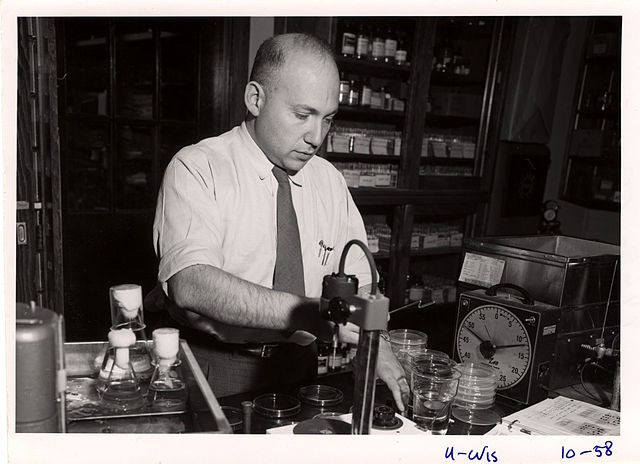
Joshua Lederberg at work in a laboratory at the University of Wisconsin 1958, nobel prize winning pioneer in microbial genetics and pioneer in the field of planetary protection along with the astrobiologist Carl Sagan. He was one of the first astrobiologists, indeed he coined the word "exobiology"
The guidelines evolve to meet new situations, and details are now hammered out in international workshops of scientists. It's one of the functions of the Committee on Space Research (COSPAR). Every two years they meet to work out details of what is required for all the places we send spacecraft to, or may send them to in the future. The US has a planetary protection office, and a planetary protection officer, Cassie Conley. ESA's planetary protection officer is Gerhard Kminek. All space faring countries follow these guidelines when they send their spacecraft to vulnerable places in the solar system.
Planetary protection just makes sense here. It's easy to find life in habitable places in our solar system; just bring it with you. But that would be the worst possible anticlimax of all our searches to try to find life on Mars or elsewhere in our solar system, and would greatly diminish the scientific interest of Mars. Mars is a high risk target (category IV) in the forward direction, from Earth to Mars, and our robotic missions have to be sterilized if they land on the surface. There are several levels of sterilization depending where you go on Mars, with the highest level, IVc, for missions that approach places on Mars which could be habitable to Earth life. Curiosity is not sterilized to this highest standard so if it found a potential habitat on Mars, it could only observe it from a distance. Indeed, the team are facing this quandary right now, as there's a potential flow of seeps of salty liquid on the higher slopes of Mount Sharp which is within its range. But because Curiosity is not sufficiently sterilized, they will only be able to photograph them from a distance, and even then it's a decision that needs careful thought, to go close enough to photograph them.
The Moon, by comparison, is low risk (category II), as COSPAR scientists think there is no chance of Earth life reproducing there. The only requirement is to document anything you land on the Moon, including any crash landings and deliberate impacts. We have sent Earth life to the Moon already, in all our spacecraft as hardy spores clinging to the equipment, and as human wastes also in the case of the Apollo spacecraft. But that's no problem. The scientists believe that it will stay where you left it, or not be transported far in the processes that operate on the Moon, and as long as you document what you did clearly, follow up missions will be able to allow for it. The Moon is large enough so that some organic human wastes in one place will not matter for other missions even just a few kilometers away. So there's no problem sending humans to the Moon.
COSPAR don't yet have definitive guidelines for humans to Mars. Before they could publish these guidelines, they would need to meet to discuss what planetary protection measures are needed. And actually, there have been several meetings already of this type, and they all concluded that we don't yet have sufficient data for detailed guidelines. I think actually that if asked to approve a mission as soon as the 2030s, there might be a divergence of views. There is no way they'd have enough data by then to be able to make an authoritative decision, not unless we manage to send dozens of robotic missions to Mars in the next couple of decades (unlikely). I go into this in a fair bit of detail in the section on Searching for a non confrontational way ahead
In the other direction, backward contamination, returning materials from Mars, it is classified as restricted category V. This means that many precautions need to be taken in the case of a sample returned from Mars, also new laws would need to be passed, domestic and international, to protect Earth from Mars life. Depending on what we find on Mars, it could be that Mars life would do us no harm at all (for instance in an early life scenario, long made extinct by DNA life on Earth), or it could be that we need to take great care. For instance, if there is independently evolved advanced microbial life on Mars, the risk from a sample return could be similar to that of releasing new synthetic forms of microbial life into the wild from our laboratories. For these reasons and others, I think that the search for life on Mars is also best done in situ at present - you may be interested in the reasons given there.
So, with this background, you can also ask the advocates for humans on the Mars surface, why land trillions of Earth microbes on Mars when you are searching for life there? With our robotic missions, we continue to sterilize as carefully as before, with no sign of any suggestion that we can relax the planetary protection requirements. Indeed, for robots, the trend is towards more rather than less by way of planetary protection.
So, what is special about all the microbes that hitch a lift in human occupied spacecraft? Why give them special treatment? Would it not be more sensible to keep them well away from the planet too, until we know what effect they will have?
That may seem far fetched, that Earth microbes would matter to Mars. But travelers from Hawaii have to be careful not to bring the oriental fruit fly Bactrocera Dorsalis into California because it would devastate the crops. It's rather like that.

Bactrocera dorsalis - a female oriental fruit fly. Travelers from Hawaii to California have to be careful not to introduce it, as it makes fruit unfit to eat. Similarly microbes from Earth introduced to Mars may have harmful effects on whatever is on Mars, for instance, if Mars hosts some vulnerable form of early life that has been made extinct by DNA based life on Earth. But it's not so easy to prevent Earth microbes from entering Mars on a human ship.
It would satisfy nobody to try a compromise solution for Hawaii imports to California, e.g. to import fruit only on the first day of each month. That would mean the fruit importers are severely restricted in what they can do, while the fruit growers are not protected from the oriental fruitfly, so it satisfies nobody.
In the case of human missions to Mars, I think everyone would agree that a crash of a human occupied spacecraft on the Mars surface, with provisions, air, water and human bodies, with the trillions of microbes that accompany us strewn across the landscape, would be pretty much an immediate end to planetary protection of Mars. Can we have 100% reliable landings of human occupied spacecraft on Mars? We are nowhere near that level of confidence with robotic spacecraft.
And indeed Elon Musk in an interview with the Washington Post about his ideas acknowledges the risks:
“the first mission wouldn’t have a huge number of people on it, because if something goes wrong, we want to risk the fewest number of lives as possible.”
“It’s dangerous and probably people will die—and they’ll know that,” he continued. “And then they’ll pave the way, and ultimately it will be very safe to go to Mars, and it will very comfortable. But that will be many years in the future.”
How can that approach be kept consistent with planetary protection for Mars? Well Elon Musk thinks there are probably no habitats for life on the surface; only deep underground. There's no problem with astronauts who volunteer to take huge risks exploring asteroids, or the Moon or anywhere else uninhabitable for Earth life. But is that the situation on Mars?
This is an article and kindle booklet I wrote about this:

Can We Risk Microbes From Human Crashes - On Mars? If Not, What Happens To Dreams To Colonize The Planet?
For more on this, see Searching for a non confrontational way ahead
But all this so far is negative vision. It's not going to inspire people. Again the colonization enthusiasts will agree that this would be the ideal way to proceed. However they will say that colonizing Mars is so important, that they have to go ahead anyway. They will say that we have no evidence that our microbes can cause any harm on Mars yet. And they will assure you that they will take the best precautions they can to protect the planet given the requirement that they have to land humans on Mars as soon as possible. The ones who think that there could be habitats for Earth microbes on Mars may go on to say that some irreversible contamination with Earth life is inevitable, so we just have to find a way to cope with that.
Humans need vision and inspiration, I agree. If you just say "can't do this, don't do that" that's a negative vision that can't inspire anyone. We need a positive vision if we are going to have any alternatives to this Mars colonization idea for the future.
So, I think I'm trying to develop an alternative positive vision here. Whether it works or not is something I'm finding out. It's getting enough favourable attention to be encouraging. In the process I've also come across others with alternative visions of their own. So perhaps it might encourage them too to continue to develop their visions and present their dreams.
The more visions we have, the more options we have for the future. It is hard to present a vision like this in a short period of time. Remember that the positive vision of Mars colonization has many details to support it, built up by its advocates over books, talks, television programs and so on, for decades. So an alternative positive vision also has to be quite detailed. This book, though it is quite long, is a rapid summary of just the main ideas.
Also, I'd also just like to say at the outset to humans on Mars enthusiasts, that "This approach doesn’t mean that humans can never land on Mars ever". It's the microbes that are the planetary protection issue here, not humans. And the microbes are an issue right now because we don't know what is on Mars, or what effects our microbes will have on the planet. I will suggest that whether microbes continue to be an issue in the future, or whether we can relax planetary protection measures for Mars, is something we can only find out by studying the planet in much more detail than we have so far.
The main new thing about this booklet compared to other treatments of the subject is that I put planetary protection, the value of science, and reversible biological exploration as central core principles from the outset. Often these topics, especially planetary protection, are barely mentioned.
I outline one particular vision here and present my own views unashamedly. I expect most readers will agree with me on some points and disagree on others. My main aim here is to present a vision in enough detail to stimulate discussion about other possibilities for future alternative visions. There could be many other ways to develop such a vision.
The key point here is, that while we continue to explore other places in the solar system with robots, we start with the Moon, for humans, as a place of great interest in its own right, and not just as a step on the way to Mars.
This is an important part of the vision, so I'll open out by talking about how interesting the Moon is, in some detail. It's our first place to explore on foot outside of Earth, and a gateway for humans to Mars, Venus, Mercury, the asteroids, Jupiter's moon Callisto, and further afield. If we develop the ability to live in space for years at a time on the Moon, then the whole of the solar system will open out to us, and we won’t need to be focused on humans to Mars as the only option.
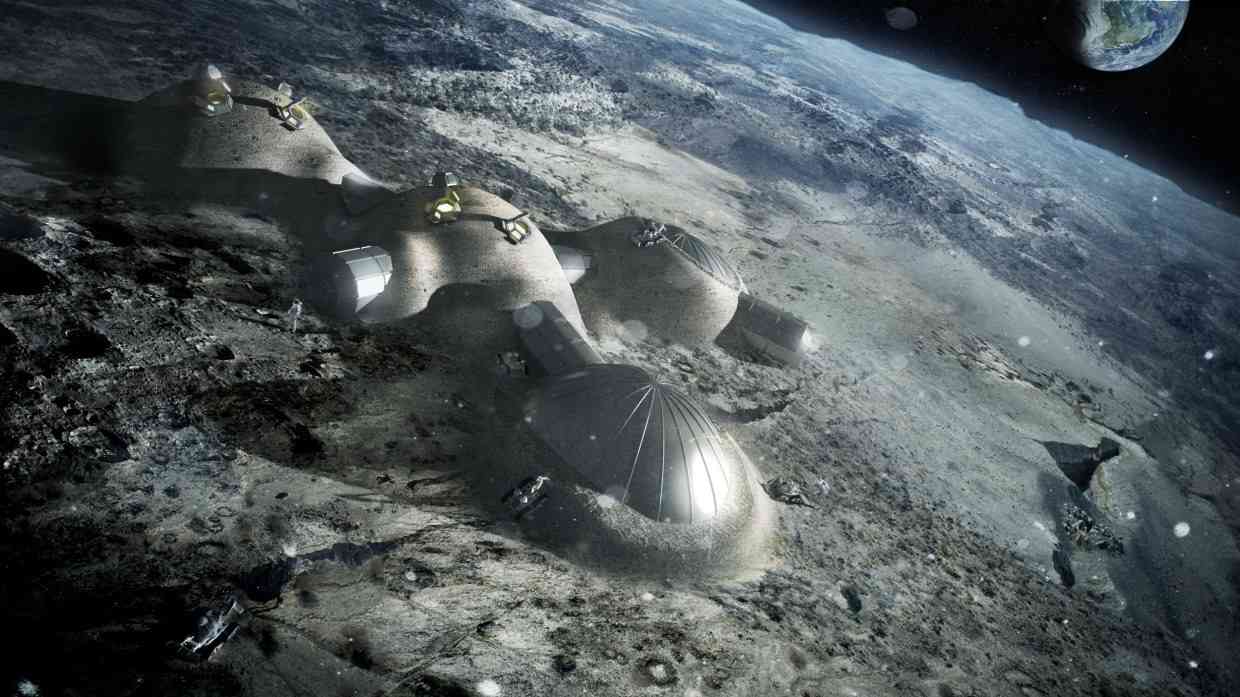
Artist's concept of a permanent lunar base, credit ESA.
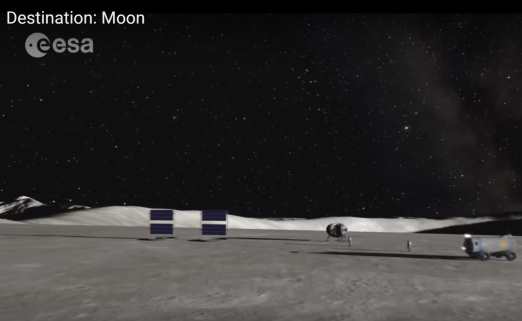
Screenshot from ESA Destination Moon video.
In this article I use "space settlement" as the more general term, to refer to any humans living in space in permanent or semi-permanent bases, as they do in Antarctica - and space colonization for some later stage when they may become more self sufficient and also have children born in space.
It is likely to be a progression, first with outposts only temporarily inhabited. Then bases, like an Antarctic base. At some point, perhaps quite early, these become materially self sufficient in many things, able to produce all their own food, recycle their water, and produce power and even fuel for their rockets in situ. But they would be dependent on Earth for other things like spacesuits, computer chips, clothes, experimental apparatus, and any other complex machines and hard to manufacture materials. At some point we get the first children born in space, and then we may get the beginnings of true colonization.
But, I argue, colonization is perhaps not the best goal to have in the early stages. We may miss many opportunities if we make this our main aim, rather in the same way that if the early Antarctic explorers had had as their main aim to colonize Antarctica, they would surely never have succeeded in this, and would have missed out on the many discoveries and advances in science that came from a more open ended approach.
Mars colonization advocates often contrast Mars with the Moon. The Moon may be described as being as uninteresting for human colonization as a lump of concrete. But actually it turns out that the Moon is very rich in resources. We need a "Case for the Moon" here like Robert Zubrin's "Case for Mars".
Moon advocates perhaps don't hit the news as much as the Mars advocates but there are many of them, and they are just as enthusiastic about their vision as the Mars advocates. Paul Spudis is one, with his most recent book, The Value of the Moon: How to Explore, Live, and Prosper in Space Using the Moon's Resources. Another is Dennis Wingo, CEO of Skycorp, and author of Moonrush, see his recent paper, and appearance on the Space Show. Others include Madhu Thangavelu, David Schrunk, and other authors and contributors to The Moon: Resources, Future Development and Settlement. See also David Schrunk's paper Planet Moon Philosophy , and their appearance on The Space Show.
It was also the policy of the US too during the Bush administration, with his Vision for Space Exploration program. And the ESA and Russia are strongly behind the idea of sending humans to the Moon first.
So, let's look at some of the suggested lunar resources for this Moon first approach.
The Moon doesn't have a CO2 atmosphere, but it has dry ice at the poles. It has an estimated at least 600 million metric tons of ice (based on the mini SAR and lunar prospector data, indirectly detected through radar), and possibly much more. If the proportions are the same as for the LCROSS impact measurements, 2.12% of that may be CO2, so if those figures are correct (which needs more confirmation), that could be more than twelve million metric tons of CO2 in the form of dry ice.
That's plenty, but we might not even need it. It is only a trace gas in our atmosphere, less than 0.04%. And, this may surprise you, but actually, feces is nearly all water. About 1 kg of carbon dioxide is exhaled every day, compared to only 30 grams (0.03 kg) of dry weight in feces.
Plants don't need a constant supply of carbon dioxide from outside of the habitat. Indeed, if you grow enough plants for food, then they get all they need to make the plant matter and the oxygen from the carbon dioxide you breathe out, and a small amount from the feces which can be burnt or composted.
With each crop, to close the cycle, the plants also produce almost exactly the amount of oxygen that humans need to breathe, indeed that's the main advantage of growing your food, that it saves on the 0.84 kg of oxygen you need to supply per crew member every day (from table 2 of this paper). Oxygen supply is the main issue here, and after that, food.
If you have to import some of your food, as has always been the case so far, then an excess of carbon dioxide builds up, and you have to remove because it is dangerous to humans long term at concentrations of above one or two percent in the atmosphere.
The first crop cycle, for, say, 40 days (it took 39 days for dwarf wheat to reach maturity in an experiment on the ISS in zero g) does need a net input of CO2 to the plants for them to grow. But this will be provided by the astronauts just breathing it out, so if you supply them with food for the first month, then they will then provide enough carbon dioxide for the next crop cycle onwards.
Or if you use robots to set up the greenhouse before the astronauts arrive and bring the first crop to maturity ready for them to eat, then you need to supply that 1 kg a day of CO2 per astronaut for one month. So that's 40 kg per astronaut.
You could take carbon out of the atmosphere in the habitat if you store and accumulate the plant wastes. Typically half the crop is plant wastes and if you stored all the plant wastes, yes, you'd need a constant input of CO2. However that would lock up valuable oxygen into the plant wastes and remove carbon from the system as well, so it's not too likely that you would do that.
If you burn plant wastes too as is the most likely thing to do in a space colony, or compost them, then you have a closed system, and any imported food will mean an excess of carbon in the system which will build up in the atmosphere rather rapidly. This was the main thing that threatened the lives of the Apollo 13 crew, they had plenty of oxygen but had to rig up a way to scrub the carbon dioxide to survive.
On the ISS it used to be vented into space. Nowadays they react it with the hydrogen got from splitting water to generate oxygen, in the Sabatier reaction This converts the carbon of the carbon dioxide to methane which is then vented into space. That's still not a closed system as it depends on constant input of water and food to provide the carbon and hydrogen that's lost to space in the methane.
The ISS's half kilogram for 0.04% (see next section) would then correspond to just half a day's worth of wastes for one person. If you suppose similar amount of atmosphere to the ISS, and six people, importing all their own food, the carbon dioxide would build up at a rate of about half a percent a day, so would over 1% within two days, and reach 10% within 20 days, a level which leads to convulsions, coma and death.
If they import half their food, and don't scrub the carbon dioxide they die within 40 days, but probably much sooner. If they import a quarter of their food, with no carbon dioxide scrubbing, they die within 80 days.
That's based on this paper which says concentrations >10% may cause convulsions, coma and death. That's for short term exposure, so with continuous exposure with gradually increasing concentrations, they would probably die well before then. Levels of up to 3% however can be tolerated for more than a month without any adverse effects (see table 2 page 66b of this paper).
No space habitat to date has had to import CO2, and until you have near perfect recycling it won't be needed. Once you are able to grow all your own food, then you may need a tiny amount, but the more perfect the recycling, the less you need. If you had perfect recycling, you'd only need as much as is necessary to get the plants started. Usually half of the plants grown for crops consist of plant wastes, but that also doesn't really change anything. The CO2 you get from burning the wastes or composting it, added to the CO2 breathed out by humans, is almost exactly the amount the plants need to grow the next generation of crops.
So, it's not too likely that you will have a shortage of CO2 in space.
One way or another, if you import food, you will have an excess of carbon in the system which has to be scrubbed and got rid of somehow, usually as carbon dioxide or methane. While if you manage a nearly biologically closed system, you need hardly any materials supplied from outside to keep it going, just need to deal with leaks. The water in urine, sweat and grey water can be recycled, something that is already done in the ISS. For techy details: upgrades to the ISS water recovery systems. The feces can be dealt with also, without need to build a sewage plant in space, for instance oxidized at high temperatures 400 C and high pressures using supercritical water.
It's true that in the carbon cycle on Earth, volcanoes recycle carbon dioxide, which was originally taken out of the atmosphere millions of years ago, however not by us eating plants, or plants just growing and decaying as that returns roughly the same amount to the atmosphere as was taken from it. It is taken out through steady build up of plant residues, for instance peat, coal and oil, and through build up of limestone and chalk in the oceans and through organics falling into the ocean from algae growing on the surface. Most of our CO2 is stored in carbonates such as limestone, or as organics in the oily shales, and that's what gets subducted and then returned to the atmosphere in volcanoes. It's a much slower process.
If we ever attempted to terraform Mars or the Moon or anywhere else long term, we would need to have some other way to return the limestone and chalk and other carbonates to the atmosphere, as it doesn't have continental drift to subduct them and cycle them around through volcanoes. However this is not a concern for space habitats in the near future - they aren't going to be troubled by the effects of a build up of oil rich shales, limestone and chalk.
For more about all this see my Could Astronauts Get All Their Oxygen From Algae Or Plants? And Their Food Also?
Moon has nitrogen too, in the form of ammonia at the poles. If it is correct that there are 600 million tons or more in the form of ice up to 2 meters thick, with 6% ammonia, then there may be 25 million tons of nitrogen there .
We need nitrogen as a buffer gas in the atmosphere to protect us from oxygen toxicity.
There is another way to avoid oxygen toxicity, and that is, to use oxygen at low pressures, as they do for spacesuits. Spacesuit gloves are stiff and difficult to use and full Earth pressure would make them much harder to use. Apollo also used a pure oxygen atmosphere even after the fire of Apollo 1, as a simpler system, but you have to take care to use materials that won't burn easily. Since Apollo all space flights have used mixed oxygen / nitrogen for habitats and pure oxygen only for spacesuits. So, lunar habitats will surely do the same.
We don't have to keep resupplying nitrogen to a space habitat because it is a one off amount of mass (plants use nitrogen but it's part of a nitrogen cycle so could be returned to the atmosphere using denitrifying bacteria, and anyway compared to carbon, it is a small amount of the total mass of the plant). So how much mass do we need to provide?
Well, ignoring reserves of nitrogen, we can work out how much is needed for the habitat air itself. The pressurized volume of the ISS is 32,333 cubic feet or around 915.5686 cubic meters. At 1.225 kg / m³, at Earth sea level pressure which is what they use, it's 1.122 tons of air. So that's less than a ton of nitrogen, and of the total mass of the ISS, 419.725 tons, only 0.27% is atmosphere. As for CO2, at 400 ppm, that much air would contain a negligible half a kilogram (0.04% of 1.122 tons)
So, it's useful to be able to get your nitrogen and oxygen in situ, but it's not a deal breaker if you have to get it from Earth if you have decent closed system recycling.
It's the same for any size of habitat, for city domes too, the atmosphere is small fraction of the total mass, not including regolith shielding, just the unshielded habitat mass.
For a large habitat such as the Stanford Torus then the atmosphere is a higher percentage of the total mass, but that's because it has less structural mass needed, because the surface area (heaviest part) goes up only as the square when the volume goes up as the cube.
For the Stanford Torus, the structural mass is 150,000 tons, atmosphere 44,000 tons, for 10,000 people.Per person that's 15 tons of structural mass and 4.4 tons of atmosphere, not counting the regolith shielding (which they planned to send from the Moon using bulldozers and a mass driver)..
For the ISS, with 6 people, 419.725 tons, that's about 70 tons per person of which 0.187 tons is atmosphere That's a fair bit of atmosphere. There are more efficient ideas for the Stanford Torus, the Vademecium design which has a flatter torus so reducing the amount of mass for atmosphere. However, the reduction in structural mass compared to the ISS more than compensates.
The situation is the same for most large space habitats. The larger it is, the less structural mass per person but the more atmosphere per person if it is similar in shape to a smaller habitat. Venus cloud colonies are different, they have much lower mass requirements per person similar to an airship, and in principle, they can get all of their atmosphere from the Venus atmosphere too.
Nitrogen doesn't seem likely to be a major issue in the early stages at least. It may be more of an issue if we wish to fill an entire lunar cave with nitrogen, more on that below: Can we fill lunar caves with air.
We can only see a few meters into the lunar caves from the surface, so we don’t know how far they extend, especially since the regions near the pits are probably partly filled in with debris as well. But they could be huge; potentially they can be large enough to fit in a large city, the size of Philadelphia, with space to spare
Lava tube caves on the Moon could be stable up to five kilometers wide in the lower gravity. The black silhouette here shows the city of Philadelphia superimposed in one of these suggested tubes. We know there are rills on the Moon this wide and can see cave entrances into them on the surface, in photographs taken from orbit, but we can't see far into them so don't know how large the caves are yet. These huge lava tube caves may have been detected indirectly though, through gravitational anomalies in the Grail spacecraft measurements: Scientists May Have Spotted Buried Lava Tubes on the Moon - see also Grail data points to possible lava tubes on the moon.
Such huge caves are only possible because of the low lunar gravity, as they would collapse on Earth. Similar caves on Earth are far smaller as would be any similar caves on Mars. We don't know for sure if such large caves do exist, but it does have many cave entrances photographed from orbit, which proves that at the least, it has caves with entrances similar in size to Earth cave entrances. Then the extensive systems of rills and the Grail data are suggestive of larger caves to be discovered.
Some of the possible lava tube gravitational signatures are over 100 kilometers long and several kilometers wide. If the Moon does indeed have caves 100 km long and kilometers wide, that's similar in size to the O'Neil cylinder space habitat with a land area of several hundred square miles (the O'Neil cylinder consists of a pair of cylinders, each 20 miles long and 4 miles in diameter, with total land area 500 square miles).
Each such cave could house several million people. This may be a long shot, but isn't it amazing, to think that the Moon could have caves as vast as this, similar in size to an O'Neil cylinder, and we simply wouldn't know yet?
The Lacus Mortis area has possible volcanic cinder cones, as well as the more common shield volcano features, rilles, and a partially collapsed cave entrance with a gentle slope leading into it. This was the proposed destination for the Astrobiotics mission in 2014.
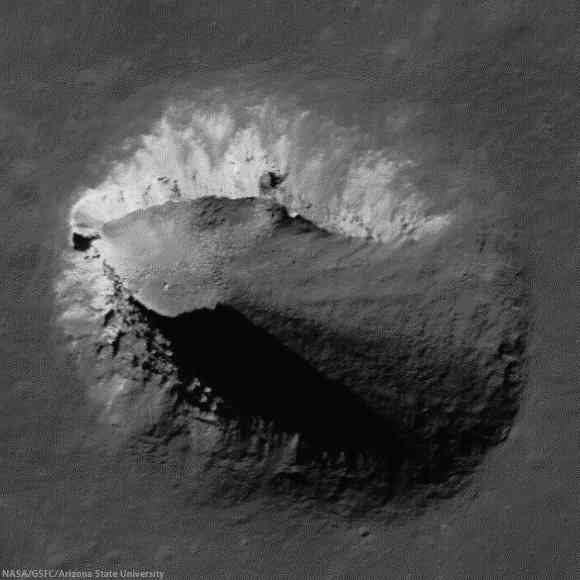
Partially collapsed "skylight" in the Lacus Mortis region of the Moon.

Photos of the Lacus Mortis pit from various angles, which were used to build a 3D model of the pit, assuming that it is a cave entrance.
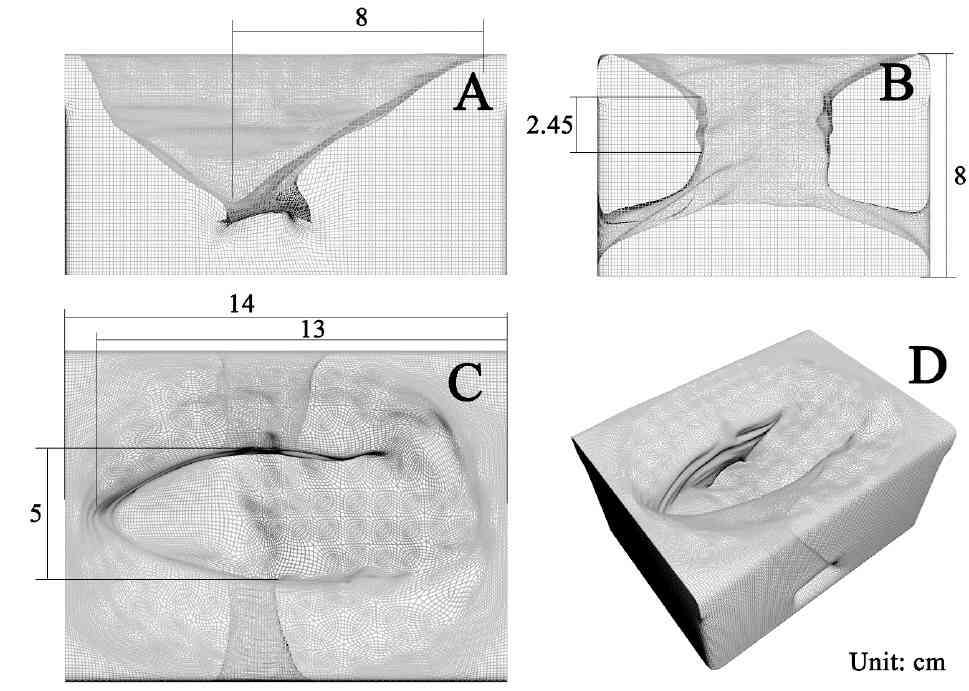
3D model shown from various angles. The cave was assumed to be oval shaped as a result of fill by debris form the collapse - further from the entrance, if it's a lava tube cave, it should widen out to a circular cross section.
3
One of two possible volcanic cinder cones in the Lacus Mortis area. Though the Moon has many rilles and shield volcanoes, volcanic cinder cones are very rare indeed, if that is indeed what this is.
Another interesting pit is the Marius Hills pit entrance, original destination for astrobiotics:

The "skylight" on Marius hills (see page 7) was the original objective for the astrobiotics Skylight mission as envisioned in 2013 - it may be an entrance to a much larger lunar cave as it is located on a lunar rille
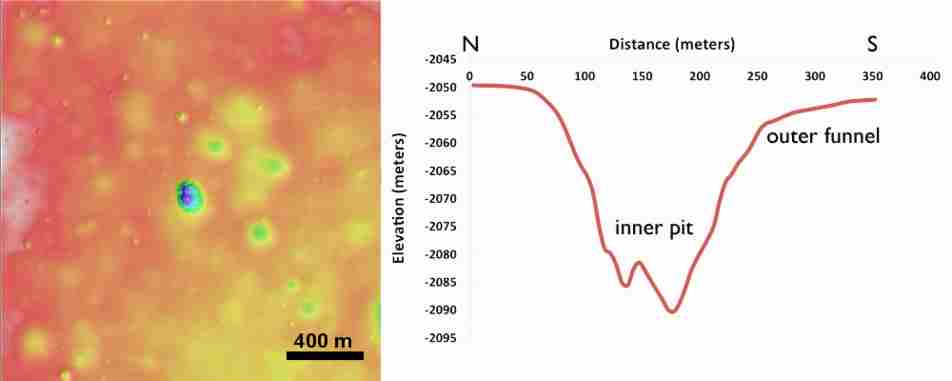
This shows the topography - it's about 40 meters deep The crispness of the landform suggests the collapse happened less than a billion years ago, and the lack of any raised rim or eject suggests it formed through collapse, not through a meteorite impact.
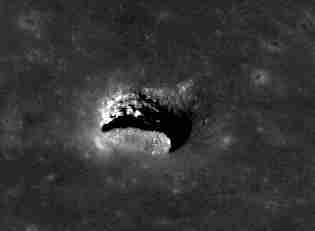
This image shows an oblique view. It's viewed from an angle of 45 degrees, and the light from the sun is at an angle of 34 degrees from the vertical. As a result they were able to confirm that the area of the floor illuminated in this image continues at least twelve meters under the overhang. Papers here, and here .
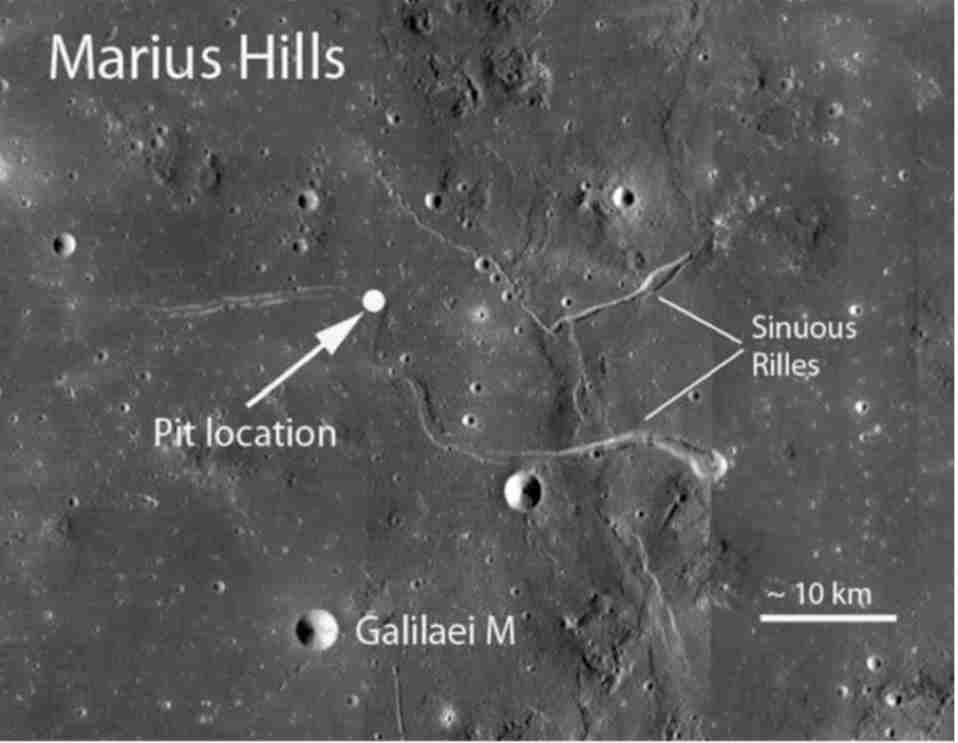
This shows the location of the Marius pit along a lunar rille. Image from page 5 of Exploration of Planetary Skylights and Tunnels
Another "honorable mention" goes to the region of King crater, which is of special interest for its remarkable natural bridge.
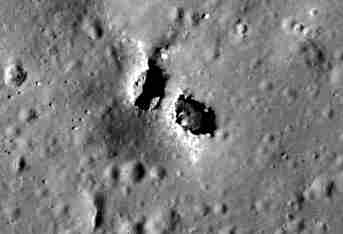
Lunar natural bridge feature King Y, probably caused by a double collapse. It's about 7 meters in width and a 20 meters walk to cross it.
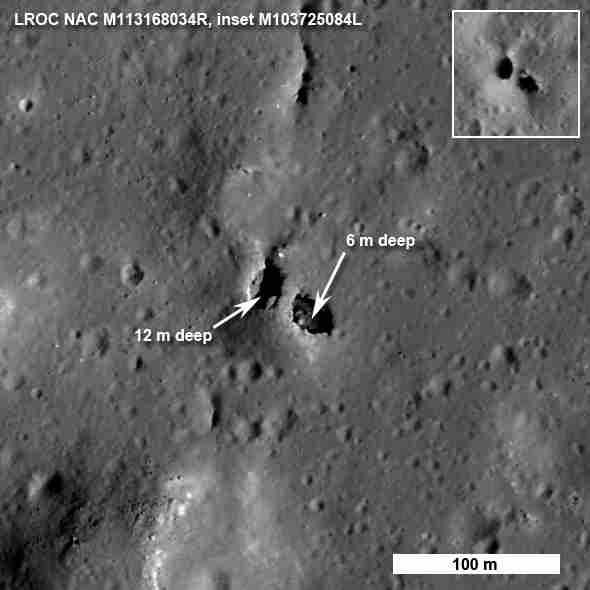
The lunar caves may also have unusual minerals that formed as the lava that created the cave slowly cooled and differentiated.
The NASA PERISCOPE project, currently a phase II concept study, could potentially give us a way to see into lunar caves from orbit using femtosecond laser photography which lets you "see around corners" to parts of the cave that were never within the line of sight of the orbiter.
We may may get our first views into the interior of a lunar cave from ground level some time in 2017, with the Japanese Hayuto Lunar X prize contender Moonraker, which will explore the Lacus Mortis pit "skylight" and then lower its two wheeled rover Tetris into the pit . For details of this mission, see Robotic missions to the Moon, already planned, or near future, from 2017 onwards, below.
See also Lunar caves as a site for a lunar base
We have pretty good evidence now of ice at the poles, in permanently shadowed craters, thought to be relatively pure and at least a couple of meters thick according to radar data from a NASA instrument flying on India's Chandrayaan-1 lunar orbiter.
It's not a direct detection however, so there is still room for skepticism about it, as rough material would have the same radar signature as radar transparent ice. But craters that are rough when new, are rough both inside and outside the crater rim. While these signatures are found only inside the craters and not outside the rims, which they interpret as meaning that they are caused by ice. The temperatures are also right for ice.
If it is ice, it could be "fluffy ice".
"We do not know the physical characteristics of this ice—solid, dense ice, or “fairy castle”—snow-like ice would have similar radar properties. In possible support of the latter, the low radar albedo and lower than typical CPR values for nonanomalous terrain near the polar craters are 0.2–0.3, somewhat lower than normal for the nonpolar highlands terrain of the Moon and are suggesting the presence of a low density, “fluffy” surface."
(page 13 of Evidence for water ice on the moon: Results for anomalous polar)
In either case, it is not just a little ice; if this is what they detected, there's estimated to be at least 600 million metric tons of this, and possibly much more.
It also contains other volatiles. We know for sure that there is some ice on the Moon, by the LCROSS impact experiment. Relative to H2O at 100% they found H2S at 16.75%, NH3 at 6.03% SO2 at 3.19%, C2H4 at 3.12%, CO2 at 2.17%.
So, if the rest of the ice at the poles has a similar constitution to the impact site that's a lot of nitrogen (in the ammonia) and CO2 on the Moon at the poles.
The green circles here surround craters at the lunar north pole thought to have layers of ice, with an estimated total of at least 600 million metric tons of water.
(0 degrees longitude at bottom)
On the other hand, caution is needed as this is not direct detection. The LEND results (searching for hydrogen through reduced emissions of neutrons of a particular type) are particularly puzzling, as there is almost no resemblance between their map and the miniSAR map.
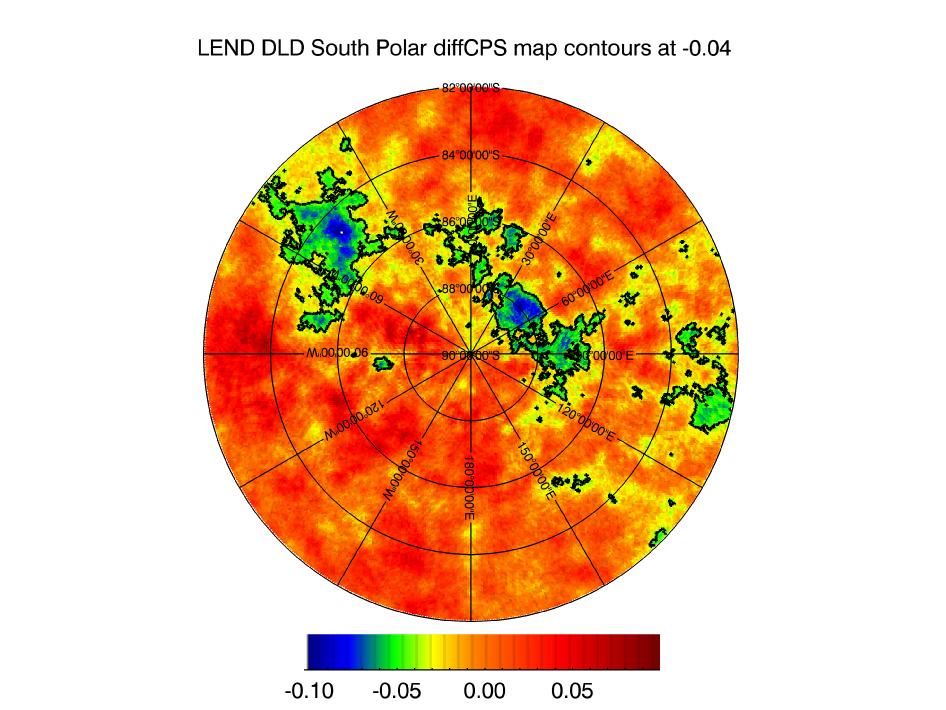
LEND map - in this picture blue is reduced neutron emission and shows likely locations of hydrogen. 0 degrees longitude is at the top.
They did detect hydrogen, but puzzlingly, it was not correlated with the permanently shadowed regions - there was some hydrogen in permanently shadowed regions, and some also in illuminated regions. A recent paper suggests that ice mixed in the regolith in illuminated regions may be ancient ice that survived a minor shift of the lunar axis. According to one hypothesis, this may be ancient deposits from over three billion years ago before volcanic activity, which changed the polar axis slightly by shifting material.
A new LEND mission has been proposed involving low passes over the poles at altitudes as low as a few kilometers, for higher resolution results.
The Moon may also have ice at lower latitudes too, as there are permanently shaded regions up to 58 degrees from the poles (only 32 degrees from the equator). Though these regions are too warm to have ice on the surface, there may be ice there underground. See Ice may lurk in shadows beyond Moon's poles (Nature, 2012).
At any rate, the Moon does seem to have resources of ice at the poles (though memorably, Patrick Moore in one of the last Sky at Night programs that he did said that he'd believe there is ice at the poles when someone brought him a glass of water from the Moon). More research is needed to find out how much there is and where it is.
Some scientists - particularly Arlin Crotts, think it may have ice several meters below the surface over the entire planet, and that it may have volatile resources deep down. There are signs that suggest it is still geologically active, and one possibility is that the activity may be due to volatiles deep down escaping to the surface. For more on this, see Geologically active moon
Critics often say that the Moon is undifferentiated and doesn't have any processes to concentrate ores. Although the Moon doesn't have any liquid water so all the processes involving concentration of resources through water erosion won't work, it still has many processes that can concentrate ores. Including:
The Moon has many valuable ores for metals. For instance, the highland regions (probably the original crust of the Moon) consists mainly of Anorthite (a form of feldspar, formula CaAl2Si2O8) which is 20% Aluminium, compared with 25% Aluminium for Bauxite on Earth. So aluminium ores are abundant on the Moon, indeed orders of magnitude more abundant than they are in typical asteroids, but it does require a lot of energy to extract the aluminium from the ore. Either a nuclear power plant or large areas of solar panels. Crawford, in his "Lunar Resources: a Review"* , says this about aluminium on the Moon:
"Aluminium (Al) is another potentially useful metal, with a concentration in lunar highland regoliths (typically10-18 wt%) that is orders of magnitude higher than occurs in likely asteroidal sources (i.e. ~1 wt% in carbonaceous and ordinary chondtites, and <0.01 wt% in iron meteorites; . It follows that, as for Ti, the Moon may become the preferred source for Al in cis-lunar space. Extraction of Al will require breaking down anorthitic plagioclase (CaAl2Si2O8), which is ubiquitous in the lunar highlands, but this will be energy intensive (e.g. via magma electrolysis or carbothermal reduction; Alternative, possibly less energy intensive, processes include the fluoridation process proposed by Landis , acid digestion of regolith to produce pure oxides followed by reduction of Al2O3 (Duke et al.), or a variant of the molten salt electrochemical process described by Schwandt et al."
Mining this for the aluminium would create calcium as a byproduct, which is useful as a conductor in vacuum conditions, a better conductor than copper weight for weight - you need half the mass for the same amount of electricity. (Copper does better than calcium on a per volume basis because it is 5.8 times denser, it is also of course much more practical in an atmosphere because calcium reacts vigorously with air, but that's not a problem for conductors that operate in a lunar vacuum, and in space applications the reduced mass may be an advantage).
"Calcium metal is not used as a conductor on Earth simply because calcium burns spontaneously when it comes in contact with oxygen (much like the pure magnesium metal in camera flashbulbs). But in vacuum environments in space, calcium becomes attractive.
"Calcium is a better electrical conductor than both aluminum and copper. Calcium's conductivity also holds up better against heating. A couple of figures mining engineer David Kuck pulled out of the scientific literature: "At [20C, 68F], calcium will conduct 16.7% more electricity than aluminum, and at [100C, 212F] it will conduct 21.6% more electricity through one centimeter length and one gram mass of the respective metal." Compared to copper, calcium will conduct two and a half times as much electricity at 20C, 68F, and 297% as much at 100C, 212F.
"Like copper, calcium metal is easy to work with. It is easily shaped and molded, machined, extruded into wire, pressed, and hammered.
"As would be expected of a highland element, calcium is lightweight, roughly half the density of aluminum. However, calcium is not a good construction material because it is not strong. Calcium also sublimes (evaporates) slowly in vacuum, so it may be necessary to coat calcium parts to prevent the calcium from slowly coating other important surfaces like mirrors. In fact, calcium is sometimes used to deoxidize some metal surfaces. Calcium doesn't melt until 845C (1553F).
"Utilization of lunar materials will see the introduction of industrial applications of calcium metal in space."
From the section on Mining the Moon in Permanent - by Mark Evan Prado, a physicist in the Washington, D.C., region working for the Pentagon in advanced planning in the space program.
The Moon is deficient in copper, at least on the basis of what is known so far, but as well as calcium, aluminium is a good conductor.
The LCROSS experiment found silver (a superb conductor) and mercury at the impact site, but the concentration is not known, except that it is far higher than the levels in the Apollo samples, and is probably in a layer below the surface, as the signal was delayed. See LCROSS mission may have struck silver on the moon.
It has abundant iron. In addition to ores (which would need a lot of power to extract), it actually has free (unoxidized) iron metal (see section 5, Metals from Crawford)"* . Some of this is nanophase iron mixed in with glass, and hard to extract, but some of it consists of small particles of iron (less than a micron in diameter) mixed in with the regolith, and it may be possible to extract it with magnets. I will go into this in more detail in the next section.
Mars doesn't have any free iron except for the occasional rare iron meteorites.
The iron is valuable for steel, and is also a conductor, though not nearly as good as Aluminium or Calcium. It would be useful for some applications such as electric railroads on Mars, and is a conductor easy to access in the early stages.
However it also contains a fair amount of nickel. Nickel and iron are useful for making nickel / iron batteries. These could be useful for making batteries on the Moon with in situ resources, for instance to help last through the lunar night.
"Iron-nickel batteries are very rugged. Their lifetimes which can exceed 20 years are not affected by heat, cold or deep cycling. They are not easily damaged by rapid discharging or over-charging. On the downside, they have poor performance at low temperatures but they can be kept warm with insulation (e.g. simple regolith) and thermal wadis. Also, they only have a charge to discharge efficiency of 65% and will self discharge at the rate of 20% to 40% per month. Despite these shortcomings, they might be the Moon-made power storage systems of choice due to their simplicity and the availability of their component materials on the Moon. Moreover, these materials are among the easiest of materials to produce on the Moon."
See Electrical Energy Storage Using Only Lunar Materials.
Then, you also have titanium. This is especially interesting as it is rare in asteroids. Apollo 17 samples are 20% high purity Ilmenite, a Titanium ore which is found in the lunar mare. And better than that, the Lunar Reconnaissance Orbiter, with its spectral mapping of the Moon, discovered deposits that are up to 10% titanium, more than ten times higher than titanium ores on Earth. (Phys.org report, NASA image). Titanium is an industrially desirable metal, stronger per unit weight than Aluminium (though it is a poor conductor).
Titanium is also widely used in medicine for hip replacements, dental implants, etc., as "one of the few metals human bone can grow around firmly", see also this new titanium / gold alloy four times tougher than titanium
Titanium is especially useful for medical applications because it
"Therefore, in the context of a future space economy, the Moon may have a significant advantage over asteroids as a source of Ti. The fact that oxygen is also produced as a result of Ti production from ilmenite could make combined Ti/O2 production one of the more economically attractive future industries on the Moon.
For more on this, see major lunar minerals. And for an in depth study, read Crawford's review"* .
So, yes, there are plenty of metals on the Moon, but it might take a lot of power to extract them, apart from the iron, if that can be separated out using magnets.And that's mainly based on the Apollo results which explored a small region of the lunar surface which has been found to be in some ways unrepresentative. The Moon may have many other surprises in store.
Many ores on Earth would not be detected from orbit, and it seems the Moon has a fairly complex geology as well from the Apollo results and from the lunar mapping showing variation in concentrations of various metals.
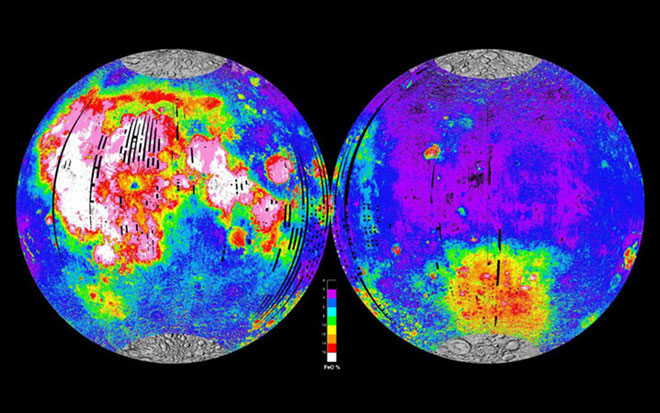
Global map of iron oxide concentrations on the lunar surface, with the colours showing 2% increments from black (0%) to white (16%). (Source: NASA/Clementine) - The method used is described here (and briefly here).- and paper covering it in detail with an earlier version of the map here.
What they did is to compare the light reflected at just two wavelengths 750 and 950 nm and also look at the effects of space weathering which darkens the soil so there are two things there - the ratio of the intensities and the intensity at 950 nm -and then by doing that they are able to work out the iron concentration at a particular point. Then to interpret this they used ground truth from the returned Apollo samples. It's rather indirect and only possible because of the Apollo ground truth.
They also found similarly large variations in the thorium and potassium content.
The big splodge on the second, far side image, is probably due to the large impactor that created the Aitken basin digging up materials from the lower crust and mantle that are likely to be richer in iron oxide.
As one example of one way the Moon could surprise us - Earth is often hit by iron meteorites, so the Moon should be also.
Dennis Wingo has hypothesized in his Moonrush book, that the Moon may also have valuable platinum group metals (ruthenium, rhodium, palladium, osmium, iridium, and platinum) which could be mined, the result of the impacts of these iron meteorites. Iron meteorites often have high concentrations of these metals, and gold also (which doesn't count as PGM).
Taking this further, there's a hypothesis by Wieczorek et al that magnetic anomalies on the Moon around the south pole Aitken basin may result from the remains of the metal core of a large 110 km diameter differentiated asteroid that hit the Moon to form the basin. If so, they could be useful sources for platinum, gold, etc.
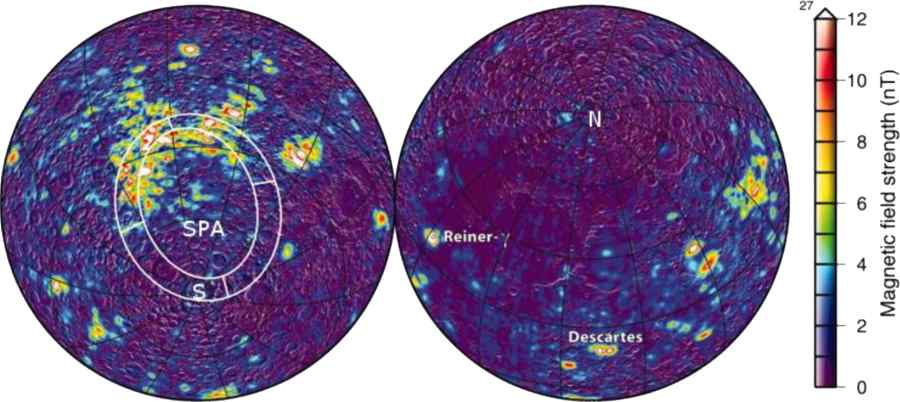
From Wieczorek et al, the North and South poles are marked N and S. Notice the magnetic anomalies clustered around part of the rim of the South Pole Aitken Basin. This is thought to be the result of an impact by a 110 km diameter asteroid. Wieczorek et al hypothesize that the magnetic anomalies trace out the remains of the metal core of this asteroid. If so these could be rich ores, including iron, nickel, also platinum and other platinum group metals (gold, rhodium etc). See page 16 of Crawford's Lunar Resources: A Review*
Platinum is a particularly useful metal (the other PGM's have similar properties to platinum and are also useful). It is heavy, soft, malleable as gold and silver, easy to draw into wires, very unreactive, and has a high melting point. Out of gold, silver, platinum and copper, platinum is the densest and the hardest and the least reactive (the others are somewhat better in terms of electrical and thermal conductivity, and malleability, but it's not too bad at those either).
So, it's not just useful for catalytic converters, fuel cells, dental fillings and jewelry. We'd probably use it a fair bit in other ways too if it didn't cost so much.
The platinum group metals might be valuable enough to return to Earth from the Moon, just as suggested for the asteroids, depending on how easy they are to return. Of course, you can't just take the current market value of platinum, multiply by the amount of platinum available in a large meteorite - or on the Moon if Wingo and Wieczorek et al are right - and conclude that you'd get trillions of dollars by returning all that platinum to Earth and selling it here.
You need to fulfill a need or eventually nobody will buy it, and whatever you use it for it has to be worth the expense of returning to Earth. If it's just to replace copper, for instance, in wires, it wouldn't be worth returning unless you could reduce the transport cost back to Earth right down.
Dennis Wingo suggested in Moonrush that it could be worth exporting it to Earth for use for fuel cells, as an application that could be high value and yet need a lot of platinum.
The gold could be useful too, on the Moon at least. You don't normally think of gold as more decorative than useful but it is used a fair bit in electronics.
Also when gold is combined with the abundant titanium on the Moon you get Ti3Au, an alloy with 70% less wear, four times the hardness and increased biocompatibility compared with pure titanium (and twice as hard as titanium / silver and titanium copper alloys). It's also 70% less wear than titanium, lower friction and four times harder with a hardness of 800 HV in the Vickers hardness test. Density about the same as steel.
(density of titanium: 4.43 g/cc. using the atomic masses of gold and titanium, multiplying by (196.96657+3*47.867)/(4*47.867)*4.43 = 7.88 approx. By comparison, density of steel is 7.75 g / cc).
Crawford's paper focuses on its medical applications, you can alloy titanium with copper or silver, which are twice as hard as pure titanium, but this is four times as hard. It's also 70% more resistant to wear which will make it last longer and lead to less debris. And has excellent biocompatibility properties. But I wonder if it might also have lunar applications, with the hardness especially and resistance to wear.
Probably only the platinum group metals would be worth returning to Earth, unless the costs of transport back to Earth go down considerably (maybe through the use of Hoyt's cislunar tether transport system ). However, whether or not they are useful for Earth, they are well worth using on the lunar surface once you have industry there.
The Moon has some advantages over Mars for metals, such as the pure nanophase iron mixed in with the regolith, which can only exist in oxidized form on Mars except for rare metal meteorites.
Also, it's unlikely it will be commercially worthwhile to return metals from Mars while there are definite possibilities of returning metals from the Moon. See Exporting materials from the Moon for future suggested low cost methods for export from the Moon. For discussion of whether anything physical could be worth the expense of export from Mars, see Commercial value for Mars
Crawford touches on the idea of extracting metals from the lunar regolith using magnetic sieving. There are practical difficulties to overcome, but if they could be, it might be the easiest way of all to extract metals from the Moon, especially if you choose sites with high concentrations of meteoritic iron
As we saw in the last section, Clementine found areas with more than 16% iron oxides with a low resolution survey from orbit around the Moon - but that's not meteoritic iron but rather, most likely, subsurface iron oxides brought to the surface. As for meteoritic iron they can't seem to detect it directly from orbit but the magnetic anomalies may mark out the effects of meteorite impacts on the Moon, so those might be associated with regions where the regolith is enriched in meteoritic metal.
So - let's look at this a bit closer, and see what research so far suggests.
The free iron on the Moon has three main sources:
It's in powder form already, and naturally alloyed with nickel and cobalt. The blebs, or "nanophase iron" are found inside impact glass particles, so would be hard to extract. Some of it is found also as thin patinas less than a micron thick on the surface of soil grains (see page 189 of this paper). *
The rest is made up of tiny particles of pure iron, so the obvious thing to try to do is to separate them out using powerful magnets. They are rather small though, most are less than a micron in diameter which could be a challenge.
Crawford in his paper from 2014 tries an estimate at possible concentration (section 5, Metals) *
"A more readily available source might be native Fe in the regolith, although the concentrations are quite low (~0.5 wt%; Morris, 1980). Native Fe in the regolith has at least three sources meteoritic iron, iron released from disaggregated bedrock sources, and iron produced by the reduction of iron-oxides in the regolith by solar wind hydrogen. The latter component occurs as nanometre sized blebs (often referred to as ‘nano-phase Fe’) within impact glass particles (‘agglutinates’) and is likely to be difficult to extract.
Morris (1980) found the average concentration of the other two components to contribute 0.34±0.11 wt%. At least in principle this might be extractable, perhaps through some form of magnetic sieving, but given the very small sizes of the individual Fe particles (generally < 1µm), the practicality of such a process is uncertain.
...If the practical difficulties could be overcome, a native Fe concentration of ~0.3 wt% is not an entirely negligible amount, corresponding to about 5 kg for 1 m3 of regolith. Moreover, meteoritic iron will be associated with siderophile elements, some of which (e.g. nickel, the PGM's and gold) are valuable owing to their catalytic and/or electrical properties"
He goes on to say that ,if we can separate them out, then from a cubic meter of regolith, then that 0.3 % by weight gives five kilograms of iron, 300 grams of nickel and about 0.5 grams of platinum, rhodium, palladium etc. (platinum group metals), and as pure metal, not the metal oxides. He doesn't say the quantity of gold but perhaps it would be around 0.01 grams of gold (at typical 1 ppm).
He bases the iron figure there from on a paper from 1980 by Morris and particularly its conclusion that the lunar soils have 0.5% by weight of iron, and their suggestion that 40% of that may consist of particles 40 - 330 Angstrom (0.004 to 0.033 microns). This uses a model to interpret the data.
He bases the PGM's on a 1994 Kargel paper, which gives a figure of 99.5 ppm of Platinum Group Metals (PGM's) for the top 10% of Fe bearing asteroids. It's 100.1 ppm when you add gold to the PGM's
This figure may need to be reduced if you use the average quantities of PGM's
Though, I wonder if that figure is a suitable one to use for the richest deposits on the Moon?
Crawford writes:
"Much higher localised concentrations of native Fe, and associated siderophile elements, could potentially be found in the vicinity of any Fe-rich meteorites which partially survived collision with the lunar surface"
So - could there be deposits on the Moon with varying chemical composition depending on the accident of which type of M type meteorite hit that particular location in the distant past?
Here I'm just speculating myself.
On that reasoning, his top 90% composition seems likely to apply to at least some ares of the Moon with debris of the larger meteorite impacts. And the value of the deposits for the Aitken basin impactor might then depend on the PGM concentrations of its iron core, and there could potentially be other deposits that are more valuable if they have higher concentrations of PGM's
So - how much of the lunar regolith is pure metal? And how much consists of those hard to extract "blebs"? And of the metals that might be extractable,, how much consists of the platinum group metals?
You'd think it would be easy to answer these questions - at least for the samples of lunar regolith returned from the Moon and from the work on asteroid composition and evidence from iron meteorites on Earth. However I haven't been able to find much detailed work on this topic in my Google Scholar searches.
Most of the asteroid mining articles I found seem to refer back to those papers by Kargel in 1996 and 1994 and an earlier paper from 1973. This is a 1994 Kargel paper, it has 21.5+4.0+16.5+14.5+14.0+29.0 = 99.5 ppm of PGM for the top 90th percentile in richness of Fe bearing asteroids.
This 1973 paper is behind a paywall for me, but it's summarized in table I of this paper.
Based on the Iridium concentrations, multiplied by 7, it gives an estimate of the total concentration of PGM's of 75 ppm for the top 10% of meteorites for type IIAB iron meteorites (see chemical classifications of iron meteorites). They give an average of 7 ppm. That compares to 2-6 ppm for good terrestrial mines. See section 3. Accessibility in this paper.
Also, what about metal particles eroded from the bedrock?
This paper from 2012 has evidence of a pure platinum / rhodium / iron alloy particle in the regolith.They give evidence that it originated from the lunar geology, not from meteorites, saying
"This provides mineral embodiment of the geochemical rhodium anomaly occurring in basaltoids from this area of the Moon"
Again this doesn't tell us anything about quantities. But it it does show that the regolith has some particles of platinum alloys eroded out of the basalt.
If any of you reading this know more do say. And I'm going to try to find out more by contacting researchers in the field.
(WORK IN PROGRESS ROUGH CALCULATION)
This is a preliminary rough idea, to get us started, thinking about the possibilities. From figure 1 of this paper about 4% of NEOs are M-type. So we are talking about 0.4% of all lunar craters likely to be formed by iron rich meteorites. There I'm using the present day percentage of M type NEOs from the present day as an estimate for the percentages that have hit the Moon in the past - a simplification but I don't know of a better estimate.
So, then, how many craters are there? As a very rough estimate here, there may be half a million craters > 1 km on the Moon, lowest estimate he comes up with is 181,000 just rough estimates:
Let's use 100,000 as the figure. Then it looks like there may be at least 4,000 craters of 1 km or larger by M type asteroids.
I'm not sure how the impactor size to crater size works on the Moon, but again a rough guess maybe 100 meters or larger. Then the ones in the top 10% would leave us with 400 craters of interest.
Each one would consist of around 4 million tons of iron (7.874*(4/3)*PI*50^3) and so, at 100 ppm, that's around 400 tons of PGM's for each one. However only some of that would be on the surface.
The world platinum production is 161 tons.
If you go to craters above 20 km in diameter we have an exact figure of 5,185 craters. Out of those our 0.4% would give a probable 20 large craters in the top 10% of meteorite PGM abundances - and another 180 with lower abundances. And now you are talking about large quantities, 8,000 times the mass for those smaller craters, using rough estimate that crater size scales by impactor size, so 20 times the diameter means 8000 times the volume.
Some of that metal may be in the form of metal meteorites instead of mixed up in the regolith, or buried pure ore deposits.
So could we extract the metals if they are there? Well there is one interesting experiment here from 2013. Jayashree Sridhar et al of the NASA Johnson Space Center have done the experiment using actual samples of lunar regolith. See Extraction of meteoritic metals from lunar regolith.
They say that the problem is daunting because much of the metal is in the form of nanophase iron deposited on the rims of soil grains, which would not be easy to extract. The main issue is to find a way to separate the pure meteoritic iron.
Anyway their experiment is not meant as a model to show how to extract the metals on the Moon. It's just an initial study.
They ground up the regolith and immersed it in isopropanol. Then they tried various arrangements of magnets. Their most successful run had an arrangement of four magnets, two strong and two weak, with the regolith ground to a medium size of 1.5 microns. They were able to extract 61 particles of meteoritic metal and 9 of nanophase iron l (so 87% by number were meteoritic metal) with the amount of nanophase iron going up and meteoritic metal going down when they repeated the process. With bulk regolith (not ground up) the pattern was similar but with fewer particles, only 9 and 2 respectively for the first run.
They concluded:
Experimental results indicate promise for the extraction of meteoritic metals from lunar regolith. However, more work is needed to refine the technique and understand more about the variables that affected our results.
Sadly, there is nothing in the paper to give the masses of the original samples or the extracted particles or their PGM abundances.
If any of you reading this know more, do say!
Of the various suggestions for ways of extracting the PGM's, the Mond process seems most promising to me - just the second half, as you already have the pure metals.
I don't know if it is going to be commercially viable to return the PGM's - but if it is going to be viable at all, to set up a space settlement supported by commercial industry - it seems most likely to be viable on the Moon perhaps even before asteroids - given the easy accessibility (the lowest delta v asteroids have orbits most similar to Earth's and so phase in and out slowly so are most accessible only once every decade or so) and also the low costs of transport to Earth.
Those advantages of ease of access to the Moon and easy export may offset the extra step you need on the Moon to extract the metal from the regolith. Also perhaps there may n be fragments of the iron meteorites that impacted on the Moon much as there were on Earth, which would help kickstart the industry by providing metals that could be exported very easily.
I'm a little surprised that Hoyt's system does not get more attention than it does, given how much of a game changer it could be. With easy access then platinum exports from the Moon may be amongst the most viable - that's the key idea behind Dennis Wingo's "Moon Rush". It's the main export that's most often mentioned. The others are ice, covered above under Volatile resources, which I think has an excellent case - and Helium 3 which is not so clear cut as we will see below.
Then another export is of power in the form of solar power, which I cover below in Possibility of using lunar solar power for Earth
Larry Taylor was lucky enough to get hold of enough of the genuine lunar dust from Apollo to experiment with and he found it was as easy to make the dust into glass as it is to boil a cup of tea with a microwave. This doesn't work with the regolith simulants. The genuine lunar dust is mingled with iron intimately as a result of space weathering by micrometeorites and that's why it is so easy to microwave.
This is a beneficial side effect of all the micrometeorite impacts on the Moon (which you don't get so much on Mars with its thin atmosphere, just enough to filter out micrometeorites). The Moon's "soil" or regolith contains large quantities of glass, created during the impacts. It also has free iron, as we saw, at half of one percent of the soil, in tiny micro beads of iron (nanophase iron) which concentrate the microwave energy. Again, you don't have this on Mars.
As a result, it is really fast to melt the regolith using microwaves. It took only 30 seconds to melt small lunar sample at 250 watts (typical of a domestic microwave). You can melt the soil to glass as easily as you can boil water using the microwave in your kitchen. See lunar lawnmower. This only works with genuine lunar soil and not the simulants. We have nothing analogous to lunar soil on Earth, as Larry Taylor, principle author of this paper found: Microwave Sintering of Lunar Soil: Properties, Theory, and Practice. He says the microstructure of the genuine lunar regolith, with nanophase iron beads scattered throughout, would be almost impossible to simulate.
His idea (see Products from Microwave Processing of Lunar Soil on page 194 of the paper) is to run a "lunar lawnmower" over the soil with two rows of magnetrons (such as generate microwaves in a microwave cooker). The first row would sinter it to a depth of half a meter using microwaves. Then the second row completely melts the top 3-5 cm of the soil, which then crystallizes to glass. As it does this, it will heat up and release most of the solar wind particles notably hydrogen, helium, carbon and nitrogen. So it could also capture these assets as it goes along, including the Helium 3, if this turns out to be of economic value.
He has various ideas of how this could be useful, for instance for tracks on the lunar surface, or a landing pad. He put it like this, interviewed by NASA:
"Picture a buggy pulled behind a rover that is outfitted with a set of magnetrons," that is, the same gizmo at the guts of a microwave oven. "With the right power and microwave frequency, an astronaut could drive along, sintering the soil as he goes, making continuous brick down half a meter deep--and then change the power settings to melt the top inch or two to make a gtlass road," he suggested."
"Technical challenges remain. Sintering moondust in a microwave oven on Earth isn't the same as doing it on the airless moon. Researchers still need to work out details of a process to produce strong, uniformly sintered material in the harsh lunar environment.
But the idea has promise: Sintered rocket landing pads, roads, bricks for habitats, radiation shielding--useful products and dust abatement, all at once.
"The only limit," says Taylor, "is imagination."
Their techy paper is here:The Lunar Dust Problem: From Liability to Asset. Others have suggested this could be used, for a solar panel paving robot to make solar panels, and other applications. Paper: Manufacture of solar cells on the Moon.
Then, there's Behrokh Khoshnevis' idea for making a landing pad on the Moon using tiles made of lunar glass in situ. The idea is to make the surface into lots of tiles by injecting a material that can't be sintered easily using microwaves into the soil first to outline the edges of the tiles, then use microwaves to melt the soil in between.
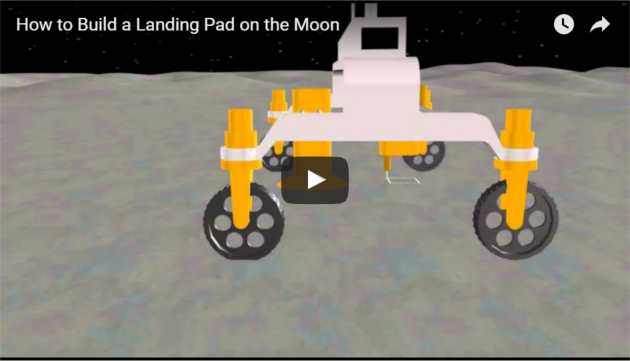
This would make a tiled flat surface for supply vessels to land on. It would also help with the problem of lunar dust by removing dust from the landing area. You can read the details here. He used lunar regolith simulant, so presumably by Larry Taylor's results, it would work even better with genuine lunar samples.
Once you have glass, so easy to make because of the nanophase iron (see previous section), it might not be such a big step to make photovoltaic cells on the Moon. After all the glass substrate is most of the mass of solar panels.
Here the Moon has another big advantage, the high grade vacuum so you could use vacuum deposition to make the cells in situ. To start with you'd make the cells themselves from materials sent from Earth. Later on you would mine those materials also on the Moon.
This was first tested in the Wake Shield Facility exploiting the increased levels of vacuum in the wake of the Space Shuttle. They were able to grow very pure thin film materials, so demonstrating a path to easy production of solar cells in high vacuum conditions in space, for instance on the Moon.
This is a report from the Center for Advanced Materials at the University of Houston, suggesting the possibility of an autonomous solar powered lunar photovoltaic cell production rover
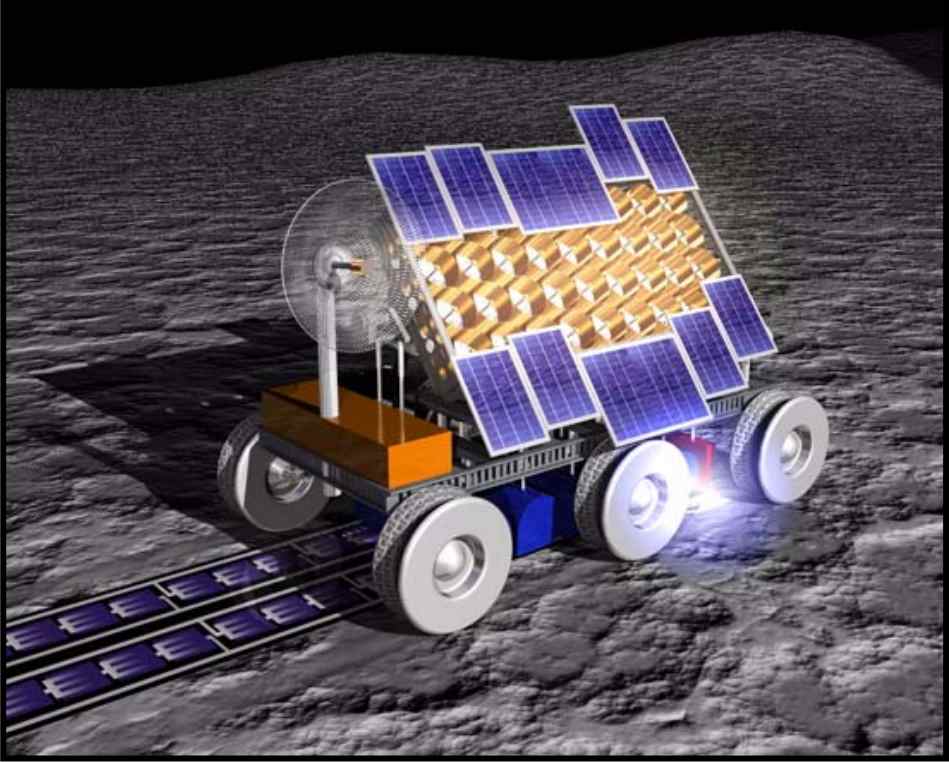
It would use silicon extracted from lunar materials to make the cells themselves. The panels then are based on low efficiency silicon cells vacuum deposited on glass. This is not easy to do on Earth but would be possible in the ultra high vacuum conditions on the Moon. Techy details of this suggestion are here. The layer by layer details are on a later page here, which describes a thin layer of solar panels with the following composition, thickness shown in microns:
| Top electrode | 0.1 - 1 | Ca, FeSi or Al anorthite or imenite |
| Antireflection coating | 0.1-0.2 | TiO, SiO or AlO anorthite or imenite (for TiO) |
| n-type silicon | 0.1 - 0.3 | Si doped with As, P or S at 100 to 200 ppm anorthite (present in low concentrations) |
| p-type silicon | 1-10 | Si doped with Al at 20 to 50 ppm anorthite, pyroxene |
| Bottom electrode | 1-2 | Ca, FeSi or Al anorthite or imenite |
| Substrate | 2-5 | Glass regolith |
All the elements are sourced locally, and the total thickness is between 4.3 and 28.5 microns. There are various ways you can do the extraction, and, magma electrolysis may be best.
It would require transporting a small mass to the Moon in the form of the rover which then over several years of driving could build a 1 MW facility on the Moon.
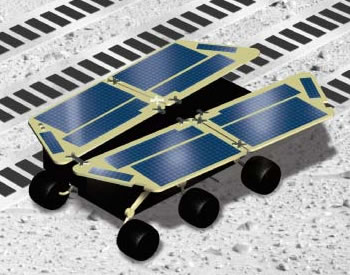
Idea for a robot to drive over the surface of the Moon leaving solar panels in its wake wherever it goes, using only indigenous lunar materials to make the panels. The panels would be only 1% efficient, but given that there is no shortage of real estate on the Moon, that might not matter. It might be more important to make the panels in situ without any imports from Earth than to make them highly efficient
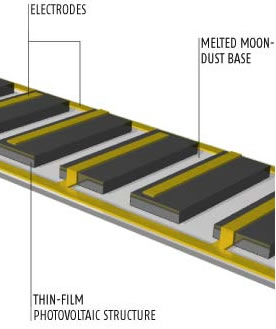
Structure of the panels
For making glass on the Moon see the section above: Lunar glass
The basalt itself is a natural resource. If reasonably pure and consistent in composition, it's ideal for making basalt fibre, which is like glass wool, but much better in some ways. The regolith consists mainly of powdered basalt. So might well be ideal for making basalt fibre. See:
Both the Moon and Mars have dust, and in both cases also, it's a fine dust much finer than you normally encounter on Earth, so fine that it can't be expelled from our lungs by the cilia, the hairs on the cells that line the airways. The lunar dust is sharper edged, on the other hand the Mars dust is oxidizing, and may also burn your skin.
The Mars dust also has perchlorates in it, at levels 10,000 times higher than on Earth. These are food for some microbes, but harmful to humans as they impair uptake of iodine which is needed for functioning of our thyroid glands, which regulate our metabolism. They may also have other effects. See This chemical might make Mars more dangerous.
Mars perchlorates are also likely to be decomposed by ionizing radiation into the reactive chlorates (ClO3) and chlorites (ClO2) which have more serious and immediate effects "such as respiratory difficulties, headaches, skin burns, loss of consciousness and vomiting" (quote from page 3 of this paper). Mars also has dust storms, which the Moon doesn't have - and it's likely to be harder to keep dust out of a habitat on Mars if you have to go out during a dust storm.
Though we have the reports of the astronauts and samples of dust to study, still there's a lot we don't know about lunar dust. The main problem is that the lunar dust would have been "activated" by UV and proton radiation with more reactive chemicals, dangling bonds, etc. See Toxicity of lunar dust which goes over what we know as well as the many knowledge gaps.
Mars and the Moon are rather similar here. In both cases the dust is both a hazard and a resource. For Mars, see Perchlorate on Mars: A chemical hazard and a resource for humans. For more on the Moon, see "Risk of Adverse Health Effects from Lunar Dust Exposure" (Chapter 13, page 317 of Human Health and Performance Risks of Space Exploration Missions from the NASA Human Research Program, 2009). In the case of the Moon we also have actual experience of humans inhaling the lunar dust, and can also examine and test the dust returned to Earth. Some of the astronauts found it a sensory irritant, but they did tolerate it fine short term. That's just for a few days however.
In both cases, steps would need to be taken to keep the dust out of habitats and spacesuits.
For the Moon, one solution is to make your landing pads into lunar glass, by microwaving the regolith. Turning it into glass gets rid of the dust, and is easy to do, because of the nanophase iron, see the section Lunar glass.
Another option is to exploit the nanophase iron which is mixed in with the dust as part of the impact generated glass. A system of coil magnets attracts the dust and propels it to the next magnet in a kind of "magnetic vacuum cleaner" that could be used to remove the fine dust from the surface which would also be used as a resource.
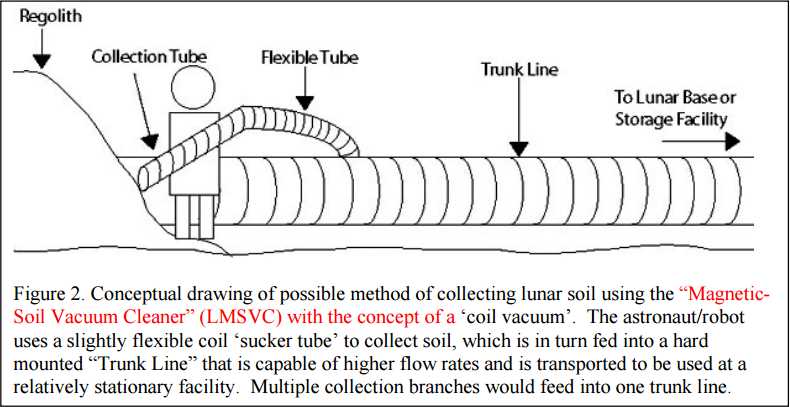
Neither of these solutions would work on Mars of course, or at least not for long, with the dust storms spreading the dust.
The other thing you can do is to use the SuitPort
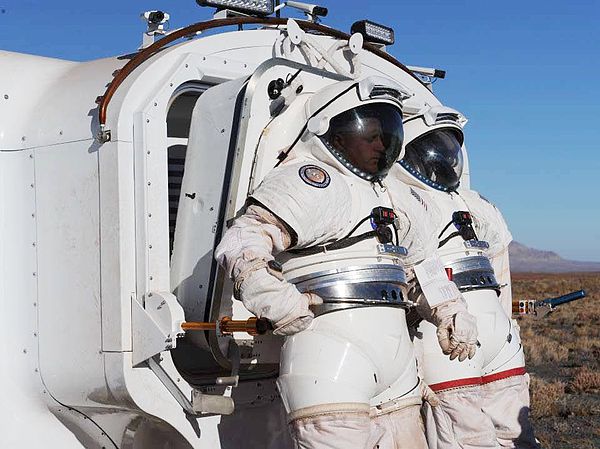
How it works is that there's no airlock, instead you crawl into it from the back. Like this:
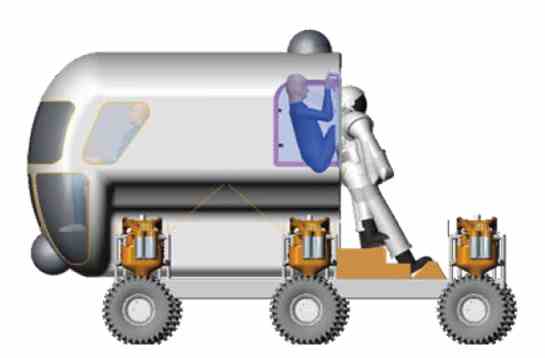
It has separate seals for the spacesuit and for the habitat or rover, with a gap in between. After you get into the spacesuit, you seal them both and then separate from the habitat. You lose about a cubic foot of air, so much less than for a normal airlock. Techy details of how it works here. It is fully automated and, from the suit donning instructions in the patent you can see that everything is initiated by the astronaut with no need for help from inside the habitat.
The big advantage there is that the suit remains always attached to your habitat on the outside, so you never bring it inside. Most of the dust during the Apollo missions came into the habitat on the outside of the suit, so that will get rid of nearly all of it. And you can don it quickly also, as it supports cabin pressure so you don't need to do prebreathing and to use pure oxygen, but just use the same air pressure as the habitat.
There's another more far future idea, which someone came up with in the late 1980s, of a sump type liquid airlock. That would remove just about all dust,with no loss of air, but would mean the spacesuit has to be capable of being submerged in liquid.
The dust can be tolerated short term as the astronauts on the Moon did fine, but some found it a sensory irritant. It might be unhealthy long term though, and the dust is too fine for the cilia in your lungs to get rid of it. So it's a significant issue, though Mars dust would probably be a fair bit more hazardous, so it's still plus points for the Moon here in the comparison.
I think actually that probably in the future human astronauts on the Moon will do a lot more via telepresence and telerobotics than they do at the present in the ISS. On the ISS then the astronauts do EVAs quite often. But it might be that this gets quite rare in the future, with them usually doing the EVAS from inside via telepresence.
Telepresence might seem distancing,but in some ways you might actually experience it more directly, because you wouldn't have a spacesuit in the way and would be much more mobile, with haptic feedback etc. So I think as robotics advance, it's quite possible that doing telerobotic exploration like that may come to be thought of as more immediate an experience than being out there with a spacesuit between you and the lunar surface. That's just my own thought there :). Probably still do some EVAs though and then the dust would be a hazard.
I should mention this, since the topic is brought up so often in discussions of lunar settlement. However I don't see this as a major plus point for the Moon at present.
The Moon is a source for helium 3, deposited in the regolith by the solar wind, and some say that helium 3 will be of value for fusion power in the future because it is not radioactive and doesn't produce radioactive waste products. If so, small amounts of helium 3 from the Moon could be worth a lot on Earth and be a useful commodity to export. Apollo 17's Harrison Schmidt is a keen advocate of helium 3 mining on at a reasonable rate at a reasonable rate the Moon.
However, we don't yet have fusion power plants at all, and one able to use helium 3 is a tougher challenge. Frank Close wrote an article in 2007 describing this idea as "moonshine" saying it wouldn't work anyway. Frank Close says that in a deuterium - helium 3 tokamak, at normal temperatures for a tokamak, the deuterium helium 3 reaction proceeds so slowly that the deuterium would instead fuse with itself producing tritium and then fuse with the tritium (the original article is here, but it's behind a paywall). For a critical discussion see also the Space Review article The helium-3 incantation
See also Mining the Moon by Mark Williams Pontin. If you can use much higher temperatures, six times the temperature at the centre of the sun by some calculations, the helium 3 will fuse at a reasonable rate, but these are temperatures way beyond what is practical in a tokamak at present. The reason such high temperatures are needed for a tokamak is because the plasma is in thermal equilibrium and has a maxwellian distribution which means that to achieve a few particles at very high temperatures you have to heat up a lot of particles to lower temperatures to fill up the maxwellian distribution so that just a few will react. This is potentially feasible for the lower temperatures of DT but not feasible for the higher temperatures of 3He3He.
However if you use electrostatic confinement, a bit like a spherical cathode ray tube with the fusion happening at the center where the negatively charged "virtual cathode" is, then the particles are all at the same high energy and the result is much more feasible with lower power requirements. This is the approach of Gerald Kulcinsky who achieves helium 3 fusion in a reactor 10 cm in diameter. However though it does produce power, it produces only one milliwatt of power for each kW of power input so is a long way from break even at present.
Gerald Kulcinski who has developed a small demonstration electrostatic 3He3He reactor 10 cm in diameter. It is far from break-even at present, producing 1 milliwatt of power output for each kilowatt of input. See A fascinating hour with Gerald Kulcinski
Perhaps this line of development will come to something. Perhaps one way or another we will achieve helium 3 fusion as the enthusiasts for helium 3 mining on the Moon hope. However it is early days yet, and we can't yet depend on this based on a future technology that doesn't exist yet.
However even if we do achieve helium 3 fusion, it might not be such a game changer for the lunar economy as you might think. Crawford says (page 25)"* that to supply all of our energy from Helium 3 would mean mining 5000 square kilometers a year on the Moon, which seems ambitious (and would mean the whole Moon would only last 200 years). So, even if we develop Helium 3 based fusion, and it turns out to be a valuable export, it's probably not going to be a major part of the energy mix.
Even more telling, he also calculates that covering a given area of the Moon with solar panels would generate as much energy in 7 years as you'd get from extracting all the Helium 3 from that region to a depth of three meters.
Also - there are many other ideas being developed for nuclear fusion, such as laser fusion, and the Polywell which has the same advantage that no significant radiation is produced when it uses fusion of boron and hydrogen. I think it is far too soon to know whether or not the helium 3 on the Moon will be an asset in the future when we achieve nuclear fusion power. For a summary, see ESA: Helium-3 mining on the lunar surface.
This doesn't mean that there is no point in helium 3 mining however. As Crawford suggests (page 26)"* , Helium 3 is useful for other things, not just for fusion power. It's used for cryogenics, neutron detection, and MRI scanners, amongst other applications, so some Helium 3 from the Moon could be a valuable export right away, even if it doesn't scale up to the huge quantities you'd need for Helium 3 based power generation on Earth.
You'd get it automatically as a byproduct while extracting the more abundant volatiles from the solar wind in the regolith, so it might well be a useful side-line to help support lunar manufacturing economically as part of the mix along with everything else.
The Moon has some uranium, which is a bit of a surprise for such a heavy element, but when bound with oxygen it is rather lighter and can occur in the lunar crust as on Earth. It is especially rich in Thorium, in the lunar Mare. This is useful as a fuel for nuclear fission reactors, which have to be designed to burn thorium instead of uranium to use it. It's not likely to be worth returning to Earth as thorium is abundant here. But it could be very useful in space, at some point in the future.
Nuclear power stations built on the Moon wouldn't have the same pollution hazards and hazardous waste issues as stations on the Earth. Perhaps this may be a way to power space colonies, and interplanetary ships fueled from the Moon, so avoiding the need to launch nuclear power plants from Earth to orbit.
Thorium is a tracer for KREEP - potassium, phosphorus and rare earth elements. Also associated with chlorine, fluorine, sodium, uranium, thorium, and zirconium, so KREEP ores could be sources for all those elements on the Moon.
When the Moon cooled down from the original molten state, then olivine and pyroxene crystals form first, and sink to the bottom of the magma ocean (both made of iron and/or magnesium plus silicon and oxygen). Meanwhile anorthite also forms (made of calcium, aluminum, silicon, and oxygen), which is less dense and floats to the top (forming the lunar highlands). Some of the other elements like nickel are able to squeeze into the crystal lattice and get removed at the same time. But the larger elements can't, and are left in liquid state. They are last to solidify and form the KREEP deposits. It forms in between the olivine and pyroxene deep down, and the floating anorthite on top and may have been liquid for a long time.
For some reason, not fully understood, then KREEP deposits on the surface of the Moon are concentrated on the near side of the Moon near the Imbrium basin, with a small amount also in a separate concentration on the far side. The Imbrium impactor probably excavated the KREEP deposits on the near side. But it's puzzling that the much larger Aitken basin didn't lead to large deposits on the far side. Perhaps for some reason KREEP is concentrated on the near side of the Moon. For more about this see The Moon is a KREEPy place by the planetary geologist Emily Lakdwalla which I summarized here.
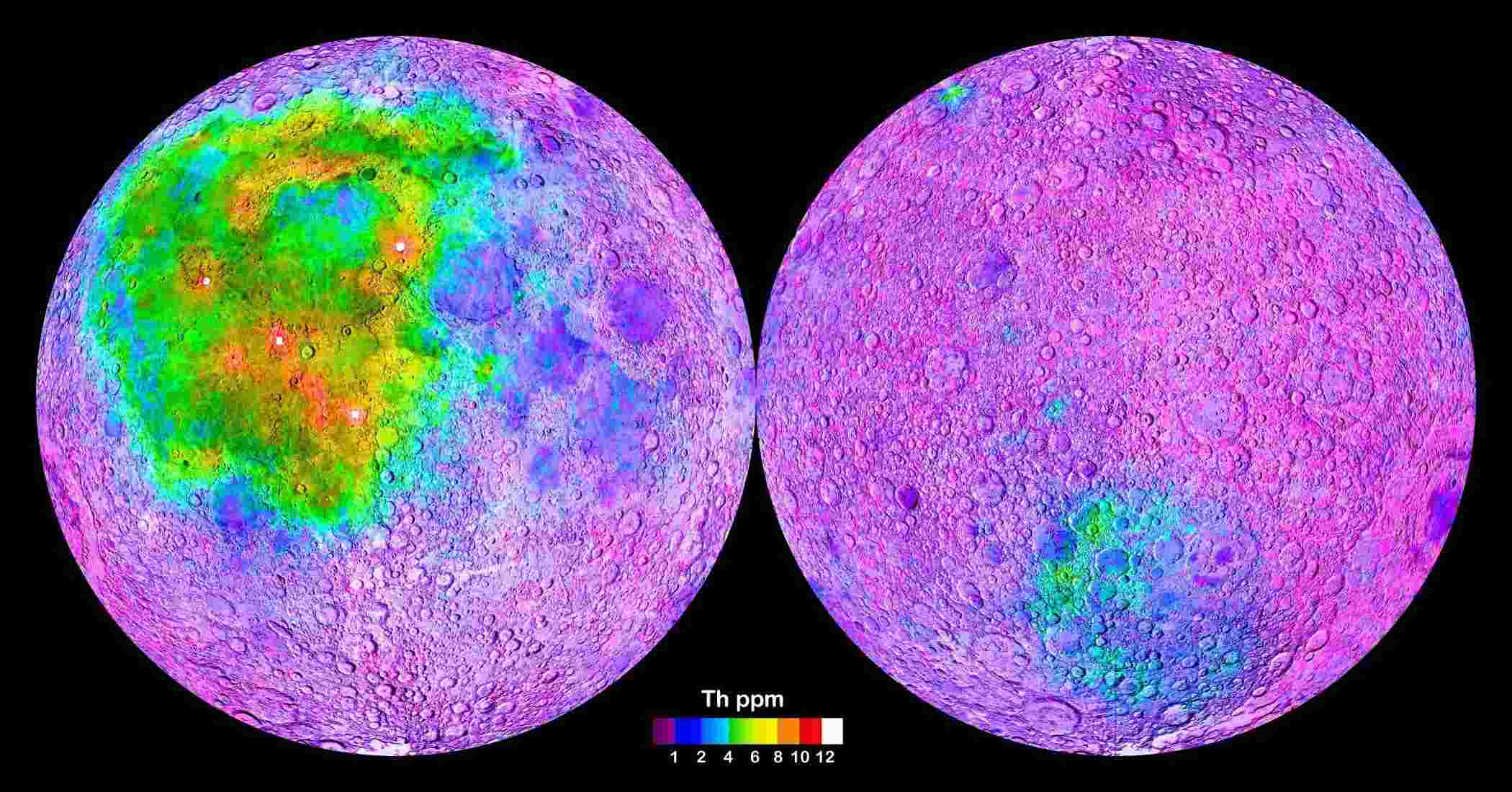
The abundances of rare earth elements on the Moon are much less than rare earth ores on Earth, and despite the name, they aren't very rare here on Earth. So it's not likely that they'll be worth returning. However the most concentrated spots - the ones marked white in this figure - haven't been sampled on the surface and the spatial resolution is low, tens of kilometers. So it's possible we'll find more concentrated ores on the Moon.
It's a similar situation for uranium and thorium. The abundances on the Moon from this map are too low to count even as a low grade ore on Earth. But with such low resolution, there could be richer ore deposits when we look at it closely. (Here I'm summarizing what Crawford says about lunar KREEP ores in his survey, see section 7, Rare earth elements and following)"*
Yes the Mars near to 24 hours day is a remarkable coincidence. But - it's not so much of an advantage over the Moon as you might perhaps think. The 24 hour day of Mars actually leads to huge differences of temperature between day and night in Mars' very thin atmosphere. At night in the Martian "tropics" the air gets so cold that carbon dioxide freezes out as dry ice, carrying water with it to form the Martian frosts photographed by Viking. While in the day time the temperatures can get well above zero at times.
You might think the Moon is even worse with its 14 Earth day long night. But there's one other big difference between the Moon and Earth, that turns out to be very important. Unlike Earth and Mars which have an axial tilt of over twenty degrees, the Moon has a tilt of only a bit over 1 degree. In a very "messy" system, it's remarkable that the Moon's axis is so vertical.
Diagram from NASA. With the Moon's orbit tilted by 5.14°, Earth tilted by 23.4°, yet the Moon's axis is pretty much vertical, only tilted by 1.5424° to the ecliptic (the apparent path of the sun through the sky). This remarkable coincidence is the reason the Moon's poles are so habitable.
This means it has no seasons, and as a result, you get points at the poles that are in almost constant sunlight, the peaks of eternal night, and just next to them, permanently shaded craters.
So, yes, the lunar night is a major challenge. But it does have the advantage of these peaks of (almost) eternal light at its poles where the temperatures are much more even, neither too hot nor too cold. (The average temperature may seem rather chilly at -30° C, but it varies by only 10° C in either direction and that's warm enough that a habitat there can be kept at a comfortable temperature of 20° C with the aid of a solar collector.
Some of the lunar caves probably have an internal steady temperature of around -20 °C (see page 5 of this paper)
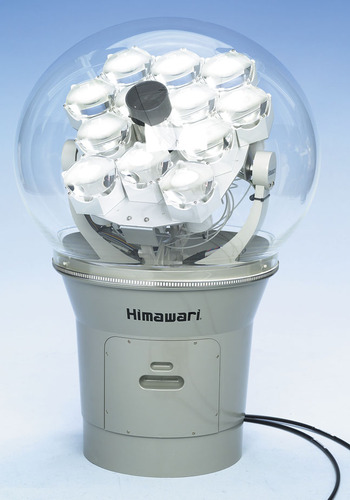
Hamiwari sun tracking solar collector - the light is collected, focused and sent through fiber optics to the interior of the spacecraft or habitat, where it can be used as a light source for algae or growing crops, or to help keep it warm. Details of how this would work for spacecraft, see page 319 of Peter Eckart's book: Spacecraft Life Support and Biospherics.
See peaks of (almost) eternal light in the online NASA astrobiology magazine). Compare that with Mars, where for for 200 days of the year, even at the equator, it gets so cold at night that dry ice condenses out as frost (mixed with water ice), while in the day time the temperatures can get well above 0 C and you can see that thermal regulation would be far easier at the lunar poles.
The best place for long term settlement on the Moon as they explain in the ESA video also, may be these peaks of (almost) eternal light. They are best for power too, as they get solar power almost 24/7. There are a few hours and occasionally periods of several days in the year (Earth days there) when they don't get solar power but for most of the time there is just sun 24/7. So they do much better than Mars in that respect. See also the section lunar poles (below).
So, when you are at the lunar poles, it's like a perpetual Arctic or Antarctic equinox with the sun skimming the horizon, seeming to circle around you once every 28 days. If you have solar panels mounted upright, which rotate once every 28 days,they can then follow the sun and get maximum solar power. The reason that can happen is because the Moon has an axial tilt of only 1.5424°. Basically, the Moon doesn't have seasons like Earth. Earth has seasons because of its axial tilt of around 23.4° at present (varies slightly by around one degree or so between 22° 2′ 33″ and 24° 30′ 16″ with a period of 41.040 years).
You can also reflect sunlight to wherever it is needed, to power rovers exploring the permanently shadowed craters, or to supply power for mining the ice, or for solar power. To do this they could use TransFormers or shape transforming two dimensional robots. They have actuators to transform their shape, antennas to communicate, and reflectors and solar cells amongst many other possible components. For details of the concept see this article from 2014. For the idea of using them to reflect solar power into the lunar craters see this article.
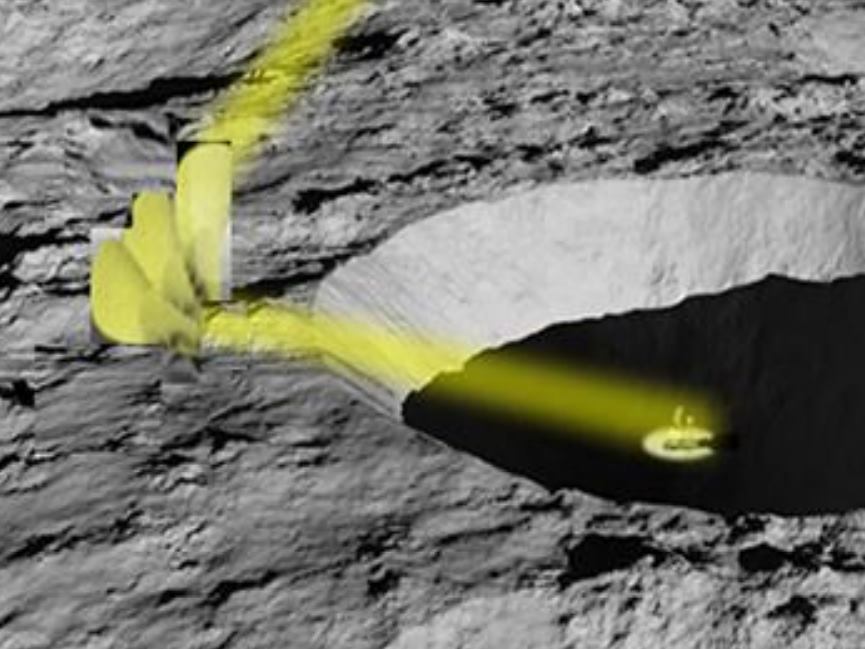
Using TransFormers as programmable flexible mirrors to power a rover, or to help extract ice for ISRU on the Moon. From this paper.
The Moon also has the lunar caves. These would shield from radiation, lead to a more even temperature again, may be possible to be made air tight, and as we saw, are thought to be possibly as much as several kilometers in diameter (only the Moon with its low gravity can have caves as large as that).
So, what happens to plants, won't the caves be too dark, for them? Well, yes, lights would be needed in the caves or anywhere on the Moon except the poles, during the long 14 day lunar nights. But they would be needed for plants on Mars too, during the dust storms, which block out 99% of the sunlight, often for weeks on end.
This used to be a major issue, because the lights for growing plants would consume a lot of the power of a space habitat with a greenhouse. But it's not a big issue any more. This is something that has changed a lot recently with the invention of LED lights. Even if you have to produce all the lighting for your plants through electric power, that's feasible. You need about 100 watts of supplied power for lighting for one square meter.
I am going there by this High Efficiency Full Spectrum LED Grow Light - uses 20 watts of power to illuminate 0.2 square meters. So that's 100 watts of supplied power needed per square meter. It is recommended for crops that require bright sunlight such as lettuces in this roundup in 2015: Top 10 Best LED Grow Lights
That's 3 kW per person for 30 square meters. However you only need it for 12 hours a day for 14 days. That makes it a total of 504 kWh of storage needed per person to provide lighting for the lunar night. You could generate power from fuel, or use batteries which are topped up when you have an excess of solar power. Power for the LEDs for your greenhouses doesn't seem likely to be a major issue for the lunar caves. You need power anyway during the night. For ideas of how this could be achieved see Power during the night.
It's also possible to deal with the lunar night by reducing the temperature of the plants from 24 °C in the lunar day to 2.5-3 °C in the lunar night (which helps maintain plant vitality during darkness). This was tested in an experiment by the Russians for BIOS-3. Of the ten crops tested, most were able to cope with this regime. The ones that couldn't cope were tomatoes, sedge nuts, and cucumbers. Wheat, barley, peas, turnips, dill, carrots, beet and radish were all able to survive a simulated repeated 14 day lunar night. The edible crops were reduced 30-50%. The most promising ones were carrots (73.5% yield), Beet (yield actually increased to 122%), turnip (57%), dill (72%), and radish (61.5% yield). See table 3 here (I've converted the figures to percentages).
So if you use that approach you'd need up to double the growing area, or around 60 square meters (probably a fair bit less depending on the mix of crops), but would be able to use natural sunlight so would not need to supply light to the crops during the lunar night at all. You could also have a mixed regime, supplying light during the lunar night only to the plants that require it, such as tomatoes, cucumbers, etc, and the ones that most benefit from light during the lunar night.
Even though the "peaks of (almost) eternal light" experience nearly continuous sunlight, they do go dark during eclipses. Also depending on the local topography, they have periods of darkness of several days at a time.
One way to deal with this is to raise the fibre optics solar collectors and solar photovoltaic panels on towers.
This idea goes back at least to 1990. If the Moon was a perfect sphere, then you would be able to achieve sunlight 24/7 (except during eclipses) with a tower 622 meters high.
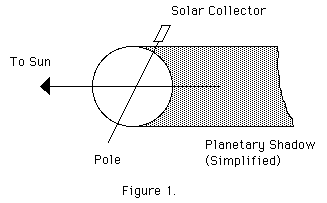
Figure 1 from Arnold Reinhold's paper
See the section Description of idea in this paper A Solar Powered Station at a Lunar Pole by Arnold Reinhold. That's a major construction project but it would be easier to build on the Moon.
However the Moon isn't perfectly spherical of course, and the peaks of (almost) eternal light are quite high already. So your tower wouldn't need to be as tall as that. As it turns out, you can make quite a difference with a tower only 10 or 20 meters high.
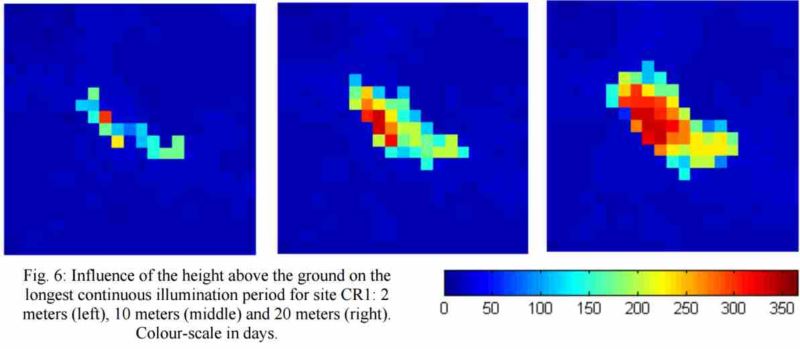
This figure shows the difference it makes to put the solar collectors or solar panels on a pole 10 meters high and then 20 meters high, to raise them above nearby obstacles, from this paper.
With the best location in this paper, near the South pole (see page 1077), a mast 10 meters high increased the average solar visibility from 92.66 to 95.83, that reduces the number of days of darkness in the year from 26 down to 15. So it can make quite a difference.
It also made a difference to the night events:
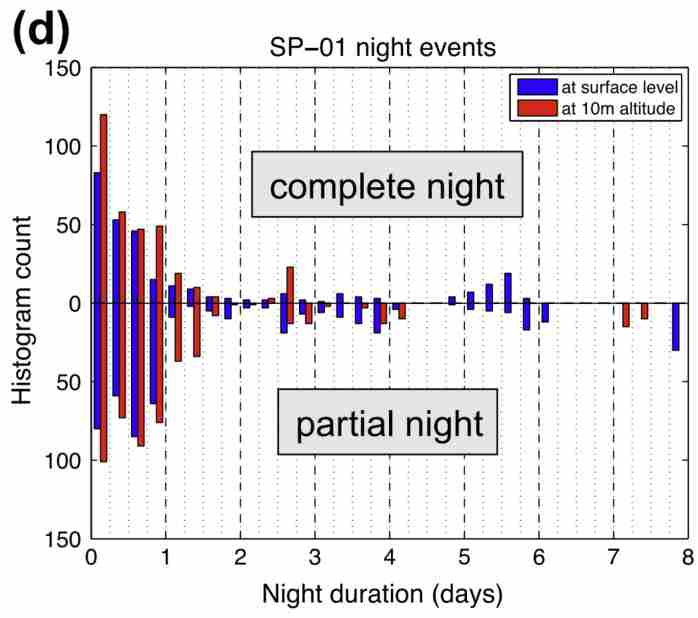
This table shows how the periods of total darkness are shorter at 10 meters,. The longest period of total darkness at the surface is 5.88 days, but it's only 2.75 days at 10 m. For partial darkness, the periods are 10.5 and 7.4 days respectively. From this paper.
Another approach is to find points close to each other such that one is in daylight when the other is in darkness. You can then route power from one to the other via a power line, or you can transmit the power using microwaves or lasers. One example here, page 9 two points 12 km apart, together have sunlight 97% of the year. Another example here, points A and B 10 km apart on page 562, figure 6b - B is illuminated for 82% of the year but when you combine it with A, then the result is illuminated 94% of the year.
This is another example
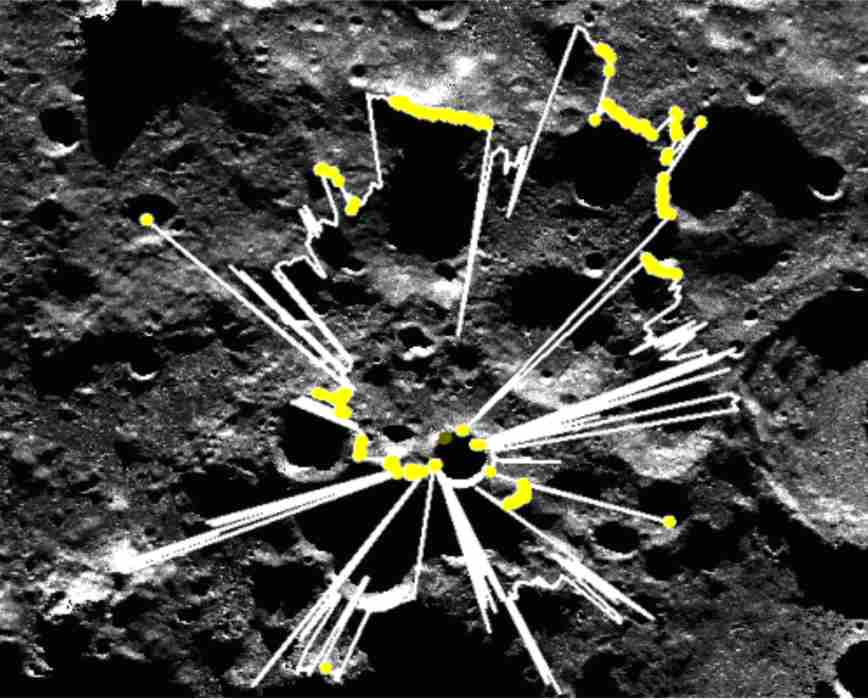
The white lines here show the local horizon as seen from this site in the South pole area on the Shackleton rim, and the yellow regions show the parts of the horizon that block the sun (less than 50% illuminated) on the worst day of the year. (Figure 11, page 16, explanation on page 6 of this paper). As you can see, many of the features that block the light are close to the site itself. Based on the analysis in the paper, this site needs a fast recharge power supply for a maximum of 62 hours or about two and a half days. With a coarser plot, the result was 156 hours, which shows how much a difference the local terrain makes. The results need to be validated against more independent images.
This is work in progress, as results are sensitive to details of the local topography, and the field is changing a lot with new high resolution data. We could do with even better elevation mapping of the poles.
So, the actual figures here might change as we learn more, but the basic idea is clear, that solar collectors on quite a short mast of 10 meters can often significantly reduce the length of the longest period of darkness and that it can also be reduced by using several collectors a few kilometers apart and transmitting power from one to the other.
Another idea which has been looked at is to use Earthlight to power a base on the Earth facing side of the Moon during the lunar night, when it is always between half and full phase. However, as Landis calculated, it's 10,000 to 20,000 times less bright than the sun. Even with one micron thick thin film mirrors, this doesn't seem to be very practical. See page 11 of this paper.
I haven't found any papers about this yet, so will just describe the issues. If you know of good citations do say. So, the thing is that shadows on the Moon are so very dark, that it's hard to see any features in them. Apollo 11 had to land during a narrow time window of sixteen hours every 29.5 days, so that they could see the lunar features during the descent flight path to the Moon. They could only land when the sun was at an elevation of between 5° to 14°. Too high and the sun would be directly behind them so that they couldn't make out any shadows at all, the landscape would be "washed out". Too low and most of the landscape would be shadowed.
The sun angle at the poles would be far lower, from 0° to around 1.5°, which would probably make it hard to impossible to do an Apollo style visual landing. Most of the landscape would be hidden by the long shadows of boulders, at ground level. We don't need to worry so much about the landing with modern technology and detailed 3D maps of the Moon, but the long shadows have other problems.
It will be hard to just walk around outside the base without artificial light. Although you would be walking in full sunlight, most of the ground at your feet would be in pitch darkness. There'd be some scattered light from the brighter pats of the landscape, but the bright landscape will also stop your eyes from dark adapting, so you won't see much in the darkness. So I think you will need bright lights to shine into the shadows to walk anywhere around the base. I don't see this as much of an issue, but it is something to think about.
Another problem is that if you park a rover next to the habitat, then at certain times of the lunar month, the rover will block the sunlight. It's the same for anything else you park or any structure you put up next to the village. The habitats will block each other as well.
So - this is just a suggestion, but I wonder if it would work best to have a multi-level village? Some of the habitats could be raised on legs above the landscape rather like Belgium's first ever "zero emissions" Antarctic base, the Princess Elisabeth Antarctic Station,
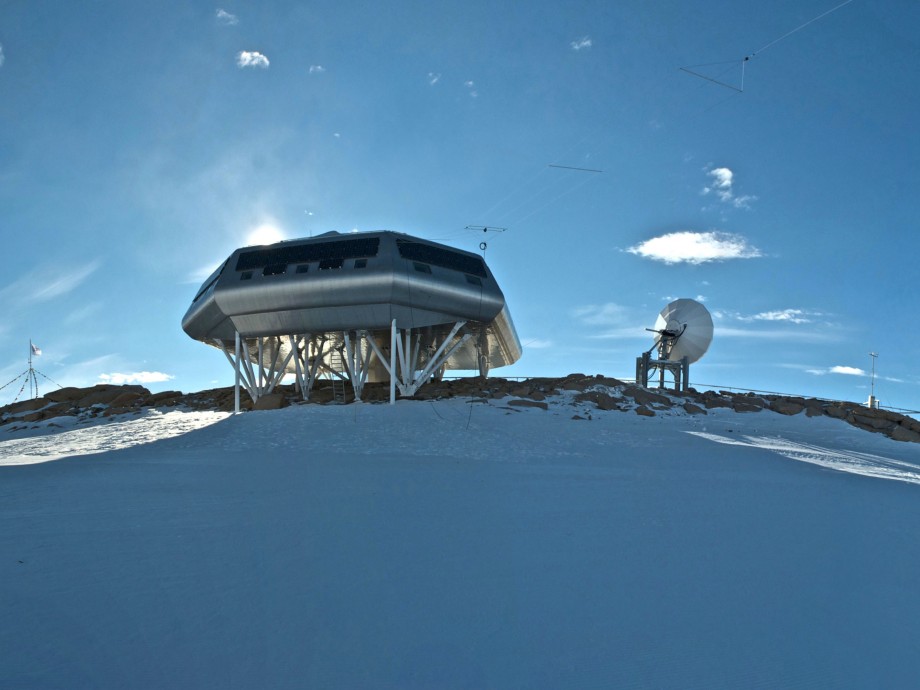
You could park your rovers beneath it. You could also have ramps or lifts to get down to the ground level from above. Of course it would have to be more rounded than this one.
The habitats could also be at slightly different layers and if you had a greenhouse, it could be at the top, center, a few meters above everyone else. The solar panels and solar collectors would be much higher on five or ten meter posts to avoid local relief, so they would not be affected.
Often it's as much of a problem to keep a space habitat cool as to keep it warm. The ISS has large heat rejecting panels, six of them, each able to reject at least 11.8 kilowatts of excess heat from the ISS. (See also "Explore the Space Station" with the radiators labeled)
This is another advantage of the lunar poles is that it's really easy to design heat radiators. You just need to set the radiators flat on the ground, and then the sun will only ever catch them edge on. They are already in the optimum position for heat rejection, with no need for the radiators to move. (See page 584 of this paper).
It's harder to do this at lower latitudes. One approach is to use heat pumps to increase the temperature to the point where the heat can radiate easily even in the lunar day. Or the heat rejection radiators can be shaded so that they remain cool. Or you can use a combination of both approaches.
If the base is sited at the lunar poles, you still have occasional periods of darkness with the peaks of eternal light in the local "winter" of up to several days long. If the base is sited in a lunar cave at lower latitudes you need power for the 14 Earth day long lunar night. One way or another you need a way to deal with periods of darkness.
The caves and bases anywhere except at the poles would also need extra power for growing plants in the lunar night. Until the invention of LED lighting, this was a major issue. However, with modern LEDs requiring only 100 watts per square meter, and efficient growing methods for plants with only 30 square meters per colonist, then you need only around 500 kWh per colonist per lunar night (see Lower power LEDs for plant growth through the lunar night).
Those 500 kWh may sound a lot, but it corresponds to a manageable 750 kg of regenerative fuel cells per colonist to last the night, as far as agriculture is concerned. If you can use hydrogen electrolyzed from water during the day, it's more like 17 kg of hydrogen storage per colonist to last them through the lunar night, though that doesn't include the mass needed to store the hydrogen, separate it and recombine it. Hubble uses nickel hydride batteries. The ISS used to use them as well.
A new type of battery of this type under development stores 0.14 kWh per kilogram, so if those were available, you would need about 3.57 tons of batteries per colonist, which yields when kept in darkness for the lunar night.
There are many other ways to store the power overnight including a lunar wadi idea of covering part of the regolith with an insulator at night to keep the heat in and using it like geothermal power as a heat storage - or molten salt which is what is typically used on Earth if you want to store large amounts of power for long periods.
So agriculture is not an issue for power. The ISS uses more than 3 kW per person, it's 75-90 kW so getting on for 15 kW per person though that is also including extra power to power up batteries to use during the night passes. Add an extra averaged 1.5 kW for agriculture it would be 16.5*24*7 = 2772 kWh or around 4 tons of batteries per colonist.
Its 4 kWh per kg for molten salt which would reduce that to 693 kg per colonist and even less if you use hydrogen storage which goes up to 120 kWh per kg, so 23 kg per colonist but with overhead of course. Keeping liquid hydrogen cool would be much easier at the lunar poles with the cold traps close by, and if you are creating it anyway for fuel to export to LEO, that's the most natural way of all to store power during the night.
For a detailed working out of power available and requirements for early stages of a lunar polar base (with Shackleton crater at the south pole as an example site for the base), including methods of transmission of the power, and storage on the Moon, see Power System Concepts for the Lunar Outpost.
We've also seen the possibility of making nickel iron batteries using lunar materials Electrical Energy Storage Using Only Lunar Materials.
This level of power is also just within the range you can supply continuously using RtGs, though it does require a fair number of them.
RTGs (Radio Thermal Generators) are used for some deep space missions and typically produce of the order of 100 to 200 watts to the spacecraft, by way of example, New Horizons had 202 watts available on arrival at Pluto. Cassini's mission to Saturn used 33 kg of Plutonium 238 (not the isotope used for nuclear bombs) with a total power output at the end of its mission of 600 - 700 watts.
RTGs are currently in short supply but both the US and ESA are working to deal with this issue. The ESA's approach is of especial interest for a lunar base, as they are working on americium RTGs with a lifetime of centuries instead of decades, for a power output of 1-2 watts per kilogram. You can get high quality americium as a byproduct from plutonium storage (the UK has a hundred tons of Plutonium in long term storage). The alternative of plutonium 238 (not the type of plutonium useful for nuclear weapons) has an energy density of 3 watts per kilogram. See Can nuclear waste help humanity reach for the stars?
This is a useful level of power, but the energy density is rather low. The 3 kWh peak power for plants during the day could be be supplied using 100 kg of plutonium 238 per colonist (at 3 watts per kg) or about 150 kg of Americium 241. That's about the equivalent of five Cassinis per colonist for crops during the night. Note, plutonium 238 is different from the plutonium 239 used for nuclear bombs. It is not capable of a runaway chain reaction.
Top of their list for storage of power are cryogenic regenerative fuel cells, batteries and flywheels. Flywheels have a much lower energy density (0.03 kWh / kg compared to 1.5 kWh/ kg for regenerative fuel cells) but have some advantages including a long lifetime. To supply power to rovers in the dark craters they suggest cables, or beamed power (via laser or microwaves) or using fiber optics to transmit light which they could use for solar power.
Other ideas suggested include hydrogen produced by electrolysis of water, stored and then recombined.
Hydrogen storage has amongst the highest energy densities, at 120 kWh per kilogram (the 502 kWh would then need only 4.2 kilograms of hydrogen generated per colonist during the lunar day), though of course that's just the mass of the hydrogen not including the mass of the system used to separate and store the hydrogen and to use it as fuel.
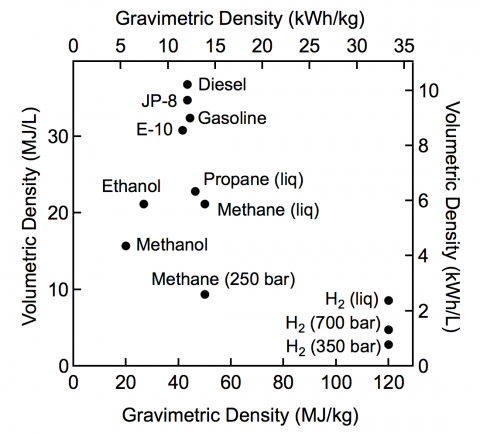
Table from Hydrogen Storage (UK Office of Energy Efficiency and Renewable Technology article about fuel cell technologies for electric cars).
One of the most common ways of storing energy on Earth is gravitational storage. However, that would be difficult on the Moon, because of its low gravity, a sixth of Earth's. You'd need to raise a 150 ton boulder by 30 meters to store 1 kilowatt hour. See page 4 of Landis's paper.
Thermal storage using molten salt is a good way to retain power for long periods of time. This is a frequently used technology on Earth used with solar power plants, to supply power during the night (here is a recent example which will have a 1100 MWh storage capacity in the form of molten salt). Molten salt can retain its heat for up to a week in facilities on Earth. It can achieve up to 1 kWh per kilogram, and some technologies go well over to over 4 kWh / kg (figure 8 here, review paper that goes into the various technologies currently being explored).
Superconducting magnetic storage is also another way to store energy, efficient, can stand many recharge cycles. However it has a low energy density of watt hours per kilogram. Once the superconducting circuit is charged, it won't lose its charge, can keep it indefinitely and the energy can be recovered at any time with only 5% energy loss. The main issue here is to keep the circuit cold enough, so it is mainly used for short term storage at present. High temperature superconductors may help with that in the future, but it still seems an outlier for the Moon because of its low energy density. This article is a useful overview of some of the main methods used for storing power on Earth with their advantages and disadvantages.
One other method that's been suggested for storing energy for the lunar night is to use the reversible reaction of CaO with H2O to produce Ca(OH)2 which liberates large amounts of heat. The CaO can be obtained from the lunar soil as a byproduct of aluminium extraction from anorthite. During the day, the CaO and H2O are dissociated again at high temperatures (550 °C) using sunlight for heat. This reaction is tricky to use for power storage on the Earth because of the presence of CO2 which leads to formation of calcium carbonate, steadily removing calcium oxide from the system. But on the Moon there is no CO2 naturally present so it would be easy to keep carbon dioxide excluded from the power generation and storage system, and the system could be cycled over and over.
Another interesting idea is a heat engine, powered by the difference between the lunar day and night. At the end of the day, you cover part of the sunlit surface with a reflective layer to hold in the heat, and then use the temperature difference between this and the lunar night to generate electrical power. See page 37 of the L5 society report.
There are several other ideas also in the Sacramento L5 society report. Including a long discussion of ideas for beaming energy from large solar panels in orbit and related ideas.
If we start with a lunar colony, as for the ESA village, then in the early days, for the first temporary visits to a polar colony on the Moon, astronauts could avoid the local lunar "winter" and could still be there most of an Earth year. Later you could put panels on several of the lunar peaks of almost eternal sunlight. You could use cables to transmit the power over a short range, and then microwaves or lasers for longer distances. Then the only periods without any solar power would be during the rare total lunar eclipses, requiring only hours of storage rather than days. In that way you would sort out the details of long term storage through the lunar night later on after you already have a fair bit of experience of living in the Moon.
Eventually, especially as metal refining takes off on the Moon, you could use HVDC for long distance transmission as is often done on Earth. Eventually perhaps have solar panels at various latitudes on the Moon, right down to the equator, and positioned so that there are always some panels in sunlight, and then you could have a power grid on the Moon which supplies solar power 24/7.
We can do similar things on Earth, long range transmission of power from places where power is readily available. We don't have to go as far as the other side of the planet - actually you can get abundant power even at night in the Sahara if you use the sun to store the heat as molten salt in the daytime to use to supply power at night.
Desertec was a project to supply pretty much all of Europe with solar electric power from the Sahara desert. The reason they never did that is mainly political, and the cost of setting it up in the first place. Desertec would have supplied power from Sahara to the whole of Europe including Germany, even up to Norway and Sweden. They would have used HVDC cables, including existing cables that connect the countries to each other already plus new ones for the project.

In this map, the existing HVDC cables are shown in red, and proposed ones, which would be used to connect Europe together to the power generating facilities in the Sahara desert are in blue.
The longest existing HVDC link in the world is 2000 km in China.from Xiangjiaba–Shanghai transmits 6400 MW of power over that distance according to the details here (see page 8). (would need to check but probably accurate).
A quarter of the circumference of the Moon is 2728.5 km which is the furthest you'd have to send power to get it to the middle of the night side from the day side of the Moon. It's not much more than the Chinese grid system - and you'd have less transmission loss in a vacuum.
With any of these approaches, even if you have cables spanning the Moon, you can't do anything about the times when the moon is eclipsed by the Earth. However, that would only be for a few hours per year for the partial eclipse stages, and totality for the longest duration total lunar eclipses lasts a little over 100 minutes.
This is a bit further ahead, but it is worth thinking about, whether solar power for the Moon could actually be useful for Earth also. Some scientists think it could be.
The advantage of doing this on the Moon is that you can use indigenous materials to make the solar panels. For a small amount of launch mass to the Moon you could have a rover that travels over the surface leaving solar panels in its wake. See Lunar glass and Solar cells from lunar materials - solar panel paving robot (above)
It's easy to see this working to supply power to the Moon, but some have suggested it could also be used to generate power on Earth. So, taking this even further, with a large scale operation of this type, using only 1% of the surface area of the Moon, you could supply 2 kilowatts of continuous power per person to a population of 10 billion on the Earth. See Solar Power via the Moon. More details here.
Or, further ahead, maybe this is more interesting as a talking point than a likely near future concept, the Japanese Shingzu corporation has suggested we could build solar panels in a band around the Moon - at the equator
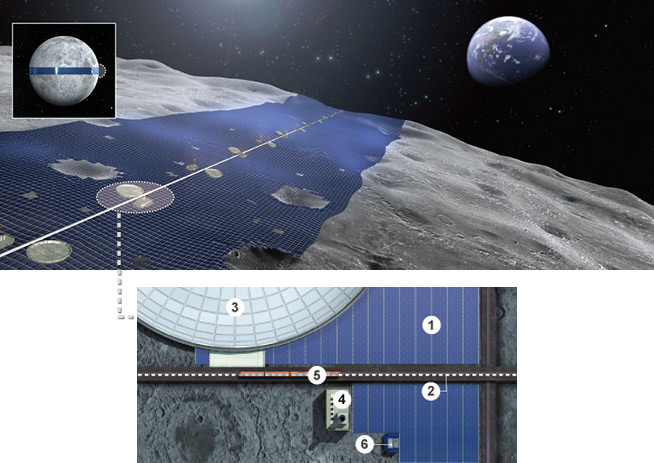
See Shimizu dream - Lunar Solar Power Generation - Luna Ring.
Earth would get solar power only half the day, so they send the power to satellites in orbit around Earth, which then beam it down to the other side of Earth. Of course they need large receivers to collect the power from the Moon, but only 1% of what they'd need to collect it directly from the sun - that could be worth doing if it is significantly easier to make solar panels on the Moon.
On the other hand there are ideas to use large thin film solar panels in space or large thin film mirrors to concentrate the light onto solar panels or furnaces, launched from Earth to LEO. So would the lunar solar plants be a major saving compared to those?
Another way that the Moon could help the Earth though, with solar power, is to make the solar cells from lunar materials, and then ship them to GEO or lower orbit. The idea of using lunar materials to make solar power satellites goes back at least to the 1970s, see Construction of Satellite Solar Power Stations from Nonterrestrial Materials
This section is mainly based on Peter Kokh et al's Railroading on Moon and Mars and "Railroading on the Moon"
If you have railways on the Moon, you can move large habs around. You might as well standardize to wide gauge lines too, as there's no difficulty finding space for the railway lines. Kokh et al suggests a good width might be double the width apart of a normal railway on Earth. Also there would be no height restrictions, at least to start with, so you could permit double story "compartments" as well. Your train "compartments" could be as large as a 747. Also, in a vacuum, they could travel at similar speeds to our airplanes as well, probably on maglev lines.
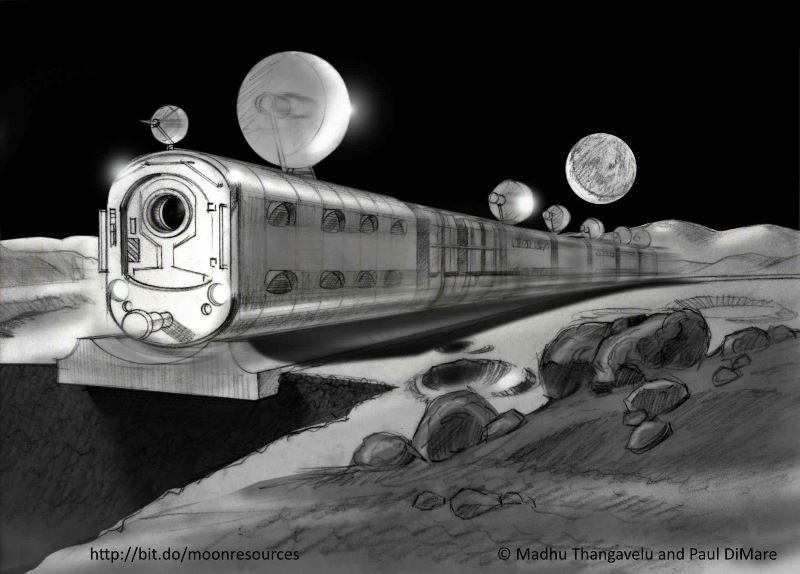
A maglev train like this could be double the width of any trains on Earth or wider, as we can set any gauge standard we like on the Moon. Its carriages could be as large as a 747. Artist's impression, illustration by Madhu Thangavelu and Paul DiMare © from The Moon: Resources, Future Development and Settlement
This way you could have transport between habitats, transport for tourists to see scenic sites, and you could also move the habitats themselves, for instance to build new lunar "villages". Also as on Earth you could use the railways to transport materials for building and repairing the railways themselves. They would probably be built with integrated solar panels along the length of the tracks to power them in the lunar day.
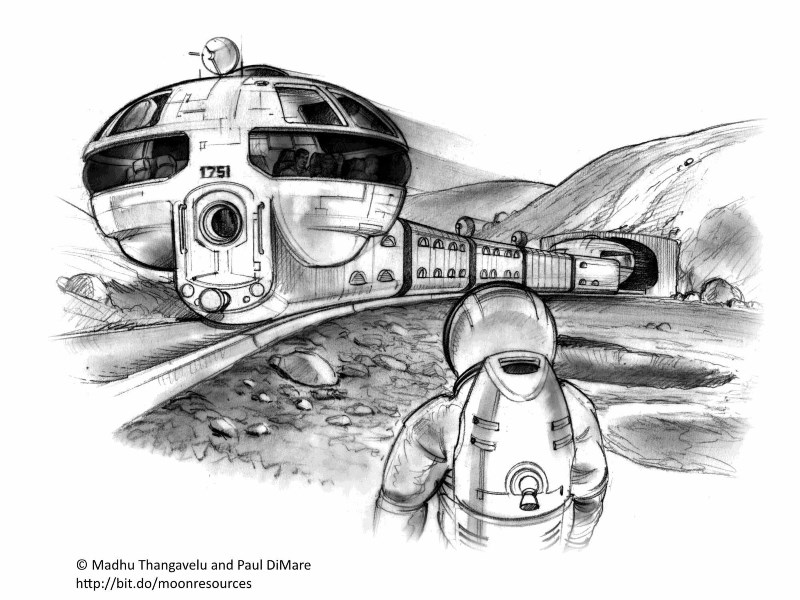
There is no air resistance of course, so the shape of the train doesn't matter. You could even transport complete habitats, far larger than the one in the illustration. Artist's impression, illustration by Madhu Thangavelu and Paul DiMare © from The Moon: Resources, Future Development and Settlement
They could also be used as launch assist, Kokh suggests that: "The LunaRail track could also serve as a launch-assist system, using 70 Mw to accelerate a payload at 3 g for 81 seconds to an escape velocity of 5,355 mph in a distance of about 60 miles.""
That also reminds me of an idea I've read before (I can't find it right now) of having a railroad all the way around the equator - or any other line of latitude, and to keep habitats moving on it so they are constantly in sunlight.
They could travel so that they are constantly at late afternoon on the Moon, giving nearly a fortnight to fix and repair any issue and restart before it gets dark if there is any problem. Habitats moving at 16 km/ hour would circumnavigate the lunar equator once a month so could stay in sunlight 24/7 apart from eclipses.
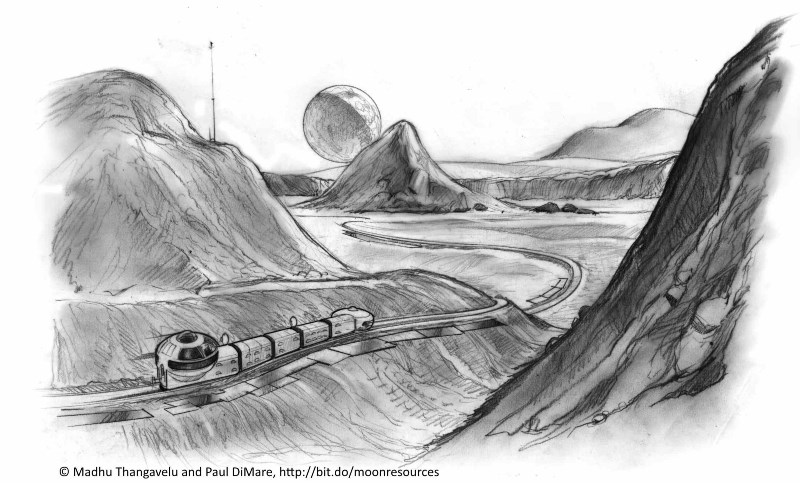
The habitats could even travel continuously, for instance along a line of latitude, to stay always in sunlight with full solar power - they wouldn't have to travel fast and if they kept towards the lunar evening, then if there were any faults, they'd have 14 Earth days to repair them before darkness approached. Artist's impression, illustration by Madhu Thangavelu and Paul DiMare © from The Moon: Resources, Future Development and Settlement
He doesn't mention it but perhaps HVDC lines could help solve the power issue for railroads once you have railways all the way around the Moon. See Powering the whole Moon in the far future.
One thing you'd have to deal with on the Moon for both railroads and habitats are the moonquakes. On Earth, railways start to get significant damage with earthquakes of magnitude of getting on for 6 see figure 1 in this article. Lunar quakes recorded with Apollo go up to magnitude 5.5.
This section is based on the NASA page on Moonquakes
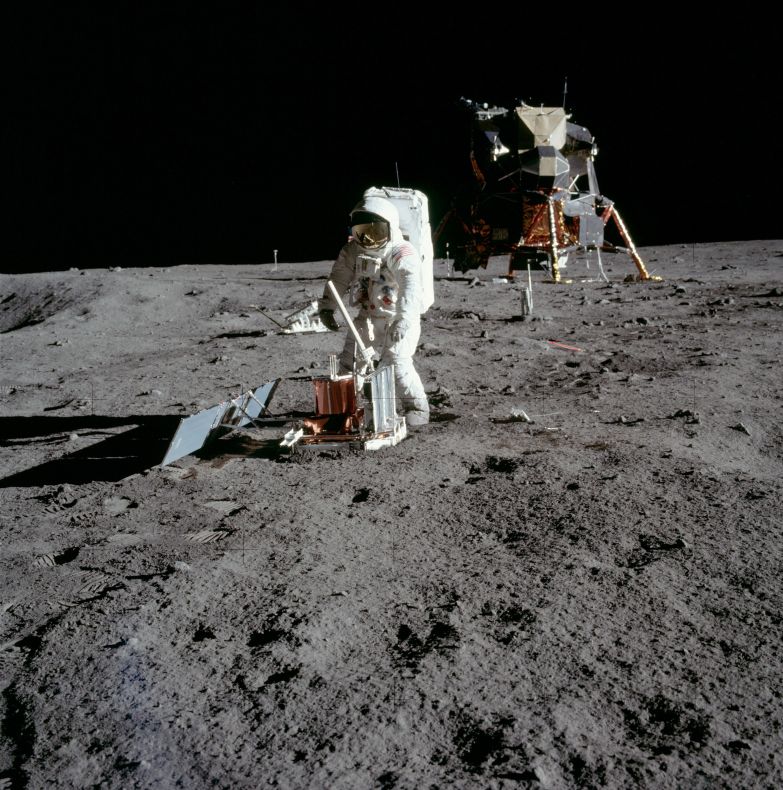
Buzz Aldrin deploying a seismometer in the sea of tranquility on the Moon. Apollo 12, 14, 15 and 16 also took seismometers to the Moon and their seismometers operated as a four station seismic network until they were switched off in 1977.
They found that there were four types of moonquake. The deepest, about 700 km below the surface, are probably caused by tides. Then you get vibrations from meteorite impacts, and thermal quakes from the expansion of the surface in the heat of the day and contraction at night.
Then finally you get the shallow quakes, only 20 or 30 kilometers below the surface. These are the strongest, magnitude 5.5 in the Richter scale. Nobody knows quite what causes them. They may be due to slumps of the rims of large young quakers. Since the seismometers were all near the equator, lunar seismologists are especially ignorant of what happens at the poles. They want to deploy a network of ten or twelve seismometers on the Moon before we send humans back there, to help determine where are the safest places to go.
Even the shallow moonquakes are not that strong compared with earthquakes. Magnitude 5.5 on Earth is enough to crack plaster and move heavy furniture. However they last a lot longer on the Moon. Weathering on Earth makes the ground much more compressible than it is on the Moon, where moonquakes can make the Moon ring like a bell. So these shallow moonquakes can last for well over ten minutes, compared with only a couple of minutes for Earth.

This table shows deep and shallow moonquakes recorded from the Apollo 16 landing site. It shows the x, y and z components as well as a short period z component. A meteorite impact (not shown here) has large x, y and z components but a very low short period z component. A thermal earthquake would show as a short duration signal in the SPZ graph only. The shallow earthquakes would be most damaging for habitats on the surface.
Lunar habitats would need to be designed with the moonquakes in mind. They would need to be built from materials that are somewhat flexible, and they'd also need to be able to withstand repeated bending and shaking, so it would be important to know the fatigue threshold. The same also would be true for the lunar railways, lunar telescopes, mass drivers and so on (for mass drivers, see Exporting materials from the Moon).
Since the Moon has no atmosphere, then astronauts there have to cope with micrometeorite damage.
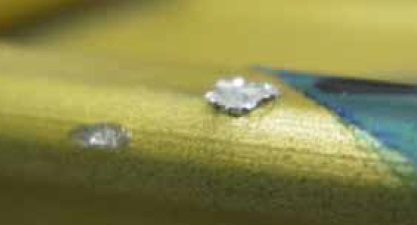
Micro-meteoroid impact damage - close up of handrail on the ISS. (Credit: NASA/JSC Image & Science Analysis Group).
These can damage astronaut's gloves. Larger ones can create holes in solar panels. This is an example from the ISS.
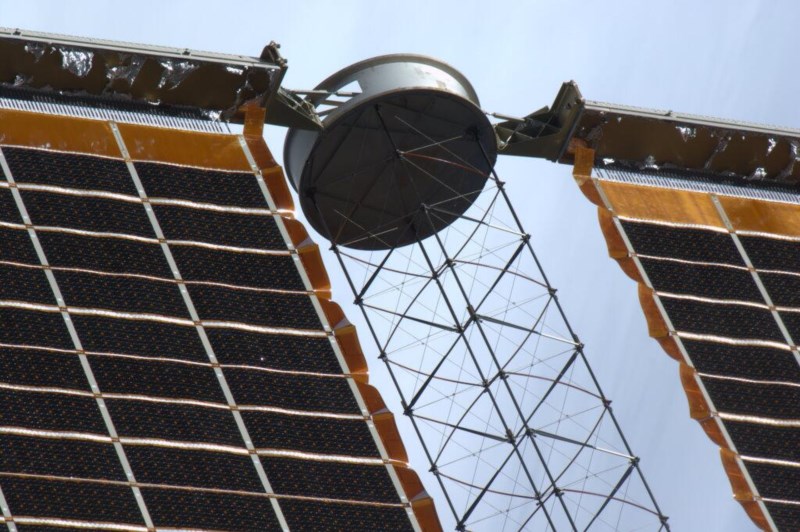
The hole in the solar panels towards middle left of this image was caused by a micrometeorite, or space debris. We have plenty of experience with protecting the ISS and other space stations from micrometeorites now, and the same precautions would be needed on the Moon. This photograph was tweeted by Chris Hadfield in April 2013. Solar panels have to be designed so they still work if you have a hole in them.
They are also a risk for astronauts on EVA. You can't protect against them completely. A report for the ISS in 2007 found that the chance of a micrometeorite or orbital debris penetrating the spacesuit of an astronaut doing an EVA is 6% over 2700 hours for a two-person EVA (i.e. 6% chance for two astronauts working for 337.5 "eight hour days"). So the risk isn't high, and it hasn't yet happened. But if we have many astronauts working out of doors on the Moon, for long periods of time, sooner or later one of them surely will be hit by a micrometeorite. The safest thing is to stay inside your habitat and use telerobots.
Habitats can be protected more thoroughly. The first defence is a whipple shield.
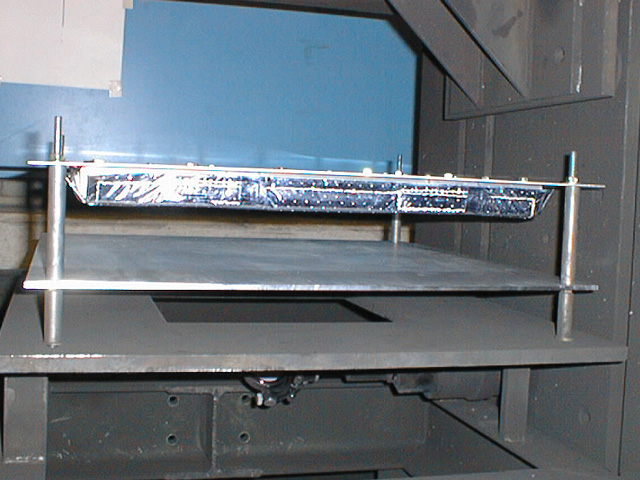
Whipple shield for the Japanese Kibo Laboratory on the ISS - before hypervelocity testing. A micrometeorite hitting the top surface gets disintegrated and some of its energy dissipated so that when it hits the habitat inner wall, it's no longer able to penetrate it.
Often extra layers or stuffing is added as well like this.
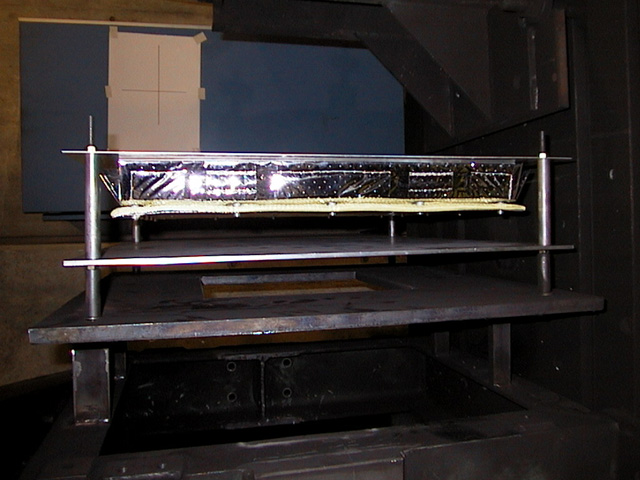
Whipple shield for Kibo with the stuffing added.
With these defences in place, the ISS is still not totally safe. The same report estimated an 8% chance of a micrometeorite or orbital debris leading to the ISS being abandoned within a 10 year period.
The habitats on the Moon would have a thick layer of regolith on top of the habitat so that provides extra shielding. But rovers and other vehicles traveling across the surface of the Moon would be more vulnerable as well as, obviously, astronauts doing EVAs. The study would need to be done afresh for the Moon anyway, as with a different gravity field, the impact velocity distribution of the micrometeorites would be somewhat different and there's no orbital debris of course. I haven't found a similarly detailed risk assessment for a lunar base - if you know of anything do let me know!
This is one of the few comparisons where Mars comes out top. It's thin atmosphere is still thick enough to screen out micrometeorites. On the other hand Mars does get ten times as many of the larger meteorites because it is closer to the asteroid belt.
Mars doesn't need any mitigation strategy for micrometeorites therefore. But the Moon does.
That 6% chance of a micrometeorite penetrating a spacesuit if you have two people working 8 hours a day EVAs for a year was higher than I expected. It's not so likely you get it happening on the ISS though it could happen. But if you have people working out of doors every day on the Moon, it is something that is pretty much certain to happen.
If they are test pilots or astronauts they take on huge risks at times, the Apollo astronauts knew what they were doing is risky, way above that 6% risk for just a single mission. But if you think of it as ordinary work / construction work, then it could be unacceptably high. And in either case you want to know what the risk is that you are taking.
Depends on whether those are risks of injury or death also. In the construction industry, there's a 3% chance of injury every year. So it's similar to that except of course this is only one of several risks from EVAs.
But if it was a 3% risk of dying, well most industries don't have a high risk of death as a result of doing your job. The risk of fatal injury from construction is 0.46 per 100,000 workers per year. Most people run more risk from the journey by car into work than from their job itself (unless the job involves driving of course).
So, if you want to compare it with everyday risks, it's better to compare with motor vehicle accidents,which in the US runs at 1 in 8,938 per year. If you want to reduce the risk from an EVA from the ISS to the risk of a motor vehicle accident in the same year, that means you need to do a maximum of 2700/(8,938/33.333) or 10 hours of EVA per year.
So, as it is now for an astronaut doing a single EVA, or a couple of EVAs, it's not like a huge personal risk at all. It's similar to their risk of a motor car accident in a year. It would be the same also for tourists. The risk from a single EVA would not be excessive. Indeed the biggest risk at present is getting into space in the first place.
But if you have people working every day in construction work on the Moon it would be a major risk, way beyond what you'd expect from any normal activities on Earth, if it is a risk of death. If it only causes injury it's similar to the construction industry.
So, what can we do about it? Well, first, astronauts do already have micrometeorite "armour" in their suits. The Thermal Micrometeorite Garment. They may be able to use other future materials such as this metal foam that can stop bullets. This deals with some of the risk, but that 3% per year figure was based on astronauts with micrometeorite armour already.
Then, I expect most construction work in the future to be done by telerobotics. After all the ESA plan to do all the regolith shielding using 3D printers controlled from Earth. The astronauts on the Moon might well stay inside their habitat or in roaming rovers for most of the year, and only do a few EVAs per year. They might be like the current astronauts on the ISS - do EVAs but only occasionally. Then the risk would not be excessive.
The other way to do it is to have the astronauts in mobile habitats. This is the NASA Multi Mission Space Exploration Vehicle exploring both an asteroid and the Moon
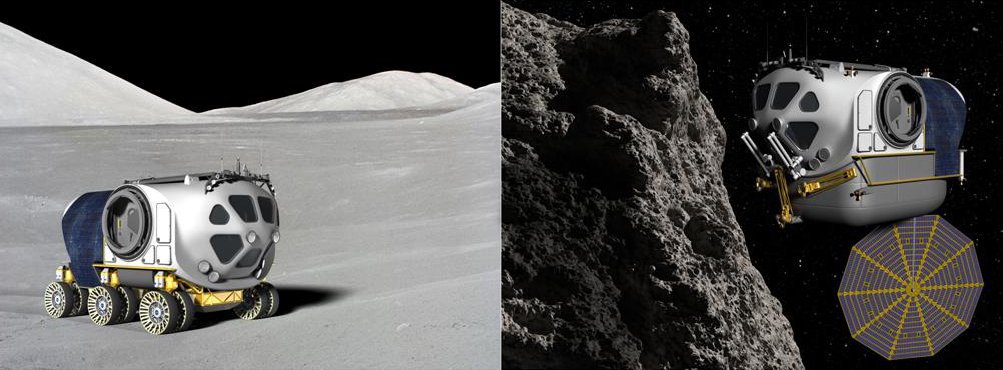
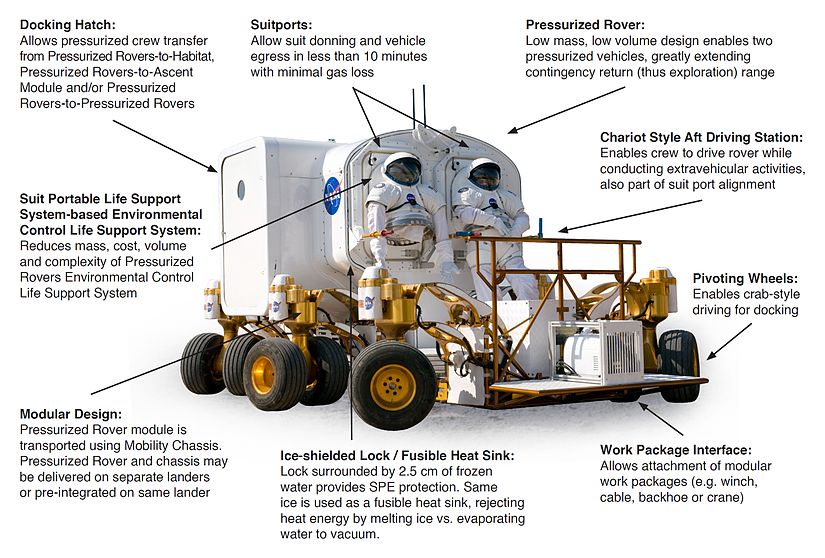
Anyway, an idea to suggest here for the Moon - these mobile habitats could have, not just whipple shields, but no reason really why they can't also have thick extra layers of shielding added to them by the same 3D printers that protect the habitats themselves as in the EVA plan. Those layers of shielding in their plans are hollow, cellular, filled with vacuum so light. I don't see why they couldn't also be applied to mobile habitats. They would then be very safe, also protected from solar storms too.
In the further future with lunar railways, you could use the same approach to protect the carriages from solar storms and even the largest of the micrometeorites.
Or there's this early 1967 Soviet idea of a self propelled self burying rover.
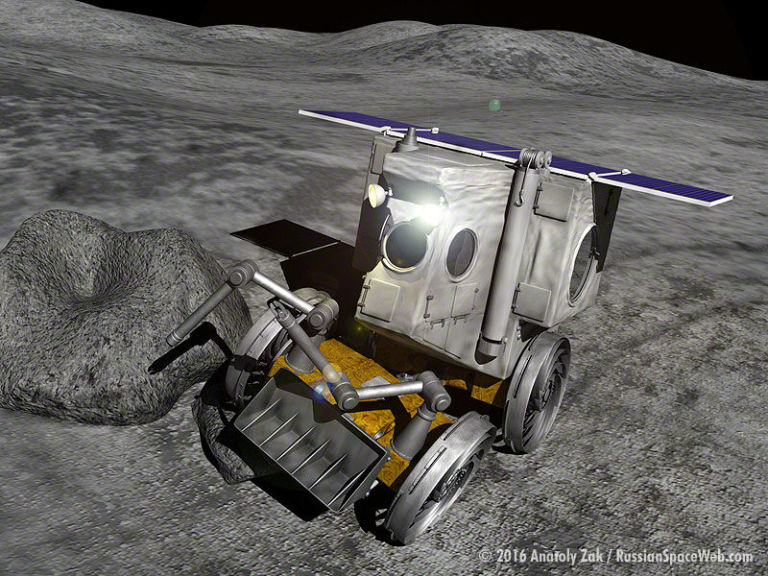
After traveling across the surface, it finds a soft spot to dig into the regolith for protection from solar storms. This would also protect the astronauts from micrometeorites.
Then, longer term, the Moon may develop an atmosphere as a result of industrial processes there. Indeed, it might be hard to avoid it. Hoekzema in An Atmosphere for the Moon concluded that
"Creation of a thin lunar atmosphere is perfectly feasible, even with present day technology, and in some scenarios even hard to avoid."
Once you have heavy industry on the Moon, it would be relatively easy to generate an atmosphere thick enough to stop micrometeorites and the worst of solar storms, yet it would be so thin it would be invisible to the eye. A hundred million tons of atmosphere would stop all micrometeorites and many of the larger meteorites as well. He estimated that a single large modern steel works on Earth, if located on the Moon, would liberate between a million and ten million tons of oxygen a year. The solar wind can only remove around 100,000 tons of the lunar atmosphere per year. So as soon as you get to the point where you add a million tons per year, the atmosphere will rapidly thicken.
It might well be something you want to prevent, see Lunar vacuum as an asset. But if moon colonists wanted it, it would be relatively easy to thicken the atmosphere to the point where micrometeorites are no longer an issue. It's also possible to go further and terraform or paraterraform the Moon but I'll leave that to later. See Terraforming the Moon
Solar storms can be deadly, and can lead to a lethal dose within hours. If astronauts were on the surface of Mars, the protection of the Mars atmosphere provides significant protection (the pressure varies a lot, seasonally and diurnally, but Curiosity measured on average 21 grams per square centimeter shielding from the atmosphere). The Moon has no protection however, and the same also applies to astronauts in transit to Mars. The effects are the same as for radiation sickness,
"Following large doses received in minutes to hours, acute radiation syndrome (ARS) can result. Depending on dose and dose rate, nausea, vomiting, skin damage, and blood cell depletion resulting in infections and bleeding. Following acute doses substantially larger than those expected during space travel, serious gastrointestinal and central nervous system damage may result leading to death within days or even hours depending on the dose and dose rate received"
Solar storm particles are low energy compared to the galactic cosmic radiation, so you can protect against them by using a "storm shelter" with about 4 grams per square centimeter of aluminium (figure from this paper, page 11), and less than that for low mass materials like polyethylene. The idea is that you go straight into the solar storm shelter as soon as you get warnings of a solar storm. If the astronauts also spend significant amounts of time inside the solar storm shelter during their mission it also reduces their overall dose (e.g. they could sleep in it, eat in it etc. during transits to Mars and in Mars orbit).
It's possible to get early prediction of solar storms, hours or even days before the main event, but the main problem with this is that 90% of them are pretty much harmless. You can't tell if it's going to be one of the most hazardous storms until at most an hour before the worst part of the storm hits. So astronauts doing EVAs are at most risk. They can avoid most of the risks by canceling their EVAs whenever they get warnings of storms - but that would mean many false alarms. If they can get to a storm shelter quickly, then it's no problem. For instance, you could provide a storm shelter inside a rover on the Moon, so it might be a case of making sure they can get back to the rover within an hour when a solar storm is predicted of any size.
Solar storms can happen at any time though they are most common during solar maximum. By contrast, Galactic cosmic radiation levels are highest at solar minimum (the increased solar activity deflects some of the cosmic radiation from the region around the sun).
If astronauts were caught out in a storm on the Moon they could be rushed back to the best medical facilities on Earth. But astronauts in space on their way to Mars or in orbit around Mars would not be able to be treated like that, though that risk is easily mitigated by having a solar storm shelter inside the spacecraft.
There's another technical difficulty, that we can't observe the far side of the sun from Earth, so when the astronauts are at the other side of the sun, the methods we use to predict solar flares for Earth and the Moon wouldn't work. So other methods would be needed to predict solar flares for Mars astronauts.
The Apollo astronauts were in significant danger from solar storms. There actually was a solar storm during the Apollo missions, in August 1972, but luckily there were no astronauts on the Moon at the time. It was after the Apollo 16 mission ended in April and before Apollo 17, the last mission to the Moon in December. They would have been exposed to 300 REM which is a dose that carries significant risk of death. See Sickening Solar Flares
If they had been on the Moon at the time, from the observations of a giant sunspot, even without not knowing in advance if it would send a solar storm to Earth, maybe they would have just cancelled the EVA and stayed in or close to the lunar module. In that case they could have used it as a storm shelter which would have reduced their exposure to a very survivable 35 rem.
However a detailed study here, estimates that with the protection they had from their spacesuits, there was only a 1% chance of death without adequate medical treatment.
For a storm two times as strong as the 1972 event, they estimate a 12% chance of mortality without treatment, and for a storm four times as strong, they estimate an 88% chance of mortality without treatment in the LEM, and an 87% chance of mortality if they are in a spacesuit for the worst 8 hours (supposing that they get back to a solar storm shelter afterwards).
So for these extremely strong, but rare solar storms, worse even than the 1972 one, then the risk of mortality is high on the Moon, if you are out doing an EVA in a spacesuit or thinly protected pressurized chamber like the LEM, hours of travel away from shelter.
All those risks go down to 0% mortality however, if they can get into a shelter with ten grams per square centimeter of aluminium, or a thinner layer of polyethylene (low mass atoms, especially, hydrogen are a much more effective protection from the low mass solar protons than higher mass atoms).
These estimates need to be treated with some caution because it's based on data from radiation exposure during nuclear explosions, and nuclear power plant incidents, which is a very different type of radiation. Also the details of the spectrum of energy levels for the solar protons varies a lot from one storm to another. (See Radiation Hazards and the Colonization of Mars)
The Apollo 16 or 17 astronauts of course would have been rushed straight into radiation treatment when they got back to Earth, if exposed to the storm. Based on this evidence, it seems that they would have survived even if caught out in the middle of the 1972 event in their spacesuits, or even a somewhat stronger one with immediate medical treatment.
The most dangerous solar storms can start rapidly, within tens of minutes or an hour.
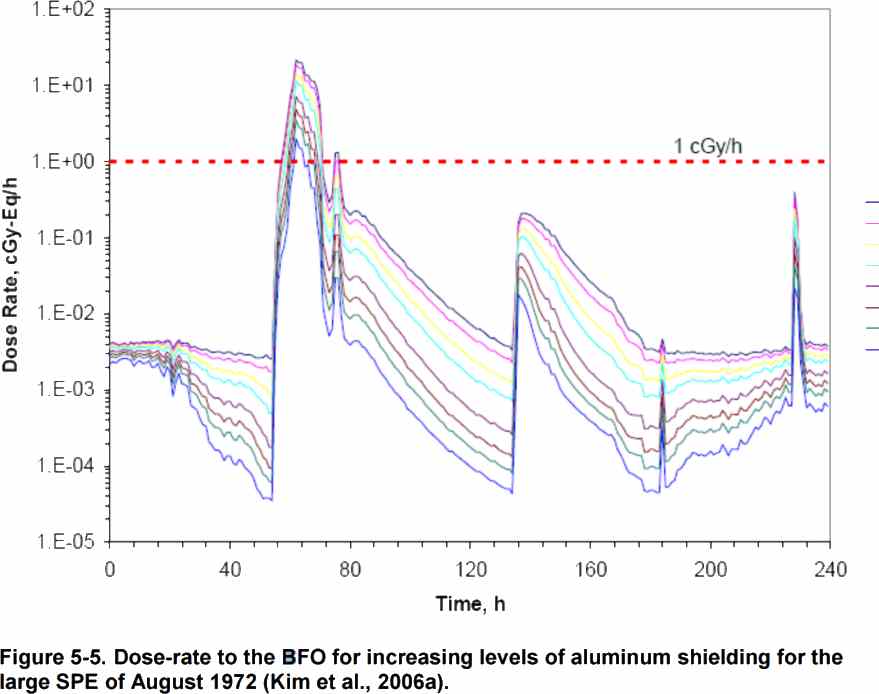
Figure from page 13 of this Risk of Acute Radiation Syndromes Due to Solar Particle Events. I think the curves are for grams per square centimeter of aluminium shielding. Anyway I include it here mainly to show the rapid onset of the solar storm, of the order of ten hours or so - and you don't know if it is going to be one of the dangerous storms until about the last hour before the peak.
So to be safe, you need to be within a few tens of minutes travel of a storm shelter at any time. Though most likely during solar maximum, they are unpredictable and can happen at any time.
So, these are things that we will have to take account of if we send astronauts back to the Moon. But it's not too dangerous so long as you have a storm shelter close at hand and can get back to it quickly. Astronauts in a lunar rover with a storm shelter inside the rover would be fine. If you went on a long EVA on foot far from shelter, or in an open rover like the one the Apollo astronauts used, you'd be at much more risk.
It’s the same on the way to Mars or in orbit around Mars also, unless you are in a cave of course. In Mars orbit, Phobos’s crater Stickney facing towards Mars all the time may give a fair bit of protection from solar storms, because a base there has the sun either hidden behind Mars or below the crater rim for all except a few hours of each Deimos orbit - it is tidally locked with Stickney facing towards Mars.
See also Overview of energetic particle hazards during prospective manned missions to Mars
We can get early warnings of solar flares, but this is challenging. See Risk of Acute Radiation Syndromes Due to Solar Particle Events
One of the main issues is that more than 90% of the solar storms are minor with only small radiation doses to critical organs. But astronauts might have to cancel their EVAs anyway because there's no way to know in advance what's going to happen until hours after the storm starts. It might be possible to have a one hour warning, but not much more. Attempts at a longer term warning would lead to many false alarms because of that 90% figure. The astronauts might have to put off EVAs ten times to avoid a single event like the 1972 storm.
The main increased risk here for Mars is that it's impossible to get back to Earth for emergency treatment after a solar storm if an astronaut does get caught out in it, while on the Moon, you'd have a better chance of surviving with emergency treatment within three days in the best hospitals on Earth. But either way you'd want to avoid exposure in the first place so I'm not sure this is a big issue.
There's one other - relatively minor - issue for Mars. We can't always see the side of the sun facing Mars from Earth, so would have to find some way to deal with that before we can predict solar particle events for Mars in the same way that we can for the Moon and Earth.
So the main risk here is for EVAs on the surface of the Moon (assuming that we have solar storm shelters in human occupied Mars transit spacecraft and orbiters). If you want to reduce the risk to a minimum, without numerous false alarms, you just have to keep within an hour or less of a solar storm shelter whenever there's a chance of a solar storm. The shelter could be in a rover, so that's not as restricting as you might think.
There are ideas for new materials that could make solar storm shelters much lighter. For instance, one material being researched is hydrogenated boron nitride nanotubes. The material is low atomic mass anyway, and then the tubes are packed with hydrogen atoms for more shielding. Boron is an efficient neutron shielder so will help deal with neutrons knocked out of the material by the high energy proton impacts. They are still in development, but could be useful for spacecraft, habitats and spacesuits.
As for the high energy galactic cosmic radiation, there's not a huge difference between the ISS, the Mars surface, and interplanetary space. The Earth's magnetic field can only protect against the lower energy particles. The fastest ones just go straight through without noticing it.
The flux of galactic cosmic radiation at the ISS is about half that in interplanetary space for GCR, and the same is true for the surface of Mars. While for solar storms it is very much reduced. But down on the Earth's surface, those low energy particles wouldn't get through the atmosphere anyway. Our atmosphere is like a protection layer of ten meters thickness of water above us, by mass. Even a Stanford Torus doesn't have that much shielding - they only have 4.5 tons per square meter cosmic radiation shielding.
Because those more energetic particles are so penetrating, the usual way to protect against them is through heavy shielding. So even with those advances in solar storm protection, if they work out, we will still need to cover permanent residences with layers of regolith shielding as well. Even for the ISS, if astronauts want to stay in low earth orbit for periods of many years at a time, the would need more protection from the cosmic radiation. The main risk for these, as a low radiation dose sustained over a long period of time, is neurological damage and an increased risk of cancer which could strike at an early stage.
Another approach that could work in the future, though not available yet, is a magnetic "force field" to protect the region around a habitat or spacecraft from solar storms and the lower energy cosmic radiation. CERN, in collaboration with the European Space Radiation Super Conducting Shield project are using advances in super conductor technology to develop a super conducting magnetic field to protect spacecraft and their occupants.
The aim is to create a magnetic field 3,000 times stronger than the Earth's to protect astronauts in a region of diameter ten meters enclosing the spacecraft or habitat. Only the very most energetic particles will get through, and the flux from these would be negligible. If this works out, the mass is not that huge, only 53.8 tons to protect a region of 10 meters in diameter.

"pumpkin shell" of superconducting magnets that might protect future interplanetary spaceships from particle radiation - details of the pumpkin arrangement (the figure above comes from those slides). Mass 53.8 tons to shield a region of about 10 meters diameter. The shielding is non uniform but you get much more shielding for less mass than a standard torus type arrangement.
More conventional earlier version of the SR2S - this also works but would be getting on for double the mass, a hundred tons upwards to protect ten meters diameter. See also SR2S technical accomplishments.
Mars does have an atmosphere, but it is a near vacuum. Less than 1% of Earth's atmosphere. This is not enough pressure to be a significant advantage over the Moon for greenhouse construction, as the lowest pressure greenhouses typically would be pressurized to around 10% of Earth's atmospheric pressure.
Example: if you have a greenhouse on the Moon at 10% of Earth' pressures, the atmosphere exerts an outwards pressure of one ton per square meter of the greenhouse. On Mars, on average, the outwards pressure on your greenhouse would be 0.93 tons per square meter. (assuming 0.7% of Earth's atmospheric pressure). It depends where you site it - at the bottom of the Hellas basin it is a little more, but remember you have to engineer for the lowest rather than the highest pressure there and it varies seasonally. The maximum pressure is 12.4 mbars for Hellas Planitia which means it requires at least 0.876 tons per square meter for the greenhouse though it is likely to be more than that to allow for the lower pressures in winter. At any rate it's a lot of outward pressure, not that different from the Moon.
The 10% figure here is nearly the lowest pressure greenhouse you can have and still have humans able to visit it using only an oxygen mask and not a full body pressurized spacesuit. If you go all the way down to 6.18%, right at the limit of tolerance with just an oxygen mask, then the figures are a pressure of 0.618 tons per square meter for the Moon and 0.548 tons per square meter for Mars average pressures. At lower pressures than that, the moisture lining your lungs, on your skin, in your mouth etc. will boil at blood temperature, so you can't survive without a pressurizes spacesuit.
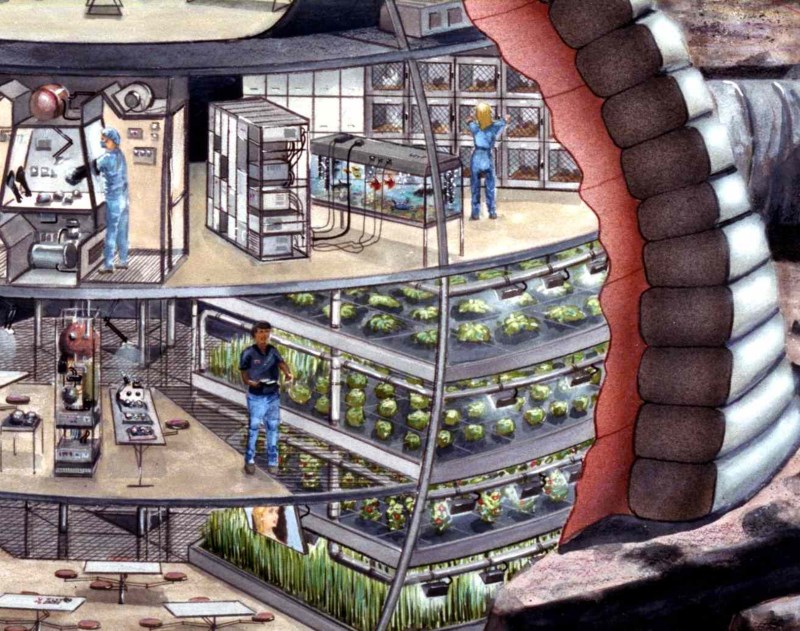
Detail of lunar colony showing a greenhouse inside a base. Detail from image from NASA, 1989. This was for the Lunar Oasis proposal for a ten year program to establish a self sufficient science outpost on the Moon to act as a test bed for space settlements.
If you build a greenhouse on the Moon or on Mars it has to withstand getting on for a ton per square meter of outwards pressure. It might be easiest to just put it inside your habitat as shown here. With a modern habitat it could be illuminated with efficient LED lights which require little by way of electricity and don't have problems of excess heat to get rid of. You could also pipe light into the habitat using optical fibres connected to solar collectors
Hamiwari sun tracking solar collector . The light is collected using fresnel lenses - when used for plants, then harmful frequencies in the UV and IR range are not collected, so it is optimized for photosynthesis.
Details of how this would work for spacecraft, see page 319 of Peter Eckart's book: Spacecraft Life Support and Biospherics.Alternatively you could use a spherical or tube shaped greenhouse.
Although you often see images of flimsy looking greenhouses similar to those on Earth in space colony art, an Earth type greenhouse wouldn't be able to withstand the vacuum or near vacuum atmosphere outside it, either on the Moon or on Mars. For instance a greenhouse rectangular in shape with a triangular roof would be an unlikely design for a greenhouse in space. It's more likely to be dome shaped or tube shaped with a reasonably equipotential surface unless it is very small or the coverings are immensely thick and strong.
The easiest way to grow plants for food in space is to use soilless gardening with hydroponic solutions or with aeroponics where plants are grown with roots suspended in a fine mist (uses much less water).
This leads to huge savings in the precious area you need to grow crops. Instead of one acre of farmland needed per person for conventional agriculture (4000 square meters approximately), you can grow 95% of the food, water and oxygen for an astronaut from just 30 square meters, with a conveyor belt system, of rapidly growing crops such as wheat, sedge-nut, beet, carrots, etc. For details see Sending humans to Mars for flyby or orbital missions - comparison of biologically closed systems with ISS type mechanical recycling (also relevant to long duration lunar missions). So early stages of agriculture on the Moon are sure to use more intensive methods such as this.
Soil based gardening can also be used with the methods of biointensive mini gardening. By using good gardening practices and by careful choice of crops you can grow all the food for one person in 4,000 square feet, about 372 square meters, or less than a tenth of an acre. That's intermediate between conventional agriculture and the conveyor belt type system of BIOS-3.

Grow biointensive - sustainable mini farming - this method needs only 372 square meters of growing area per person.
We can get an idea of how efficient these methods are by working out the total land area needed to feed the world on a vegetarian diet by all the methods. With a million square meters to a square kilometer, then we just need to multiply the numbers by 7,500 to get the area in square kilometers needed to feed a population of 7.5 billion. We get
By comparison, the Sahara desert is 9.2 million km². With the BIOS-3 system, we would need only 2.5% of the Sahara desert to feed the world. The total land area of the Earth is 148 million km². But of course much of that is desert, mountains, ice etc, some is uncultivated and animals require more land area than plants.
The surface area of the Moon is 38 million square kilometers. Indeed, a medium sized lunar crater 535 km across has sufficient land area to feed the whole world using the BIOS-3 system if you had the materials to cover it with greenhouses and enough air and water to produce growing conditions inside all those greenhouses. Mare Imbrium with a diameter of 1146 km has enough surface area to feed the world four times over.
Early experiments involving adding lunar material to hydroponic solutions suggested that the lunar soil was very fertile indeed as the plant growth was enhanced.
However later research suggested that the reason for this was a deficiency of trace elements in the hydroponics solutions used and that the plants were equally stimulated by some terrestrial soils.
A recent experiment using lunar soil simulants instead of the lunar regolith itself, and growing the plants in them directly found that the soil was not particularly good for plants, and that Mars simulants were better. However the Mars simulant contained trace amounts of organics and also held water better than the lunar simulant. Also heavy metals are an issue for Mars soil (they could not eat the results of their experiments because of the possibility of heavy metal concentration) as also is the case for the Moon.
None of this simulates the situation of gardening on the Moon or Mars using the soil itself as that would involve composting the residues of the first generation plants with micro-organisms to make a good top soil. You can't really expect plants to grow well directly in ground up rock without topsoil. Even after a single cycle of composting the residues, the result could be much more fertile.
Experiments with material from Apollo 16 showed that cabbage seedlings accumulated high concentrations of aluminium. Other experiments by Kozyrovska et al show that marigolds grown in terrestrial anorthosite accumulated heavy metals such as zinc, iron, nickel and chromium (lunar anorthosite forms the light areas on the Moon).
However when the marigolds were grown in a community of microorganisms in a model plant microcosm, this protected the marigolds against toxic doses of the heavy metals and also helped deliver essential nutrients to the plants.
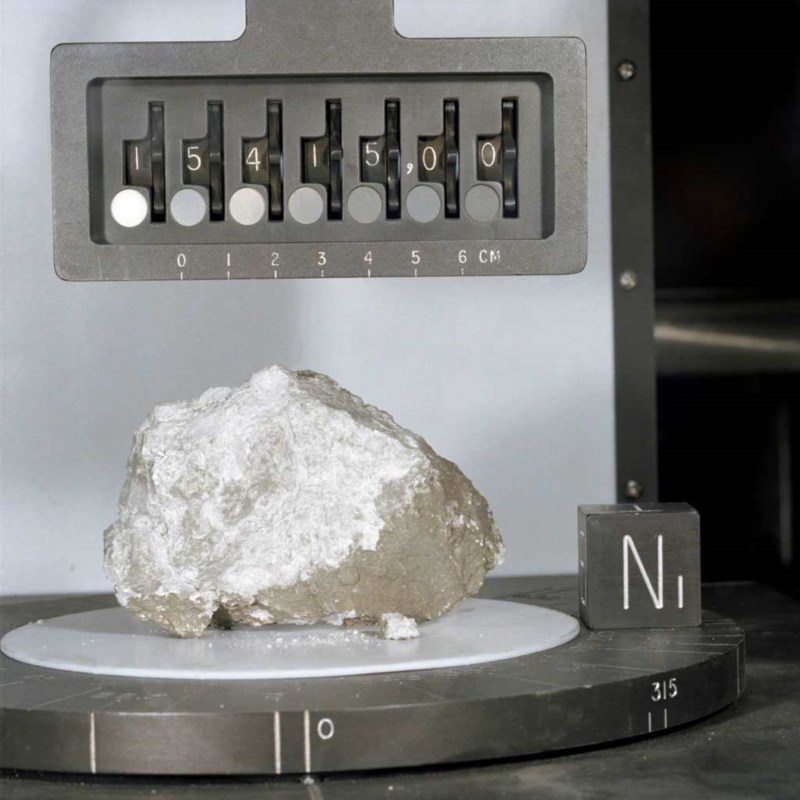
Apollo 15 "Genesis Rock" made of the lunar anorthosite which forms the light areas of the Moon. Marigolds grown in terrestrial anorthosite accumulate zinc, iron, nickel and chromium, however addition of bacteria helped correct these imbalances.
The Genesis Rock on the Moon before it was collected.

Marigold flowers (tagetes patula) photo by Dori - the experimenters tested marigolds in terrestrial anorthosite (a mineral common on the Moon), grown with a community of micro-organisms then marigolds are able to deal with the heavy metals in terrestrial anorthosite (a common lunar rock). This suggests that terrestrial plants can be used to convert lunar rocks into good top soil and that microbes can help protect plants from the high levels of aluminium found in the Apollo cabbage plant experiments.
Kozyrovska et al write:
"Our idea was to use the lunar soil for the pioneer plant growth and to convert the resulting plant biomass into so called protosoil, utilizing an optimized consortium of microorganisms."
Their experiments were promising. See Bioaugmentation in growing plants for lunar bases. The toxic heavy metals seem to be a surmountable issue. Another approach suggested by Haisong Liu et al. is to supply soil, and even seedlings, from Earth to get the process off to a quick start.
I'd like to suggest another idea here. Since hydroponics work well in the BIOS-3 experiments, one could also start by growing the first generation of plants hydroponically. Then you could use the plant residues to inoculate the lunar soil with organic material along with beneficial bacteria.
Also after whatever method is used for the first areas of good top soil on the Moon, the soil itself can then be used to inoculate larger areas of lunar soil with some of the top soil created earlier. The same methods could of course also be used on Mars, and Mars also has heavy metals in its soil. So in this comparison the two come out roughly equal.
See also Earth length day on Mars versus advantages of close to 24/7 solar power at the lunar poles
The atmosphere does help with aerobraking on Mars, but at a price of a much trickier landing. Typically you have to reduce speed from Mach 5 to Mach 1 and then convert to a lander, and land it on the surface all within 90 seconds. Then typically the parachutes only reduce the impact velocity to around 200 mph, so for the final few meters of the landing you need retropropulsion.
The lunar gravity is only a little under a half of the Mars gravity, so you might think there wouldn't be much difference, but there's a huge difference because of the rocket equation. You can see this difference with the Apollo lunar landers. Their small rocket motors were not only able to land two humans and their supplies on the Moon, but take off as well, and all with no use of atmospheric braking.
Much is made of the value of CO2 for fuel generation on Mars from a hydrogen feed stock. However, Mars needs much more fuel for take-off than Earth. The volatiles at the poles of the Moon might be a source for rocket fuel to LEO, and the solar power, which is more than double on the Moon and even more so at the poles where it is not only double the intensity of Mars sunlight, but also present nearly 24/7.
As for the extreme cold - yes the Moon has the coldest temperatures of the entire inner solar system in the polar craters of eternal night. But that's actually an asset, it can be used for passive cooling of infrared telescopes for instance. Especially since it is right next to areas where the temperatures are much warmer, for habitats, and again, pretty much the same year round.
Much is made of the coincidence of the Mars 24 hour day. But it is easy to create night, for plants to grow in darkness, you don't need a lot of shielding. Just a thin sheet of any opaque material is all you need to shield out the midday sun and create a shadow on the Moon. And you need light for the plants during the lunar night - well you need light for plants on Mars during the Martian storms so you would need the capability to supply plants with LED lighting for several weeks on end anyway.
And the 24 hour day of Mars actually leads to huge differences of temperature between day and night in Mars' very thin atmosphere. At night in the Martian "tropics" the air gets so cold that carbon dioxide freezes out as dry ice, carrying water with it to form the Martian frosts photographed by Viking. While in the day time the temperatures can get well above zero at times. The steady temperatures of the lunar poles of the Moon would be much easier to engineer for.
So none of those seem particularly to be advantages for Mars over the Moon. Indeed, I think you could say that, despite appearances, the Moon is actually more habitable than Mars in many ways, for the first settlers to get there at least. Especially so if it has volatiles at its poles.
One advantage Mars might have over the Moon is its somewhat higher gravity level, slightly more than double lunar gravity and about a third of Earth gravity. But we know so little about human tolerance of gravity, that we can't really assess this yet, or even say for sure that it is an advantage. It might be. But you can't extrapolate a straight line based on only two data points, Earth gravity and zero gravity.
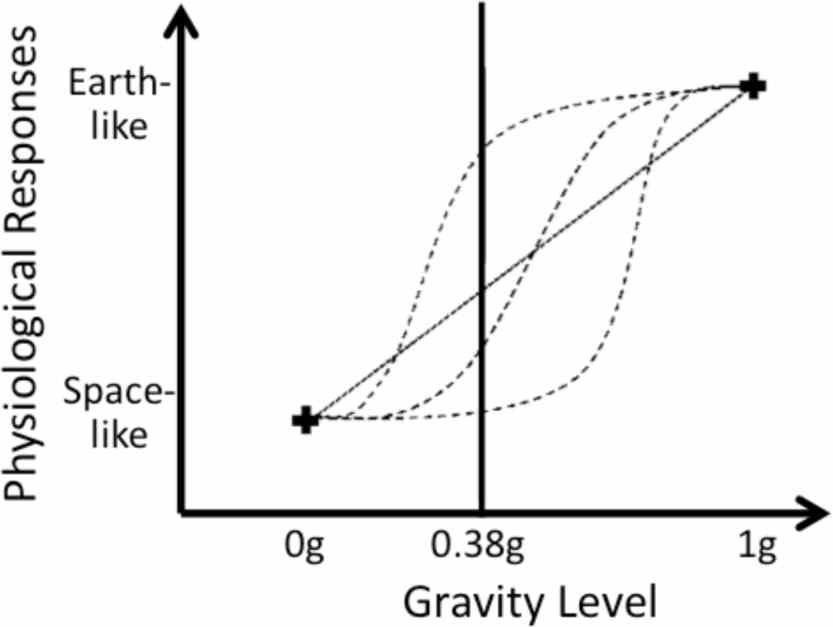
Examples of possible curves to join the two known dots of full g and zero g. Discussion on page 59 of this report
I'd go a bit further than this though and ask the question: do we even know for sure that the graph is monotonic (steadily increasing)? Perhaps that's quite likely, but for one example, might not the optimal gravity level for human health be less than full g, for instance? We know that hypergravity and zero g are bad for our health, when compared with full g. But we don't yet know for sure that all levels of partial gravity (hypogravity) are bad for our health.
Also, what if lunar gravity (say) is really good for some health conditions or particular individuals? For instance, does reduced gravity help with heart conditions because there is less blood to pump around because of the reduced plasma, and less work for the heart to do? Or does it make things worse, because of the reduced plasma and faster heart rate? Does it benefit particular age groups (e.g. elderly or young) or is it particularly bad for them? Is there a difference in effect for men and women, also what about women in pregnancy? Are there genetic differences in responses to partial gravity?
So, from a mathematical pont of view, potentially there could be a lot more variation than that. Here is a graph I did to illustrate this idea
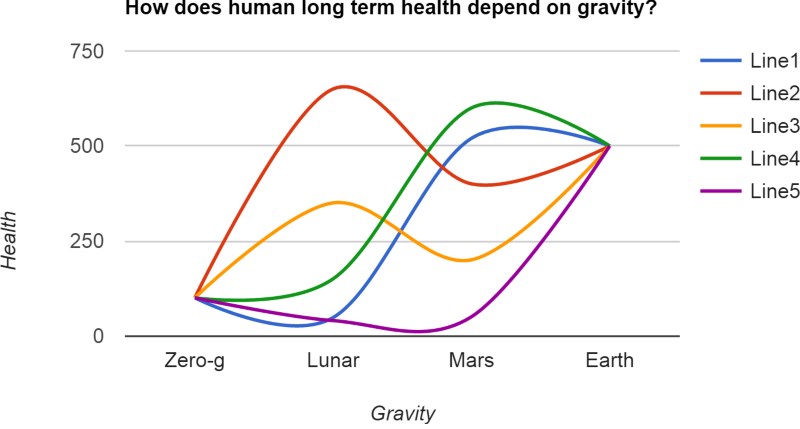
The numbers here are arbitrary. I just used 100 for zero g health, 500 for Earth gravity, and various numbers in between to make a nice graph, with the online Line graph maker. (If you want to duplicate it, I used 100 48 520 500, 100 650 400 500, 100 350 200 500, 100 150 600 500, and 100 40 50 500).
Also the graph may depend on your age, sex, health conditions, genetics, etc. Indeed each person might have a slightly different graph here and different optimal partial gravity levels for health.
Lines 1 and 5 show the possibility that some levels of partial gravity could be even worse for health than zero g, and lines 1, 2 and 4 show the possibility that some levels of partial gravity could be better for health than full g. Lines 2, 3 and 5 shows the possibility that lunar gravity could be better than Mars g for health, perhaps for some people or health conditions.
Can we rule out any of these possibilities yet?
We don't know yet:
If you just want to sleep, eat, exercise, not use it for doing things that need fine control, then the coriolis effects don't matter either. People can adapt to coriolis effects also to the extent that when they stop spinning they feel that there is force acting in the opposite direction.
Also, we just don't know the gravity prescription for health. Maybe if you spin just a few minutes a day while eating or during exercise, it makes all the difference. Maybe lunar g is okay. We don't know until we find out more.
Also humans are not a single system, but a complex interaction of many things. It might be that your circulation (heart rate, blood pressure etc) works best at one gravity level, the cells of your body are healthiest at another, your muscles keep their best muscle tone at another, your immune system works best at another, and it is easiest to lose excess heat while exercising at another gravity level.
It may be that it is best to sleep at one level of gravity, to eat meals at another, to exercise at another, and to work at another, and to read a book at another, and another is optimal for using a toilet, another is best for ice skating, another is ideal if you want to be able to run as fast as you can unaided. It might be that in future space Olympics, all the sports use different gravity levels :). Maybe a space sprinter wouldn't think of running in anything except Mars gravity, but for hurdling, you wouldn't dream of any other level except lunar g. Again just making up numbers there for fun :). While human flight, I think that is supposed to be possible in lunar g, and surely would be harder in Mars gravity, so might be a new lunar sport. But who knows, maybe it is optimal in 1/100 g, or maybe that is only used for newbies and kids trying to fly for the first time.
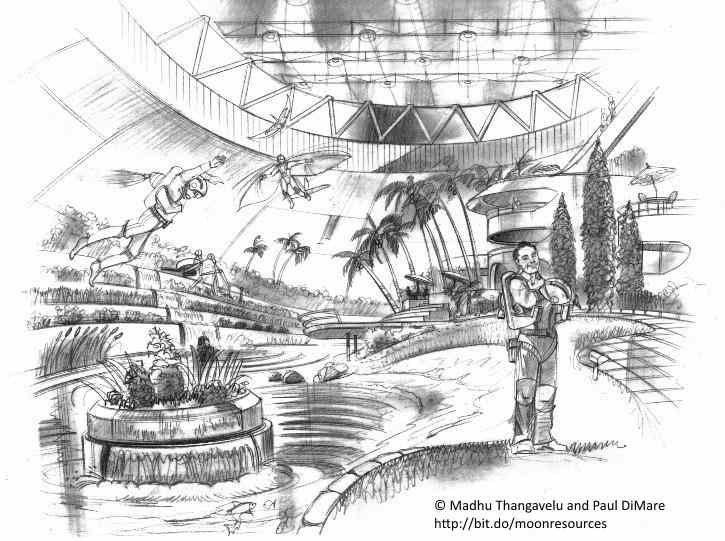
Flying - one thing that the Moon surely is better for than Mars. Illustration by Madhu Thangavelu and Paul DiMare © from The Moon: Resources, Future Development and Settlement
So, you can't say if lunar or Mars gravity is better. The answer is just, that we don't know yet. And it might also be a case of "best for which people and which activities?".
What though, if we do need full Earth gravity for health, or higher than lunar gravity or Mars gravity? Can we augment it with artificial gravity? You'd think it would be possible as we can generate hypergravity on Earth, and people have even lived for months at a time in rotating rooms here during research into effects of spin motions on humans. So one way and another it should be possible on the Moon too, but how easy would it be to do? And could you build really large structures like this?
One day perhaps we will have centrifuges to generate artificial gravity on the Moon. We might build small rotating rooms or short arm centrifuges, or we may build large structures for lunar gravity. For instance, in the low lunar gravity, the lunar caves may be up to several kilometers across, similar in width to an O'Neil cylinder. If these caves exist, you have large spaces to use to build rotating structures to augment lunar g.
But how could these work? What kind of a structure could hold up a rotating habitat kilometers in diameter on the Moon? One big difference from spinning space habitats is that we will have lunar gravity acting along the rotation axis. In particular, how could you keep it balanced and avoid huge torques on the central pivot when people move around in the habitat? If you can use short arm centrifuges, then the problems are less acute, but it still seems a tricky engineering challenge.
There's a solution though. For the larger diameter centrifuges, then simplest idea is to just build a train going round and round a circular track. Then there's no limit, you can have circular tracks kilometers in diameter if you so wish, either in the lunar caves or on the surface. Also you don't have to think of narrow carriages as on trains on Earth. As we saw in the section on Lunar railways, lunar gauges could be wide gauge, perhaps twice as wide as most track gauges, perhaps three meters between the tracks, or more. Your "carriages" could also be multistory, with no height restrictions, so in principle they could be as big as a 747 or larger.
If you use circular railways, you don't have any engineering problems of torque on a central axle or pivot. Whatever the diameter of the track, the force outwards is only your that exerted by the train itself and its passengers under 1 g. This is no more of a problem for wheels to support than a conventional train on Earth. This idea is often discussed online, but not so much in the academic literature. But there is a 1996 paper: (Schultheis, 2000, Artificial Gravity Augmentation on the Moon and Mars)
"One method of augmenting gravity is a extraterrestrial railroad. A vehicle on a circular track banked with respect to the horizon creates centripetal accelerations related to the speed of the vehicle and the diameter of the track. Incremental accentuation of gravity may be accomplished by switching the vehicle to a track of larger diameter and steeper bank. Rotation creates accelerations on the vestibular canals of the inner ear that will limit the angular velocity of the vehicle. Colonists would have the opportunity to work part of each day in simulated Earth gravity and easily access the planet's surface. The magnitude of gravity that will protect us is unknown, as is the frequency and duration of exposure. This must be investigated. An extraterrestrial railroad, as one solution to this problem, does not involve exotic technology and is readily expanded."
So the suggestion is that you have banked tracks for the train to run on. As you transition from lunar gravity to full gravity the train would move to steeper and steeper banked tracks so that the floor always feels level to the passengers. The transition would go in the opposite direction when the passengers want to leave the train, the train would move to the less steeply banked tracks first.
Another idea suggested in the forums is a tilting train:

A JR Hokkaido KiHa 283 series tilting DMU on a Super Hokuto limited express service on the Hakodate Main Line, photo by Japanese wikipedia user: 出々 吾壱
For full g it would need to be tilted by 80 degrees instead of the 8 degrees shown in in this photo. For large amounts of tilt, perhaps this would work best if the carriage is in an inside compartment only indirectly coupled to the outside while the train is moving. This idea could also be used with a smaller amount of tilt to keep the floor of a train level while transitioning between tracks with different degrees of bank, and then finally to a stop.
To deal with issues of friction between the trains and the tracks we can
Also bear in mind that in a future where we can build large circular tracks like this, it's also gong to be easy to lay out large areas of solar panels on the surface and we can also design power storage during the lunar night, and by then we may have small nuclear power stations too. So, though it's not going to be as efficient as a spinning habitat in space which spins pretty much endlessly once you set it spinning, it's probably not going to be a huge power drain on a working habitat. See Power during the night.
However perhaps we don't need such large scale systems for artificial gravity on the Moon. First, for all we know to date, lunar gravity might already be healthy for humans. In that case we don't need it at all.
Or we might need gravity only intermittently during the day for health. Here is a study that found that full gravity in a centrifuge for just one hour a day made a big difference to muscle loss in bed rest volunteers lying with head slightly lower than their feet to simulate zero g. Other studies come to similar conclusions. Other experiments use "dry immersion" to simulate zero g, where a volunteer is immersed in warm water with an elastic suit to keep them dry, which has similar physiological effects to head down bed rest, but the changes take effect more quickly.
Dry immersion used to simulate zero gravity in some experiments, figure from Artificial Gravity by Clements et al. Drawing by Philipe Tauzin (SCOM, Toulouse)
The volunteer is submerged in warm water, protected by an elastic sheet to keep their skin dry, to protect them from skin softening due to immersion in water (skin maceration).
A 2016 survey of the literature to date, "Centrifugation as a countermeasure during bed rest and dry immersion: What has been learned?" concludes
"Centrifugation for as little as 30 min per day was found to be effective in mitigating orthostatic intolerance and strength in postural muscle after 5 days of bed rest, but it was not effective in mitigating plasma volume loss."
In other words it helps with muscle wasting and difficulty in standing up in full g after prolonged exposure to the simulated zero g (orthostatic intolerance) but 30 minutes exposure per day is not enough to help with the reduced amount of blood supply to the body which is another effect of zero g on astronauts. They suggest more experiments are needed to find out effects of longer periods of artificial gravity per day. All the studies they survey involved male subjects, and women respond differently, they appear to be able to regulate blood pressure in ways that men cannot. They also suggest that the spin rate be adjusted to achieve full g at the heart rather than the feet, and that it could be useful to let the subjects choose what level of artificial gravity they want to use. Many other suggestions in the detailed survey.
We have actually tested artificial gravity in space, the Neurolab experiment, flown in 1998 able to produce artificial gravity of between 0.5 and 1 g in an off axis rotator. Although the astronauts were only tested for a few minutes a day, the four astronauts tested didn't have the same problems with standing upright on return to Earth that most (64%) astronauts have. It's a small sample but the probability that this happened just by chance is 1 in 60. See page 24 of this report.
Also, from some early experiments in zero g, and anecdotally (Tim Peake's demo of tumbling at 60 rpm for a couple of minutes in the ISS), astronauts in zero g can tolerate spins that would make them nauseous on Earth.
The same may apply in reduced gravity too. From some parabolic flight experiments by Lackner and DiZio in 2000, summarized on page 21 of this report
“the severity of side effects from Coriolis forces during head movements is gravitational force-dependent, raising the possibility that an artificial gravity level less than 1 g would reduce the motion sickness associated with a given rotation rate”
Also it's possible by acclimatization to gradually adapt to higher rotation rates without ever experiencing motion sickness.
So one way or another, we might be able to tolerate higher spin rates on the Moon. We would need to do experiments to find out if this is the case. But if we can use higher spin rates there, the centrifuges can be smaller for the same amount of artificial gravity, and still be tolerable. See my section below on: Small centrifuge based artificial gravity experiments in LEO
A small centrifuge could be based on the same principle of an external track around the centrifuge rather than a central pivot. It's just like a model railway going round and round :). Same idea as the larger one but on a smaller scale.
It could consist of a drum inside a container and motors that drive the drum around and just wheels (or maglev) between the drum and the outermost walls of your habitat. This would seem an especially good approach if the outermost walls are very strong, for instance, if it is in a cave or you can pile a ramp of regolith around the outside of your habitat.
The same approach could also be used for a rotating room such as a dining area, say. Or a gym or sleeping compartments
I'd like to suggest another idea which I haven't seen yet in papers or discussions online - a central pivot with living quarters suspended from it like a swing carousel, or indeed maybe a smaller scale swing carousel inside a habitat for sleeping or for eating or exercise. On the Moon, if spun fast enough for full Earth gravity, they would be angled about ten degrees from horizontal.
Another related idea is to build a velodrome style track on the Moon for cyclists to use to keep healthy.
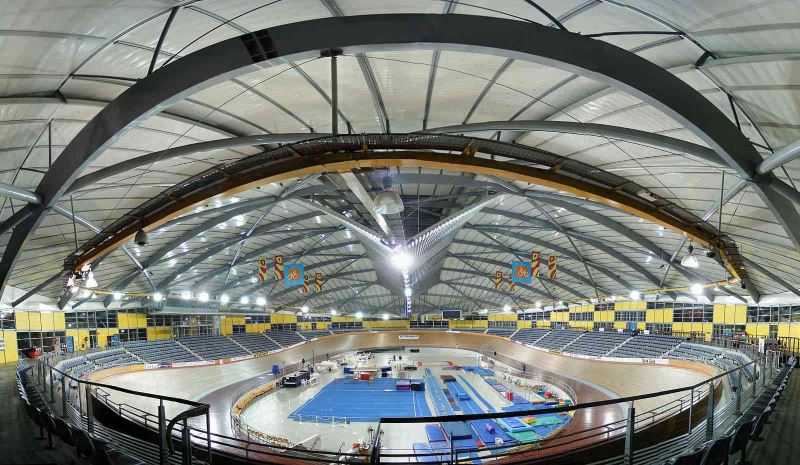
Dunc Gray Velodrome in the City of Bankstown, Australia, cycling venue for 2000 Olympic games. Photo by Adam. J.W.C. It bends at a maximum angle of 42°. A more steeply banked velodrome on the Moon, banking to a maximum angle of 80° would let cyclists generate between half and full g by cycling round and round. For normal cycling speeds of 10 to 15 meters per second, or 22 to 33.5 miles per hour, the lunar velodrome could be 50 meters in diameter, see Human Powered Centrifuges on the Moon or Mars.
That's rather fast though. Fit astronauts could do it for short periods of time. Here are some example speeds from a sporting cyclist. He gives an example of reliability rides involved riding 50 miles in 3 hours or 16.6 miles per hour.
The AG we want to generate by rotation to combine with lunar gravity to create a sensation of full gravity for our astronauts is sqrt(9.8072-1.6222) or 9.6719 m/s/s.
It would be rather like the "wall of death" motorcycle stunts (typical radius 3 to 5.5 meters) :
- but at the much lower lunar gravity, you only travel at jogging speed, and you haven't got far to fall and the gravity is much lower also. So I see no reason why you can't have a "jogging track" inside the habitat similar to the jogging track inside Skylab.
Jogging starts at 3.30 and they jog at around 10 rpm, so probably experienced around 1/3 g at their feet, taking the radius as 3 meters. Jogging at around three meters per second, or about six miles per hour. The longest jog is for one minute 50 seconds (including various gymnastic tumbles in the middle).
The speed you'd need to cycle to reach full g for artificial gravity depends on the radius. So for a radius of 5.5 meters, like the larger "wall of death", that's a speed of 7.3 meters per second or 16.3 miles per hour, so that's the reliability rides type speed. For a radius of 3 meters, it's a speed of 5.39 meters per second, or 12 miles per hour.
But this is only going to provide artificial gravity while exercising, and indeed, only while cycling. That leads to another idea, what about a moving walkway? Similar to the idea of a train, but you can do it inside a habitat. The Trottoir Roulant Rapide in the Montparnasse—Bienvenüe Métro station in Paris. however moved at 9 km / hr or 5.6 miles per hour, 2.5 meters per second.
They ran into problems during the acceleration phase with the elderly and frail tending to fall over plus the need to hold onto the rail, leading to injuries, but that's perhaps not an issue for early days on the Moon with fit astronauts. Also you'd have the much lower lunar gravity so the risk of injury would be less. Still you'd also need it to move faster than this, a little more than double this 2.5 meters per second for this to generate full gravity even for a small 3 meters diameter track. A walkway like this on a 3 meters radius track would generate about 2.67 m/s2 or about 27% of Earth gravity at your feet, less at your head of course.
Variation in amount of Artificial Gravity across the width of the track
Another issue here is that unlike artificial gravity in space, the amount of AG will vary across the width of the track. The amount of this effect depends on the radius of a centrifuge. Suppose for instance it's a 4 meter radius centrifuge (larger than the Skylab jogging track, head two meters from the axis when standing up), and the track is 2 meters wide (or you move 2 meters sideways on a wider track).
And - let's use an exact figure for the angle, may as well, asin(1.622/9.807) in degrees = 9.52 degrees for the angle from the vertical of our centrifuge wall. So now we have 2×1.622/9.807 = 0.33 meters difference in radius between top and bottom of our centrifuge. And the AG we want to generate by rotation to combine with lunar gravity to create a sensation of full gravity for our astronauts is sqrt(9.8072-1.6222) or 9.6719
So then with a 4 meters radius centrifuge, 14.85 rpm, then it is 10.47 m/sec2 AG at the widest radius at the top of the slope from the lunar perspective - (and of course, 9.807 m / sec2 at the bottom) so you would get heavier by 6.7% by walking two meters sideways. I'd have thought even that would be reasonably tolerable.
Depends what you are doing, fine control or just eating a meal or sleeping, or using the toilet - or exercise. But we are pretty good at learning to adjust to things, and I wouldn't be surprised if we could learn to adjust to a variation in weight of 6.7% even for tasks that involve fine control. The only way to find out for sure would be to test it, and we couldn't simulate it on Earth.We couldn't really simulate it that easily in space either, so perhaps after preliminary experiments in LEO to find out if we even need more than lunar gravity, and if so, what the gravity prescription is for health and if it is needed 24/7 or just for a short while each day, we would just have to test it on the Moon. If it is a big problem we need larger centrifuges but I'd have thought it has a decent chance of being okay.
It would need careful study I think. So the options seem to be, so far:
I found very little on this topic in my literature search. Most is in forum posts apart from the two papers I mentioned. Here are some of the discussions and posts I consulted, though of course they are not peer reviewed, used as a source of ideas:
And the papers I mentioned already:
If you know of anything else on this particular topic of artificial gravity on the Moon, do say!
I'm using spincalc here for AG calculations
The levels of artificial gravity needed for phototropism is between 0.1 and 0.3 g. So some higher plants would grow normally on the Moon without need for centrifuges, while others might need up to Mars levels of gravity. Here Mars may have an advantage for growing plants.
I think it's possible that the Moon may also have advantages though, because you'd have much less by way of gravity along the spin axis. As a result our otoliths which sense linear acceleration along the spin axis on Earth would be less stimulated so potentially, there could be less conflict between the otoliths and our vestibular system. We would have to do research to find out why it is that astronauts are able to tolerate spin motions in zero g, which they can't tolerate in full g. Once we understand this better then it would be a major question to see if this also applies to some extent to lunar gravity. If it does we could use much smaller centrifuges for artificial gravity on the Moon for longer periods of time.
See the section below: Small centrifuge based artificial gravity experiments in LEO
The vacuum of the Moon is also actually an asset, so much so that we might need to take special precautions to preserve it.
"It seems absurd to expect that the lunar vacuum could be lost by small-scale operations on the moon. However, high-vacuum and ultra-high vacuum is needed for many industrial processes, some of which may be accomplished on the moon. Some processes which require vacuum and thus would be simpler to manufacture or use on the moon include vacuum tubes, semiconductor manufacture, solar cell manufacture, and particle accelerators."
Degradation of the Lunar Vacuum by a Moon Base - Geoffrey A. Landis
The carbon dioxide atmosphere of Mars is so thin it counts as a laboratory vacuum, you would need a pressurized spacesuit or you'd die quickly because the water lining your lungs would boil. But it's not thin enough to be a useful vacuum. And as we've seen, carbon dioxide is not needed as an input for greenhouses - in a closed system it just circulates around to food and back again. The Moon would seem to have the advantage here, too.
One of the things I've discovered as a result of writing this book, is that the Moon is not only much closer, and a safer place to send humans - it's probably also in many ways more suitable for human habitats than Mars! That will probably surprise you if you come to it after reading Robert Zubrin's "Case for Mars". Probably you will say something like this:
"It's got no 24 hour day, no CO2 atmosphere - it seems dull as concrete - and some of the ideas for colonizing Mars will work on the Moon, but others will not. You can't make methane from a hydrogen feedstock on the Moon without a CO2 atmosphere for instance. So how can the Moon possibly be an easier place for humans to live than Mars, when only some of Robert Zubrin's ideas will work there?"
But if you look at it on its own merits, then things suddenly turn around, like those images of a young girl and an old lady
One of the early versions of the Young Girl Old Lady Illusion.
The 24 hour day of Mars actually turns into a disadvantage of Mars because of the huge day to night temperature changes. Similarly we've seen that on the Moon you won't miss the low grade laboratory vacuum levels of carbon dioxide, which is not needed in a closed system greenhouse. And instead the hard vacuum becomes a major advantage of the Moon over Mars. Instead of methane fuel, you use the abundant solar power to split the water ice into hydrogen and oxygen, a much better rocket fuel, and you can also use the hydrogen to make fuel cells. We've seen several examples like this.
I think the general point here is that if you try to analyse the Moon as if it was Mars, then it seems like it has little by way of resources. But when you analyse it on its own terms, it is rich in resources. It also has several unique resources not available on Mars. You need to look at the Moon with "moon spectacles" to see its advantages.
How do you deal with the trash on the Moon? This is not an exciting or glamorous subject I know, but it is part of the reality of space travel. This is something that's easy to forget about, how much trash astronauts generate every year. We don't notice it so much on the ISS because it is easy for the astronauts to dump it, and it all burns up cleanly in the atmosphere. The Apollo crew didn't spend enough time on the Moon for it to be that noticeable.
Well, the Moon is also a good place to study the effects of humans and their wastes and trash on their surroundings in space. In such challenging conditions we are bound to have wastes of all sorts pile up around the base. Think how much refuse the Progress rockets return to Earth, to burn up in the atmosphere:
See all that trash which you can see filling up the Progress in those white bags in this video. The ISS discards that much trash into our atmosphere every few months. Imagine all of that piling up around a base on tiny Phobos or Deimos? The Moon would be a great place to see what happens to all that trash, and find out if there are ways we can deal with it. How much can we recycle? Or do we just bury it all? Some of it is "smelly stuff". For instance on the ISS the astronauts don't have facilities to wash their clothes. As soon as their socks, smalls, shirts etc begin to get a bit smelly or dirty they just put them into a bag and eventually it ends up burning up in the Earth's atmosphere at a very high temperature, along with the Progress vehicle itself.
On the Moon, all those bags will pile up around their base unless they find another way to deal with the trash. They would recycle what they can of course, but that might not be easy in such challenging conditions. How do you recycle a spacesuit that doesn't work any more for instance? They will have quite an incentive to find a way to do some recycling. For instance, to wash their clothes, but that's not the easiest of things to do in a spaceship. Incinerate most of it in an oven??
A base on the Moon surely isn't going to send all its trash back to Earth. It's not like the Progress attached to the ISS. You need 1.6 km / sec delta v to launch it as a payload from the Moon into orbit, and if you were to send it back to Earth to burn up in our atmosphere, you'd need another kilometer per second for a Trans Earth Injection. You would use up a lot of good fuel to burn your trash in Earth's atmosphere. They surely won't do that. So your base would have piles of trash build up around the base.
Then the thing is that, like the Apollo 11 footprints, any trash you leave on the surface of the Moon will still be there thousands, and probably millions of years into the future. It won't degrade , rust away, and mix into the landscape.
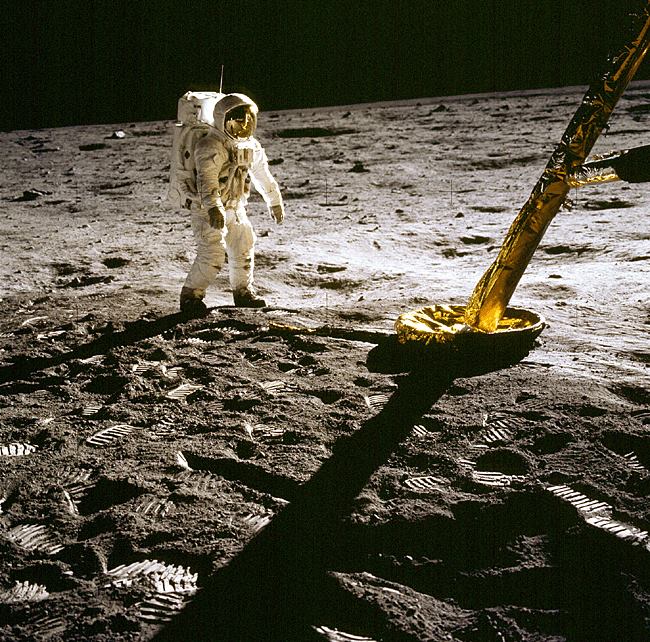
Buzz Aldrin standing near a leg of the lunar module - notice how many footprints they left on the Moon? These will still be there a million years from now.
It will be the same for the area around any lunar base. It will soon be totally covered in footprints - unless they either turn the dust around the base to glass or they rake the soil. In the same way, all the trash they leave on the surface of the Moon will also still be there a million years from now too.
It would be the same for a base on tiny Phobos or Deimos. Also any other small region such as the most favoured "peaks of almost eternal sunlight" at the lunar poles. It's the same for any geographically small region of the Moon, for instance the region around a lunar lava tube cave entrance (unless they put all the trash into the cave?). It will soon be covered in footprints and trash after humans have been there for a few months / years. The Moon would be a great place to get a first idea of what the scale of impact of this will be, as we explore the solar system, and to make our first experiments in dealing with this issue and learning what we can do about it.
I can't find much on the problem of trash on the Moon. It's often mentioned in passing but not discussed in detail. But here is an abstract from 1988 which gives a succinct summary of the main issues. After describing the main sources of trash including the descent platforms (which remain on the surface when the modules return to orbit, and they estimated as 4.9 tons each), paper, cloth, wood, plastics, ceramics and glass, aluminium and steel, they then go on to describe possible disposal methods
The primary disposal process on the lunar surface of the by-products of shredding, wet oxidation or solar furnaces, will be burial. The initial temptation of filling nearby craters will be unavoidable for the initial settlement, but cannot continue for any extended time. As lunar mining becomes a reality, ample landfill opportunities should arise. An alternative to crater filling or direct burial would make use of areas of perpetual shade if available near the colony. These areas, if large enough, exhibit absolute darkness and temperatures near 150 K that would make for excellent limited disposal sites.
Most of that surely still applies ,though I'm not sure if piling trash into areas of perpetual shade would be favoured so much nowadays given the interest in any ice or volatiles that might have accumulated there. Perhaps in caves though? Would some of the lava tube caves, or sections of them, be earmarked for trash disposal?
Also trash on the Moon will have many materials in it that would be almost impossible to make locally and that would cost a lot to send up from Earth. Recycling would be hard to start with but get easier as they develop more technology and industry on the Moon. Perhaps in the not so distant future our descendants or even our older selves may return to those trash pits from the early twenty first century and mine them for valuable resources. If so it might be worthwhile segregating the trash before burying it to make things a bit easier for the future astronauts on the Moon who wish to re-use it.
Also, though it may seem the best thing to do is to compact it to take up as little space as possible, crushing, and burning it, is that really the best solution? Maybe in the not so distant future, some of the materials may be useful if not incinerated or compacted? For instance tanks, or a spacesuit, perhaps equipment that has some small thing wrong with it that the astronauts couldn't fix on the spot with the materials they had - either in the future the astronauts may find a way to recondition them, or to re-use the materials or components for some less demanding task.
These are just a few thoughts on the subject. If anyone reading this knows of good material on trash on the Moon do say!
The Moon is also an ideal place for planetary protection scientists to study survival of microbial spores in space conditions. There are many spacecraft on the Moon that have been there for decades, crashed or landed there, and we can study them to see if there is any viable life on them. This could give us good ground truth on planetary protection. See also Organic Measurements on the Lunar Surface: Planned and Unplanned Experiments (powerpoint presentation).
The scientists actually used Apollo 11 for planetary protection studies. First, they estimated that the lunar surface where the Apollo 11 astronauts collected their samples had only 10,000 to 100,000 viable microbial spores from Earth per square meter (between one and ten spores per square centimeter). They did do a few analyses of selected samples up to Apollo 14 for colony forming spores, inoculating them into with different media, and no colonies formed. Here is a detailed description of the process of examining a sample from Apollo 11, no colony forming life was found after inoculating 3,000 petri dishes each with 4 mg of the sample (total of 12 grams). In another paper, one of the four samples they tested was actively biocidal (perhaps heavy metal toxicity) but other soil samples were able to support colony forming spores, but didn't. However, those are only a few analyses of selected samples and with early 1970s technology.
The returned Apollo samples actually highlight the need to take care about contamination of the Moon if we are interested to find out about native organics. A NASA study in 2015 re-analysed some Apollo samples, using modern methods searching for amino acids.The analysis was a tricky one because there were several ways the amino acids could form (native to the Moon, produced by reactions with rocket fuel contamination in the lab, or from Earth organics).
In the end they decided that most of the organics came from Earth microbes (because of preference of the "left hand" form and the carbon 12 / 13 isotope ratios) but some probably came from meteorites. The samples are now known to have up to 70 parts per billion of organics from life. However much of that could be contamination of the samples after return to Earth (see this paper). Sadly this is a bit inconclusive, but it does suggest that, even with the Moon we may need to take care to avoid contamination of the samples by Earth organics, either in situ on the Moon, or after return of the samples to Earth, when exploring areas where the amounts of organics on the surface are of scientific interest.
The microbes, rocket fuel, and trash brought left on the Moon by the Apollo astronauts after their up to three days stay is nothing to the trash that would accumulate around a human base. So, another thing we can do on the Moon is to find out how much organic contamination and other types of contamination accompanies human explorations, and how far it spreads.
You might think that organics on the Moon would only spread as far as the humans themselves travel, away from the base? Most of it just localized around the base?
So, yes, of course the Moon doesn't have any weather as we know it, and it doesn't have global dust storms like Mars either. So, the organics won't spread as easily and as far as they do on Mars. However, it does have electrostatically levitated dust, which surprisingly can levitate even particles as large as 140 microns in diameter (line 215 of this paper). The dust is levitated through UV radiation and plasmas.
A microbe in a 140 nm particle would be protected from UV (though of course affected by the electrostatic discharges that levitate the particles in the first place). So, if you introduce foreign material to the Moon, it could spread some distance in this levitated dust. Perhaps even viable microbes. The rocket exhausts for Apollo 12 for disrupted about two tons of dust around the landing site that lead to localized dust storms observed during the next few sunrises as measured from the Apollo 12 landing site levitated to a height of one meter above the ground.
So how far can the dust spread? The finest dust might have gone right up to orbital altitudes. At least, the Apollo astronauts sketched what seem to be rays of sunlight hitting the dust at sunrise and sunset from orbit. However recent observations by LADEE show that there is no dust at altitudes between three kilometres and 250 kilometres. At least not any more, if there was back then.
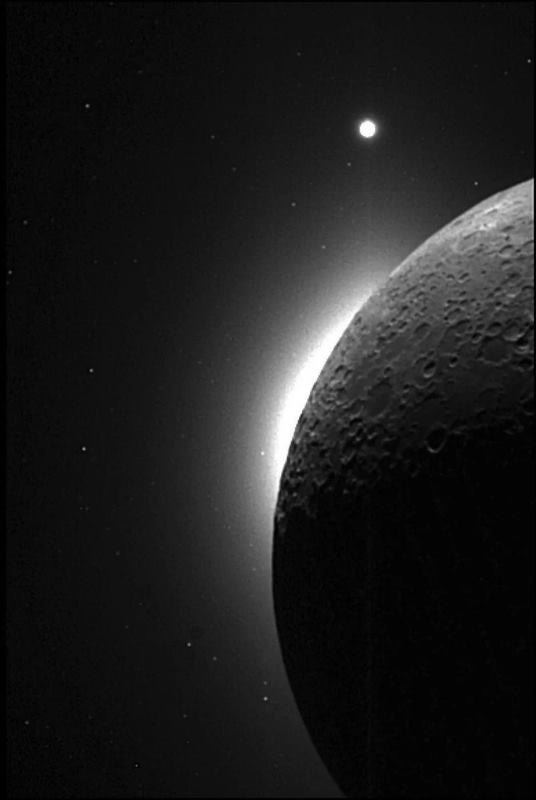
Lunar horizon glow as photographed from orbit by Clementine spacecraft. The bright dot at the top is Venus and the Sun is behind the Moon. The Moon has an exosphere - an atmosphere so thin that the molecules rarely encounter each other. However LADDEE proved that there is no dust above 3 kilometers.
With the Moon's surface area larger than Africa, a few spores spreading out through dust levitation aren't going to do much to confuse science results kilometers away, unless there are habitats for life there. Every indication is that there are no habitats that Earth life could colonize on the Moon. There are ideas to turn the dust into glass for a landing pad, so perhaps that would help with the dust too. So, it may not be a major issue, but this is certainly something to study and monitor. It could be an issue for regions that we want to keep free of organics and other contaminants close to a human base.
Some areas of the Moon could be particularly sensitive to organics from Earth. In a review paper from 2007, the authors suggest that perhaps this categorization may need to be revisited depending on what we find out about the lunar ice. If this ice and the other volatiles there are of especial interest for study of prebiotic chemistry for instance, perhaps we might need to set up "organic special regions" on the Moon that need to be kept free of organics.
"Other locations, like the permanently shadowed craters at the Moon’s south pole, may contain water ice or hydrated minerals and other valuable scientific and physical resources. If, for instance, these sites contain ice with signs of prebiotic chemistry, one can envision the establishment of organic special regions to protect these native lunar organics for careful scientific study."
Although the human bases at the poles would be right next to permanently shadowed craters, perhaps the organics wouldn't spread far in the cold desiccated conditions there. After all, there is no UV light to help levitate the dust there, and there would be some shielding from solar storms. Also, there are hundreds of square kilometers of permanently shadowed ice at the poles, an estimated 1,850 square km of ice at each pole . However if the organics do spread beyond the base - well the Moon is an ideal place to study such things. It has minimal planetary protection issues compared to anywhere else. If it does still have some contamination of the polar ice by organics from the human base, well this is a chance to study the situation.
The historical lunar landing sites are another area that may need protection from contamination by Earth microbes. They are valuable for planetary protection scientists,as places to study the effects of a brief human presence on the Moon several decades later. They are a:
"valuable and limited resource for conducting studies on the effects of humankind’s initial contact with the Moon" (quote from page 774 of this paper).
These sites, with microbes exposed to cosmic radiation, UV etc are also decades long unplanned experiments in the interplanetary cruise stage of panspermia - the ability of microbes to remain viable in the conditions of interplanetary space for transfer from one body to another. (see page 771)
Another planetary protection question for the Moon (in its broadest sense) is whether our landers would change the Moon's very tenuous "atmosphere" or exosphere with rocket exhausts. Each Apollo lunar landing added 10 tons of exhausts to the atmosphere with a persistence half life of approximately one month. That might not seem a lot but it is a noticeable amount for the lunar atmosphere which has a total mass of approximately 25 tons.
We have a golden opportunity right now to observe its atmosphere "as is". The rocket exhausts from Apollo should have dissipated long ago. Amongst other things we can study the movement of water vapour in the lunar atmosphere and see where it comes from. Well it will be a while probably before we get humans landing on the Moon again, but we do have man robots due to land there in the near future, including (if they keep to schedule) the remaining Google Lunar X Prize contenders in 2017, and Astrobiotic, in 2018 (they dropped out of the Lunar X-Prize saying the 2017 timetable was unachievable). So what effect will they have on the lunar atmosphere? Well when the Chinese Chang'e 3 landed on the Moon on 14th December 2013, we had an excellent chance to find out as NASA's LADEE is still in orbit analysing the lunar atmosphere.
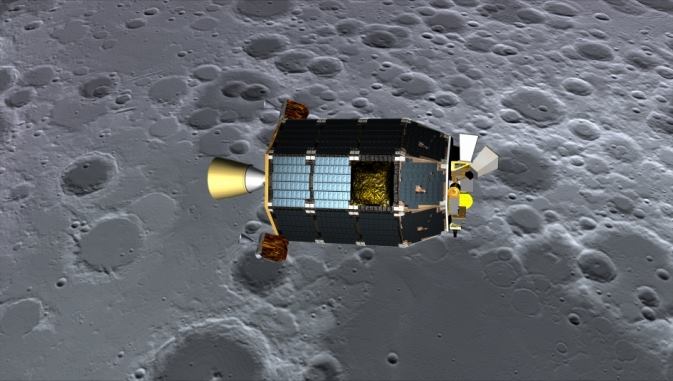
Artist's concept of NASA's Lunar Atmosphere and Dust Environment Explorer (LADEE) Image Credit: NASA Ames / Dana Berry
They came to the surprising conclusion that the Chinese lander hadn't modified the lunar atmosphere at all, or at any rate, if there were any changes, they were beyond their detection limits They studied it from a distance of 1,300 km so they couldn't observe the dust it kicked up (which only lasted for about 15 seconds in the Chinese descent video). No exhaust products were detected and the lunar atmosphere wasn't changed in any way.
This is good news for robotic missions to the Moon at least. This was a particularly large lunar lander for a robotic mission, so it seems that any effects from rocket exhausts are only local and don't have any global effects on the atmosphere, and the exhaust products don't travel large distances either.
Here is what they said in detail:
"Surprisingly, the LADEE science teams' preliminary evaluation of the data has not revealed any effects that can be attributed to Chang'e 3. No increase in dust was observed by LDEX, no change was seen by UVS, no propulsion products were measured by NMS. Evidently, the normal native lunar atmospheric species seen by UVS and NMS were unaffected as well. It is actually an important and useful result for LADEE not to have detected the descent and landing. It indicates that exhaust products from a large robotic lander do not overwhelm the native lunar exosphere. As the descent video shows, the interval of time that dust was launched by the lander is very short, perhaps less than 15 seconds. LADEE would probably have had to be in just the right place at the right time to intercept it. Also, significant amounts exhaust products apparently cannot migrate to large distances (hundreds and thousands of miles) and linger with sufficient density to be measured. "
What, though, about more local effects on the lunar surface, especially the lunar ice? We don't have any ground data on that yet, but we have some theoretical modeling. This shows the modeled effect of the Apollo 17 landing exhausts on the lunar surface near their landing site:
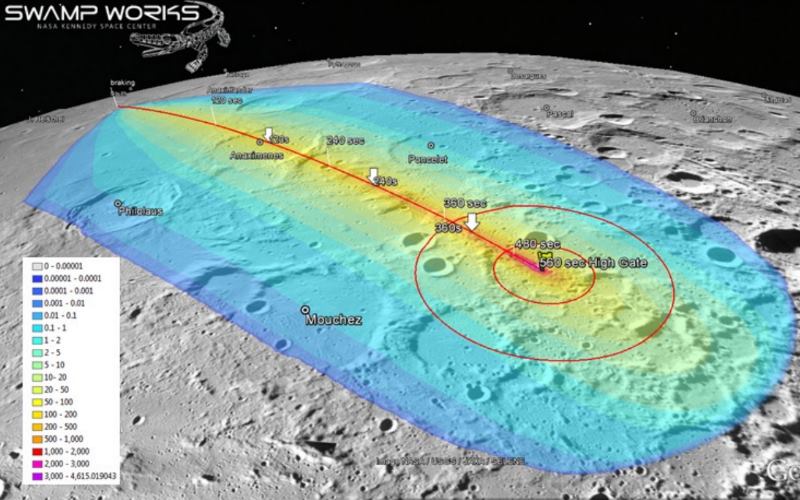
Figure 28 from this paper showing their modeled rocket exhaust contamination of the lunar surface from Apollo 17 superimposed over Google Moon. The contaminated area spans 522 kilometers of the lunar surface. The red range rings contain 50% and 67% of the total contamination respectively.
There would surely be scientific interest in the organics on the surface of the ice at the lunar poles. This modeling suggests we may need to take care about the effects of rocket exhausts from spacecraft landing in the vicinity of the lunar village, especially once the larger rockets start landing with astronauts on board. So what can we do about this?
The authors of the paper looked at future missions "where contamination by exhaust gases is not desired" and recommended that:
Perhaps I can make another suggestion of a way to reduce the exhaust problem even more, once we have frequent travel to the Moon. Hoyt's cislunar tether transport system . uses counter rotating momentum exchange tethers. At the Moon end of the transport system, the tether can be stationary relative to the Moon's surface whenever it is closest to the Moon, so that you can pick up payloads from the surface and deliver them to the surface with no need to use any rocket fuel to do this.
His lunar tether masses only seventeen times the payload mass, so you don't need that much traffic per year for this to be worth doing, just for economic rather than for planetary protection reasons. Once you get that much mass in orbit around the Moon, from then on, landing on the Moon and taking off again is essentially fuel free, and what's more, you get an automatic boost from the tether to take your spaceship down to LEO. Or indeed you could use the same method to go all the way down to Earth's atmosphere on an Earth return trajectory. This would not only reduce the amount of fuel needed to land on the Moon and take off to essentially zero, and make it more economical to travel to and from the Moon. It would also protect the lunar surface and exosphere from the effects of rocket exhausts. For details see the Exporting materials from the Moon section of my Case for Moon First.
Then, there's another potential benefit for Hoyt's cislunar tether. Perhaps you could dispose of lunar trash in the Earth's atmosphere as for the ISS, after all as there is essentially no cost of fuel to do that. That is, if you wanted to. Perhaps the trash may come to be very valuable on the Moon with much to recycle in it, once they had the capability. They might value the elements and components even, things like screws, sheets of metal etc, even paper, cloth and so on, that would take a lot of work or import costs from Earth to make on the Moon. But if they so wished, with Hoyt's tether, they could dispose of trash from the Moon in the Earth's atmosphere easily. There's a lot to be thought over and worked out here.
In conclusion, the Moon is an ideal place to look into such issues. Before we send humans to Phobos or Deimos or wherever they go next, we'd better know what humans will do to a celestial body when they set up a settlement there. This is especially important if the aim is to study ice deposits in craters, or other sensitive locations. In the case of Phobos, its regolith should have records of organics and even spores of life possibly, from pretty much the entire history of Mars mixed up with it, brought there by asteroid impacts into early Mars. So, it might well be important to keep the Phobos regolith, or parts of it, clean from organics and other contaminants from Earth. Our experiences on the Moon may help to give us the experience we need to design suitable precautions for missions like this.
Also - the lunar X Prize will have many smaller missions go to the Moon, commercial ones. We may see the first of them towards the end of this year. There are five teams in the competition, SpaceIL plans to use the SpaceX Falcon 9, but it’s had trouble fitting its mission into their faring. Hakuto has made a pact to land with Team Indus and both will use the Indian rockets - it’s proven technology but they are having trouble raising the funding. Moon Express will launch on Rocket Lab’s Electron, and Synergy Moon on Interorbital System’s Neptune. All are sharing the nose cone with other payloads on their rockets.
Will Anyone Win the Google Lunar XPRIZE?
Astrobiotics, the top favourite for a long time, have pulled out saying they can’t be ready to launch until 2018. But they are planning a “FedEx service to the Moon” - their Griffin lander will carry other lunar missions to the lunar surface.
In the future we may see tiny rovers image the landing sites.
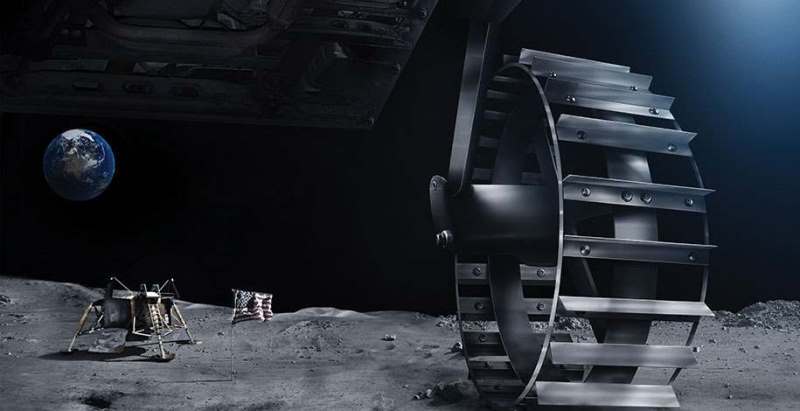
Artist’s impression of a Google Lunar X-Prize rover at an Apollo landing site. Image Credit: Google Lunar X Prize
(I actually got the image from: Team Indus joins Google Lunar X-Prize finalists, Astrobotic drops out)
That was actually one of the challenges for a bonus prize for the Lunar X prize rather controversially, some think the area immediately around the historic landing sites should be kept pristine and the rovers not permitted to drive over them.
That’s particularly because of the prospect of them landing by accident on top of the flag or some such:
““I’d like to see them demonstrate their ability to do a precision landing someplace else before they try it next to the Apollo 11 site,” Logsdon says. “You wouldn’t have to be very far off to come down on top of the flag or something dramatic like that.” “
The Lunar Legacy Project say in their Introduction
“Our goal is to preserve the archaeological information and the historic record of Apollo 11. We also hope one day to preserve Tranquility Base for our planet as a World Heritage Site. We need to prepare for the future because in 50 years many travelers may go to the moon. If the site is not protected, what will be left?”
Another group with a similar mission aim is "For All Moonkind".
However none of the finalists plan to take up this part of the challenge as far as I know. So this is not an issue for a while.
Perhaps in the future then we will get Lunar Parks set up, recognized world wide, and rovers and humans will only be able to approach within some set distance of the landing site. The historical lunar landing sites occupy only a tiny part of the moon’s surface. It’s sometimes called our The Eighth Continent, the second largest after Asia, at 37.9 million square kilometers, it’s larger than Africa, and five times the size of Australia.
So, it's only protecting a very small area, a bit like protecting Stonehenge on Earth. It seems reasonable enough to me.
Though there would need to be some way for scientists to access them if we are going to study the effects of that brief human presence on the Moon, as we discussed in the last section: Trash, rocket exhausts and microbes on the Moon - testing ground for planetary protection measures for a human base . I wonder if that is best done using remote controlled robots for minimal impact? Especially for the biological surveys?
There are no internationally agreed treaties or guidelines yet. But NASA has published a set of guidelines. From: NASA's Recommendations to Space-Faring Entities: How to Protect and Preserve the Historic and Scientific Value of U.S. Government Lunar Artifacts, the requirements include, amongst other things:
For details see the NASA Recommendations.
We have two choices for a lunar base, well on the basis of what we know so far: the poles, or lunar caves.
The lunar poles seem very attractive for our first base, after discovery of volatiles at the poles, as well as confirmation of the peaks of (almost) eternal light As we've seen, the temperature at the poles hardly varies, and it gets solar power nearly 24/7. Our base needs to be protected from solar storms and cosmic radiation, but that should be easy, with regolith piled over the habitats. See for instance Lunar Station: The Next Logical Step in Space Development (from 2015)
This is the the choice for both ESA and ROSCOSMOS, as well as many others.
I've covered some of the details here already in
The poles aren't our only option by any means. One other place to build a base is in the lunar caves. See for instance, Technologies Enabling Exploration of Skylights, Lava Tubes and Caves (from 2011). Advantages of the caves include:
Everything else is great, but the long 14 day lunar night is an issue, unless the cave happens to be right at the poles of the Moon close to the peaks of eternal light - or we dig a huge artificial cave there. However it is easier to cope with a 14 day lunar night than you might think. I cover this in the section on Power during the night
The basic idea is to send robots first to scout it out before you send humans - for science reasons and for safety reasons. First, a lander flies over the cave entrance before it lands, to image it close up. It then drops a line into the cave entrance which is used to supply power to the bots underground, and for them to communicate to the surface.
The bots themselves can be lowered down on tethers, or just be dropped in, in the low lunar gravity and drive, hop or crawl. or move like a snake, or like a spider crawling over the walls - or they can have little rocket engines and fly about inside.
For more on this, see the various cave bots on page 21 of the paper. The bots discussed include:
See also the sections of this booklet: Lunar caves and Example lunar cave skylights - Lacus Mortis, Marius pit and the King-y natural bridge
Team Hakuto plan to send a simple tethered bot, with two wheels, to explore the Lacus Mortis pit, in 2017, see Robotic missions to the Moon, already planned, or near future, from 2017 onwards, below.
In either of these cases, a base at the poles, or in lunar caves, we would explore using robots first.
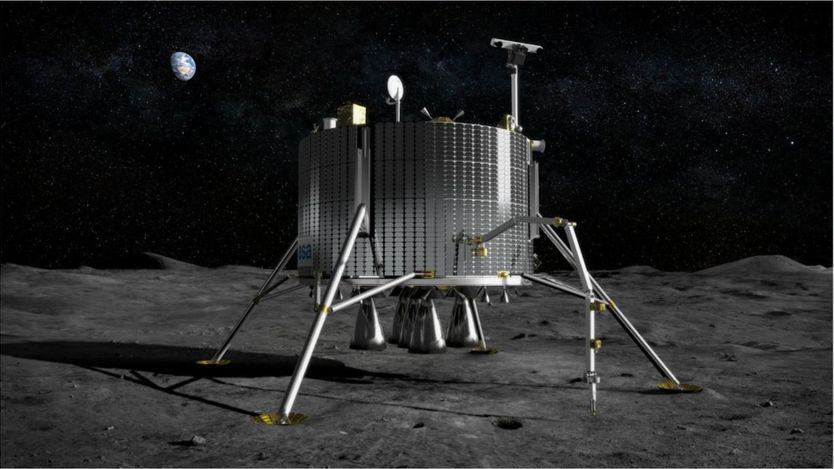
NASA's lunar resource prospector, in "pre formulation" stage proposed for launch in mid 2020s. It would be controlled in real time via the Deep Space Network. This is not designed for low latency control - and from the LADEE and LCROSS, then they expect " typical two- way signal transmission durations of 6 - 10 seconds with edge cases of 25 seconds and irregular bursts of 15 seconds". For the resource prospector with higher bandwidth they expect latency of 10 - 30 seconds. As a result the rover will be controlled by using waypoints - they select a point for it to travel to, say 8 meters ahead. As it arrives there it takes stereo images which the operators use to choose the next waypoint and so on. It uses solar power and so will make short visits to permanently shadowed regions for a few hours at a time. For details see this paper.
For more about this, see Robotic scouting phase - need to go back and find out what's there first
This is an idea for an “origami rover” the size of a smartphone which spaceships and rovers could take with them to deploy to scout out places where it’s too dangerous for the main rover to go, or get to places they can’t reach (because they are much smaller). A larger rover could also deploy several of them, to scout its neighbourhood, to see which is the most interesting place to go to next.
It can climb 45 degree slopes, crawl into overhangs, and drop into pits and craters. Because it can be folded flat, you can stack them one on top of each other a bit like a pack of cards, and they can do parallel science increasing the amount you can do in a day. It can survive a fall of three meters on Mars so that would be about 6.86 meters on the Moon.
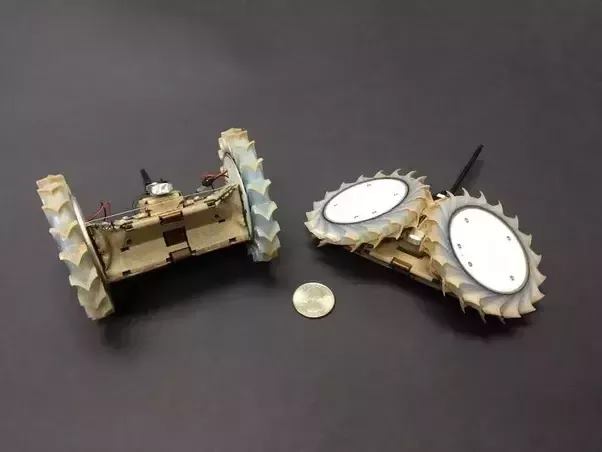
This is what it is like in the tests:
It has “whegs” instead of wheels - a kind of cross between a leg and a wheel that lets a rover traverse much rougher terrain than you can with a wheel.
They can travel quite long distances too as in this sped up video of a 250 meter “hike”
It can travel about 2,050 feet (625 meters) on one battery charge on a flat dirt path like that.
This shows it climbing a steep slope - it can handle up to 45 degrees:
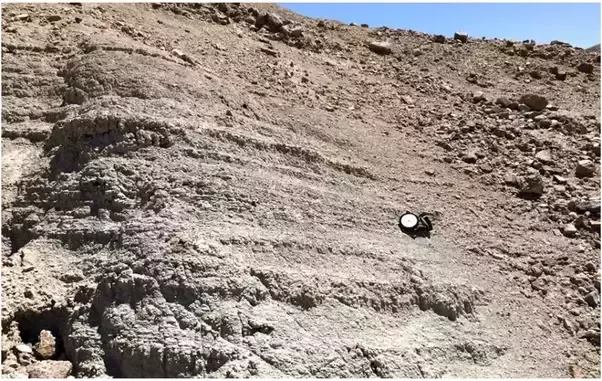
And slip into cracks
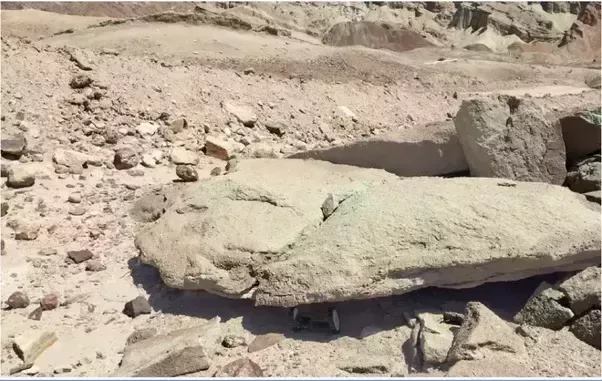
So far they have tested it in Rainbow Basin California, at a ski resort in Grand Junction Colorado, Big Bear California and on Mt Erebus in Antarctica.
They plan to field test them in the Mojave desert in the near future. PUFFER’s body inspired by origami is due to Jaakko Karras, at JPL who is also the project manager.
Its body is wrapped in Nomex, the same textile used for the air bags that cushioned the NASA Spirit and Opportunity rovers when they landed on Mars. The Nomex is integrated into the folding circuit boards and it helps protect it from high temperatures as it repels heat. It’s able to function in the Mars temperatures of –135 to 30 ˚C without a heater. The next stage is to find a way to integrate instruments into it. For instance to sample water for organics or add a spectrometer. It is a “Game Changing Development” program managed by GCD, and is part of NASA’s Space Technology Mission Directive. For more about it: Origami-inspired Robot Can Hitch a Ride with a Rover, PUFFER Prepares for Field Testing, JPL Robotics: Research Tasks, NASA's Adorable Pop-Up Rovers Are Designed to Explore Harsh Alien Terrains - and I did a page on quora here with the youtube videos embedded into the page.
Another idea is to use flat two dimensional landers, using the same technology used for flexible thin film electronics in ultra thin laptops etc. They have the advantage that you can stack many of them into a small space. This is an artist's concept for Mars but they'd also be useful on the Moon.
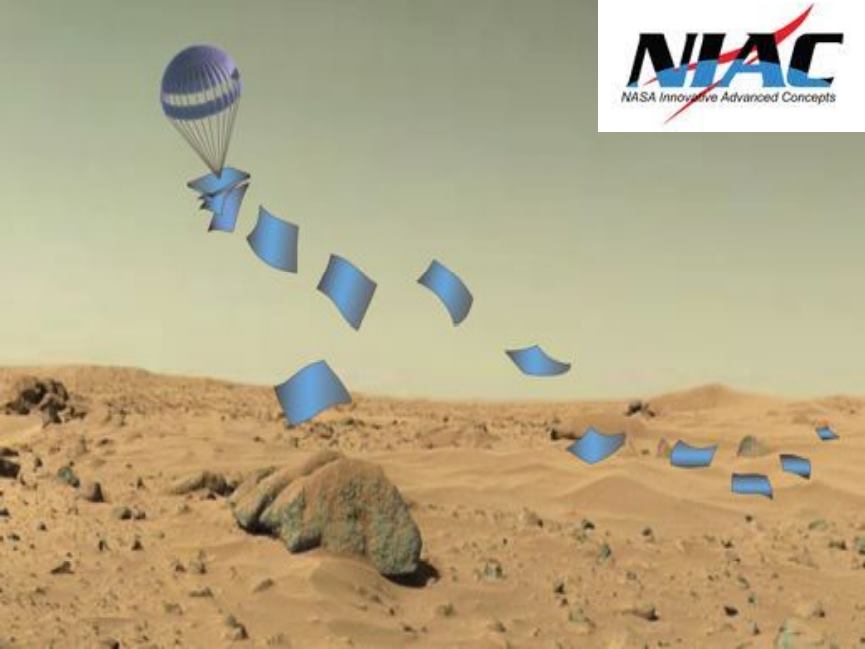
They can actually move around on the surface by including actuators in the sheet. They could be made of Kevlar woven fabric, as it has strength and resilience down to cryogenic temperatures. They could be covered with Mylar to protect the kevlar from UV. They could be powered by printed circuit board fuel cells or ultra thin flexible solar cells, or through power beaming from another orbiter or rover. They can communicate using either a flexible RF transmitter, or else, though with a lower data rate, via modulating laser retroreflector array (which changes its reflectance a bit like a bar code for a bar code reader, except one that's continually changing) to an orbiter or rover that beams a laser light at it. It can keep warm through a radioisotope heater unit if necessary.
Many instruments can be included too. 3mm diameter imaging cameras, or an imaging array for 3D video. Spectrometers and gas sensing films. A really tiny mass spectrometer, ground penetrating radar with a range of 50 meters with 15 meter resolution, and miniature laser based dust and particle analyser. They also had plans to develop more miniature instruments such as a miniature gas chromatograph and drills and penetrators that can be deployed from flat landers. For details see this article from 2014.
In the ESA plan, the printer needs to be large to do the regolith shielding. For techy details see: Lunar Outpost Design, 3D printing regolith as a construction technique for environmental shielding on the moon.
One of the main differences from printing on Earth is that they use a large gantry system on Earth:
"The current D-shape printing process, like most 3D printers, uses a gantry system that is always of an order larger than the printed object. This is not, of course, a feasible set up for any large scale structure. We assume that to be able to print on the moon, a much more ‘bottom up’ approach must be taken. Smaller robots could deposit small amounts of regolith and selectively solidify them with a printing device ("
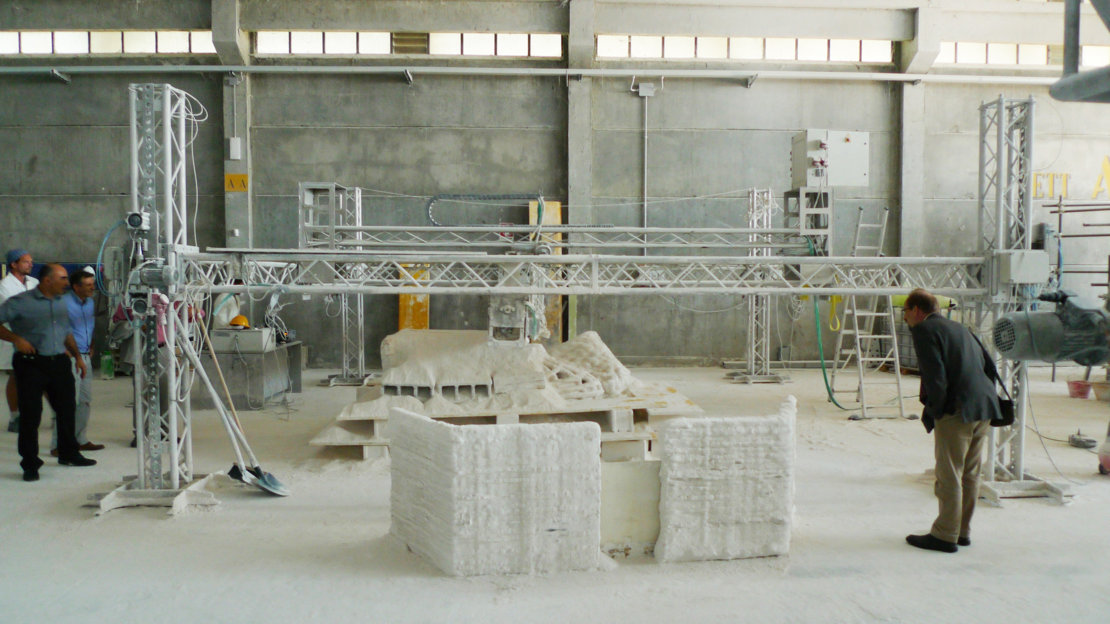
This is something that's in use already on Earth, printers that print out their own components. The aim of the Rep-Rap project is to produce more and more of the printer from raw ingredients.
This shows a Rep-Rap printer printing one of its own components in 2015 (author says it has improved since then)
This seems perfect for the Moon. Why not get the printer to print out a copy of itself? But even more so - why not get a small rep-rap printer to make a larger printer? Even a large beam could easily be made of many smaller components that snap together or indeed, "melt them together" since the lunar regolith is easy to change into glasses.
So, maybe you could send a small printer up to the Moon to make most of the components of a larger printer, which could then make an even larger printer, and at this point you can print out really large components in one go? This idea came out of a conversation with Sean Clifford on facebook. I haven't come across it anywhere else. Anyone reading this come across this anywhere?
The "Made in Space" project produced a 3D printer which has already been on the ISS:
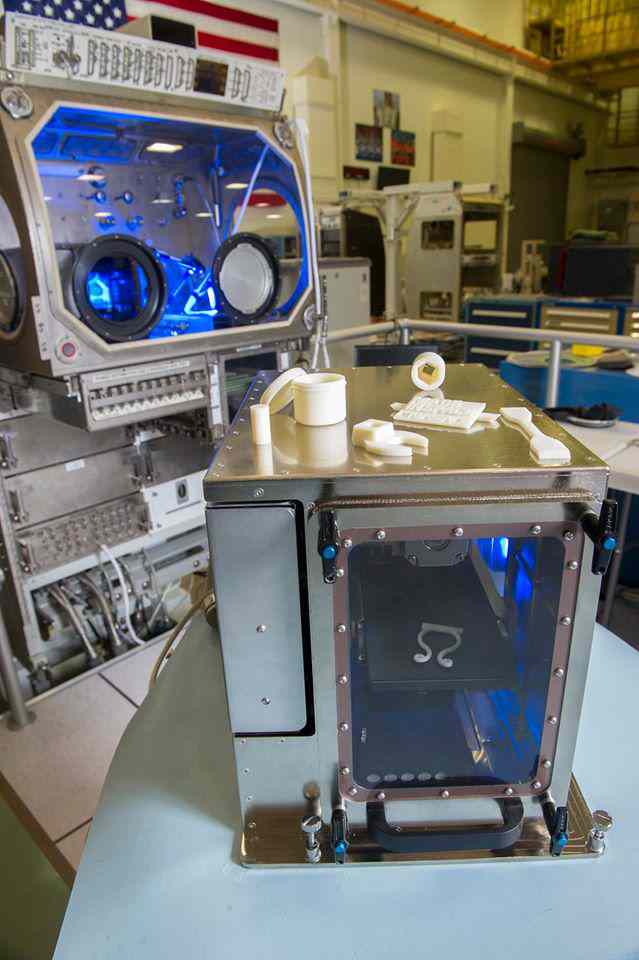
Made in Space's first 3D printer, launched to the ISS September 21st, 2014.
Eventually these 3D printers could produce components printed in space and assembled by robots into large space structures like this:
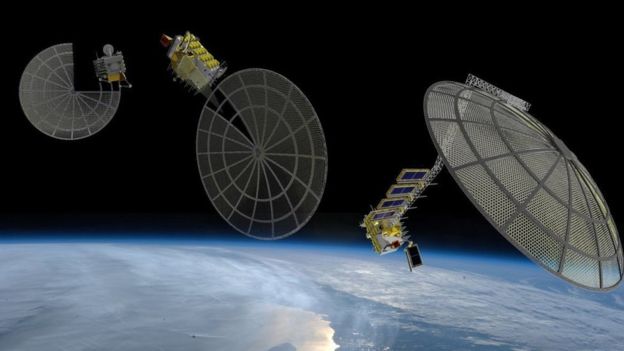
So anyway the idea suggested here - expect surely someone has thought about it before - but why not use smaller 3D printers to print components for larger 3D printers in the same way?
The smaller 3d printers could be small enough to send to the Moon as cubesats. They might be too small to print the regolith shielding for a habitat, or anything large, in less than years of work, but if they make a larger 3D printer first, this could speed it up a lot.
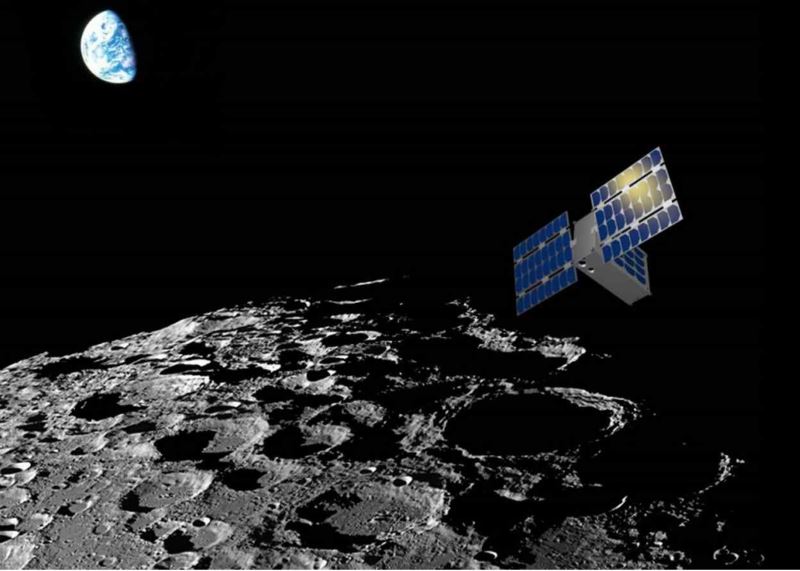
Artist's concept for Lunar Polar Hydrogen Mapper - cubesat from Arizona university to map water resources on the moon. It's by Dr. Craig Hardgrove. One of two missions selected, as part of NASA's Small, Innovative Missions for Planetary Exploration (SIMPLEx) program, capped at a budget of $5.6 million, to ride along on the first flight of the Space Launch System (SLS) in 2018 - see CubeSats to the Moon
Then, there's the Vermont Lunar Cubesat project lead by Carl Brandon
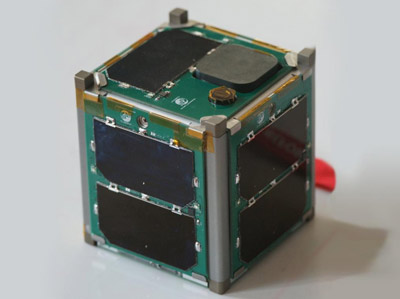
Vermont Lunar Cubesat [VTC]. This prototype successfully orbited Earth, taking pictures, from September 2013, to 21st November 2015. A bit more about it. And Lunar Lander / Orbiter CubeSats (slides), for Carl Brandon's complete lander / orbiter system to land cubesats on the Moon. For more, see the website for the Vermont Technical College Cubesat Laboratory.
This could be a first step towards cubesats to the rest of the solar system. Cubesats to the Moon are a natural starting point.
So, could these be used for 3D printing on the Moon? Could you fit a Rep-rap printer into something as small as this? If not, one thing you can certainly do with cubesats is a lot of robotic explorer with low cost missions of costs of order a few million dollars each, with robots exploring on the surface and in orbit.
We would probably use the Bigelow inflatable modules to reduce weight.
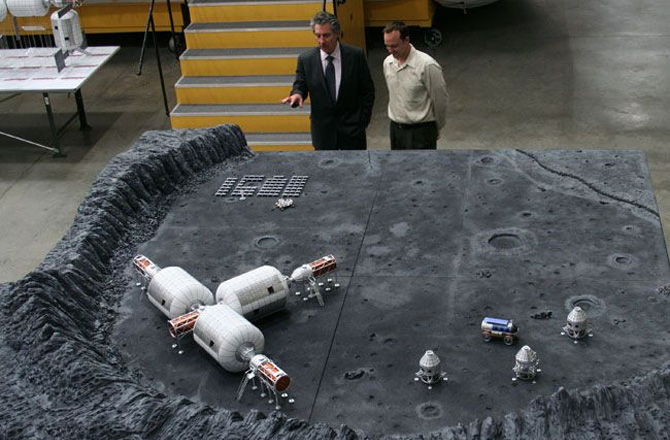
Robert Bigelow with a model of a Bigelow Aerospace lunar outpost
BIGELOW AEROSPACE
We could get started quite soon if the Falcon Heavy is a success, with its 53 tons payload, perhaps using the Dragon V2 for humans.
This is a rather fun idea originally suggested in the Moon Miner's Manifest Classics - 1987-1988 (see page 31). It's not so likely in the early stages, because of the large amounts of water needed to construct it, but it may perhaps be of great value at a later stage, especially for bases that have a lot of traffic in and out.
If water is the liquid, it has to be over sixty meters deep (62.3 meters), to equalize the pressure inside and outside the habitat.
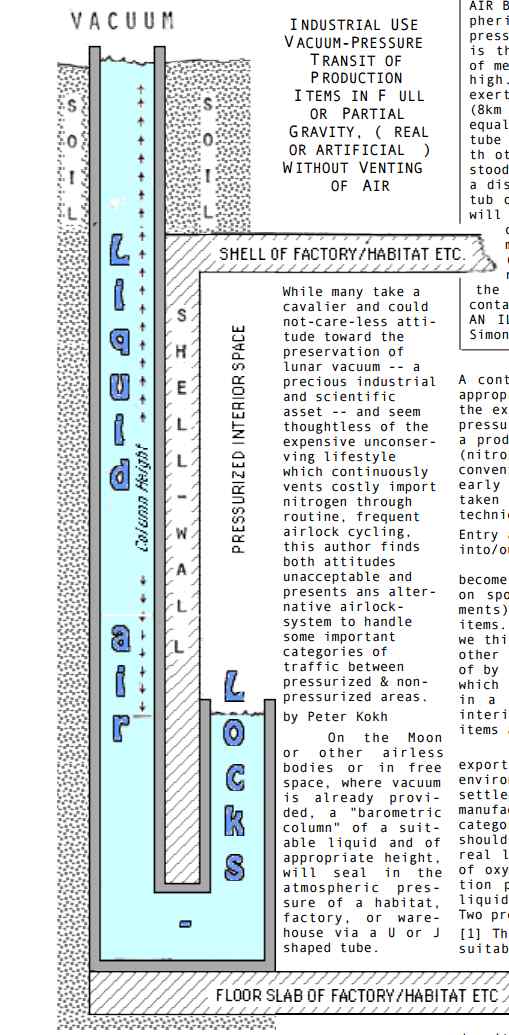
Liquid airlock for the Moon. You need to look carefully at the picture. How it works is that you have a sump, like the sumps that cave divers dive into. On the inside, it is kept in position by the pressure of the air inside the habitat. On the outside is a vacuum.
It's like the way that In a barometer, the weight of the mercury counterbalances the pressure of the atmosphere outside, with a vacuum above the mercury. It's like an "inside out" barometer with the vacuum on the outside. The weight of the water in the column counteracts the pressure of the air in the habitat.
You then don't need any doors but can just dive through it and come out on the surface of the Moon in your spacesit.
The height of the water column can even be a benefit for a base in a lunar cave, if it is 60 meters below the surface, then you can get to the surface by floating up in the sump through buoyancy.
However there are ways to reduce the height.
The height calculations here aassume the base is at atmospheric pressure. But spacesuits are kept at 29,25% of atmospheric pressure for mobility (4.3 pounds per square inch (psi) cinoared to 14.7 psi at sea level), In the ISS the air in the airlock is gradually reduced to the same pressure as for the spacesuits before they exit for a space walk. However it would be possible to keep the entire base at a lower pressure, reducing the sump to 18.22 meters high.
The depth can also be much less, if it is a denser fluid. You might think that as for a barometer, mercury is the best fluid of all, because of its high density, at least, if it weren't for its toxicity. Especially for a surface base, the lower column height the better.
Mercury would give a column height of only 76 centimeters on Earth, so on the Moon, (9.807/1.622)×0.76 = 4.6 meters. Should we look for the densest liquid we could send to the Moon?
Well, if supplied from Earth, the actual mass of the mercury would be the same as the mass of water. So in that sense, a denser fluid is no saving at all. If you can source the liquid in situ it's also a considerable saving, so if there is ice on the Moon that might well swing it in favour of water rather than some denser liquid from Earth. As for the column height, that's less of a consideration if the base is constructed inside a lunar cave, as many lava tube caves are likely to be at least 60 meters below the surface of the Moon. It might be useful to be able to float up 60 meters to the surface. A denser fluid would help with a surface base.
In the vacuum conditions of the luanr surface, exposed water would evaporate quickly, all gone in just one day, or less. But there are solutions to this, including, to cover it in a thin film of vacuum stable light oil, or to replace water with the liauid metal Gallium (which is non toxic, and liquid at 30°C).
Sections:
The interesting thing about it is that you could dive through it in a spacesuit, if your suit is capable of being submersed, and come out onto the surface with no loss of air at all from the habitat. There is no need to evacuate the airlock This means you have it there available as an airlock all the time, "always open".
Any time you need to get out of the base in a hurry you just dive through the sump. This could be quite a saving in air if the airlock is in regular use and could also make it faster to go in and out - no need to wait for the air inside the airlock to cycle before the next group of people or equipment to exit. For instance if the entire base has to evacuate after a fire, even a large base could evacuate quickly through a single sump.
In the other direction it would also keep dust out of the habitat.
Now, spacesuits aren't normally waterproof. The ones used by astronauts to prepare for space missions in swimming pools are just mock-ups of real spacesuits. They are designed to operate in an atmosphere or a vacuum.
For one thing, to make the joints mobile, then the bearings lose air constantly at litres an hour, so water would leak in in the other direction. There may also be electronics that would be exposed to water if it was submerged. And the outer layers would not necessarily be waterproof either. Imagine drying off a spacesuit inside a habitat, to stop it getting mouldy?
So - this would need waterproof spacesuits. However this isn't beyond the ingenuity of space engineers.
A simple solution is an outer suit outside of their spacesuit that they don before getting into the pool, watertight. Even maybe a zip-lock type bag engineered to be strong enough for the task -, zip up get into a lift / hoist, unzip when they get to the top. Or an outer covering that's waterproof and also helps to keep the dust out that they wear permanently on the lunar surface (with a vent that's closeable for the sump).
Or perhaps you just drive in / out with rovers - in that case the rovers have to be waterproof.
For cargo, deliveries to the ISS are normally packaged anyway - so you just need to make sure the packaging is waterproof.
Also it wouldn't be the only exit from the base. Even if not much used for individual astronauts, it could be very useful for large cargo deliveries, if you want to deliver 100 tons at a time, say, it might take hours to cycle all that material through a small airlock able to take a ton at a time. Either you have large airlocks, or you have a liquid lock.
With a liquid lock you can just drop the cargo in from the top and remove it from the bottom continuously.
The liquid needs to have a very low vapour pressure. If it was water you'd lose it through evaporation into space in vacuum conditions at a rate of tens of meters thickness of water per day. Indeed you'd lose nearly all of the 62.3 meters depth of your water lock in a single day of evaporation.
Calculation indented
With surface temperature of 273.15 °K (0 °C) and using the equation for mass loss of liquid water in a vacuum of
(pe/7.2) * sqrt (M/T) kg / m² / sec (equation 3.26 from Modern Vacuum Physics)
where M is the molar mass in kilograms, 0.018 kg for water, T is the temperature in kelvin, pe is the vapour pressure, which for water at 0 °C (273.15 °K) is 611.3 Pa, (Vapour pressure of water at 0 °C), so putting all those into the formula we get:
(611.3/7.2) * sqrt(0.018/273.15) = 0.689 kg / m² / sec.
So you lose 24*60*60*0.689 or about 59.529 tons a day.
So you lose about 60 meters a day thickness of liquid water exposed to a vacuum, or about 21.9 kilometers thickness of water per year at 0 °C.
The rate of loss goes up if the temperature increases. So, what about room temperature? Well they do the calculations here: Modern Vacuum Physics where they use the vapour pressure for water at room temperature 295 K to calculate (2300/7.2) * sqrt(0.018/295) = 2.495 kg / m² / sec.
So at room temperature of 22 °C,you lose 24*60*60*2.495 or about 215.6 tons a day
So now you lose around 215.6 meters per day and 78.6 km per year.
It doesn't help much to have a layer of ice on the surface of the water as ice also sublimes rapidly into water vapour in vacuum conditions, unless it is extremely cold. Spacesuits often use sublimation of ice to cool down astronauts.
So water is no good, so what can one use instead?
The original author suggests NaK. which is highly reactive with water and could burst spontaneously into flame if exposed to air. Not the safest of materials for a liquid airlock
However, this is my suggestion, you could use room temperature or lower ionic fluids. An ionic fluid is a salt, like sodium chloride, common table salt. That's liquid only at very high temperatures. If it is liquid at room temperature or below, you call it an ionic fluid. There, a salt in chemistry is a general term for the result of combining any acid with any base. When in solution, it has positive and negative ions. When you melt the solid salt, if you can do that without it decomposing or vaporizing, it also usually consist of positive and negative ions (cations and anions).
Anyway, so it turns out that if salts have a high molecular weight, they are often liquid at room temperature, and what's more, they can be liquid even at very low temperatures such as you'd get on the lunar surface. That makes them ionic fluids. Typically they have very low vapour pressures, so wouldn't boil away in a vacuum. They have been suggested for liquid mirror telescopes on the Moon.
The only thing is, that most are high viscosity which would make it hard to get in or out, but there is research into low viscosity ionic fluids. Also if the ionic fluid is immiscible and also low density, so that it floats on the surface of the water, you might only need a thin film of it to protect the rest of the water from evaporation. In that case, as a thin surface layer, it wouldn't matter much if it has high viscosity. But many salts will dissolve easily in water.
Another idea is to use vacuum stable light oils designed for use in conditions of high vacuum. In this paper, one of the tetraalkasylane oils mentioned has a very low saturated vapour pressure. It's also less dense than water at 857.4 kg / m³ so would float on water. As usual calculation indented so it is easy to skip:
It's structure is:
Figure 1. The structure shown as SiCH-3 has a very low saturated vapor pressure at 25 C of only 2 * 10-10 Torr or about 2.666*10-8 pascals.
So it has
5 * Si: 5*28.0855 amu
4*(3+10) C: 52*12.0107amu
4*(6+21) H : 108*1.00794 amu
For a total of 873.8 amu
That makes the calculation .
(pe/7.2) * sqrt (M/T) kg / m² / sec (equation 3.26 from Modern Vacuum Physics)
where M is the molar mass in kilograms, 0.018 kg for water, T is the temperature in kelvin, pe is the vapour pressure
(2.666*10-8/7.2) * sqrt( 0.8738/(273.15+25)) = 2*10-10 kg / m² / sec. Or about 6.33 g / m² / year .
This time the calculation is for 25 C because that's the temperature at which the author measured the saturated vapour pressure.
An even better example is Pennzane X2000 which is used as a lubricant in space applications
Pennzane X2000 density 0.85, vapor pressure 10-12 torr or 1.333 * 10-10 pascals. This time measured at 40 °C.
Formula C65H13 0 (2 octyldodecyl cyclopentane)
So it's molecular mass is 65*12.0107 + 130*1.00794 amu = 911.7277 amu.
So it would lose (1.333*10-10/7.2) * sqrt( 0.9117277/(273.15+40)) = 10-12 kg / m² / sec. Or about 0.032 g / m² / year .
So, if you cover the liquid water column with a thin layer of this tetraalkasylane oil you'd lose only around 0.26 grams per square meter of the oil to the vacuum of space even if the water was kept at or above normal room temperature at 25 °C. And as for Pentane x2000 then you lose only 0.0013 grams per square meter per year at 25 °C.
You might not need much. Even a micron thick layer, even a monolayer would be enough to stop the water from evaporating - just as only the thinnest of layers of aluminium oxide is enough to prevent aluminium from combusting when exposed to air. A thin layer would also help with the issue of equipment getting covered with oil as it goes in or out of the lock. If it is just a monolayer then this won't have noticeable effects.
The oil wouldn't need to be photostable - there'd be some sort of a reception area probably covered above the upper entrance to the sump which would protect it from exposure to direct sunlight. Probably also it would be a shelter covered in regolith for protection from solar storms.
Perhaps a liquid airlock might also be useful for moving cargo in and out. Instead of those big hanger like airlocks you get in science fiction movies, maybe you'd just have a truck that drives through a sump filled with ionic fluid - or even - a funicular railway type carriage gets pulled through it? You could have trains that run out of the base onto the lunar surface directly with no need for an airlock so long as they can withstand being submerged. This doesn't seem to be beyond future high tech. The more I think of it, the more possibility it seems to have for future tech.
One thing that makes it harder on the Moon is that with a sixth of the gravity, the column is six times higher. A water column would have a height of (9.807/1.622)×10.3 or 62.3 meters which is quite a lot. The author talks about higher density fluids to keep the height difference down. Some ionic fluids are high density so that would help. If we can find a high density low viscosity ionic fluid, that's ideal.
However Wikipedia has a useful section on heavy liquids. Sodium polytungstate is the densest non toxic one I can see there, density 3.01, reducing the column height to 20.7 meters. Clerici solution is denser but toxic.
Gallium is even better at density 6.5 reducing height to 9.6 meters, and if you are using it as a heat sink for the habitat seems like a good choice too. Has to be kept above 30 C, That's a little on the warm side for a swimming pool. However even heavy things would float to the surface easily so that would be a plus. That would reduce the height to less than 10 meters. And - the high temperature wouldn't be much of an issue for cargo or people driving in / out in rovers or buggies. But would have to be very sure it's not going to freeze on you as you travel in / out
As with water, you could cover any of these high density liquids with a thin layer of an immiscible low vapour pressure liquid such as vacuum stable light oil. But now it doesn't matter even if it is rather dense, so long as it is less dense than the liquid it covers. However if we use Gallium it has an extremely low vapour pressure
Back to our forumula:
(pe/7.2) * sqrt (M/T) kg / m² / sec (equation 3.26 from Modern Vacuum Physics)
where M is the molar mass in kilograms, 0.018 kg for water, T is the temperature in kelvin, pe is the vapour pressure
vapor pressure 6.08e-36 pa (from this online calculator) molecular weight 69.723
So it would lose (6.083*10-36/7.2) * sqrt( 0.069723/(273.15+30)) = 1.3*10-38 kg / m² / sec. Or about 4*1O^-28 g / m² / year .
Even after a quadrillion years you still would only lose trillionths of grams per square meter.
You'd need to be heavily weighted to submerge in liquid Gallium, lead weights obligatory. But if you ever get into trouble just drop the weights and up you'd float to the surface.
There's a plus there, however, for water and for low density ionic fluids, as then the height difference is comparable to the depths below the surface of the floors of the lunar cave entrances. When you dive into the sump at the bottom of the cave, your buoyancy will take you to the surface. That could be especially useful for cargo - a sump that goes all the way from the cave floor to the surface would make it easier to move goods up and down using weights, or floats.
The mass isn't that much for a moderate sized settlement. If you have 60 residents, then that's only one ton per resident, and they would have tons of supplies delivered per resident every year probably.
You might wonder if the area exposed the the lunar surface would freeze. However usually the main issue with a habitat is to keep it cool. The ISS has huge heat rejecting panels. So long as enough heat is supplied from the bottom, the hot water would convect upwards and keep the surface warm. Indeed, it might well be an idea to have some kind of radiator system at the top connected to the sump to use it to convey as much heat as one can upwards from the habitat. After all the surface exposed to a vacuum might as well be in a vacuum flask, the vacuum is a good insulator and it would only lose heat through radiation. It's just a small radiator and wouldn't lose much heat into space.
First, there is no real risk of the water leaking inwards. It's like a cup upturned and pushed down underwater. The pressure of the air in the habitat keeps the water out. It can only get in if the pressure inside the habitat goes down, at which point the water in the sump would gradually rise. Of course one should have a cover that can go over automatically in case of habitat depressurization to stop the water lock filling the habitat with water.
In the other direction though, it's a more serious failure mode. Suppose something goes wrong with the atmospheric pressure regulation and it increases to 1.1 atmospheres. The waterlock would then require a water height of 68.53 meters. There wouldn't be enough height tin the water column to accommodate this, even if there is water available in a reservoir to automatically top it up. So what do you do?
The failure would be spectacular, if the habitat pressure was self regulating. The sump would immediately start to sink, pushed out by the higher pressure inside the habitat. The habitat air system would respond by pumping in more air to compensate for the increase in volume to be filled. The air would eventually bubble around through the sump and up to the surface. The habitat environment control system would continue compensating for the loss of pressure pumping the air out onto the surface of the Moon.
You could design it though with some play in the system to deal with small pressure variations. First you go down a meter or so to go into the sump, so that a slight increase in pressure won't lead to the water level going so low air bubbles out through the siphon. Then to have a reservoir that automatically fills the sump to raise the water levels if the interior sump level starts to fall,, and enough head room at the top of the sump in the reception area above for the water to rise some meters before it overflows onto the surface of the Moon. And finally then those doors that automatically close if the internal pressure is too high to deal with by just adjusting the column height, or in case of some failure of the regulation system itself.
It would need safety doors to deal with this too. Perhaps just a compartment above the sump, an antechamber, with airproof and waterproof doors that slam shut in this situation.
A liquid airlock would also help keep out dust. A lot of the dust in the Apollo lunar module came in on the outside of the suits. So it would surely also come in on the outside of vehicles and their wheels, and there'd be a chance of it getting scattered in through an open airlock too from the outside. None of this would happen with a liquid airlock.
This is an idea from Bryce Johnson to use water inside the airlock on Mars as a way to protect from the dust and contaminants in the dust such as perchlorates. It could be adapted to the Moon as well. He explained the idea to me in a conversation in the Case for Moon facebook group:
"Crews come in from outside. Hatch is sealed. Air is introduced followed by water that not only neutralizes (or at least sequesters) contaminants but also begins the process of cleaning the suits. As a plus, the air is efficiently forced out of the airlock as the water rises. At no point is the water ever exposed to Martian vacuum.
"Evacuating the water only requires opening a valve to the pressurized inside of the shelter to let the air in. Opening a second valve drains the water out like in a bathtub. The contaminated water goes into a holding tank where solids are filtered out. Depending on the exact nature of contaminants, the water could be processed further to be reused. This system would NOT be part of the environmental system and the water is not intended for human/animal/plant consumption."
It has many of the advantages of a liquid airlock, but as the water is never exposed to the vacuum it can just use ordinary water.
Another suggestion (my own, on reading his idea) - in a larger habitat, with enough space for it, you could also have the hybrid idea of an ordinary airlock leading to a sump that astronauts go through to go into the inner habitat. Again the advantage is that you can use ordinary water as it is never exposed to vacuum. It might permit faster throughput of traffic as a hybrid between the water lock and the liquid airlock. It also provides an extra layer of protection if the outer airlock fails, especially if there is enough water to fill the airlock and seal it after a breach, with ice forming as the water cools down exposed to vacuum conditions.
We will surely just bring air from Earth to start with, since it's only a small amount of the launch mass, only 0.26% in the case of the atmosphere in the ISS (not including stored nitrogen), as we saw in the Nitrogen section. But later on, if we have thousands or even millions living on the Moon, perhaps we might want to fill the entirety of a large cave with air. A cubic kilometer of air weighs 1.225 million tons, which is a lot of nitrogen to find somehow. Could we source it on the Moon? This is for a fair way into the future of course, but let's try to get a rough estimate of whether it is possible.
Let's try a cave 250 meters in diameter, and 100 km long, a medium sized lunar cave (if the Moon does have caves as large as the Grail data and modeling suggests), but huge for Earth. That's 4.9 cubic kilometers of air, so 6 million tons of atmosphere using our 1.225 million tons per cubic kilometer figure (1.225*PI*(0.25/2)^2*100).
That much nitrogen could be sourced on the Moon, using lunar railways to truck it from the poles, if they do have the 600 million tons of volatiles, and 6% nitrogen for a total of 25 million tons of nitrogen. Typical heavy trains on Earth can carry 20,000 tons upwards. So if we had their like on the Moon that would be 300 train trips to fill the cave using volatiles from the poles.
You could also fill the cave pressurized to a tenth of Earth normal, which is enough to grow crops and for humans to walk around using only an oxygen mask, and then have pressurized habitats and greenhouses and parks within it at Earth normal pressure. If you do it that way, you need 600,000 tons of atmosphere for our cave 250 meters in diameter and 100 kilometers long, requiring about 30 trips of a heavy goods vehicle to truck the volatiles from the lunar poles to the cave.
Also, we can do another calculation based on the 225,000 km² needed to feed the population of the Earth on a basically vegetarian diet with the BIOS-3 system. If that area was covered with greenhouses, typical height say 2 meters, that's 550 cubic kilometers which at a mass of 1.225 million tons per cubic kilometer is around 674 million tons. If we pressurized the greenhouses at a tenth of Earth normal, that would be 67.4 million tons. There'd be enough water too, if we use aeroponics. So, if there are 25 million tons of nitrogen at the poles, the Moon may have enough by way of volatiles to fill greenhouses sufficient to feed 2.78 billion people or 37% of the Earth's population using the BIOS-3 system.
That doesn't include the carbon dioxide for growing food. As we saw above (CO2 on the Moon), if you supply enough carbon dioxide to bring the first crop to maturity without astronauts there (so you don't have to feed them), you need about 40 kg of CO2 per astronaut for the first crop, assuming it takes 40 days for the crop to reach maturity. After that, carbon dioxide becomes a nuisance gas to be removed if you need to import food.
If there are twelve million tons of carbon dioxide at the poles, that's enough for 300 million people on the Moon.
However this might not even be needed at all. If you are sending astronauts to the Moon anyway, and have to send habitats for them, you can surely manage to find the extra 40 kilograms per person for the carbon dioxide and what's more the extra 9 kg of nitrogen per person, or 90 kg if you pressurize the greenhouses to Earth normal. Each person would need at most twice their own weight in volatiles even with all the greenhouses pressurized to Earth normal.
Of course I'm not suggesting we colonize the Moon with nearly three billion people, but it does show that the Moon has a fair bit of potential for gardening just using indigenous resources.
So, yes, we could fill some of the medium sized caves in their entirety in this way (depending on what we find by way of volatiles there).
However, eventually if we had millions living on the Moon and wished to fill all the lunar caves with nitrogen and oxygen, and if some are as large as 5 km diameter and 100 km long, then you have the same problem as you have with an O'Neil cylinder, that in such a large space, the mass of the atmosphere dominates, and nitrogen is in short supply in the inner solar system, apart from on Earth and Venus.
For a cave as large as that, 5 km across and 100 km long, you would need 1.225*PI*2^2*100 million tons = 1.54 billion tons of volatiles, most of that nitrogen. Perhaps you could get it from comets, but they have only around 0.5% NH3 or so (hard to estimate). Perhaps it can be exported from Earth if transport costs go down hugely? Or perhaps you would build domed cities and air filled tunnels on the floors of the caves much as you would do it on the surface, and keep them in vacuum conditions. The reason for building in caves then would be for the protection from cosmic radiation, and micrometeorites and more stable thermal environment.
Anyway - that's for the distant future. It's clear we are not going to run out of volatiles on the Moon any time soon, so long as the volatiles are indeed abundant and easy to mine and transport.
We are at the same stage here as the very first Antarctica explorers, setting foot on a continent sized land mass that we know little about first hand. Indeed, far larger than Antarctica; the Moon is as large as Russia, the USA and China put together.
The ice at the poles of the Moon could be the "Record keepers of the early solar system" as Greg Delory put it (Thomspon, 2019. 'Significant Amount' of Water Found on Moon). They will have meteorites from Mars and indeed likely from early Venus too that have been preserved frozen at liquid nitrogen temperatures for millions and even for billions of years.Then there is more ice offset from the north and south pole. This may be ancient deposits from over three billion years ago before the volcanic activity, which changed the polar axis slightly by shifting material (Hand, 2016. Update: Lopsided ice on the moon points to past shift in poles).
Then there are ancient regolith layers covered with lava which preserve a record of surface lunar conditions and solar activity over billions of years.
There are other surfaces on the Moon recently formed with few craters - changed by some activity, perhaps emissions of gas, in the very recent geological past Some think it may still have ice, deep down, or even trapped water, from a layer of water rich material that might have accumulated on the early Moon at the same time our oceans formed soon after the original impact of the Mars sized protoplanet with early Earth - Water on the Moon, Yvonne Pendleton, page 3.
We don't yet know the age of the ancient South Pole - Aitken basin, a huge 2,500 km diameter crater which extends over the far side, the "oldest, deepest and largest basin recognized" on the Moon. Just a few samples of rocks returned from it would establish this.
The Moon might also be of interest for evolution and exobiology. That's because meteorites from Earth must hit the Moon in large numbers, after the largest impacts on Earth such as the dinosaur extinction Chicxulub event, (perhaps a million fragments around a cm in size, in that case). Though there is no atmosphere, the gravity is so low that meteorites from Earth can hit the surface at quite slow speeds (comparatively). This has lead to many ideas in the literature of ways that organics from life on Earth or other sources of interest to biology may be there for us to discover. We can only find out for sure by exploring the Moon on the surface:
This gives the potential for many exciting discoveries on the Moon relevant to astrobiology.
When you consider the meteorites and the regolith, the Moon must be a treasure trove of proto Earth secrets, and of solar system secrets too. It would start with ejecta from the early Earth as it cooled down after the impact that formed the Moon, Venus too if its atmosphere back then was thin enough for an asteroid impact to eject material with escape velocity, and Mars for sure. Also material from comets, and asteroids, nearly every major thing of note that happened in the inner solar system probably left a record there. The record should also include ejecta from every major impact on Earth, right up to perhaps fragments of ammonites from the Chicxulub impact which must have showered the Moon with large numbers of meteorites.
The Apollo samples were recently re-analysed and the composition of amino acids suggests some extraterrestrial sources, The analysis was a tricky one due to contaminants from Earth in the form of rocket fuel, organics taken to the Moon by the astronauts, and organics introduced while handling them on Earth, which suggests we need to take care to avoid this sort of thing as we explore the Moon.
So, another thing we can do on the Moon is to find out how much organic contamination accompanies human explorations. E.g. before we send humans to Phobos or Deimos or wherever they go next, we'd better know what humans will do to a celestial body when they set up a settlement there. Especially if the aim is to study ice deposits in craters and such like. Organic Measurements on the Lunar Surface: Planned and Unplanned Experiments
The far side is the best place to build radio telescopes anywhere near to Earth.
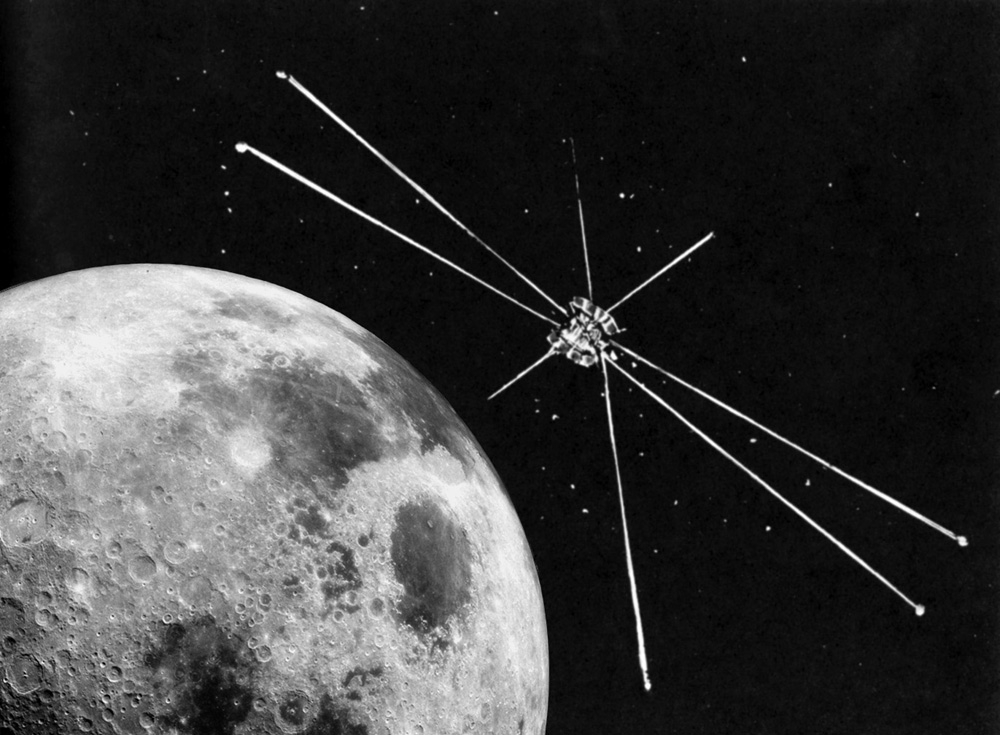

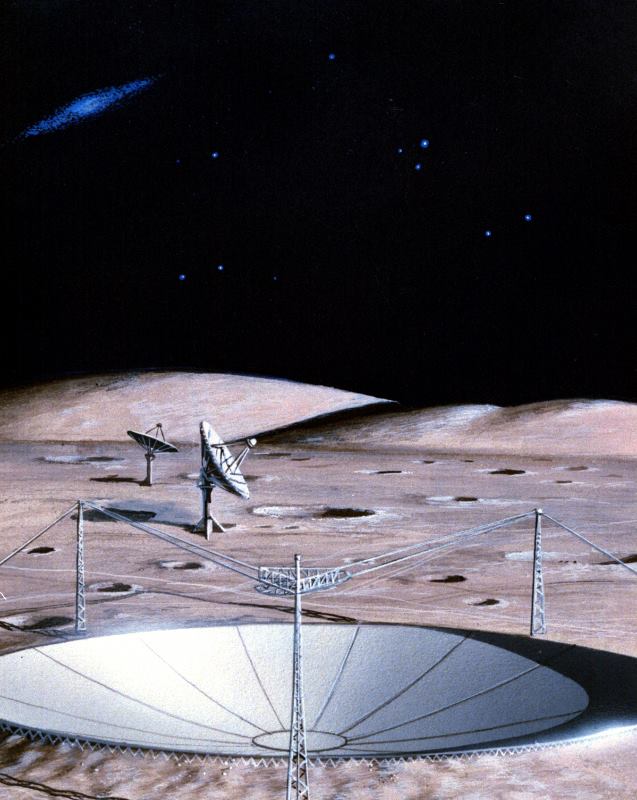
There are challenges as well of course. If observing during the lunar night (so least interference from the Sun) then it's both cold and without solar power. Either you use RTGs or power storage for the lunar night.
The Moon is also good for optical telescopes. See Lunar Telescope Facility Final Design Report (MIT, 2007)
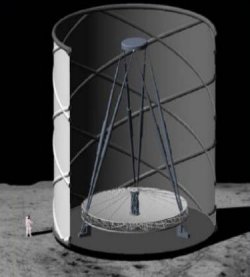
Artist's impression of a large liquid mirror infrared telescope on the Moon, passively cooled near the lunar poles. By a useful coincidence, a slowly spinning liquid in a gravitational field naturally forms an optically perfect parabolic shaped mirror. Because there is no atmosphere, the optics would be better than for a liquid mirror telescope on Earth, indeed it would be diffraction limited (i.e. the best that is theoretically possible).
These telescopes are so simple to build and lightweight that it should be feasible to build a 4-8 meter liquid mirror telescope soon after a lunar base is established, and larger mirrors later on, with 100 meter telescopes well within reach. Other advantages for the Moon include low shipping mass, ease of assembly, and low maintenance.
A lunar infrared liquid mirror telescope would have a mirror like this
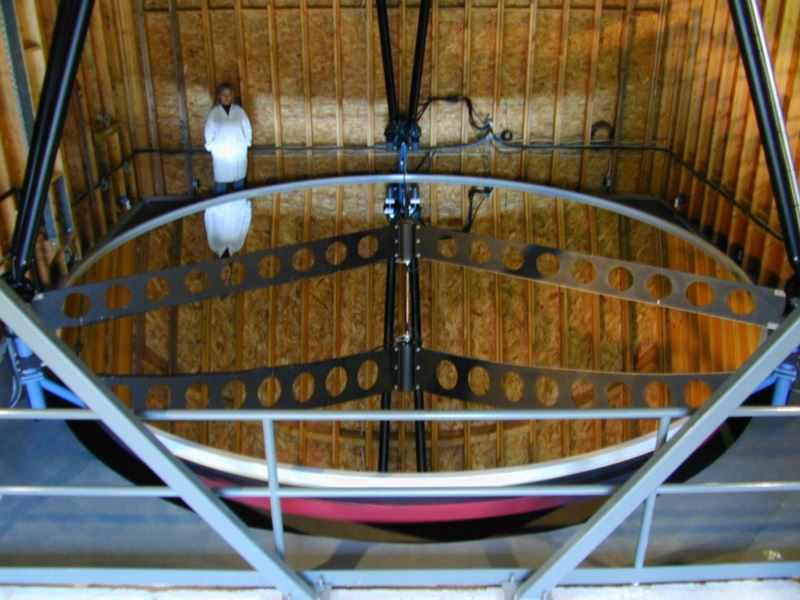
which keeps its natural perfect parabolic shape through rotating the disk slowly. The photo shows the six meter diameter Large Zenith Telescope in Canada. On the Moon, this mirror would be made of ionic fluids (salts in a liquid state) rather than mercury, due to their very low vapour pressure which would let them work in the vacuum conditions of the Moon.
If the telescope is anywhere except at the poles, it will scan a circular strip around the sky. Also because the Moon's axis wobbles with a period of 18.6 years, it actually sees a fair bit more than that circular strip. Most of the lunar libration we see from Earth is due to changes in viewing geometry because of the Moons irregular orbit, it's slant relative to the Earth's equator, the varying distance from the Moon etc.
Shows how the Moon librates as seen from the Earth. Most of this is due to changes in the viewing geometry as seen from Earth.
However, there is also a small variation due to actual motion of the Moon's axis. The Moon's axis precesses, and traces out a circle in the sky of radius 1.5 degrees every 18.6 years. That's quite a lot in astronomy - the Moon as seen from Earth spans only half a degree, so if we can use this unit of the Moon's apparent diameter as seen from Earth- we can see three Moon's worth above of sky above and below the track of the telescope depending on the position in that 18.6 year cycle.
(Earth does have a subtle effect also - nutation - it's precession period is 26,000 years but the the position of its axis varies by an extra half a degree over that same 18.6 year time period as the Moon, enough to be useful for liquid telescopes here as well.)
That's also why the peaks of sunlight at the poles have periods of darkness, but only for a few days of the year. This is actually an advantage for polar infrared telescopes on the Moon. For more details, see Liquid Mirror Telescopes on the Moon (NASA news, 2008). A liquid mirror infrared telescope on the Moon 20 meters in diameter could detect objects a hundred times fainter than the ones visible to the planned James Web Space Telescope. All the materials for a 20 meter telescope would amount to only a few tons, a single load on a heavy boost rocket. A hundred meter diameter telescope could detect objects a thousand times fainter than for the James Webb. Though not steerable, this would be especially useful for detecting faint red shift galaxies from the early universe, and supernovae from these early times, .
The dust can be dealt with, for instance by making a region around the telescope into glass, which is easy to do on the Moon as use of a microwave turns the regolith into glass as easily as you boil a kettle. Unlike Mars, there are no dust storms to deal with. Just electrostatic elevation of the dust. See Lunar Glass.
There are many things we can do from space observatories can also be done from the Moon, in the future, if there is some advantage in doing them on the Moon e.g. because there is a base already there, ease of maintenance, using in situ materials etc.
However there are a few other forms of astronomy that the Moon is uniquely suited for, not yet mentioned. From this list of Lunar Exploration Objectives - picking the ones not yet mentioned and ones for which the Moon has special advantages:
Another big surprise recently is that the Moon was recently geologically active, over the timescale of millions rather than billions of years. It might even be active today.
First there are the lobate scarps, fault lines that cut across small craters on the Moon. Small craters tend to be geologically young as they get obliterated by later craters. So these faults are thought to be young, possibly as young as a few hundred million years.
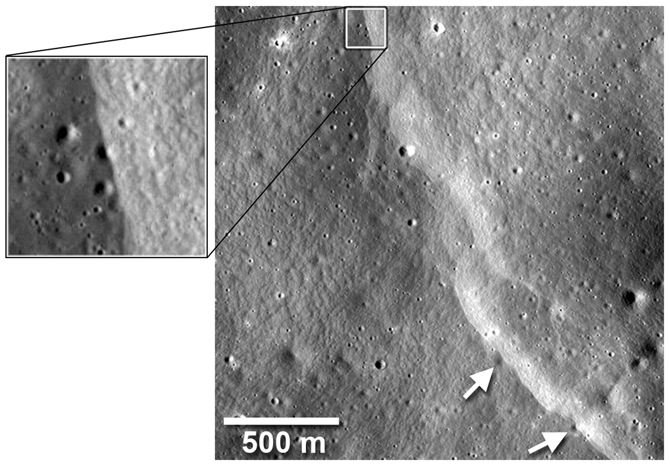
The Apollo seismometers recorded moon quakes, and though most are probably due to impacts, tides, and day / night temperature changes on the Moon, it leaves the possibility open that perhaps the Moon is still active today. These scarps may be a sign of it.
See NASA's LRO Reveals 'Incredible Shrinking Moon'
Then, they also found graben - trenches formed when the crust pulls apart. And these are as young as 50 million years old. That is so young that it suggests the Moon is still active.
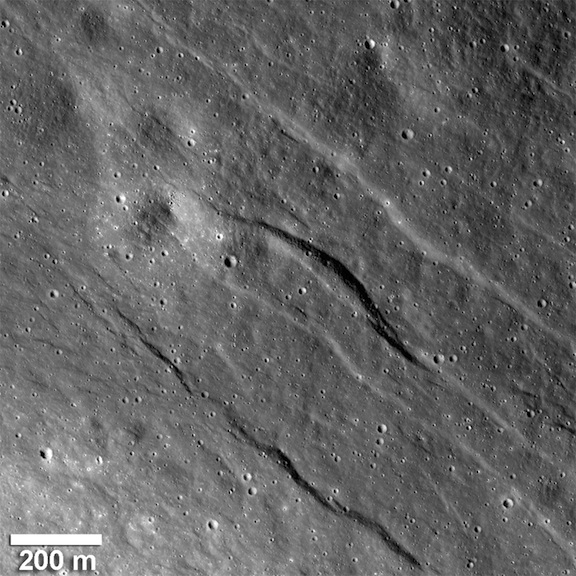
Graben on far side of the Moon found by Lunar Reconnaissance Orbiter
This was a big surprise as the lobate scarps suggested that the Moon was shrinking. So how can it be expanding as well?
Seems in some places it is shrinking and in other places it is pulling apart. If the entire Moon was molten and then cooled this shouldn’t happen - It may be because the outside of the Moon was remelted at one point due to bombardment by asteroids, and that can lead to this situation where as it cools down part expands, part contracts.
Then, there's this strange feature on the Moon, unlike most of the terrain there, the Ina depression.
_mid%20_to_low_res.jpg)
Ina depression as imaged by LRO. It's 2.9×1.9 km and 64 m deep. Higher resolution available here. It is one of four similar features around the Imbrium basin.
First discovered by Apollo 15 in 1971, it's now known to be one of many such. They are small features, less than 500 meters across, and seem to be widespread on the near side of the Moon. Some may be as young as 100 million years old. Some of the younger features may be as young as 50 million years old. This means you can't rule out the possibility of future eruptions.
The LRO team found 70 "Irregular Mare Patches" (IMPs) from 100 meters to 5 km in diameter. To find out more, see Volcanoes erupted on the Moon within the past 100 million years which also has a link to the full Nature article which you can read through their article sharing initiative.
Whatever it is, it seems to be geologically recent, as there are few really small craters, and larger features have sharp edges and haven't been degraded. This suggests an age of only millions, rather than billions of years. It's spectra shows it to be bluer than the surrounding terrain (slightly) - a spectral signature consistent with freshly exposed Mare materials. Schultz et al interpret it as mare exposed by a sudden outgassing from the interior blowing away more than 12 meters thickness of overlying an regolith or pyrolastic material (rubble like in texture, result of fountaining lava in the past).
However, there's a new interpretation from geologists from Brown university. They think that Ina depression may consist of magmatic foam - a mixture of gas and lava to make a highly porous texture. If so, then newly formed regolith gets jostled into gaps in the rock by seismic activity, making it seem younger. And impacts into porous material like this makes smaller craters. An impact that would make a 100 foot diameter crater in regolith would make only a 30 foot diameter crater in a more porous material. Taking this into account they get a revised age of 3.5 billion years which puts it into the same timeframe as other volcanism on the Moon. Jim Head, professor at Brown university and co-author of the paper with the leading author, graduate student Le Qiao puts it like this.
“We think the young-looking features in Ina are the natural consequence of magmatic foam eruptions on the Moon. These landforms created by these foams simply look a lot younger than they are.”
_8.5×11.jpg)
Ina depression relief map; red is higher, blue is lower. Geologists from Brown university suggest that these mounds rising from an ancient caldera may consist of magmatic foam, which leads to smaller craters and so makes it seem younger than it really is
The Moon's surface layers are not just depleted in water compared to Earth, they are also depleted in the more volatile metals potassium and sodium too (by comparison with the less volatile zinc). One recent idea is that when two protoplanets collided to form the early Earth, and the debris condensed to form the Moon, volatile rich layers may have condensed first, then dry layers accumulated on top of them (links also to the original Nature paper) . That paper is mainly used to explain why the surface layers are so dry. They weren't able to determine if the interior would have volatiles in it, but it's possible.
So, it's not necessarily as dry all the way to the center as it is on the surface. Perhaps it has water and other volatiles deep down. If so, these outgassing ideas may be easier to accept.
Then you have the Transient Lunar Phenomena. Moon observers over the years have often noticed short term brightening of the Moon's surface, especially in the Aristarchus plateau. A small bright patch will appear, then disappear, just a bit too slowly to be just a flash from an impact on the Moon. Our eyes are very good at picking up such things, but also easily fooled. So it's a controversial observation. But they may be the result of outgassing, again, if they are real.
So anyway, Arlin Crotts of Columbia University noticed a correlation of the TLPs with sites where argon and radon gas is detected. This can't come from the solar wind and must be outgassing from below the surface. The usual explanation is that it's the result of slow leaks from radioactive decay from below the surface. He thinks that there may also be explosive outbursts of gas which may lead to the TLPs.
He developed these ideas in a series of papers called "Lunar outgassing, transient phenomena, and the return to the Moon", where he also suggests that the Moon may have ice some meters below the surface replenished from below
In the third paper he proposes using ground penetrating radar in orbit around the Moon to search for subsurface ice. He also suggests various ways to monitor the Moon from orbit searching for outflowing gas as well as attempting to observe the TLPs directly.
Then there's this curious phenomenon, the Lunar Swirls. The most prominent of these is Reiner Gamma which is visible in a backyard telescope, but becomes much more impressive with high magnifications.
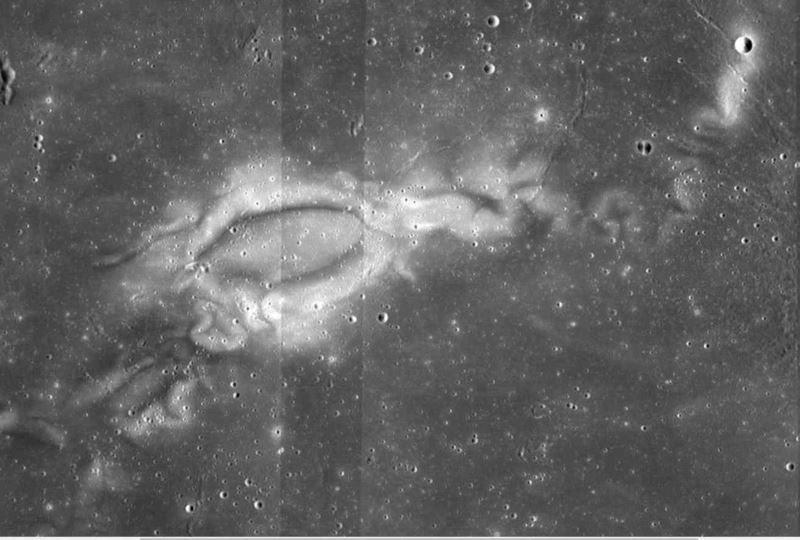
Lunar swirls in Reiner Gamma. The swirls are always associated with magnetic anomalies (a discovery made serendipitously in 1972 using two small satellites released into lunar orbit by Apollo 14 and Apollo 15 to study the Moon's magnetotail), and this is one of the strongest magnetic anomalies on the Moon. Though not all magnetic anomalies have swirls.
The light coloured swirls in these photographs are not associated with any geological feature but seem to be laid on top of the surface, and they don't seem to have any noticeable thickness or have any effect on the topography.
Whatever they are, they are intriguing and who doesn't love a mystery? Some of the magnetic anomalies on the Moon might also be tracers of iron nickel / platinum asteroid impacts, if so do the swirls tell us anything about them? Or are they something else, nothing to do with any metal asteroid impacts (e.g. for the comet hypothesis)?
On top of that you also have the unexpected. What I've described so far are things we can expect, or know to search for and investigate, on basis of what we know so far. But usually we get surprises when we explore new places in the solar system. And though in some ways the Moon is well understood, in other ways it is barely explored at all on the surface, never mind below the surface. It wasn't that long ago that ice on the Moon was a big surprise to many astronomers. It may have many other surprises in store too. We have spent hardly any time exploring the Moon so far, with only one expedition with a geologist on it. Imagine if we had given up on Antarctica as "done" after the first few expeditions that succeeded in landing a human on the continent?
The Moon may be the key not just to lunar habitats, but also habitats in free space. The original plan for space habitats in the 1970s was to use a rail gun on the Moon to fire material away from the surface for the radiation shielding of the Torus. This is the most heavy part of the structure. The idea was to land a small bulldozer on the Moon, and then bulldoze the regolith, load into a railgun - or a mass driver as it is usually called in this context, and fire it to the construction site for the habitat. This then would be used for the 4.5 tons per square meter cosmic radiation shielding; the heaviest part of the structure.
As O'Neil put it in his testimony to the US house of representatives (subcommittee on space science and applications) in 1975, talking about his smaller Island One:
"The removal of half a million tons of material from the surface of the moon sounds like a large-scale mining operation, but it is not. The excavation left on the moon would be only 5 yards deep, and 200 yards long and wide: not even enough to keep one small bulldozer occupied for a five-year period."
The Stanford Torus would need 20 bulldozers for 5 years, more of a job, but it's still not a huge impossible undertaking to source the shielding on the Moon. With the low lunar gravity, and escape velocity of only 2.3 km / sec, then this could be done with solar powered or nuclear powered rail guns on the Moon capable of sending material to orbit. This is something we could test on the Moon.
The most important metric here I think is the amount of mass per colonist. For a Stanford torus you have 1000 tons per colonist including the regolith shielding or equivalent. Put like that it does seem a lot more than for any surface habitat. But you need roughly similar amounts of regolith shielding for surface habitats. And you still need a bulldozer or similar to use the shielding to cover your habitat. If the infrastructure to get this material from the Moon to the space colony is just a small item in the total budget, as O'Neil suggests, then this difference is not as significant as you might think.
When you look at structural mass, you only need 15 tons per colonist for the Stanford Torus, and you need 4.4 tons per colonist of atmosphere for a total of 20 tons per colonist, or five colonists for every hundred tons. That is the only mass you need to launch from Earth for early stage habitats - and later on you can hope to mine this too from asteroids, using the metal rich asteroids for metals, or get it from the Moon. This is very similar to any other space station / space colony.
We can compare this with the ISS which has 419 tons for up to 6 astronauts so about 70 tons per astronaut. As a Stanford Torus habitat, that much mass could support 20 colonists. You'd expect the Stanford Torus to be more efficient through economies of scale, and apart from the radiation shielding, there isn't much difference between the Stanford Torus and anything else.
Also, the Stanford Torus is not necessarily the most efficient. The "Kalpana one" for instance has multiple levels inside the torus and the shielding rotates with the habitat which simplifies the engineering and reduces the total mass per inhabitant. The Vademecium (grand prize winner for the NASA Ames Space Settlement contest in 2006) consists of a torus with an elliptical cross section which reduces the amount of atmosphere needed per colonist.
The only colonies that need significantly less mass than this are the lunar caves and the Venus cloud colonies. The cloud colonies require less mass per colonist than any other habitat, because they don't need to hold in the atmosphere, meteorites are much less of a problem, and with pressure the same inside and out, tears in the fabric, if ripstop, don't matter much either. They can be made of thin materials similar to airships. Just about all the mass consists of the biosphere itself in that case. See Venus cloud colonies - a surprising low maintenance solution.
The lunar caves of course eliminate the need for additional shielding completely and reduce the amount of mass needed to hold in the atmosphere and probably also reduce the maintenance costs for the external envelope of the habitat (you could make a low maintenance airtight enclosure by covering the interior of the caves with a layer of glass formed from the regolith dust). See Lunar caves and Lunar caves as a site for a lunar base.
However free space habitats have other advantages such as easy generation of artificial gravity, direct sunlight available 24/7 year round, and ability to position them in LEO, GEO, near to NEOs for mining and so forth.
So, you can position them wherever you want, set the artificial gravity as high as you like, and you can set your own day / night levels as you like not tied to any planet just by tilting mirrors. You could simulate any planet or moon or exoplanet in your orbital habitat easily.
We've just mentioned the idea of using a lunar mass driver. This is a 1970s artist's concept drawing of the idea, the large area of solar cells to the left powers it.
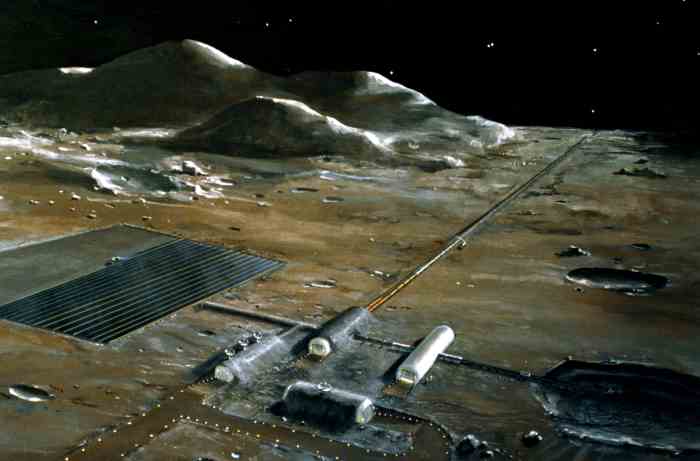
However, unless it can be constructed largely using in situ materials, then there is a lot of material to send up to the Moon to construct it. This is a 2010 study that (making various assumptions) suggested that a lunar mass driver would have a long payback time. The more frequently you can send the payloads, the shorter payback time. You might want to do regenerative breaking to recover as much of the energy as possible from the launch vehicle. Some ideas for mass drivers on lunarpedia.
Then, there's the possibility of generating fuel using the ice at the lunar poles. With 600 million metric tons at least, if those figures are correct, then it seems that we could make fuel without significantly impacting on the amount of ice there.
There are other ideas also for exporting materials from the Moon, such as the lunar space elevator. which was promoted in a successful kickstarter by the Liftport group. Though we don't yet have the technology to build a space elevator on Earth, we could in principle build one on the Moon. It would extend from the surface through the Earth Lunar L1 point,
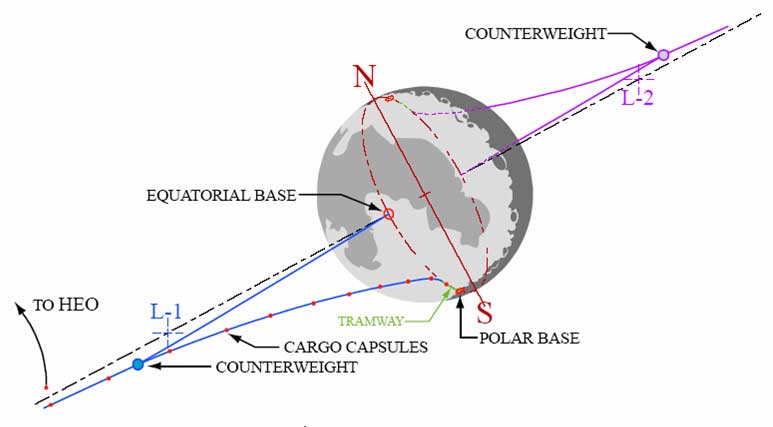
There are different design ideas, but one proposal in 2011 was for an 11,000 kg tether made of Zylon HM fiber which would be 264,000 km long, transport microrovers to the lunar surface, and return 10 kg at a time from the lunar surface, so that is a mass to payload ratio of 1,100 to 1. For techy details see LADDER.
For more background information about lunar tethers, see. "Lunar Space Elevators for Cislunar Space Development Phase I Final Technical Report"
Another ingenious idea, and one with a much lower structure to payload ratio than a lunar elevator is Robert Hoyt's Cislunar tether transport system. More details: CISLUNAR TETHER TRANSPORT SYSTEM
It uses momentum exchange tethers. This shows the idea for Earth - a rotating tether that could pick a payload from a suborbital spacecraft up from the upper atmosphere, and boost it into LEO. If the tether rotates at exactly the right spin rate, then it can be stationary relative to Earth when in the upper atmosphere, closest to Earth in the tether spin - and spinning at just the right speed to boost the payload to LEO at the upper part of the spin. This is too hard to do at present. But it could capture a payload from a suborbital spacecraft moving at Mach 12, and boost it to orbit.
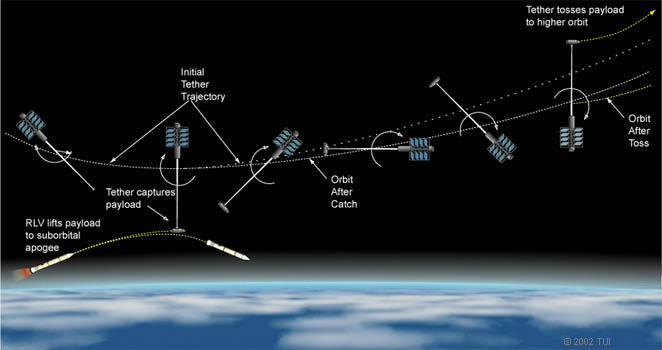
Well this gets especially interesting if you do it on the Moon. Robert Hoyt designed a cislunar transport system which looks like this:
"The Cislunar Tether Transport System. (1) A payload is launched into a LEO holding orbit; (2) A Tether Boost Facility in elliptical, equatorial Earth orbit picks up the payload (3) and tosses it (4) into a lunar transfer trajectory. When it nears the Moon, (5), a Lunavator Tether (6) captures it and delivers it to the lunar surface."
At the Moon end of the transport system, the tether can be stationary relative to the Moon's surface when closest to the Moon. There are many details to the idea - that's just the outline of how it works. See his Cislunar tether transport system.
His summary reads:
"We have developed a preliminary design for a 80 km long Earth-orbit tether boost facility capable of picking payloads up from LEO and injecting them into a minimal-energy lunar transfer orbit. Using currently available tether materials, this facility would require a mass 10.5 times the mass of the payloads it can handle. After boosting a payload, the facility can use electrodynamic propulsion to reboost its orbit, enabling the system to repeatedly send payloads to the Moon without requiring propellant or return traffic. When the payload reaches the Moon, it will be caught and transferred to the surface by a 200 km long lunar tether. This tether facility will have the capability to reposition a significant portion of its “ballast” mass along the length of the tether, enabling it to catch the payload from a low-energy transfer trajectory and then “spin-up” so that it can deliver the payload to the Moon with zero velocity relative to the surface. This lunar tether facility would require a total mass of less than 17 times the payload mass. Both equatorial and polar lunar orbits are feasible for the Lunavator™"
The interesting thing about this is that it needs almost no fuel!
"By balancing the flow of mass to and from the Moon, the orbital momentum and energy of the system can be conserved, eliminating the need to expend large quantities of propellant to move the payloads back and forth"
That works because the LEO is lower in the gravitational well. So whenever you send material from the Moon to Earth, the system actually gains energy, a bit like a ball rolling down a hill. This is the whole beauty of the Hoyt system, what makes it so very clever.
When it picks up a space plane from a suborbital flight to send it to the Moon that lowers its orbit of course. But each time it then receives a payload from the Moon and that raises its orbit again. There is no need for any rockets, or ion propulsion or anything to keep boosting its orbit. That is why it has essentially zero delta v. Both tethers are powered by the flow of materials downwards in the Earths gravitational potential well from the Moon. There is no other propulsion involved apart from minor adjustments.
That's once there's a lunar base. Before then then it uses electrodynamic propulsion:
In the period before a lunar base is established, however, the tether facility will use electrodynamic propulsion to reboost its apogee by driving current through the tether when the tether is near perigee. "
However, later on once the base is established it can start catching payloads to reboost itself
"Once a lunar base and a lunar tether facility have been established and begin to send return traffic down to LEO, the tether facility can restore its orbit by catching and de-boosting these return payloads."
Explained in more detail:
"The tether will then pick up a payload from a circular, 450 km orbit and toss it to the Moon so that it will reach the Moon as the Moon crosses its ascending node. The facility will then drop to a lower energy orbit. At approximately the same time, the return payload will be released by the lunar tether and begin its trajectory down to LEO. When the return payload reaches LEO, the Earth-orbit tether facility will catch it at perigee, carry it for one orbit, and then place it into the 450 km initial payload orbit. Upon dropping the return payload, the facility will place itself back into the high-energy orbit."
This is also why it has very little overhead. It doesn't need propulsion. Just capture and release. Fine tuning of the orbit is done by reeling the tether in and out at various stages in the orbit.
It can achieve a launch only every 4.5 months or once a sidereal month with some use of tether reeling. All these quotes are from Cislunar tether transport system. :
"Once a lunar base is established and begins to send payloads back down to LEO, the orbit of the tether system can be modified slightly to enable frequent opportunities for round-trip travel. First, the facility’s orbit will be raised so that its high-energy orbit has a semimajor axis of 12577.572 km, and an eccentricity of 0.41515. The tether will then pick up a payload from a circular, 450 km orbit and toss it to the Moon so that it will reach the Moon as the Moon crosses its ascending node. The facility will then drop to a lower energy orbit. At approximately the same time, the return payload will be released by the lunar tether and begin its trajectory down to LEO. When the return payload reaches LEO, the Earth-orbit tether facility will catch it at perigee, carry it for one orbit, and then place it into the 450 km initial payload orbit. Upon dropping the return payload, the facility will place itself back into the high-energy orbit. The perigee of this orbit will precess at a rate such that after 4.5 lunar months (123 days) it will have rotated 180°, and the system will be ready to perform another payload exchange, this time as the Moon crosses its descending node. If more frequent round-trip traffic is desired, tether reeling could again be used to hold the orientation of the tether’s orbit fixed, providing transfer opportunities once per sidereal month."
One of the strong points in this design is the low mass to payload ratio of 10.5 to 1 for the tether in LEO and 17 to 1 for the tether in lunar orbit. It becomes especially favourable when you compare it to the propellant mass needed to send a rocket from LEO to the Moon and back, of 16 times the mass of the payload. A tether requires only 28 times the payload mass in LEO, so less than double the mass for the rocket, but can transfer many payloads, not just one.
"Comparison to Rocket Transport
"Traveling from LEO to the surface of the Moon and back requires a total !V of more than 10km/s. To perform this mission using storable chemical rockets, which have an exhaust velocity of roughly 3.5 km/s, the standard rocket equation requires that a rocket system consume a propellant mass equal to 16 times the mass of the payload for each mission. The Cislunar Tether Transport System would require an on-orbit mass of less than 28 times the payload mass, but it would be able to transport many payloads. In practice, the tether system will require some propellant for trajectory corrections and rendezvous maneuvers, but the total delta V for these maneuvers will likely be less than 100 m/s. Thus a simple comparison of rocket propellant mass to tether system mass indicates that the fully reusable tether transport system could provide significant launch mass savings after only a few round trips. Although the development and deployment costs associated with a tether system would present a larger up-front expense than a rocket based system, for frequent, high-volume round trip traffic to the Moon, a tether system could achieve large reductions in transportation costs by eliminating the need to launch large quantities of propellant into Earth orbit."
Agreed, if you want to go to Mars and it's your only destination you are interested in for humans outside of Earth, and for a short visit only, then perhaps it wouldn't make sense to set up all that infrastructure to mine lunar water, or lunavators, or lunar elevators or to build mass drivers, just for a single mission to Mars with humans, or even several missions perhaps.
But if you are visiting the Moon because it is interesting in its own right, then the fuel on the Moon could then easily become a key towards opening the rest of the solar system to easier spaceflight, as well as supplying fuel and water to LEO as well. And the other ideas may be useful also, especially if it turns out that the Moon is a useful source for water for space. Ideas like the lunavator might even make it economical to return materials from the Moon such as nickel, cobalt, etc., quite low value, but in large quantities.
Hoyt's cislunar tether or the propellants made on the Moon can return materials to LEO. That's great for materials that need to be supplied to LEO such as propellant and water, but what about exports to Earth itself?
To return materials to Earth, you have to target the Earth's atmosphere and to hit it slowly enough so that the materials you mine don't burn up in the atmosphere. You might do aerobraking first to reduce speed, and then over a period of time, skimming the atmosphere, lower the orbit to make the landing gentler.
When you are ready, then actually landing the materials on Earth is relatively easy. To make sure there is no risk of damage to Earth, if the parachute or aeroshell fails to deploy, make sure you send the materials in small amounts, small enough to burn up in the atmosphere in its entirety without the aeroshell - and equip each one with an aeroshell and parachute.
Conventional aeroshells are likely to be too complex to create on-site at least at the early stages of development, and too heavy and so too costly to export from Earth. But there's an alternative here, the ballute, an inflatable balloon that works like an aeroshell.
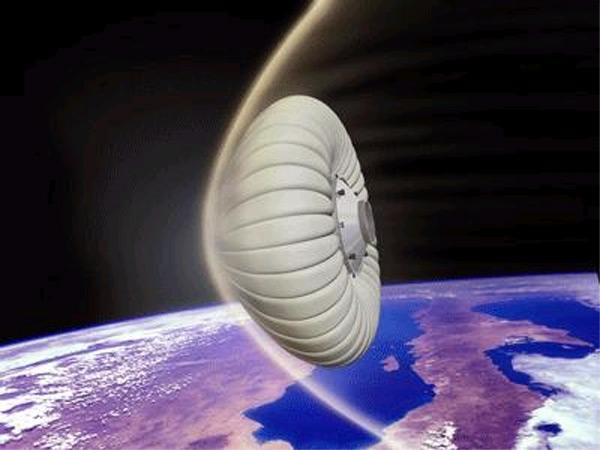
See the New Scientist article Inflatable cushions to act as spacecraft heat shields, and this article Profitably Exploiting Near-Earth Object Resources
It's lightweight, so you could make them on Earth and then send them up to the facility for returning to Earth.
Space mining would probably start with mining of water for use in LEO and other spacecraft missions - because of the high cost of supply of materials to orbit, making it far easier for the mining to turn a profit and pay for itself. But later, funded by the sale of water to space agencies, it could then move on to mining metals and other resources useful for Earth itself.
For those who worry that lunar exports might deplete the Moon of its volatiles, then mining the lunar volatiles for fuel is only needed for perhaps a few decades, or until we find an easy way to access other sources in the asteroid belt or find easy ways to lift water from Earth. If we get easy transport to orbit at dollars per ton (e.g. orbital airships, space elevators, or Earth based mass drivers), then the Earth would take over from the Moon and asteroids at that point for any materials abundant on Earth such as water, or air.
I think there's a good chance that eventually it will be as easy to get into space as to fly to another continent. If it costs a similar amount to transport of materials to space, or across the Atlantic, then it would surely be economical to send Earth water and air into orbit and would compete with sources in space. I think there's a good chance this will happen long term, perhaps on timescales of decades, and very likely on the centuries timescale. And of course there's no risk of Earth running out of water or air as a result of exporting the comparatively tiny quantities that would be needed in space. See my Projects To Get To Space As Easily As We Cross Oceans - A Billion Flights A Year Perhaps - Will We Be Ready?
Meanwhile, if there are hundreds of millions of tons of lunar volatiles, they should last until then, and will be a useful source of income for lunar development. That's enough water so that even if you had a million people on the Moon, you could have a full lane of an Olympic swimming pool's worth of water for each one from the local resources, and only a tiny amount of that would be exported for fuel.
Less delta v is needed to get water and other materials from Near Earth Asteroids to Earth, some have a delta v of less than 1 km / second. Though the ones that have the least delta v are the ones with orbital period closest to Earth which means that the times when they are most easily accessible from Earth come around less often, and close flybys might be a decade or more apart.
The Moon scores here in the early days because it is always easy to get to. Then, if the lunavator idea worked for the Moon, then you could get materials back to Earth with almost no extra fuel needed, so that could make the Moon even more attractive than an asteroid.
There are similar ideas for asteroids also, this time the idea to harness the spin of an asteroid to send materials to Earth using a tether that is attached to it and spins at the same rate as the asteroid itself. For the basic idea, see Asteroid Slingshot Express - Tether-based Sample Return.
In the long term future, perhaps the Moon would be most useful for materials that are rare in most asteroids but common on the Moon, such as Aluminium and Titanium. Both lunar and asteroid mining has the potential to move some of our industry into space, and help reduce the impact of mining on the Earth.
Buzz Aldrin, a keen advocate for Mars colonization, and inventor of the idea of the Adler cyclers for transport to Mars, is often quoted as saying "Been there, done that". But actually, he says we should go to the Moon first, with a quote from his own website:
“Aldrin and other experts believe Nasa is overlooking an important part of space exploration: a permanent, manned base on the moon that would prepare us for the mission to Mars.”
and in more detail here. (He has been reported as saying to leave the Moon alone - that's back in 2009, perhaps his views were changed by the more recent discoveries of ice on the poles, or was he just joking?)
In his "No Dream is too High" (page 81), he talks about a presentation he gave in 2009 to the Augustine commission when he said "Why go back to the Moon again? Been there and done that.". But he explains that he meant it facetiously, i.e. not to be taken seriously. A year later President Obama echoed his words, but seriously, in his speech to the White House in 2010: "Now, I understand that some believe that we should attempt a return to the surface of the Moon first, as previously planned. But I just have to say pretty bluntly here: We’ve been there before. Buzz has been there"
In his "No Dream is too High" he says (pages 63-4)
"I had made a presentation in 2009 for the Augustine commission... in an effort to encourage further exploration and to avoid duplication of our efforts, I made the comment "Why go back to the Moon again? Been there and done that." I was saying it facetiously.
I learnt a lesson from that experience. Be careful what you say nowadays, because it might be repeated - maybe even by the president of the United States ... Just because I am PASSIONATE about motivating people to explore Mars doesn't mean that I think we should forget about the Moon. I know we can enjoy numerous benefits by exploring and building an outpost of some sort on the Moon."
He goes on to say that after explaining his Mars ideas to Stephen Hawking, then - after a long time to compose his sentence as usual, "We waited a long time for Stephen's response. Finally he managed to say "Why not the Moon first?" " . So I think we can count Stephen Hawking as a Moon firster too :).
He then goes on to say "Although I don't want to ignore the Moon, I do want the next generation to go where no humans have previously traveled. There are entire vistas yet to be explored.". Then later in the book, page 203, he says "Returning to the Moon with NASA astronauts is not the best use of our resources. Instead we need to direct our efforts to go beyond the Moon to establish habitation and laboratories on the surface of Mars".
In his Mission to Mars, he says
"The moon is a different place since I traveled there in 1969.
"... Thanks to a fleet of robotic probes recently sent to the moon by several countries, there's verification that the moon is a mother lode of useful materials. Furthermore, the moon appears to be chemically active and has a full-fledged water cycle. Simply put, it's a wet moon.
"New data on our old, time-weathered moon points to water there in the form of mostly pure ice crystals in some places. For example, sunlight-starved craters at the poles of the moon — called 'cold traps' — have a unique environment that can harbor water ice deposits. Gaining access to this resource of water is a step toward using it for life support to sustain human explorers. Similarly, the moon is rife with hydrogen gas, ammonia, and methane, all of which can be converted to rocket propellant."
"Fresh findings about the moon from spacecraft have revealed the lunar poles to be lively, exciting places filled with complex volatiles, unique physics, and odd chemistry, all available at supercold temperatures ...
"In short, our celestial neighbour in gravitational lock, the moon, can be tapped to help create a sustainable, economic, industrial, and science-generating expansion into space. The question is, What should America's role be in replanting footprints on the moon?"
So, he's perhaps somewhat in two minds about it, but even with his strong focus on humans to Mars, he's not at all saying that we should ignore the Moon.
So far, this is a vision shared by many astronauts, scientists and policy makers. The ESA has come out firmly in favour of sending humans to the Moon first.
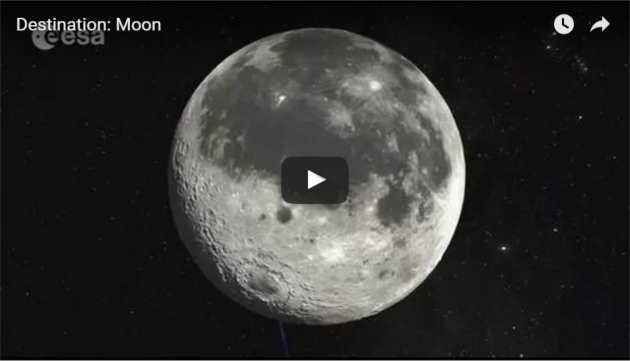
(click to show on Youtube)
ROSCOSMOS (Russian space agency) are of the same opinion. They plan a mission Luna 27 to the south pole Aitken basin in 2020 in partnership with Europe. See Europe and Russia mission to assess Moon settlement and video summary Luna 27 mission to explore Moon's south pole
President Bush also favoured this approach, when the Vision for Space Exploration Program was announced, though now, of course, US favours a "Mars first" approach.
The Canadian astronaut and former ISS commander Chris Hadfield has also come out firmly in favour of Moon first, as reported by Wired Magazine: "I expect we'll treat the Moon, for the next 100 years, like we've treated Antarctica for the last 100 years. With an initial outpost briefly and then longer stays and people staying through the entire winter, and eventually we will have permanent habitation on the Moon." Then, he says, humans will go as far as Mars. This is also the message of former ISS commander Leroy Chiao who wrote an article about it for Space.com
Hadfield when interviewed by New Scientist, put it like this in their article "We should live on the moon before a trip to Mars"
"I think ultimately we’ll be living on the moon for a generation before we get to Mars. If the world and the moon were threatened and the only way to preserve our species was to launch from Earth, we could go to Mars with yesterday’s technology, but we would probably kill just about everybody on the way."
"It’s as if you and I were in Paris, paddling around in the Seine in little canoes saying, 'We’ve got boats, we’ve got paddles, let’s go to Australia!' Australia? We can barely cross the English Channel. We’re sort of in that boat in space exploration right now. A journey to Mars is conceivable but it’s still a lot further away than most people think."
Jeffrey Hoffman is another astronaut who says we should go to the Moon first, saying "We basically just scratched the surface during Apollo, you know,". The US non profit organization Space Foundation also say the same. As also mentioned, Paul Spudis is a keen Moon first advocate, author of several books, most recently, The Value of the Moon, as is Dennis Wingo, CEO of Skycorp, and author of Moonrush. Others include Madhu Thangavelu, David Schrunk, and other contributing scientists to the voluminous appendices of The Moon: Resources, Future Development and Settlement. As another example, Bigelow Aerospace manufacturer of the BEAM inflatable habitat currently being tested on the ISS are more focused on the Moon their founder Robert Bigelow says the next logical step is the Moon. SpaceX is the only private space company that has Mars as its main target for humans.
More about some of this in Human Spaceflight At "Coastline Hugging Phase" - Lunar Villages Not Interplanetary Voyages - Op. Ed.
So far this is a "Moon first" argument. There's endless discussion between the Moon firsters and the Mars firsters about where humans should go first. See for instance the The Case for the Moon: Why We Should Go Back Now, and The Case Against the Moon: Why We Shouldn't Go Straight Back published in Space.com in 2011. These discussions rarely mention planetary protection.
Where this new vision differs is that planetary protection is a core principle which guides the vision. It's also an open ended vision where what we do next depends on what we discover along the way. It's a vision for human spaceflight enthusiasts with a deep love of science.
With the Moon as our starting point, we can then explore Mars as well. I totally agree that Mars is a great place to explore and that we can learn much about exobiology from studying it. But I think this is best done with robots initially, with humans first controlling them from Earth, and then later on, from Mars orbit.
The Mars colonization advocates say that we need to send humans to the Mars surface to explore it. But I don't think this argument stacks up if you look at it in detail, as you will see. In this alternative vision, humans work together with robots to explore the entire solar system, not just Mars. It uses humans and robots each to their best advantage, where they are most needed.
I've added links to my other online articles in this section, which you can read to find out more details about some of the ideas outlined here. Some of them have book cover images - these are ones that have been made into kindle books. Click on the book covers to go through to kindle booklet. These have the same content as the articles with addition of a table of contents and a cover image, and of course, formatted for kindle.
So the main points are (with links to other articles and booklets to find out more)
This early RNA based life could be similar in size to the contested microbe "fossils" in ALH 84001.
The 2.2 a structure of a full-length catalytically active hammerhead ribozyme, much smaller than a ribosome
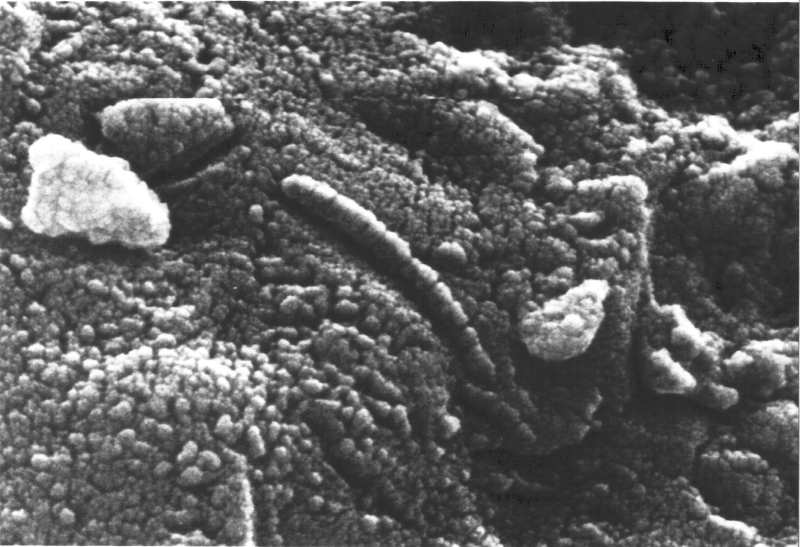
So the analogy of colonization on Earth is of limited relevance to space exploration. That doesn't mean it is impossible, but it's a new kind of thing that we have never done before, like colonizing the sea floor, and analogies with the past can't really tell us if it can be done or not, or how successful it is likely to be.
Overview of Pre-modern human migration - there is debate and controversy about the details, but generally agreed that humans were already present world-wide by the end of the neolithic period (which ends around 2,000 BC) or shortly after. Large scale colonization since then has always been of areas where humans can survive with stone age technology. More hostile places such as Antarctica, the highest mountain summits, and the sea floor, have not been colonized.
If you focus just on the colonization attempts that succeed, you get only a partial picture, which may be over optimistic.
Flag of the Company of Scotland Trading to Africa and the Indies. Their "Darien Scheme" an attempt to colonize Panama, lead to the death of nearly all the colonists, and it also drained Scotland of an estimated a quarter of all its liquid assets. Scotland was saved from bankruptcy by England, in exchange for unification with England, higher taxes, and an agreement to service the English national debt.
".. with current EDL (Entry Descent Landing) capability, a large vehicle plunging through the tenuous Martian atmosphere has about 90 seconds to decelerate from Mach 5 to Mach 1, flip over from being a spacecraft to being a lander, open the chutes to decelerate some more, then fire those thrusters to navigate to the landing site before touching down". - page 137 of SpaceX's Dragon: America's Next Generation Spacecraft, by Eric SeedhouseAll the resources you can find on Mars are also available on the Moon or in asteroids. The Moon has a shortage of nitrogen, but is not as thoroughly explored as Mars in many ways, and may still have it, e.g. it does have some ammonia in the polar ices from the LCross results . Nitrates are rare on the Mars surface also.
It may well be possible to solve this for humans. For instance SpaceX hope to use supersonic retropropulsion, which removes one of the stages, no need for the parachutes. But if you send humans to the Moon or asteroids, you don't have these problems in the first place. One less thing to deal with.



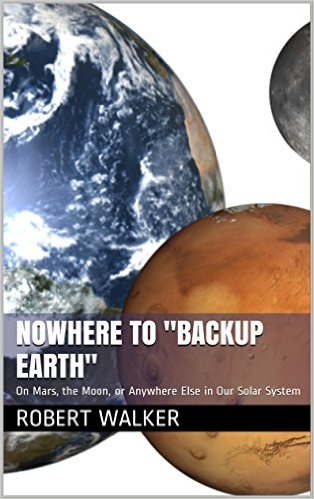

If you think Mars would be protected by a kind of six month quarantine because it takes so long to get there, remember that we have ideas for propulsion methods that could get us there in weeks possibly even days. Also we could set up a permanently quarantined colony on Earth easily enough for far less cost than a Mars colony.
"We set sail on this new sea because there is new knowledge to be gained, and new rights to be won, and they must be won and used for the progress of all people. For space science, like nuclear science and all technology, has no conscience of its own. Whether it will become a force for good or ill depends on man, and only if the United States occupies a position of pre-eminence can we help decide whether this new ocean will be a sea of peace or a new terrifying theater of war. I do not say that we should or will go unprotected against the hostile misuse of space any more than we go unprotected against the hostile use of land or sea, but I do say that space can be explored and mastered without feeding the fires of war, without repeating the mistakes that man has made in extending his writ around this globe of ours."It could be hugely positive if done well. It could be very harmful if it goes wrong. And the details of how we do it could swing it either way.
"There is no strife, no prejudice, no national conflict in outer space as yet. Its hazards are hostile to us all. Its conquest deserves the best of all mankind, and its opportunity for peaceful cooperation may never come again...."
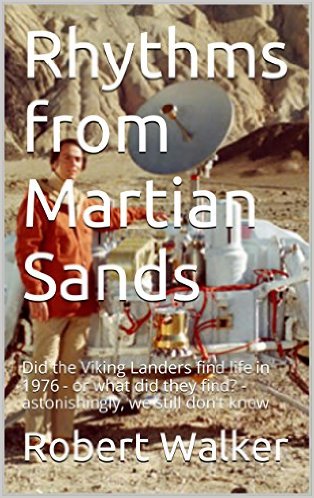
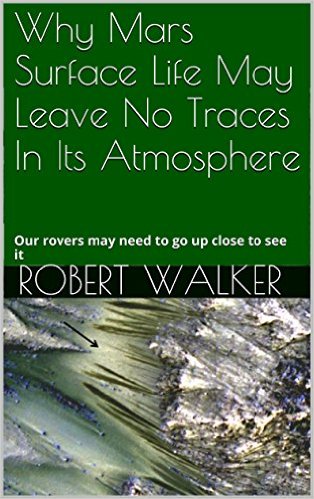
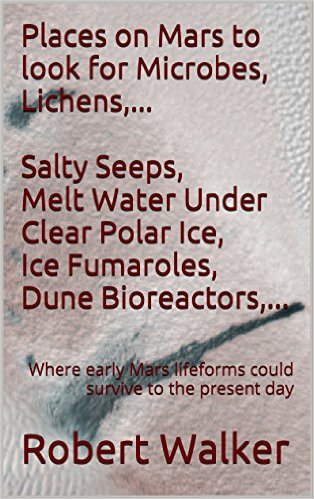
The bathyscaphe Trieste reached a depth of over 10 km in the Challenger deep in the 1960s, with Jacques Piccard and Don Walsh on board. But we don't send even a robotic sub into Lake Vostok to avoid contaminating it with surface life.
Scientists at the National Research Council have prepared guidelines to protect the lakes, similar to planetary protection guidelines. So, nobody would think of sending humans down there quite yet, as this is not possible within those guidelines.
The Russians drilled down nearly all the way to lake Vostok, but then stopped until they figured out how to do it safely, preserving the science value.
For the CO2 snow method, see See Deep cleaning with carbon dioxide. and Science Daily article about it.
Another idea, this is an idea which I don't think anyone is working on as far as I know, but it seems to have potential. There are electronic circuits now designed to operate at up to 200°C . High-Temperature Electronics
There are other developments that should permit temperatures of 300°C . High-Temperature Electronics Operate at 300 degrees C | EE Times and Designing for extreme temperatures There’s an economic incentive for developing these electronics, as they are useful in oil wells and motor cars. It's back to the drawing board probably for a lot of the designs, to use chips and solders etc. that work up to high enough temperatures for 100% sterilization. But it seems like it may be possible! Thanks to Adeel Khan for the suggestion
Is this right? Is it possible to achieve 100% sterilization by heating electronics that’s capable of resisting temperatures of up to 300 C. I wonder if anyone working in the field of spacecraft sterilization has investigated this, either experimentally or in theory. Or is there some other way to achieve 100% sterile electronics.
If we could achieve that, we could send our probes right up to the liquid water, with no risk at all of contaminating the habitats with Earth life. Perhaps this might be easiest with tiny chipsats and such like, tiny rovers and landers that could be sterilized more easily in their entirety.


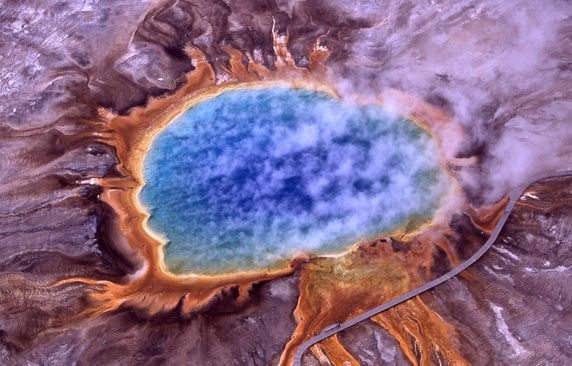
Grand Prismatic Spring, Yellowstone National Park, home to heat tolerant thermophiles. Eventually as the sun gets hotter, only heat tolerant thermophiles will survive on Earth - though that’s half a billion years into the future, long enough for humans to evolve a second time from the simplest of multicellular microscopic lifeforms.Say we find some exoplanet that hot, then adding life to it will not turn it into a second Earth. It may have life already, but though habitable, it’s not very habitable. It’s even possible that Venus has life in its upper atmosphere. If so, this life has just lingered as the planet got hotter, and has not kept it habitable for less acid and heat tolerant lifeforms.
Just possibly there might be some biological way to do something about this to cool down that future Earth or exoplanet using microbes - but why would just adding a lot of microbes from present day Earth cool it down automatically? If it could sort itself out, it would have done it already. Mars may well have life already, and if so, it has not terraformed it, and why then would life from Earth terraform it if its own native life has not?
In the case of Mars, it probably started off nearly as habitable as Earth, but lost much of its atmosphere, and also got colder. Being further from the Sun, it never was warm enough for trees to grow, unless it had powerful greenhouse gases such as methane making up much of its atmosphere.
So, it may have habitats for cold tolerant microbes. They’d also be salt tolerant, able to withstand high levels of perchlorates and use them as food. But that doesn’t mean that if we seed it with extremophile photosynthetic life like Chroococcidiopsis that it will become habitable to Earth life. The first effect would be to cool it down even further as the microbes convert CO2 into oxygen so removing what little warming effect its atmosphere has. But probably there isn’t enough liquid water for enough of this microbe to grow to have a significant effect on its atmosphere. It may be there already indeed, as it is one of the few microbes that might possibly both survive a trip to Mars on a meteorite lasting for a century or more and to find a habitat it can survive in once it is there.
If you could magically transfer Earth’s atmosphere and ecosystems to Mars, they wouldn’t survive long as it would be far too cold, with not even much by way of CO2 to warm up the planet. Longer term there’s no continental drift. The volcanoes are still active on geological timescales (we know this from new features in the caldera of the volcanoes formed in geologically recent time). However, there is so little activity there we haven’t yet spotted any volcanoes or heat spots on the entire planet, a planet with the same land area as Earth. This means that long term it will lose carbon into carbonate rocks, Perhaps this has happened already. There’s very little by way of CO2 in the form of dry ice on Mars. There may be enough to double its atmospheric pressure, it's not sure that there is enough to get to ten times its current pressure to start a runaway greenhouse effect.
And then CO2 is poisonous to humans. You couldn’t even survive in a CO2 atmosphere at Earth pressure with an oxygen supply, but would need a full closed system with both oxygen and nitrogen supplied to you, or you’d die of CO2 poisoning. Then you need nitrogen too. And if you sort all that out, you still have the temperature issue. Even with an Earth pressure atmosphere of CO2, Mars would be too cold for trees. Converting all that CO2 to organics (covering Mars with a thick layer of the organics taken out of the atmosphere) might take as long as 100,000 years by natural photosynthesis, and it would cool the atmosphere down even further.
Your microbes introduced by mistake could cause unintended effects. A secondary consumer introduced by mistake eats your algae. Methanogens produce methane you don't want, or methanotrophs eat it when you want it as a greenhouse gas. Maybe you want to increase oxygen levels but you introduced aerobes that eat the oxygen? Maybe you want to increase methane levels but you accidentally introduced methanotropes that eat it? Maybe you introduced secondary consumers that eat the algae that you want to use to introduce oxygen. Many things could go wrong as a result of microbes you introduced by mistake.
Or a simpler example from Cassie Conley, planetary protection officer for the USA, some microbes create calcite when exposed to water. After an accidental introduction you might find that all the underwater aquifers have got converted to cement.
Also, whatever you introduce is also going to evolve in the dramatically different environment of Mars and evolution of microbes can be rapid. So who knows what you might end up with? Maybe microbes that are a nuisance in the habitats or for humans in some way, after all they would be microbes that started off in human habitats and spread across Mars - extremophiles often retain capabilities to live in more hospitable surroundings so they would still probably have the capability to live in the human occupied habitats.
The strong Gaia hypothesis, has evolved and developed into a compelling myth, in science fiction at least. The idea is that if you just add a few microbes, transformation of the planet will just happen by itself with a bit of a helping hand from humans and that what you get will be a planet that is pleasant for humans to live in. But even for Earth, probably there was a large element of luck as well.The weak Gaia hypothesis is generally accepted that there are many cycles that help keep the Earth’s climate more or less in balance at present. But what about the evolution of photosynthetic life at just the right time to remove CO2 from the atmosphere when the Sun was warming up, to cool down Earth enough to compensate? How can that be due to Gaia? Surely it is just coincidence that this happened at just the right time, and if it happened later, the Earth would get far too hot, and if sooner, it would have got too cold for a while in the past. Either way, the Earth might easily have been uninhabitable for anything except microbial life for billions of years, and we would probably not have evolved.
But instead, we were lucky, it continued at more or less the right temperature, with a few hiccups, for billions of years. David Waltham in his “Lucky Planet” argues that this is to a large part coincidence, and I think there’s something in that myself.

(Click to play on YouTube)
The Gaia hypothesis explains many things but I don’t think it explains why oxygen producing CO2 removing life evolved at just the right time to cool down the Earth.
Adding life to a planet could push it in many different ways and there is no way of knowing if it would make it better or worse. The one thing it definitely does do though is to close off future options. After you've done that, you can never roll back, if you later find that one of the lifeforms you introduced is a major problem on the planet. Not with microbes. It is hard enough to roll back higher lifeforms like rabbits, cane toads, rats, Kudzu or Japanese knotweed. Even camels are a problem in Australia since the continent is so huge. How could you roll back a problem microbe from a planet as large as the land area of Earth?
What will you do if you have introduced some problem microbe? Maybe you want to increase oxygen levels but you introduced aerobes that eat the oxygen? Maybe you want to increase methane levels but you accidentally introduced methanotrophs that eat it? Maybe you introduced secondary consumers that eat the algae that you want to use to introduce oxygen. Many things could go wrong as a result of microbes you introduced by mistake.
As one simple example of how microbes introduced by mistake could mess things up quickly, some bacteria convert water to calcite, and if you introduce them by mistake, you might find that these microbes have converted all the underwater aquifers to cement. That's an example from Cassie Conley, current planetary protection officer for the USA - she is a microbiologist / astrobiologist.
Going to Mars Could Mess Up the Hunt for Alien Life
I think this is based originally on Lovelock’s Gaia hypothesis in its strong form, the idea that life makes planets more habitable for itself. The weak Gaia hypothesis that the Earth has many systems that work together to help keep it in a habitable state, mediated by life, is widely accepted. But the idea that such a system arises automatically on all terrestrial planets with life is not at all universally accepted. That’s the “strong Gaia hypothesis”. Some things about our own planet are puzzling, for instance, why did photosynthetic life evolve at just the right time to turn a CO2 into oxygen, to cool our planet to keep it habitable, instead of arising too soon, to make it too cold, or too late, leaving it too hot? Then in science fiction the strong Gaia hypothesis has been exaggerated to mythology, the idea that introducing life to a planet not only helps keep it habitable for that life, but that it also automatically makes it habitable for humans too. Why?
Most habitable Gaia for Mars would have a methane atmosphere or some stronger greenhouse gasThe way to make Mars the most habitable it could be for life would be for methanogens to evolve to convert all the atmosphere to methane, which is a strong greenhouse gas. That would make Mars nearly as warm as it could be, using natural methods, though if the strong Gaia hypothesis was true, then surely also the life would evolve to generate stronger and stronger greenhouse gases on Mars to keep it warm. That would make it more habitable, but not an environment humans could live in.
I think few would subscribe to such a strong version of the Gaia hypothesis. But the idea that life would automatically make Mars Earth-like is even more absurd than that one, I think. Microbes and "Gaia" know nothing about humans, it's not teleological. Why would all planets evolve to an oxygen atmosphere, even at the distance of Mars where oxygen makes the planet colder?
With this background, then Earth life to Mars would probably do nothing to make it more habitable, not without some long term plan, mega engineering, and careful selection of which lifeforms to introduce when. You can't just leave it "up to Gaia" to do it for you. And it would probably need artificial greenhouse gases or large planet scale mirrors or both to remain warm enough long term. In a thousands of years project that then goes on and on, trillions of dollars a year keeping it habitable.




With sterile hydroponics, controlled from orbit, it's potentially biologically safe for Mars, if done with great care. But there's still a question of whether that's the best way ahead. Once it becomes large scale, it's transforming Mars, warming up the surface, releasing carbon dioxide, melting water. Since we know so little about Mars, and about how planets can change, I think it could well be questionable, in the sense there could be unexpected consequences of doing it, if done too soon. But it would avoid contaminating Mars irreversibly with Earth life.
My main question here would be, why do it on Mars? Especially, why start on Mars? Paraterraforming also works on the Moon, at least up to whatever number of people can be supported by the water ice there. Which if Paul Spudis is right, amounts to resources enough for many millions of people. And it's closer to Earth and an easier place to start. Also, I think the logical limit of paraterraforming is to go to the asteroids and use the same techniques to turn asteroid material into habitats, because there's much more space there than on planetary surfaces. Of course not living on the asteroids, and I think hollowing out asteroids is an unlikely way ahead myself too, rather, using the materials to make Stanford Torus etc. type habitats with artificial gravity.
If you are not terraforming a planet, but rather, creating enclosed biologically closed systems, then doing it in space gives you much more flexibility. You can move to wherever the level of sunlight is optimal, or wherever it is best to build a base for technological or scientific reasons, and establish whatever gravity level is optimal inside the habitat.
On the other hand, a habitat made of asteroid material or made on the Moon would need an input of volatiles to compensate for losses of water and air into space. Venus habitats floating in the upper atmosphere could extract water and nitrogen and other materials from the atmosphere. On Mars, you could use its thin atmosphere as a source for water vapour too, and nitrogen, and also use its ice deposits.
However, if we get to a future with a million people on the Moon, surely it would be vitally important to reduce losses of water. A 1 kg loss per person per day would be a thousand tons lost per day. That could be reduced to almost zero by living in the lunar caves, and using ionic fluids based liquid airlocks, or other techniques to make sure that almost no water or air is lost when you go in and out, and much improved recycling. I expect similar methods would be used on Stanford Torus type habitats as well. Then, in that future with millions in space, there would be the technology to supply water ice from the asteroids.
I think we can meet this issue when we come to it. At early stages, of Antarctic base type settlements of a few hundred people, it's not going to be an issue. Even at a loss of one kilogram per person per day, then the 600 million tons would last a thousand people for 1.64 million years. It would last a million people for 1.64 thousand years. And by the time we have an easy way to get a million people on the Moon, we have probably found easy ways to send large quantities of water from Earth into space too, reached the point where it is as easy to get into space as it is to travel to another continent in an airplane today.
Paraterraforming is certainly a much faster and easier way ahead than terraforming. I think it's well worth looking into, but I think that the Moon has many advantages as a place to get started with the approach, and can't really see any reason to rush to try it on Mars at an early stage. Maybe later on, depending on discoveries and technology changes.
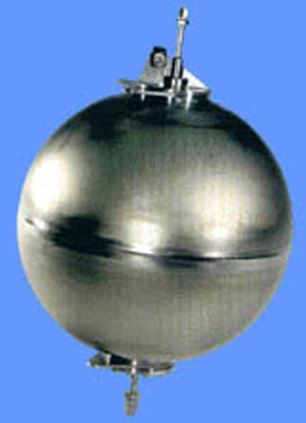
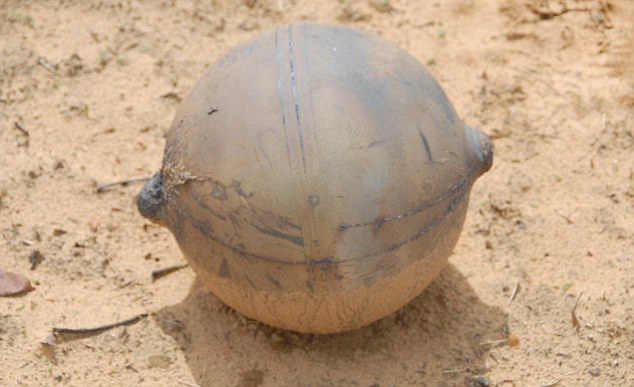
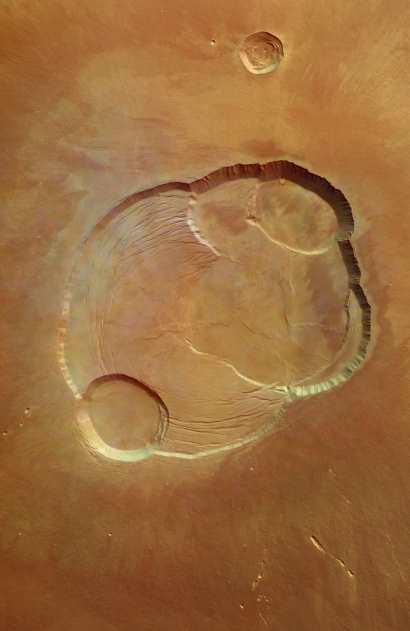
As eight exobiologists wrote in in a white paper submitted to the 2012 decadal survey,Colonization enthusiasts often cite the "Safe on Mars" report as a reason to get a sample from Mars as soon as possible, to prove that any life there is safe for humans. But actually, if you re-read it carefully, "Safe on Mars" recommends in situ exploration as the best way to find out about Mars and prove that it is safe for humans. It only recommends a sample return because it concluded that the technology of the day was not good enough for an in situ search.
"In the worst scenario, we would mortgage the exploration program to return an arbitrary sample that proves to be as ambiguous with respect to the search for life as ALH84001."
More than ten years later, we can now miniaturize many of the machines that required entire labs back then to small chips and machines that require minimal power and weigh hardly anything. These include DNA sequencers, electron microscopes, ultra sensitive biosignature detectors able to detect a single amino acid in a sample, and updated versions of the Viking Labeled release using chirality to eliminate false positives. Our instruments also include the exquisitely sensitive electrophoresis "lab on a chip" methods mentioned by Bada et al. Another new idea is the Solid3 approach of using polyclonal antibodies - which can detect, not just the organics you find in Earth life, but a wide range of organics, again with exquisite sensitivity. This also is a "lab on a chip"."As stated above, there are currently no measurement techniques or capabilities available for such in situ testing. If such capabilities were to become available, one advantage is that the experiment would not be limited by the small amount of material that a Mars sample return mission would provide. What is more, with the use of rovers, an in situ experiment could be conducted over a wide range of locations."
(Page 41 of Safe on Mars)




This is amongst the most earthlike planets found around other stars to date. Though there are surely many more to discover and we know very little about the ones we found so far. As he said in that video, there may be 60 near Earth twins orbiting the 600 stars within 30 light years of Earth. But at the moment they are hard to spot and it’s even harder to tell how closely they resemble Earth.Here are some of our best candidates to date:
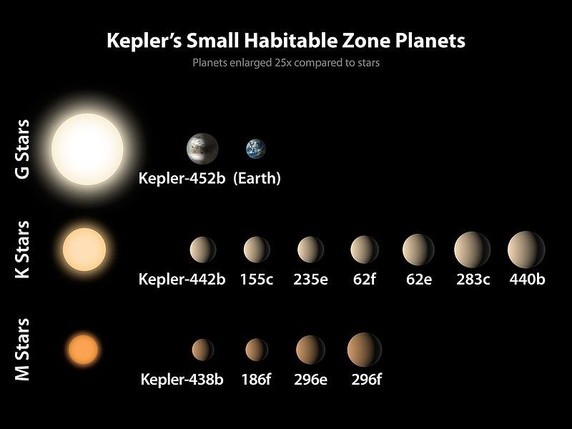


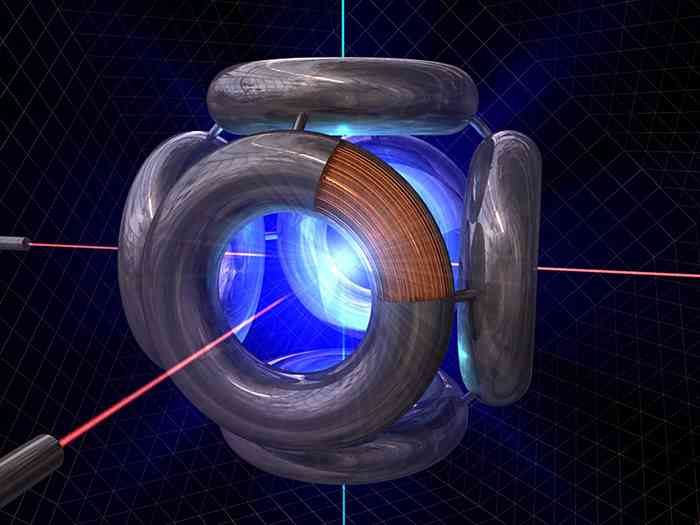
Once we do that, then there is not much to stop the expanding population of humans from filling the entire galaxy by stepping from one Oort cloud to another, from one star system to another. We wouldn’t even need to do decades long interstellar journeys but just hop from one icy body to another setting up habitats in space, throughout the galaxy.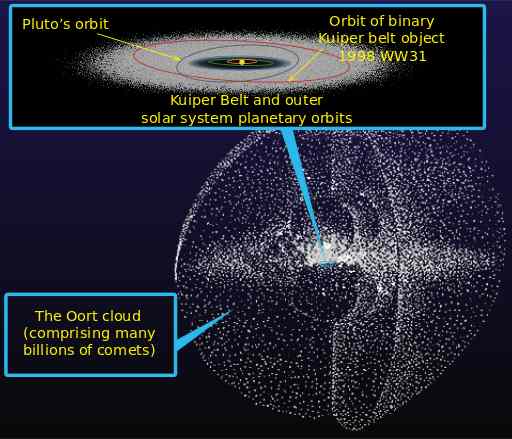
This shows the Oort cloud. If we have easy nuclear fusion power in the future, we could set up home on any of the objects in this cloud which is thought to extend much of the way to the nearest stars and partly mingle with other stars' Oort clouds.
Paradoxically perhaps, I think self replicating robots are far safer for us and the galaxy than humans, because they can be controlled and made safe in ways that are impossible for humans.
This is for much the same reason as sending microbes to uninhabited planets. It's an irreversible thing. As soon as the first space colonies get set up beyond the light speed horizons, out of communication with Earth, then there is no way of reversing this. We'd better be very sure that this is the way we want to go before doing that.
So the robots, paradoxically, are safer for the galaxy, just because we can, ethically, make them completely safe by design. They can be mass produced with identical copies sent to many destinations which can't replicate. Alternatively, we can make self replicating machines, designed with many replication safety restrictions so that they can't be a nuisance to the galaxy (e.g. telomere style maximum number of generations, and a "keep alive" signal from Earth so that they stop functioning and self destruct if they no longer get it).
If there are any wise ETIs, they must find some solution that doesn't involve them or their robots trashing the galaxy. And we must do that too. So whatever filters are behind us, this is a clear filter in front of us, seems to me. The careful robots approach is one way they and we might do it. This is surely one of the safest ways to start galactic exploration, and may explain why we don't find our solar system and the rest of the galaxy already filled to the brim with ETs. They may make similar decisions for the same reasons.
Self Replicating Robots - Safer For Galaxy (and Earth) Than Human Colonists - Is This Why ETs Didn't Colonize Earth?
The anthropologist Mary Dora Russell says:
'Anthropologists used to say that Homo sapiens was a unique and special species because we were the only ones who used tools, or who were self-aware, or had language, or passed culture to our offspring… Then we started finding out that chimps and dolphins and crows and African grey parrots and snow monkeys were making a mockery of our pretensions to uniqueness, so we’ve kind of shut up about all that in recent years.
If you want a nice reductive definition of our species, I could defend this: “Human beings are bipedal tailless primates who tell stories.”
That’s probably just as stupid as earlier definitions, but it’s catchier than my other version, which is
“Human beings are a dangerous, invasive weed species that has invented central heating, air conditioning, and food that can be stored for up to ten years, so not even a direct hit by an asteroid would likely make us extinct.”'
When nothing else matters, by Mary Dora Russell
I think that’s rather how I see the future of us in the galaxy if we just expand into it without foresight. But far worse than a weed on Earth. We’ve unnaturally made ourselves almost impossible to go extinct already by our technology and if we expand through the universe without evolving social breakthroughs of some sort, to catch up with our technology breakthroughs, I think we’ll become the ineradicable weed of the galaxy. But harmful to ourselves as much as to everyone else, and able to create even more dangerous replicators through our technology.
It's not just us. Our galaxy may well contain many non technological species, for instance intelligent fish-like or octopus-like creatures, living in the oceans of icy moons, or ocean planets, where they have no chance to develop control of fire. Or creatures that are just not very strong, and don't have good "hands" like us for manipulation, like parrots or crows. Even an elephant would have a lot of trouble building a fire and smelting metal. Ancient civilizations, perhaps advanced in mathematics, art, poetry, music, perhaps socially very advanced, yet without technology they would be especially vulnerable to a new technological species spreading out of control like an ineradicable weed through the galaxy. Out of all the intelligent creatures on Earth, I think only humans also had a decent chance of developing technology based on fire, even with intelligence. So if that's a good basis for generalizing, then the non technological civilizations universe wide may well outnumber the technological ones many to one. So, even a billions of years old civilization could still be highly vulnerable to a few centuries old civilization of technological ETs such as ourselves, could be.
I think any sensible ET will look at that possible future for themselves and the galaxy, and find a way to become a flower of the galaxy instead of a weed that will eventually choke all the species in the galaxy, including themselves. If they can’t see a way to a future like that, then if they have any sense, they just stay at home until they can. And if they haven’t the sense to do that, I think, perhaps, that they either make themselves extinct, or they keep destroying their own spaceflight capabilities, and get nowhere, until they develop some sense.
We don't need to be a civilization of puffy clouds and rainbows :).

Circumhorizontal arc, in cirrus behind cumulus, photographed in Idaho, June 3, 2006, by Gavin Anderson
Surely amongst the many ETIs (if we do have neighbours) there will be those that are competitive, as with the Olympic games, innovative, eccentric, genius. But we need to find a way to embrace the good sides of those qualities, that which also works in the universe we live in without being a nuisance to ourselves and the other species we share our galaxy and universe with.
Let’s be one of the civilizations in our galaxy and universe that flowers like a beautiful flower.

(click to watch on Youtube)
Or a field of flowers

(click to watch on Youtube)
Or we might even give rise to many flowering human originated civilizations each unique in its way, and all sufficiently in harmony with our galaxy or universe not to be a nuisance to each other or other ancient civilizations in our galaxy.

With billion year lives, our future descendants might be altogether happy with a few hundred billion humans in total in the entire galaxy - especially if we find it has other inhabitants in it also. Say average of one or two humans per star, but of course concentrated in some places, or maybe traveling or exploring the galaxy? If so that might be why we haven't seen ETs yet, because though they are there and are maybe quite widespread through the galaxy, we are due a visit some time in the next million years or so, which to them seems a short time, just a thousandth of their lifespan perhaps, and nearest ones, maybe a small settlement a few tens of light years away. I think that's one possible scenario.
What I am pretty sure of is that any sensible ETI with foresight would not choose to fill the galaxy with unrestricted, evolving self replicating copies of themselves, disappearing beyond the light speed horizon to evolve or to create self replicating machines or modified lifeforms that could turn into almost anything imaginable or unimaginable. Before they do that, if they have any sense, they think through the long term consequences of their actions first, and find a way to do it safely for themselves and for the galaxy.
I think also that the best way to get to a galaxy spanning civilization in the Kardashev scale if we decide we want to, is to go through the earlier stages first. That you can't suddenly jump to a galaxy spanning civilization simply by scattershot sending colonies throughout the galaxy, self replicating robots, cyborgs, uplifted species etc. It might eventually use much of the energy available in the galaxy - but it wouldn't be a galactic civilization; it would just be galactic chaos. I wouldn't call that anything like Kardashev level 3. You probably need something like the Star Trek warp drive, or immensely long lives at the least, or some other galactic unifying element, to have a galaxy spanning civilization.
So, first, before we even become solar system spanning in a true way, we need to be established in our own home planet, as the most hospitable place for humans. If we can do that, then we are established here for at least hundreds of millions of years into the future. If we can't, especially if we destroy our home world in some way or make it uninhabitable, I don't think we have a chance of getting any further, myself.
Then if we have the capability to make efficient use of our sun, that's stage 2 of the Kardashev scale, At that point you are not likely to disappear even when the sun goes red giant and then collapses to a white dwarf - if worst happens you just migrate to a nearby star with that level of technology.
Perhaps it's only when you are at that level and also developed either immensely long lives or warp drive or something of that order, that you are at the point where there is some possibility of going galaxy wide in a way that is safe for yourself and other beings in our galaxy.
There's no hurry here though. Perhaps at least for billions of years the most important thing is just to make sure Earth is safe. We can explore the galaxy with robots. Even without going as far as stage I of the Kardashev scale, with millions of years of future technology development, we'd be able to do almost anything if we wanted to. You don't have to use all the energy from the sun even that arrives on Earth just because you are capable of doing so.
I think there may well be ETs who have the capability even to go right up to the galaxy wide stage 3 civilization using most of the energy from all the suns in an entire galaxy if they so wish, but just choose not to, for various reasons, and stay at an earlier stage, and they might be the wisest and most farseeing of all the ETs. They might be galactic explorers - but see no reason to remodel the galaxy just because it is something they know how to do. And even with a population of many trillions, they could still have minimal impact on the vast galaxy. That might well be through choice, not because they are unable to do it.
An exponential growth anyway can’t keep going indefinitely. It will hit a crunch at some point, indeed very quickly. Even just doubling every century, if we did that for ten thousand years we’d need to create a sun’s mass of humans every century to keep going with the exponential growth. At some point we have to stop exponential growth. Luckily we reached "Peak child" in 2005. The number of children in the world has remained steady for over a decade now. Our population will continue to increase rapidly for a while, because people world wide are living longer (on average). It seems at least possible that our population will level off naturally. Even the “middle of the road”projections now show the population leveling off by the end of the century.

For more on this.
Why ET Populations Can't Continue To Expand For More Than A Few Millennia
Our galaxy could be home for trillions of ETs, and if they have found a solution to exponential growth, the nearest may be hundreds of light years away.
So we may encounter ETIs, but if so rather than living around every star they probably are quite small in number compared to the galaxy as a whole. There is plenty of room for trillions upon trillions of extra terrestrials in our galaxy and yet none within hundreds of light years, if they don’t engage in unrestricted exponential growth but somehow limit their growth - which they have to anyway to avoid what would surely be appalling suffering to have the alternative of constant exponential growth followed by population collapses within an entire galaxy.
"If every civilization that invents weapons of mass destruction must deal with comparable problems, then we have an additional principle of universal applicability. Weapons of mass destruction force upon every emerging society a behavioural discontinuity: if they are not aggressive they probably would not have developed such weapons; if they do not quickly learn how to control that aggression they rapidly self destruct. Those civilizations devoted to territoriality and aggression and violent settlement of disputes do not long survive after the development of apocalyptic weapons. Long before they are able to make any significant colonization of the Milky Way, they are gone from the galactic stage. Civilizations that do not self-destruct are pre-adapted to live with other groups in mutual respect."
He goes on to say that because we have only just reached this stage then this future scenario of mutual respect may seem unlikely because of our short term perspective. He suggests that the required changes may take a thousand years or more, for us to reach maturity as a species. From Carl Sagan's "The Solipsist approach to Extraterrestrial Intelligence",
We’ve prevented starvation with the often forgotten Green Revolution between the 1930s and the 1960s, stopped nearly all whale hunting, done lots of work to preserve species and environments etc. If you compare our present world with what it could have been without all those initiatives - I think it gives room for optimism for the future too. And I think we’ve made an excellent start on peaceful use of space with the Outer Space Treaty.
Although it’s frustrating that we don’t have warp drives or even the Star Trek “Impulse drive”, and easy ways to build habitats in space, I actually think it helps, that space is so hostile. Hopefully by the time we figure out how to live sustainably in space habitats, we also have figured out how to do it peacefully, or reasonably so. With competition of course, but more like the Olympic Games than WWIII. Hopefully we can become more forward looking as we continue to colonize space. Perhaps the increased resources from space can help us to become more peaceful if we can handle it right.
If so we might well eventually have a chance to explore even our entire galaxy peacefully, and without harmful consequences to ourselves and other intelligent species that may exist in our galaxy. And if we meet ETs, the ones that still retain space technology, then they also I think would be ones that have figured out how to explore the galaxy in a similarly peaceful way.
I’m pretty sure there can’t be any aggressive exponentially expanding ET out there (such as we could become potentially) except by some amazing coincidence. That’s because unless they started on their expansion less than a million years ago, a tiny slice of the age of the galaxy, they would have occupied Earth and our solar system already, long before we evolved indeed, probably.
Any ET that managed to expand to a few star systems or to the Oort clouds, also I think can never stop expanding, short of warp drives. That's because if there are any of their species left anywhere in the galaxy that are expansionist, they will start up again, and take over from all the others that give up. How can that ever stop? Even if they started billions of years ago, they would still be at it, I think, even if most of them retreat into Dyson spheres or whatever it is they do, the few who don't would continue to expand through the galaxy.
So any "great filters" have to operate before any ETs out there start on any major push of galactic imperialism.
It's obviously not happened to our galaxy yet, as our solar system is pristine, with no extra terrestrial colonies or robot miners. We don't even have any tracks on Mars or the Moon, so they can't have been visited for millions of years (or the ETIs are very careful about clearing up their tracks when they leave).
I think the most likely reason is either
So, the Moon in this vision is a gateway to the solar system, where we can develop techniques we need, and also at the same time explore a celestial body that is proving much more interesting than expected. By the time I get to the end of that, then it comes over as an interesting and positive alternative. But there are many steps to it before readers can see the vision.
It's a matter of familiarity. We've had decades to get used to the Mars colonization ideas. These ideas I'm describing now may seem unfamiliar, even unlikely and implausible, but give them some time, to think them over, and perhaps you too will find this an exciting and interesting future?
Along the way, settlement is sure to happen. Eventually colonization may happen also. But I'd like to suggest, it doesn't need to be the main driving force behind our space exploration, no more than it is the driving force behind Antarctic study, or exploration of the sea bed and so forth. And that this future with humans working together with robots for remote exploration, our mobile eyes on the solar system and galaxy, is an equally exciting one. And one that is likely to be much more interesting, in many ways than a future where our main motivation for going into space is to turn planets and everything else into the closest possible copies of Earth, or at least, habitats for humans, as quickly as possible. Perhaps this can help towards a future where we can find out and explore first, and learn from this amazing universe we live in.
And also I'd suggest it is more practical, and less likely to lead to disappointment. When you look at Mars and your main thought is "how can I turn this into something like Earth?" you may miss many other possible futures that may be far easier to achieve and may perhaps be of great benefit for humanity in ways you can't anticipate.
If you plan everything out and set a goal to achieve before you know what is there, then your plans may not match the reality, and you may miss out on things that you couldn't plan for because there was no way for anyone to know about them in advance.
So, rather than a grand overarching plan, I think human space exploration has to be flexible, and continually adjusted based on new discoveries. You can do your long term plans, and at each stage we plan carefully for the near future, but you also do many tests and experiments and explore different avenues, because the most likely thing is that we don't know everything yet that needs to be known, so can't plan for the future in detail in space. Our plans are almost sure to need to be changed.
Whatever the commercial or science value of humans in space, it's also a great adventure for humans. We don't need to be ashamed of this. It's one of the things that help humans to venture into the unknown and to try out new things which may be risky, yet turn out to be of great value in the future.
As to how much money to spend to finance such things, I don't know, that's for politicians, but even the ISS cost little when spread over the populations that supported it. $8 per person per year in the US. Think how much we spend on movies, and computer games by comparison. ("Is the ISS the most expensive single item ever built?"). The ISS would be designed differently if it was purely a zero g research lab in orbit (no need to have humans there 24/7), and differently also if it was a human factors research lab. I think the romance of space is a lot of the reason for the ISS design, with humans there 24/7.
Acknowledging this as a motive for ourselves, and also for other space organizations, could make it easier to have more realistic plans. Because then it means we don't have to do grand plans where details are spelt out for decades, to explain why the humans are going there. The early Antarctic explorers didn't have a detailed plan to show how their exploration would benefit humanity in the future. It did, in surprising ways, but they had no way of anticipating that.
Let's acknowledge that we don't know for a certainty if human exploration is the best way to find out about the Moon, or whatever the objective is right now, and that we don't know for sure what the future of humans will be in space, but that it's a great adventure. Also, as with almost any adventure into the unknown, it may be the best way ahead into a future we can't see yet. And if we don't do this, we'll never find out what the role is for humans in space exploration and how they can work with the robots in space.
I say this because it will permit much more open and flexible exploration if we are not required to explain what the humans are doing there and why they are there as part of some plan with every step mapped out for a decade or two into the future. I think the end result of a more flexible adventurous approach like this would be that we find new ways for humans to explore space and may avoid blind alleys that could lead to space exploration stagnating, just because of the lack of some new idea that may make all the difference.
It's impossible for the USA to co-operate with China in space in missions lead by NASA, because of a 2011 bill that prohibits the US from co-operating with China in space, and prohibits NASA facilities from hosting official Chinese visitors. This is due to fears of espionage and China getting an advantage from learning about US technology.
"None of the funds made available by this Act may be used for the National Aeronautics and Space Administration (NASA) or the Office of Science and Technology Policy (OSTP) to develop, design, plan, promulgate, implement, or execute a bilateral policy, program, order, or contract of any kind to participate, collaborate, or coordinate bilaterally in any way with China"
That's why no Chinese taikonauts have ever been to the International Space Station, because NASA is prohibited from inviting them. As a result, China is building its own space station.
There are calls for the US to change its policy towards China, but this may be a long process. John Logsdon of the George Washington University's Space Policy Institute told Space.com:
"It will take presidential leadership to get started on enhanced U.S.-Chinese space cooperation . The first step is the White House working with congressional leadership to get current, unwise restrictions on such cooperation revoked, Then, the United States can invite China to work together with the United States and other spacefaring countries on a wide variety of space activities and, most dramatically, human spaceflight."
A recent report "China Dream, Space Dream China’s Progress in Space Technologies and Implications for the United States" mentions many of the concerns that were behind the US non co-operation with China in space law, but also says that as China increases in space capabilities and uses space more, it also increases in vulnerability too, the more it relies on space assets:
"Although China is probably truthful when it says that it is not in a space race, such statements mask the true intent of its space program: to become militarily, diplomatically, commercially, and economically as competitive as the United States is in space.... As China’s space program increases in capability, it can be expected to wield this power in ways that, according to Bonnie Glaser, not only “persuade its neighbors that there is more to gain from accommodating Chinese interests” but also “deter countries from pursuing policies that inflict damage on Chinese interests.”
"Nevertheless, although China’s space program may pose challenges for the United States and its space power neighbors, it may also present opportunities for scientific collaboration on the Earth’s environment and outer space. In addition, it may make human spaceflight safer by providing additional capabilities to rescue stranded or imperiled astronauts through the use of common docking apparatus. Moreover, what is unwritten in Chinese analyses is that as China becomes more invested in space capabilities it takes on the same vulnerabilities as the United States. Although China would not have the same asymmetries as the United States in a conflict in the Western Pacific, the goal of having a global, 24- hour, all-weather remote sensing capability and spending nearly $1 billion per year until 2020 to establish a global satellite navigation system and associated technologies indicates that China is devoting significant effort and resources to establish a system that is similar in architecture to that of the U.S. military’s space program. With this trajectory, China will have as much to lose as it has to gain from the management or mismanagement of the outer space global commons. It is in this vein that some sort of strategic accommodation that ameliorates the worst effects of competition could be achieved. "
China does have plans to send humans to the Moon eventually. As with the US and Russia in the 1960s and 1970s, its main reasons for doing this seem to be similar to other nations, reasons of national prestige, to show their technical prowess, as advertising for their space technology capabilities and to achieve results of scientific value.
Emily Lakdawalla has a useful summary of past and future robotic Chinese missions to the Moon. Plans include a robotic sample return in 2017 and a mission to the far side (probably) in 2020 (according to Weiren Wu, their chief lunar exploration engineer). That last would be a particularly impressive and prestigious feat for them, as nobody has achieved it before.
Paul Spudis says in his new book (chapter 8, If Not Now, When, If Not Us, Who?) that he considers that the developing Chinese deep space capabilities, to send robotic spacecraft and eventually humans to the Moon and further afield, are a defense issue for the US.
I like much of what he says in the book. But I can't follow his reasoning here. Anything that China can do, the US and Russia could do forty to fifty years ago. If it was a military advantage for China to be able to send it's Chang'e 2 to the L2 position for instance, as he says in this chapter, why doesn't the US have spacecraft there already, to swoop down on geostationary satellites from an unexpected direction in a war situation? So I don't find it very plausible myself that the Chinese deep space lunar and asteroid encounter robotic missions have a military purpose behind them.
We have several civilian spacecraft at the EML1 position at present, including Advanced Composition Explorer, Deep Space Climate Observatory, and the Gaia spacecraft. EML2 isn't used so much, since after all, though as close to the Moon as EML1, there is no direct communication with Earth. I don't think we have any spacecraft there at present (do correct me if you know of any)?
But Chang'e actually went to the Sun Earth L2. That's a natural spot for any spacecraft to go on its way to an interplanetary target, as it is a waypoint on the "interplanetary super highway" - from which it is easy to go to a further away deep space target, such as an asteroid, which is what it did next. I think this just shows that China has an interest in deep space exploration. Similarly India has just sent a spacecraft to Mars, more of a technological challenge than a mission to L2 and an asteroid, but nobody sees this as a military issue.
Some of what they do in space is of course of military significance. Their ASAT test in LEO in 2007 was; definitely. However, the US did an ASAT test in 1985, destroying a defunct weather satellite using a portable missile launched from an F-15 fighter. The US was way ahead of the present day China in these capabilities back in 1985.
I think their motives for deep space missions must surely be the same as everyone else. Nobody else seems to think that their own deep space missions, currently, are of any military significance. Neither the US, nor Russia nor the ESA, nor any of the other space agencies think deep space is of any military value at all. We don't get secret defense payloads launched to deep space (and we'd know about it if there were any, as it is easy to track spacecraft after launch from Earth, by following their trajectory, and even into deep space from monitoring their radio communications with Earth). So why should China?
We do many things that have no immediate economic or practical or defence value. One nice parallel with our space activities I think are the Olympics. These also bring together nations from many different countries in friendly co-operation and competition. Just as China takes part in the Olympics, despite many differences of opinion and concerns about human rights, and so on, let's encourage it to take part in international space ventures too.
The Chinese are interested in collaborating from their side.
Yang Liwei, China's first astronaut said:
“China will not rule out cooperating with any country, and that includes the United States,” said Yang Liwei, China’s first astronaut. “The future of space exploration lies in international cooperation. It’s true for us, and for the United States, too.”
Similarly, Zhou Jianping, chief engineer of China's manned space program, said:
"It is well understood that the United States is a global leader in space technology. But China is no less ambitious in contributing to human development ... Cooperation between major space players will be conducive to the development of all mankind,"
from: China open to Sino-US space cooperation
Though the US can't collaborate with China, without a major political change of direction, Europe and Russia are able to co-operate. and indeed are keen to do so. They already co-operate in many ways.
Johann-Dietrich Woerner, Director General of ESA outlining his vision for the ESA village and Space 4.0 in his visit to China in April 2016 said:
“Let’s open space. Space is beyond all borders so let’s also have the cooperation beyond borders, When you ask astronauts, and I’m sure also the Chinese astronauts will tell you the same: they cannot see any border from space. So this is a very nice vision. We should use this and cooperate worldwide on different schemes, and I think Moon Village has its value for that.”
The ESA village idea is based on many different habitats from different countries in one village on the Moon. Unlike the ISS which is a single facility, it would be possible for China to have its own separate habitat in the village.
For these reasons I think that actually it would be good for the ESA to lead the Moon initiative, at least for as long as the US has this stance on China. The ESA has this capability and also willingness to collaborate with all of the US, Russia, and China. With the ESA leading, then US could, I think, be part of a moon village with China also taking part. That could be an interesting future.
Chinese taikonauts, crew of Shenzhou-10 after 15 days in space. (Credit: CNSA)
Meanwhile, the ESA has put an experiment on the Shijan 10 Chinese satellite, has sent personnel to visit Chinese facilities, plans to send an astronaut to the Chinese space station in 2022, and several ESA astronauts are learning Chinese. It can't invite the Chinese back to the ISS of course because of the US law. But it's a starting point towards greater collaboration in space in the future. Also Sweden (a member state of the EU) will put an experiment on the Chang'e 4 mission to the lunar far side, to measure the solar wind and look at what its role could be in the formation of water at the lunar poles.
The Chinese have also recently signed an international agreement with the UN to open their space station to spacecraft, science experiments and astronauts from other nations around the world.
For these reasons, unless the US change their policy, I think the ESA is the natural leader for future human Moon space initiatives. That's just because if they lead, then both US and China can take part, but if the US lead, China will be excluded. I think that it will help future international relations between countries in space if China can be part of the initiative. Which in turn may make it easier to achieve a peaceful future in space longer term.
So first, some multilateral coordination is possible. From the NASA FAQ:
"Q4: "May I travel to China to attend conferences?"
"A4: Public Law 112-55 states that NASA may not engage in any bilateral activities with China or Chinese-owned companies. However, NASA employees, contractors and grant recipients are permitted to attend some multilateral, widely-attended conferences such the 2012 IAU General Assembly held in Beijing."
Space.com interviewed Marcia Smith, space policy analyst and editor of SpacePolicyOnline.com for an article on Chinese US co-operation. She said:
"The U.S. and China have a complex relationship. It is not like the U.S.-Soviet Cold War rivalry that was driven by military and ideological competition. Today, the U.S.-Chinese situation has those elements, but our mutually dependent trade relationship makes it a whole different kettle of fish."
She told them that the US at times had low-level agreements with the Soviets from the early 1960s on sharing biomedical data.
"But the bold cooperation on human spaceflight — the equivalent of inviting China to join the ISS partnership — waited for regime change," Smith told Space.com "It is U.S.-Russian cooperation, not U.S.-Soviet. Perhaps when there is regime change in China, we will see the same kinds of possibilities emerge."
Until then, "one would hope that low-level cooperation, akin to U.S.-Soviet space cooperation in the 1960s or 1980s, might be possible," Smith added. The law does allow multilateral, not bilateral, cooperation, she said. "The door is not completely shut."
So - if ESA, Russia and China with other partners were involved in a lunar village, then there might be some low level co-operation, and also some multilateral co-operation.
It's a rather different situation from the ISS in LEO because of the geographical nature of the Moon, because there are some geographically comparatively small areas of the Moon of exceptional interest, and because the OST which ensures that no State can lay claim to any area of the Moon as their own.
So, for instance, there's no reason for the Chinese to put their space station in an orbit to give easy access to the ISS and vice versa. But one can easily envision a situation where the US, if they had renewed interest in the Moon, set up a base within a few kilometers of the ESA village near one of the lunar poles. Suppose, for sake of illustration, that the US set up a base just a few hundred meters from the ESA village. That might well happen in the natural course of events, because there are only a few areas, that are especially favoured for solar power, high points that catch the sunlight nearly all year round. Geographically limited a bit like the summit of a mountain. If both examine the Moon to find the optimal place to site a base, then they might end up in the same region even without advance planning. It might be a bit like the US and China both setting up a science station on the summit of Mount Everest.
So for instance, suppose they are both on the rim of Shackleton crater, say, within a few hundred meters of each other. Would the astronauts be able to go over and chat with the ESA village astronauts?Including the Chinese astronauts? Could they land on the same landing pad, an area glassed over to remove dust? What about using the ESA 3D printer, if it was made by a European firm, but also used by the Chinese to apply regolith shielding to their habitat as well?
Also, would US astronauts be permitted to visit the village if they landed on the Moon close to it? You can have lots of different associations from sharing the same power supply and vehicles, 3D printers etc to just being located within a few hundred meters or kilometers for mutual support in the event of an emergency.
I'd have thought that at a minimum they could set up a base within a few kilometers walking or driving range of the ESA village, and offer mutual support in an emergency. And if perhaps not officially, once you have many astronauts there, that they could unofficially visit each other on occasion as individuals. Or is that a step too far?
Also, probably commercial US space could take paying Chinese passengers to the ESA village. So there might well be lots of multilateral co-operation. And perhaps eventually that could lead to the US revisiting their policy on China?
I think an international effort would save money for all concerned and is also much safer and more equitable. It's much like a village on Earth, with a shop, post office, maybe a hardware shop etc.
In this way, the different habitats in the village can be maintained by different space agencies but with shared utilities etc. That's partly why I think the ESA village is one of the most promising of all the human moon mission plans to actually come to something. Why duplicate everything? And the bases need to be close together because of the difficulty of moving around on the Moon and the swiftness with which issues could arise. If the other bases are hundreds of kilometers away they wouldn't be able to share much or do much to help each other in a real emergency, not in the hostile vacuum conditions of the Moon.
If we can co-operate in the early stages, much as we do in Antarctica, not necessarily doing everything together, but in a spirit of collaboration and friendly competition, I think this is the best way to set us on course towards a peaceful future in space. Also, though the peaks of (almost) eternal light are geographically quite small, still, there is plenty of space for an ESA type village and many habitats at each one.
If there are indeed hundreds of millions of tons of ice at the poles (which we don’t yet know for sure), there is plenty there for everyone for the foreseeable future, at least until we get large scale mining of ice from asteroids or comets.
Luckily the Outer Space Treaty is also flexible enough to incorporate many future developments of space law. It rules out any possibility of "stake holding" where countries claim ownership of territories in space, or individuals do so supported by their country. But that's a plus as it means we don't need to be concerned that China, or anyone else, will try to lay stake to some region of the Moon. There are many ideas for adding some form of "space ownership" of assets in space, which are compatible with it, based for instance on the ownership of your habitats, already included in the treaty, maybe accompanied by extra provisions for functional ownership, or based on a controlled safety zone etc.
The details need to be worked out by space lawyers.
The Outer Space Treaty says that “the exploration and use of outer space shall be carried out for the benefit and in the interests of all countries and shall be the province of all mankind”
In the US the idea of relying on free market enterprise in space to benefit humanity is popular. But in Europe there’s more support for something extra on top of that.
We tend to think that all of humanity should benefit directly financially, or in other ways, from the space mining boom (If we have one). This idea is called the "common heritage of mankind" in the Moon treaty. That’s rather a broad statement to make, there are many on both sides of the pond of course with both views.
Anyway I’m from Europe and perhaps this influences my thinking, but I’m very keen on the common heritage of mankind approach. Perhaps it may be interesting to hear why?
One idea discussed on "the conversation" is the idea that space industry could be a basis for a sovereign wealth fund, which could then be used to guarantee a minimum wage world wide, similar to the Alaska sovereign wealth fund, but applied globally rather than to a single country.
That could eliminate the worst of poverty, hunger, access to clean water and sanitation, education etc. world wide. Just a few dollars a week sovereign wealth fund would eliminate a lot of third world poverty and allow small farmers to invest in tools, a bicycle, other things that would transform their future.
Also, if we had a trillion dollar space industry it might be much less of an imbalance if those new trillionaires were balanced by everyone having a guaranteed minimum wage.
This sovereign wealth fund also could be used to support space projects. A trillionaire who has earned their wealth from space might choose to spend it all on a platinum plated house and yacht on Earth. There’s no reason why they would plough it back into space except for their own particular mining operations, likely to be largely robotic. They might be like Bill Gates or Warren Buffet and engage in big philanthropic projects, in medicine and so on. But again they might not. It would all just depend on who they are. That seems too much like pot luck to me, once you start talking about trillionaires rather than billionaires.
While a sovereign wealth fund might be used to fund many projects in space of benefit to all humanity.
Another possibility is some way of ensuring that the space industry provides ways for the poorer countries to get into space and set up their own mining operations - that rather than being squeezed out from ever mining in space by the wealthy countries who get there first, they get assisted to take part in it too.
But personally I prefer the sovereign wealth fund approach. It does work. Norway used it to great success with its offshore oil industry, even though the industry naysayers said it would never work and drive the big players away. But when Norway went ahead anyway and put in place a big tax funding its sovereign wealth fund - there was no shortage of oil companies ready to extract the oil under the new conditions.
Of course, any kind of sovereign wealth tax would need to recognize risks in the early stages. A company that is attempting something that is just on the border of possible should be given all the encouragement it needs, and the last thing you would want to do at that point is a hefty tax or to request them to divert funds elsewhere to support other mining companies. Perhaps it should be tax free initially, even tax breaks from whatever is their national tax.
But once they are up and running and have a healthy balance sheet, then why not tax them, like everyone else, and if so, why not have an element of that tax used for a global sovereign wealth fund?
Or similar, maybe a fund used to combat world poverty, to provide clean water for all, to support worthwhile projects in space, or one way or another, to recognize that the assets in space are the heritage of all mankind. That would certainly have my vote.
But if it is just another industry at a similar level to the others, billion dollars type companies, similar in size to Microsoft or SpaceX, I don't see it as a huge issue either way.
There are many other issues here. For instance what about communally used space assets? Whoever sets up Hoyt’s cislunar tether system would be in a position where they could charge pretty much what they like to use it, way above the actual costs of maintenance. How would that work?
I'm sure there will be much here to occupy space lawyers, economists, and politicians for decades to come. This is an article I wrote about: Will Anyone Ever Own Their Own Land In Space - And May We Get Wars In Space In The Future?
It is a very technical subject and I'm no expert, so perhaps that article is most useful for the links to expert opinion and the questions it raises.
Paul Spudis and Dennis Wingo have presented detailed plans leading up to a human outpost on the Moon and then to a base with a more or less continual presence of humans there. Though they have differences of detail in their visions, they both have the same basic idea, to send robots first to scout out the Moon, and then to set up a human base at one or other of the lunar poles, with much of the early work of constructing the base done telerobotically from Earth.
Both of their visions are based around the idea that it will be easy to extract volatiles from ice deposits in the perpetually dark craters at the poles. And both think that this water will not only be useful for humans in situ, but also help to fuel spacecraft shuttling back and forth between the Moon and Earth, and start a lunar economy based on exports of water and fuel to LEO and to other spacecraft. The main idea here is that it would be much easier to supply water to space from the Moon than from Earth.
Dennis Wingo outlines their similarities and differences here in this review of Paul Spudis's book, "The Value of the Moon". BTW do check out Paul Spudis' beautiful graphic, showing the outline of his vision. Dennis Wingo reproduces it part way down the page in that review.
I'm presenting a more fluid approach here. It starts the same way, scout out the polar ice. But it's not the only thing we can do right now. As well as searching for ice at the poles, which of course we should do, we can also scout out:
We can certainly build a lunar base at the poles, a scientific base for humans. The ice is not really needed for that, if it is the best place to send humans for scientific reasons. The total fuel needed to get to the Moon, including descent to the surface, is similar to the amount needed to get to Mars. And as for the return journey, then the amount needed is small. The propellant needed for the Apollo lunar ascent module was 5,200 pounds, or around 2,360 kg out of the launch mass of the lunar module of 15,200 kg. and ascent stage mass of 4,700 kg. It's very different from Mars, there's not much need really for a "Moon One", analogous to "Mars One", as we can get our astronauts back pretty easily from there.
Their plans may well describe exactly what we do. They are worked out in detail, and if the assumptions they make are correct, and we make no new surprising discoveries on the Moon, then one or the other of these plans may well be the best way we can possibly explore the Moon. It's great to have them worked out in such detail already.
However, we have had so many surprising discoveries about the Moon in the last few years, just from orbit. Given how little explored it is on the ground, I think that it's just a little too soon to commit to detailed plans like that about how exactly humans will return to the Moon. I think that we should do open ended research with robots on the surface for a few years first before we commit to detailed plans for the later stages.
They both have plans for prospecting robots that explore the lunar poles to look for the best deposits of volatiles. Of course we need to do that. But I'm talking here about a more open ended and extensive exploration, not focused only on the places that seem the best places for humans right now. Because we should "expect the unexpected", I think, at this stage.
This might not be a long period of exploration, and the more robots we have, the quicker it would be. But we have done so little direct exploring of the Moon on the surface to date, that surely open ended exploration may still turn up many surprises. The Moon has roughly the same surface area as the US, China and Russia put together, with a varied terrain and many geological features to explore on the ground that we can't study easily from orbit. The volatiles were a relatively recent discovery after all, which changed everyone's ideas about how best to explore the Moon. Perhaps future discoveries may change those ideas again, in detail or dramatically.
This could be done with humans, as with Apollo, but nowadays robots are a much more cost effective way of doing it. They'd be doing open ended scientific research, and along the way also checking out resources for humans, and getting a fuller picture of the Moon. It would also give us an opportunity to study the Moon with the less intrusive robots, before humans arrive with their large rockets, the fuel from those rockets, and the extra organics that will accompany them to all the landing sites they visit. This can give us a baseline, and we can take this golden opportunity of a few years, to study things that we won't be able to study later once the lunar "atmosphere" is augmented by human activities on the Moon - such as water transport in the thin lunar atmosphere.
As an example to show how our ideas change with new discoveries from the Moon, if we'd gone to the Moon in the 1990s, without a preliminary reconnaissance of the Moon first, we'd have used equipment like this to mine lunar oxygen from the regolith.
Unmanned lander goes first with a lunar oxygen production plant/storage facility and a nuclear power reactor
"Two "Loader" bulldozers collect and sort ~500kg/hour of ilmenite-rich lunar soil, which is fed into the LUNOX plant and processed into liquid oxygen propellant. The process is based on H2 reduction of lunar regolith in a fluidized-bed reactor, solid-state high-temperature electrolysis and Stirling-cycle O2 liquefaction and refrigeration"
Exploring in a pressurized rover
Refueling their landing craft.
You can read the details here: Lunar Base Studies in the 1990s 1993: LUNOX. Imagine if we had done that, gone to all the work of building and launching these machines, and then later on, found abundant ice at the lunar poles?
We might have other surprises like this, which we don't know about yet.
This first exploratory robotic phase looks likely to be an international effort, with missions from different countries and from private enterprises adding together to give us a complete picture. And the exiting thing is, that it seems it's really going to happen this time. Starting in 2017, we really are going to get lots of new robotic missions to the Moon. Not just China, though China plan to send missions to the lunar north and south poles in 2017 and to get a sample return from the far side in 2018.
We'll also get several attempts at the Lunar X prize landing on different points on the Moon in 2017, with several confirmed launch reservations, and others expected to follow soon.
Then, astrobiotic, one of the X-prize contenders, offered to carry payloads from other Lunar x contenders on their first mission , offering a price of 1.2 million dollars per kilogram to the lunar surface on their Griffin spacecraft. They have partnered with DHL for the logistics on Earth. They plan to send their first mission to the Moon’s Lacus Mortis region which seems to be the location for a skylight entrance to a lunar cave. Their plan was to run a Formula 1-like race on the Moon between their own Andy rover and the other rovers they carry with them to the Moon (Team Hakuto and Team AngelicvM from Chile) to see who can travel 500 meters fastest to win the lunar X prize (they will share the prize money, whoever wins). However Astrobiotic dropped out of the Lunar X-Prize saying the 2017 timetable was unachievable and now plan to go to the Moon in 2018
With astrobiotic out of the race, Team Hakuto from Japan have negotiated a new ride to the Moon with TeamIndus. I'm not sure what their current plans are but originally their plan was to explore a possible lunar cave skylight with their Moonraker lander (named after legend of English smugglers in Wiltshire, not the James Bond film). This mission is of especial scientific interest and of interest to human exploration of the Moon for the future, whether they do it or not, so let's look at it in a bit of detail:
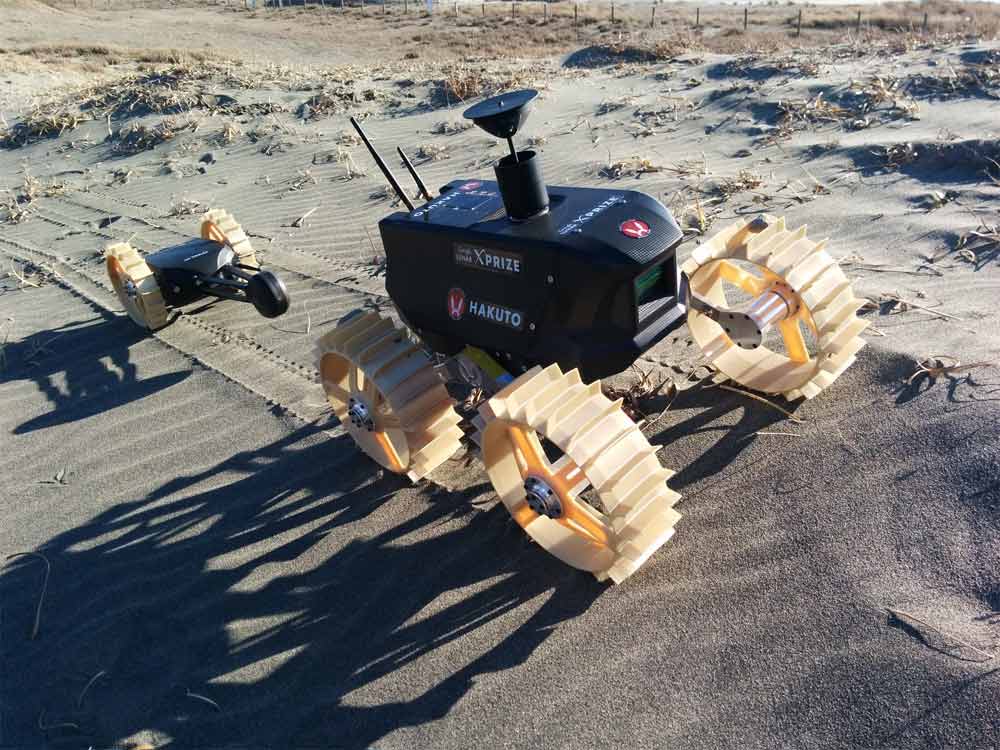
Moonraker, pulling the two wheeled Tetris. After competing for the 500 meters travel time on the Moon for the Lunar X prize with the other rovers brought there by astrobiotics (assuming it's not won already by another lunar X mission), its mission goal is to go on to lower Tetris into the skylight of a lunar cave. The rover has four independently driven wheels (it can also use them to "turn on the spot"). It has four instead of six wheels to give space for larger wheels as this helps reduce slip on steep slope. (Six wheels have advantages for travel over rugged terrain, but for their particular challenge of approaching a lunar cave over possibly steep terrain, preventing slip was more important to them). When it gets to the cave entrance it will use itself as an anchor as it lowers Tetris down into the cave, to explore it.
They plan to target the partially collapsed skylight in the Lacus Mortis region (originally their target was the Marius pit). For details of those features, see the section of this booklet: Example lunar cave skylights - Lacus Mortis, Marius pit and the King-y natural bridge. For details about why the caves are interesting, see Lunar caves and Lunar caves as a site for a lunar base. The team is led by Professor Kazuya Yoshida, designer of the Minerva II asteroid hopping robots for the Hayabusa 2 mission to an asteroid (currently on its way to an encounter in 2018).
The Andy rover (for Team astrobiotics itself) may also include the VESA gravimeter which could explore variation in gravity around the pit and use that to map out any underground voids, which should show clear gravitational signatures if a large lava tube cave exists underground.
They may also include their innovative tetramorph cube rover - a fast and lightweight semi-autonomous folding rover small enough to pack inside the 30 by 30 by 30 cms of a cubesat - and can then unfold and do pioneer exploration to scout out difficult territory that you can't risk exploring for the first time with the main rover. Early prototype of tetramorph unfolding:
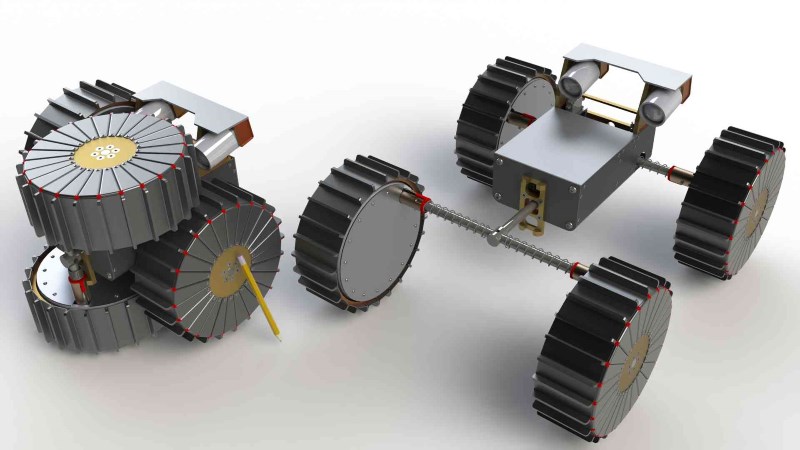
Visualization of tetramorph in folded and unfolded position. See also Tetramorph Avionics: My Experience of Building a Lunar Rover
The lunar flashlight cubesat will launch piggyback on the first SLS "Exploration Mission 1" in late 2018. It will use laser light to look at the permanently dark shadows at the lunar poles to search for volatiles.
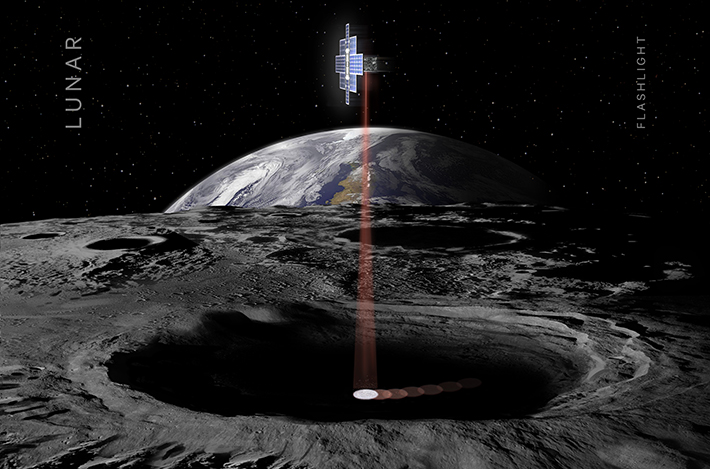
Lunar flashlight - artist's impression
Other confirmed cubesats for the SLS launch include the Lunar Polar Hydrogen Mapper shown above - cubesat from Arizona university to map water resources on the moon - see also the section Cubesat explorers and rep rap printing
NASA is also partnering with the commercial lunar companies like astrobiotic in its lunar CATALYST program. India also plan a second lunar probe, Chandrayaan 2 at the end of 2017 or early 2018 , following on from its successful lunar orbiter Chandrayaan 1. This time it will be a combined orbiter and lander-rover. The rover will be 29 - 95 kg and operate for at least 14 days under solar power. Japan has a plan, not yet approved, to send a lunar rover landing by 2018. Then there's the ESA and Russia's Luna 27 to the south pole Aitken basin, some time in the early 2020s.
So, there's a fair bit of this robotic scouting going to happen anyway. The main idea is to increase the emphasis on this initial scouting phase, and slightly de-emphasize the later plans, for the time being, until we find out a little more.
There is ice at the poles, for instance, the LCROSS impact shows that. But how easy is it to extract it? We might get many surprises. Perhaps with a thorough understanding as a result of these studies, we position a human base a few tens, or hundreds of kilometers away from what seems the most obvious place right no, based on our knowledge to date. Perhaps the best place for a base is indeed on one of the peaks of (almost) eternal light, as Dennis Wingo and Paul Spudis both suggest, and the ESA do also. However, there are quite a few of those peaks at both poles, and the best one in terms of light might not be the best for humans in other ways.
For an example, we don't know yet, but there might be deposits with 100% pure ice or other volatiles, who knows, if we explore enough. Perhaps these are on the surface in some unexpected place, or perhaps below the surface. These might be much better for in situ resource utilization than the obvious first choices based on a few prospecting trips and optimizing for the amount of light available to the base. Perhaps we would need a better scientific understanding of the Moon before we can find them. This is just one possibility.
We may also find sites of exceptional scientific interest that need to be protected. Dennis Wingo spoke about developing the North pole for industrial work, so separated by a lunar diameter from the South pole which is for scientific research. That makes sense on present day understanding, but what if there is some uniquely interesting scientific site at the North pole? Perhaps it might even be the other way around, after we've done the preliminary studies?
So we need to know not just where to locate the base, but where not to put it also. And generally explore anything that's unusual and interesting, as you don't know what it will turn up.
Or we may get surprising discoveries about the lunar caves which make them go to the top of the list. The caves have an even temperature just as for the poles. It's true that the lunar poles are dramatically better sites for solar panels, when you work out the average power generated, as Dennis Wingo shows in his recent paper. But should the amount of solar power available be the main factor for choosing a landing site? It is a factor of course, but solar panels are quite lightweight. When you have a stable surface to spread them out on, as for the Moon, and no weather to disturb them, they can even be thin film, spread over a large area. They can also perhaps be made on the Moon itself.
You can compensate for less power by having more panels - and adding facilities to store the power for the 14 day lunar night. That is definitely possible, using hydrogen fuel cells, or good batteries, or in many other ways. Suppose for instance that some of the lava tube based lunar caves are large enough to fit an entire city inside, with smooth, close to airtight walls, easy to turn into large habitats with natural cosmic radiation protection? That by itself might outweigh the solar power advantages of the peaks of (almost) eternal light. Or there may be resources in the caves that we don't know about yet, or in some of them only, available nowhere else. Also, if there is ice near to a cave, a cave close to the poles say, that would combine the best of both worlds. Or they may have other advantages including ones that nobody has thought of yet.
Also, if we have biologically closed systems, nearly all the water can be recovered and used again just as water. So it might not be so important to have the main human base close to the ice. It might of course be that the best place for the humans is close to the ice, especially if the ice is the basis for an industrial operation that they have to oversee. But again, maybe that's not the best place for them. Maybe the ice has to be kept free of organics for scientific reasons, or even industrial reasons, and that it's best if the humans are some way away from it. Just as a "for instance". Or perhaps, the main base is somewhere else and there is an outpost, only visited occasionally, near the ice deposits.
Or it might be that Dennis Wingo and Paul Spudis are right and that the peak of (almost) "eternal light" with the most solar power is the best place to send humans, and that this also is a place so rich in ice that it will be a source of fuel not just for the Moon but for cislunar space as well.
If so, we might find this out early on. We might find a place that is so good as a base, that we feel there is no need to look any further. But if we base our entire strategy on this, before we know for sure, and then it turns out to be wrong, that could be a huge setback. Also, if it is more or less right but less than optimal, we might miss some opportunity that could have reduced the cost of the human mission considerably.
You could probably go on almost for ever looking for better and better sites for a base. I'm not suggesting that. But I think perhaps a few extra years searching in a more open ended way early on could bring dividends later.
As an example, Russia hope to send humans to the surface of the Moon some time around 2029. If that was the timescale, we'd have about 13 years for robotic exploration of the Moon and more research in LEO before we go there, plenty of time for quite a decent preliminary study of the lunar surface at the rate of several robotic missions a year, which seems quite likely based on the ones already planned for 2017 to 2018. But a dramatic discovery such as thick layers of pure ice at the poles might speed that all up.
However, I'm not saying to stop human spaceflight as we explore the Moon with robotics. Rather, I think we need to be more adventurous with human space flight as well, at the same time. But before we start adventurous human exploration further afield, I think that just as with the early Gemini missions, we need to start being adventurous closer to Earth first.
I think that we need to start working on human factors research. The ISS is not really a human factors research facility. First - why is there so much emphasis on growing food for astronauts in zero g? It's interesting pure research to discover that some plants manage fine in zero g. But as for practical applications, we don't really know whether or not astronauts will typically need to grow food in zero g in the future.
Also the ISS has given us lots of information about the harmful effects of zero gravity on health. Also lots of research into using exercise in zero g to help counteract some of the worst effects. But there's been no research at all into possibilities of using artificial gravity to counteract those effects. Before we do deep space missions, we need to look into this. See my Can Astronauts Spend Years In Space - And How Quickly Can They Recover On Return To Earth? for more details about the motivation for doing this.
We can start research into both of these in LEO.
We can also do biological closed systems research in LEO. See if we can duplicate the BIOS-3 results in space. The experiments in growing plants on the ISS seem to lack an overall direction and focus. I think it is more a case of "we have a facility in zero g, and astronauts in it, so let's see if we can grow food there for the astronauts?"
It's interesting research but it's not so clear that it will help with future deep space missions. Even a very slow spin can give you a hundredth of a g for the plants, which is enough to change the gene expression of every cell in the plant, turning many genes on or off. Within 2 minutes of starting a centrifuge in the ISS, the cells in the plants change gene expression of numerous genes. So when checking effects of various levels of gravity - they have to preserve the cells within minutes of stopping the centrifuge - or actually in the centrifuge. Plants are also sensitive to tiny amounts of gravity. For instance in an experiment with lentil seedlings, they responded to two thousandths of a g, and interpolation suggests they are sensitive to levels of less than a ten thousandth of a g.
In future interplanetary missions, we may spin the habitats and greenhouses with a counter balance using tethers to achieve whatever g we want for the plants. Or we might just spin the growing plants themselves in centrifuges.
A proposal from 2010 explored the idea of a "Farm module" which combined artificial gravity with fish and plants in space.
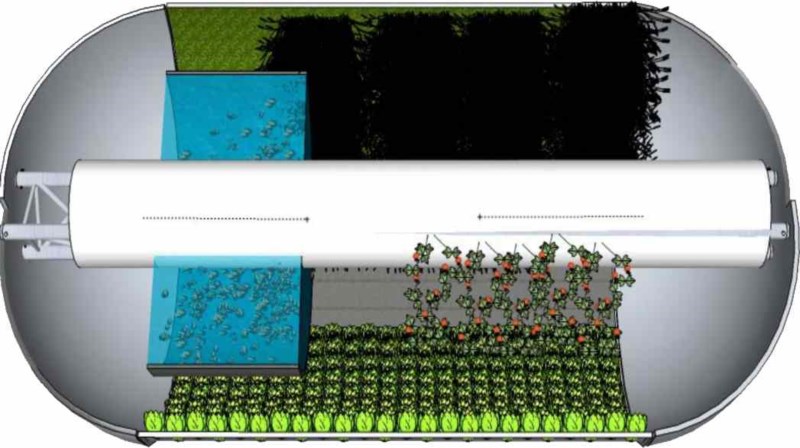
From 2010, this module idea has a rotating cylinder in the center if I understand right. The fish tanks and tomatoes are suspended from it, and then further out you have lettuces shown below and dwarf wheat above.
For the Moon we are particularly interested in how well plants grow at lunar levels of gravity. And also of course, how humans manage at lunar g. Again, there is very little data, just the few days of astronaut EVAs on the Moon, with 1960s and 1970s monitoring equipment. Also, there has been no attempt to achieve almost biologically closed systems in space, where nearly all the food and oxygen for humans comes from plants, even though it has been achieved on the Earth already by the Russians with BIOS-3.
For a lunar base, I think we need experiments in growing plants at lunar g. The obvious place to do that is on the Moon of course, but we can speed things up by testing this right away in LEO, testing long term adaptation of plants and humans in lunar gravity. We will need some kind of base in LEO anyway at some point, if we have frequent missions to the Moon.
We could test humans in LEO in artificial lunar gravity right now, for days. We could set that up probably within a year (it didn't take long to get the Gemini tether experiment together back in the 1960s and we know much more now than they did then). Then we could do more experiments like that for weeks, then longer periods, using existing technology.
We seem to have lost our sense of exploration and adventure in space compared to the spirit of adventure we had in the 1960s. We are no longer doing bold new tests of things that nobody has done before, as they did with the Gemini program - the first EVA, the first tether, the first docking in space etc. It's mainly repeats now, of things done before. Yet there is so much we have hardly even looked at yet. Let's start exploring new possibilities for human spaceflight, which we can do right away, in LEO.
Even with future advances, it's probably safer to do preliminary experimental work of this sort in LEO rather than on the Moon. It's easier also, with a faster turn around time for the experiments, and it's less expensive to do these experiments in LEO rather than to have to go to the Moon. Especially right now when we are still at an early stage of research, and may have many false starts. Doing these experiments in LEO will also mean we can try many other gravity levels, and also learn how to achieve artificial gravity for interplanetary missions. This can go on at the same time as the early robotic exploration of the Moon.
So, I'd follow Joe Carroll's idea of an artificial gravity research gravity in LEO myself. It can start off as simple as just one space module with a counterweight. And indeed the first experiments are even simpler than that. He has been advocating it for years. He's an expert on space tethers and several of his tethers have flown in space. Tim Cole has also shared some ideas on the matter which I will mention here.
And the idea actually dates back to the 1960s. We now know that Sergey Korolev had a plan to tether a Voskhod with its spent final stage which he put forward in 1965-6. It was going to be a 20 day flight to upstage the Americans. It would have included a pilot, and a physician and the artificial gravity experiments would have lasted for 3=4 days during the flight. He died unexpectedly in January 1966 and the mission was postponed to February 1966 then cancelled outright. So we came very close to doing this experiment way back in 1966. (See page 17 of this thesis).
Joe Caroll's idea similarly is to start with a tether spin experiment with a module tethered to its final stage, which goes into orbit anyway. The way he does it, all the delta v put into spinning up the assembly get released at the end of the experiment. This boosts the spacecraft when the tether is released as well as achieving a controlled re-entry of the final stage into the Pacific (at present its reentry is uncontrolled). It uses no extra fuel unless the tether is severed by space debris, which from his experience in improving tether design is now a very low probability event. He would only use the excess fuel carried by the Soyuz in event that more is needed than expected during the launch, and use it only if not needed (usual situation|). This means that the Soyuz would still get to the ISS even in that worst case scenario.
It can be designed to be safe and could be done right away, as quickly as the Gemini tether mission was put together, for a near future crew mission to the ISS. They'd use the longer phasing approach of several days, so you could test several days of artificial gravity. The Soyuz TMA or any other crewed spacecraft can do Joe Carroll's tether spin on the way to the ISS, deliberately use the longer two day phasing approach to get to the ISS and do your first experiments on the way. The cost wouldn't be much as human spaceflight experiments go, just to add a tether to a Soyuz TMA mission that is going to the ISS anyway. They still have the older two day approach as a fallback option so that should be no problem either. They would be able to cut the tether at any time and continue in zero g if there were any issues arising during the experiments.
Though this would be a short experiment, there are many things you can test in a short mission. It would of course test things such as tether dynamics and tether spin up. Also radio communications during tether spins, and orientation of the panels to achieve adequate solar power throughout the orbit.
Also, in particular, it would give us the first real data on spin tolerances of humans in artificial gravity. We don't have anything on that - evidence that astronauts have much higher spin tolerances in zero g than on the ground. Skylab researchers speculated that this might be because the otoliths which sense gravity (as a linear acceleration) along the spin axis on Earth are not stimulated in space. Tim Peake recently demonstrated this anecdotally by tumbling at 60 rpm inside the ISS for a couple of minutes with no nausea and only very momentary dizziness when he stopped. But it's not been tested experimentally in space, neither for long periods of time, nor as an experiment, and we don't even have anecdotal evidence on long duration tolerance of the slower spin rates of a tether spin experiment. (See below Small centrifuge based artificial gravity experiments in LEO )
Also there are immediate changes in physiology, e.g. blood pressure, blood platelet counts etc. and those could be measured and tested under AG. I think it would also be interesting (my own suggestion) to find out if gradual transitions through partial gravity first might help with the space sickness which many astronauts experience for a couple of days when they are first exposed to zero g.
Based on that you could do longer missions later on. But ground experiments can't even simulate AG for a few minutes. To simulate it for hours or a couple of days in space would be a huge step forward for the field.
This video shows a 600 meter tether at 1 rpm joining a Soyuz TMA to its final stage to achieve lunar gravity. Even the most highly susceptible people have no problems with 1 rpm in rotating room experiments on the Earth long term. So probably this would be fine for everyone in space also - that is if the Earth experiments are a reasonable guideline, which nobody knows of course (that's why we need to do the experiment). There are some indications that in space, with spins around a horizontal axis (above your head) and no gravity pulling sideways along the rotation axis, that we can tolerate spins better than on Earth. Though the data is very limited so far.
All these videos are done in Orbiter, a remarkable space mission simulator by Dr. Martin Schweiger with lots of add ons contributed by enthusiasts.
Thanks to Gattispilot, for making the tethers, and for techy advice about how to attach everything together.Note that the video shows an "eyeballs out" configuration. The tests would only go from low g up to full g, but still, this is not the most comfortable orientation for the crew. Joe Carroll's plan is for an "eyeballs in" configuration. It's just that for techy reasons I found it much easier to position the Soyuz in the simulator in this "eyeballs out" orientation . The tether would be brighter than this, and you may notice a cube at the center of gravity of the tether - this is just to indicate where the center of gravity is and would not be there in reality.
NB, there's a detail to be sorted out here - do you deploy the solar panels before or after the tether experiment? If deploy before the experiment, their supports need to be strong enough to withstand the artificial gravity - this is probably easier if the solar arrays are orientated radially to the axis of rotation during the tether spin. This is best if possible as then you have no power limitations for the experiment.
If you leave deployment of the arrays until later - it is a case of how long you can manage without external power for the experiment. You'd be dependent on the storage batteries for power. Early Soyuz spacecraft before the solar power systems had 2 days of battery power. Not sure about the TMA.
Based on these very early tether spin experiments, we can answer basic questions such as, can humans tolerate spinning for two days, and if so what tether length and spin rate is tolerated? (The experiment is designed so it is easy to abort from it at any time - you just cut the tether, and then continue to the ISS). And what are the immediate effects on the human body of artificial gravity? What is the gravity prescription for health (what g level, how many hours a day or do we need it full time) and how easy is it to apply the desired levels using AG?
Another experiment you could do in the near future is a tether experiment launched from the ISS. The crew would take the crew module to the ISS with the final stage still attached. Then to do an experiment, they leave the ISS, fly far enough away from the ISS so that a severed tether won't endanger the station, spin up, do the experiment for several days, then spin down and return to the ISS. This idea was suggested by Tim Cole in 2012.
Based on those preliminary results from the Soyuz TMA, or any other crewed capsule that goes to orbit with a third stage which you can use as a counterweight, you'd work towards designing a larger AG research lab in the future for longer duration studies. It might be based around using the newer modules from the ISS when it is decommissioned, for a hub for spacecraft to dock to and for zero g research, and then tethered habitats for the crew going round it. If it gets more elaborate, perhaps it would also use spent final stages, fitted out in advance as "wet workshops" like the early ideas for Skylab.
This then would create a small facility in orbit. It doesn't need to be a big hundred billion dollar facility like the ISS, just a small space station to start with, which can also be a basis for a staging post in LEO later on. It could also be a facility for research into closed systems, growing plants and so on. It would have a science component of course, like the ISS, but the main objective would be human factors. It would be forward looking, helping us to find out what role humans can play in space in the future. Which of course would have science benefits in turn. Once we know more about what humans can do and how best to support them, we can then send them on science expeditions further and further afield into our solar system.
It could have a zero gravity module attached to the hub. So, there's no reason why you can't combine zero gravity with artificial gravity in the same station.
It would start small, based on this idea that we are still experimenting, and are not yet very experienced in space travel. At this stage, I think we need to try out ideas, and lots of them, to see what works. This could lead to advances that we would never get if we proceed in a linear planned out way with some grand plan for the future, based only on the knowledge we have so far.
So, it is open ended, and low cost (as human spaceflight programs go). It doesn't have to have a continual human presence, unlike the ISS, which is one of the things that makes the ISS so expensive. There's a strong emphasis on closed systems, doing our best to get biological closed systems working in space, which are, after all, a central part of nearly all human space exploration plans further afield, So let's get started on those right away in LEO. If astronauts stay healthy in some level of artificial gravity, and if we can perfect biologically closed systems so that they produce all their own food and oxygen, then you could send them supplies only once a year, perhaps, or less, and then you could start to occupy it continuously. So then the costs would go right down, and typically at least some of the astronauts would stay up there for several years at a time. If you can achieve this much, then you would get a lot of confidence and experience for long duration missions further afield, not just to Mars or Venus, perhaps eventually also to Jupiter's Callisto, and beyond.
See also my Science 2.0 blog posts on this:
This is open research, so we don't know where it is headed. So we should certainly also try small scale centrifuges as well, such as MIT researchers recommended in this paper.
"In order to truly address the operational aspects of short-radius AG, a centrifuge must be made available on orbit. It's time to start truly answering the questions of "how long", "how strong", "how often", and "under what limitations" artificial gravity can be provided by a short radius device."
For plants of course, but also for humans. Artificial gravity was a priority for the ISS up until the loss of Columbia in 2003, first in NASA Ames, then later on the project was passed on to the Japanese space agency, then called NASDA, now called JAXA, who built a Centrifuge Accommodations Module which however never flew because the Space Shuttle was needed to get it into orbit. See page 55 of this paper. Then in 2010 there were proposals to send a centrifuge to the ISS, but it never happened.
We don't know what any of this will be useful for. Perhaps short arm centrifuges turn out to be a vital capability for human health for deep space missions, or perhaps it's the key to health for lunar habitats, or maybe it makes exercise in space much more effective, or maybe it just makes it more comfortable for astronauts in zero g to eat their meals or use a toilet with brief periods of artificial gravity. As basic research, we don't know where it is going until we try it.
It seems that we can tolerate faster spins in zero g than on Earth. Here is Tim Peake spinning at about 60 rpm in the ISS. for a couple of minutes, no nausea, only momentary dizziness when he stops.
He says he is pretty sure he couldn't tolerate that on Earth. So anecdotally it suggests that we can tolerate very high spin rates in zero g. Taking the radius as 0.25 meters at a guess, his head and feet will be both under full g, his torso around zero g as he spins. Could he spin like this indefinitely? If so, it's very promising I think for the use of a short arm centrifuge to counteract health issues of humans in zero g.
He says his "vestibular system switches off" - but that's just an informal theory of an astronaut. We do have a more detailed hypothesis as well - the experimenters for the Skylab litter chair experiment hypothesized that the reason their subjects could tolerate back and forth spins and continuous spins without getting nauseous in space was because the otoliths aren't stimulated in the same way, because there is no gravity acting in the direction of the spin axis.
So first, background information. Our vestibular system is a system of canals in our ear that help us to tell whether we are spinning or stationary. For some reason spinning motions make many humans nauseous. Rats don't get nauseous when they spin so it is to do with human physiology. On page 95 of Packing for Mars, by Mary Roach she mentions that NASA Ames researcher Bill Toscano has a defective vestibular system. He only realised this when they put him on the spinning chair and he experienced no nauseous effects at all from the spinning. So, he at least, could spend 24/7 at 30 rpm for full gravity with no ill effects. The same is also true for some deaf people.
But of course we don't want our space stations to be only usable by some deaf people and others with a defective vestibular system. The vestibular system is not the whole story though. If it was, then conditions while spinning in space would be identical to those on the Earth. But to complicate things we also have the otoliths.
The otoliths are small particles of calcium carbonate in the viscous fluid of the inner ear. They sense linear accelerations, as distinct from the vestibular system which senses spinning motions. So technically, no, your vestibular system doesn't "switch off" in orbit. You can still sense whether you are spinning, but for some reason you don't get sick. That seems to be because of the otoliths.
This is something we can say pretty much for certain as a result of Skylab tests. So now I'll summarize some of the results from Chapter 11, Experiment M131. Human Vestibular Function in Biomedical results from Skylab.
All of this was done to study space sickness, and not to study artificial gravity. Still, it's the only real experimental data we have on artificial gravity too. In the rotating litter chair they tested the astronauts with both back and forth movements and with spinning motions but only briefly for a few minutes at a time, long enough for the astronauts to do 30 - 60 head movements. Many of the astronauts experienced normal zero g space sickness for the first few days of the mission - so these experiments were done after those symptoms dissipated.
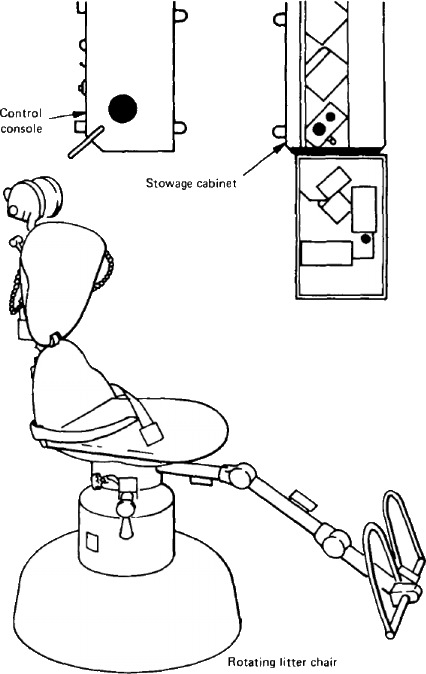
The rotating litter chair used for tests of effects of spinning and back and forth movements on the astronauts in Skylab. It's purpose was to try to understand space sickness, but it also gave our only data so far on effects of spinning motions in space on humans fast enough to generate artificial gravity. There haven't been any follow up experiments on the ISS or MIR or the Chinese space station. So, so far, this is the only data we have on effects of artificial gravity on humans in space..
First the astronauts observations, some quotes from the report, all from (Sec.2,Ch.11)- the M II A end point here is defined as "moderate malaise":
"Preflight, on three widely separated occasions, the M II A endpoint was consistently elicited after 30 to 60 head movements while those astronauts were being rotated at 12.5 r/min (Scientist Pilot) or 15 r/min (Pilot). When rotation tests were carried out in the workshop, both of these astronauts were virtually symptom free; their minimal responses, which were transient, did not even qualify for a score of one point. This was true even when the angular velocities were increased (in two steps) to 30 r/min." (Skylab 2)
It is also noteworthy that both the Commander and Scientist Pilot reported that while engaged in spinning rapidly about their long axes or "running" around the inside of the workshop, they experienced immediate reflex vestibular side effects, mainly "false sensations" of rotation. Based on past experience, both astronauts expected that motion sickness would follow the reflex effects and were surprised by their immunity." (Skylab 2)
- Skylab 2
"Under experimental conditions in the workshop the virtual failure to elicit symptoms of motion sickness in any of the five astronauts who were exposed to a stressful type of accelerative stimuli in a rotating chair (on or after mission day 8) implies that, under the stimulus conditions, susceptibility was lower aloft than on the ground, where symptoms were elicited preflight and postflight. The amount of this decrease in susceptibility could not be measured because the "ceiling" on the test (30 r/min) was so quickly reached." (conclusion)
(Johnston et al, 1977, Biomedical results from Skylab)
So - they tested them up to 30 rpm with no symptoms and couldn't test them at any higher spin rate. They were symptom free in space.
Interestingly the lack of susceptibility to nausea actually persisted for a day or two after the flight. The commander of skylab 3 did experience a "vague malaise" in one experiment at 30 rpm, on mission day 52 which persisted for around 30 minutes, but it was not typical of acute motion sickness and so might have had other causes.
"The Commander was tested in the rotating litter chair on two widely separated occasions preflight and demonstrated similar susceptibility levels each time. On mission days 26 and 41 he was symptom free when rotated clockwise, respectively, at 20 and 30 r/min. On mission day 52 he was rotated counterclockwise at 30 r/min and experienced what he described as a slight vague "malaise" that persisted for approximately 30 minutes following the test. The question arises whether secondary etiological factors accounted for both the appearance and nature of this symptom, which is not typical of acute motion sickness, or whether the astronaut was not quite adapted to counterclockwise rotation. Postflight, the Commander was symptom free on the day after recovery when he executed head movements with the rotating litter chair stationary and on the second day postflight when it was rotating clock-wise at 15 r/min. On the fifth day postflight an endpoint was reached that approximated his pre-flight susceptibility level."
(etiological here just means"causal")
The data in their tables is very striking. Here are the results for Skylab 4 for instance.

There, MIIA is a level of mild malaise. During tests at 30 rpm then the astronauts experienced no symptoms at all in zero g, in experiments that evoked symptoms of mild malaise both before and after. They don't say how long the experiments were in minutes, as the results are expressed in terms of the numbers of head movements made.
So why did this happen? Our otoliths are separate from the vestibular system. Instead of sensing turning motions, they sense linear acceleration. In any spin on Earth you have these two things at once - the spin sensed by the vestibular system, and the linear acceleration due to gravity along the axis sensed by the otolith system. They concluded that the reason the astronauts did not get nauseous while spinning was because the otolith system was abnormally stimulated in space and had almost no influence on the vestibular canals. You might think that would make the astronauts more sick, but actually it turns out that the otolith system is part of what makes us feel nauseous and with it almost completely disabled in zero g, we no longer experience nausea in conditions that would make us nauseous in space. They conclude this by a process of elimination, since the vestibular system is stimulated in the same way but the otolith system is not, so it's the only thing that has changed in zero g.
So, let's look at this in a bit more detail. For those interested in the techy details I'll include quotes from the report, but I'll explain them in less technical language, so you can also just skip the quotes and go to the non techy summary after each one. So first, on, the otoliths
"The rotating litter chair was used in the stationary as well as the rotating mode. In the stationary mode when head movements were executed aloft, the canals were stimulated in the same way as on the ground, but the otolith organs were stimulated in an abnormal manner because the impulse linear accelerations generated were not combined with a gravity vector as they would have been on the ground. These impulse linear accelerations were transient but well above threshold for stimulation of the otolith receptors. When the rotating litter chair was rotating, the intensity of the stimuli generated by head movement was a function of the rotational velocity, and although the angular and crosscoupled angular accelerations stimulating the semicircular canals aloft were the same as on the ground, the impulse and Coriolis accelerative forces generated aloft were not combined with a gravitational vector. These forces, nevertheless, were substantial at all levels of angular velocity used, and at 30 r/min the centripetal force was, respectively, 0.3 g and 0.6 g at radii of 1 and 2 feet."
(Johnston et al., 1977, Biomedical results from Skylab : 78)
So, the canals were stimulated exactly as on the ground but the otoliths were stimulated in an abnormal manner in zero g. The main difference in space is that there was no gravity acting along the spin axis towards what on Earth would be the ground - this is what they mean by the "gravitational vector"
..."Loss of the g-load would affect the "modulating influence" of the otolithic system. If the otolithic influence was inhibitory the responses elicited by stimulation of the canals are said to be "exaggerated" (ref. 30). The observations bearing on this point in parabolic flight, however, indicated reduced responses to canalicular stimulation (refs. 31, 32, 33) during the weight-less phase."
(Johnston et al., 1977, Biomedical results from Skylab : 86)
So - the "moderating influence" of the otolithic system is different in zero g because of the abnormal way it is stimulated. If in normal use the otolithic system had a "modulating influence" then you'd expect this to make things worse. But instead it seems that the effect of disengaging the otolith in this way actually lead to much less motion sickness while spinning, not more of it.
..."The difference in susceptibility between workshop and terrestrial conditions is readily traced to gravireceptors (mainly in the otolith organs; touch, pressure, and kinesthetic receptor systems possibly contributing) for the reason that stimulation of the canals was the same aloft as on the ground, and visual inputs were always excluded. If it is assumed that the otolith system is responsible, then the absence of stimulation to the otolithic receptors due to gravity must have a greater influence (tending to reduce the vestibular disturbance) than the disturbing influences of the transient centrifugal linear and Coriolis accelerations generated when head and trunk movements were executed in the rotating litter chair. Al-though these transient accelerative forces, as pointed out in the section on Procedure, are substantial their effectiveness as stimuli are virtually unknown. The otolithic zonal membrane has considerable mass, and transient accelerations lasting fractions of a second might have little or no effect. The absence of gravity, causing what has been termed "physiological deafferentation" of the otolith receptor system, would be expected to reduce not only the indirect modulating influence of the otolithic system on the canalicular system but also its opportunity to interact directly with this system"
..."The difference in susceptibility between workshop and terrestrial conditions is readily traced to gravireceptors (mainly in the otolith organs; touch, pressure, and kinesthetic receptor systems possibly contributing) for the reason that stimulation of the canals was the same aloft as on the ground, and visual inputs were always excluded. If it is assumed that the otolith system is responsible, then the absence of stimulation to the otolithic receptors due to gravity must have a greater influence (tending to reduce the vestibular disturbance) than the disturbing influences of the transient centrifugal linear and Coriolis accelerations generated when head and trunk movements were executed in the rotating litter chair. Al-though these transient accelerative forces, as pointed out in the section on Procedure, are substantial their effectiveness as stimuli are virtually unknown. The otolithic zonal membrane has considerable mass, and transient accelerations lasting fractions of a second might have little or no effect. The absence of gravity, causing what has been termed "physiological deafferentation" of the otolith receptor system, would be expected to reduce not only the indirect modulating influence of the otolithic system on the canalicular system but also its opportunity to interact directly with this system"
(Johnston et al., 1977, Biomedical results from Skylab : 88)
Because the stimulation of the canals is the same in space and on the ground, then by a process of elimination, it must be the difference in stimulation of the otoliths that made the astronauts less susceptible to motion sickness. The membrane around the otolith has a lot of mass which reduces the effect of sudden short accelerations. Because of the absence of gravity,which disables most of the influence of the otolith system, what they call "physiological deafferentation", then the otoliths not only have less effect on the vestibular canals, they also are less able to interact with them.
I suggest it should be a top priority to research this further, and find out what is going on, test it for longer periods of time, test it for higher spin rates. It shouldn't just be something that astronauts do out of curiosity and fun. Someone should be measuring and testing them, and finding out why they have such high spin tolerance in space and what its limits are (if any)!
And then based on those results, the next step would be to see if it can be used to generate artificial gravity and perhaps prevent deterioration of health in space. We need to find out what effects these spin motions have on health. I think this seems very promising for the possibility of short arm centrifuges dealing with issues of human health in zero g.
From the data so far, it seems almost certain that astronauts could withstand a few minutes of Artificial Gravity (AG) in a non zero g centrifugal toilet for instance. Zero gravity toilets are tricky to use. Also what about while eating, another thing that becomes much harder in zero g - but if they don't get nauseous then why not eat while spinning too? And what about sleeping? Could they tolerate eight hours of AG while asleep? And during exercise? And if they had AG during all those activities, then what effect would that have on their bodies, would they avoid most of the effects of zero g? Might it actually be healthier even to change between zero and AG back and forth every day? What level of AG is needed etc?
There are bound to be some effects. The cells of plants change gene expression of numerous genes within two minutes of the centrifuge starting. To check effects of artificial gravity on plants they have to preserve the cells within minutes of stopping the centrifuge - or actually in the centrifuge. They are also extraordinarily sensitive to minute levels of gravity. In an experiment with lentil seedlings, they responded to two thousandths of a g, and interpolation suggests they are sensitive to levels of less than a ten thousandth of a g.
Humans have many physiological changes right away when they enter zero g. As with the plant cells, these effects are almost instantaneous. You get them even in hyperbolic zero g test flights. Their average blood pressure in the arteries (mean arterial pressure) decreases right away to below what it is even when lying down (though later it increases in a long duration zero g flight, then adjusts in the opposite direction with higher heart rate than normal on return to Earth for up to 15 days).
So, there are bound to be easily measurable changes in the astronauts' physiology immediately when they start spinning in zero g. Tim Peake's body must have responded in numerous ways to those spinning motions. But we don't seem to have any experimental data on this yet.
These "short arm centrifuges" don't need to be big heavy machines as they are on Earth. Here they have to be strong enough to hold up the weight of a human along the spin axis ("downwards" on Earth) as well as exerting a similar force towards the spin axis for the artificial gravity. But in space, they can be as simple as a hammock in structure, because they only need to hold the weight of a human in one direction only - away from the spin axis. They don't need to be rigid structures either. Like a small version of the fairground swing rides - except that with no gravity along the rotation axis, the swings would just hang out horizontally.

My rough diagram of a small version of this inside a space station is like this:
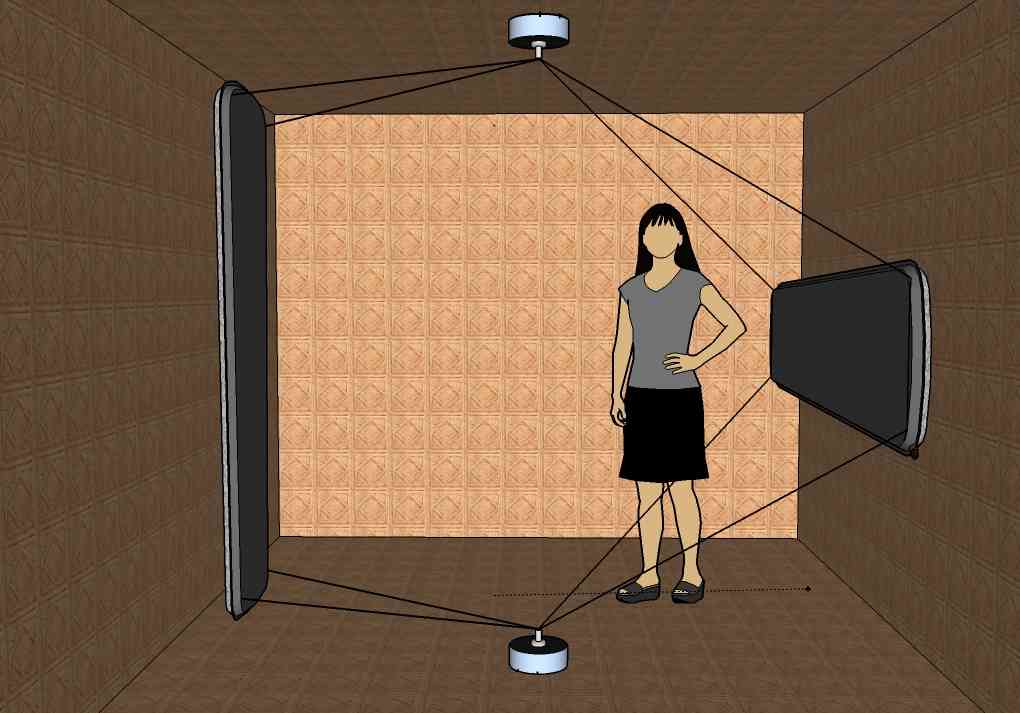
Sketch to show two possible orientations for a spinning hammock inside a large space station module. To prevent this from spinning up the station, then there'd be a counter rotating weight automatically spun in the opposite direction to the astronaut, perhaps attached to the "floor". The motors would not need to be powerful in zero g. It's like spinning a cycle wheel - easy to spin up, and you could stop it just by putting out your hand.
For a very small one meter diameter centrifuge like this, you can achieve full g at 30 rpm and with the astronauts moving at only a little over 3 meters per second so it is very safe. That's around seven miles per hour - faster than a jog, but easy running speed so it's not that fast (a little faster than the average speed for the London marathon). For more about it see my Could Spinning Hammocks Keep Astronauts Healthy in Zero g?
Idea for early short arm centrifuge experiments in LEO.
And here is a 2011 idea for a 1.4 meter radius centrifuge to be located in the permanent multipurpose module:
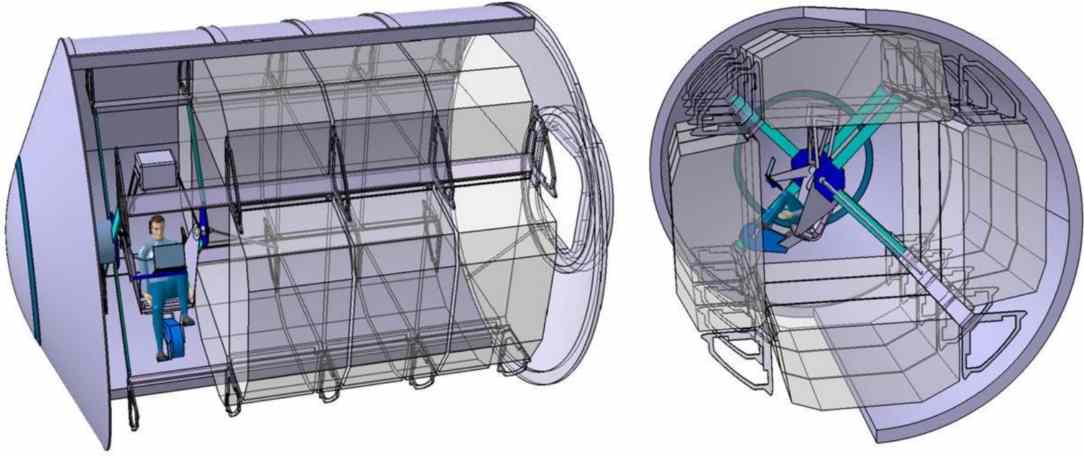
Sketch of the AGREE centrifuge for the ISS. From page 15 of Design and Validation of a Compact Radius Centrifuge Artificial Gravity Test Platform. It would have replaced the four racks at the end of the Permanent Multipurpose Module. Astronauts would cycle in a seated position. This is one exercise excellent for health which you can do with an extremely compact radius centrifuge like this. Chris Trigg concludes: "Given the compact design, subject positioning, available sensors, tested accuracies, and validated operations, the MIT Compact Radius Centrifuge represents one of the most unique yet realistic centrifuges currently in available for artificial gravity research. It is hoped that through these future studies the MIT CRC will provide a better understanding of the effects and capabilities of an inflight-centrifuge, and perhaps contribute in some small way to progressing towards the inevitable trip to Mars. "
a sketch for a human powered artificial gravity in the ISS .
NASA also took out a patent on the idea, here is a drawing - it's for two cyclists, powered by either one or by a third cyclist outside the centrifuge
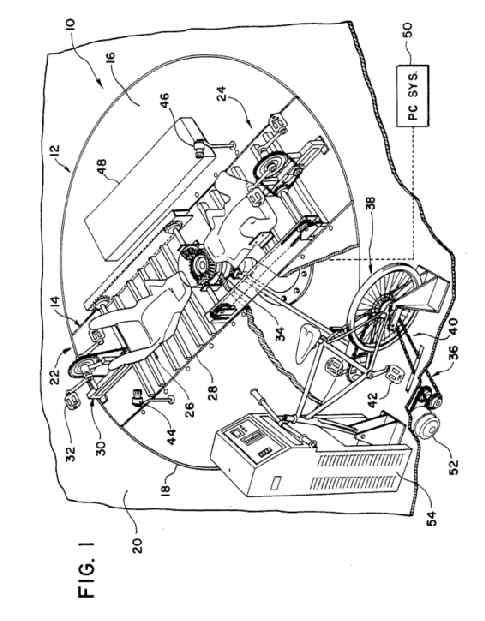
And this shows it in experimental use on the ground. It's never flown in space.
The ISS is so full of equipment, that it would be hard to find a space for even a small centrifuge now, although the modules themselves are easily large enough for it.
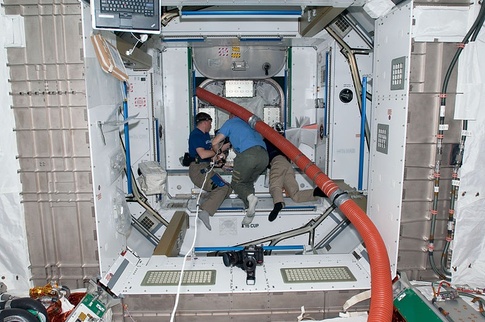
Inside the Tranquility module when first installed - with a diameter of 4.48 meters, there is enough space for a small centrifuge, but you couldn't do it now with it lined and full of equipment.
Perhaps a very small scale experiment of this type could be done in the new largely empty BEAM inflatable module in the ISS or some future inflatable module?
Beam module expansion Progress The inflatable beam module. Internal diameter is a little over three meters. Though it's smaller than the ISS modules, it is also nearly empty.
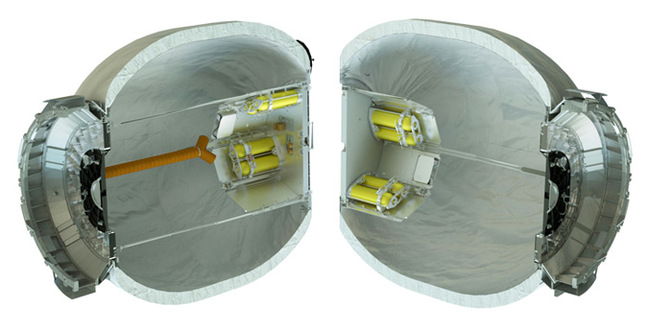
Cutaway diagram of the BEAM module now attached to the ISS (credit Bigelow aerospace).
It's a bit small inside, but apart from those four obstructions near the center there would be enough room for a small hammock style centrifuge, with the astronaut reclined to one side of the axis, as in a hammock, for first experiments in effects of artificial gravity on humans in space. It's also large enough for the MIT compact centrifuge / cycling exercise machine described by Chris Trigg.
If we can't do it within the current ISS, it's certainly well within the possibility for future space stations or modules, for instance any of the larger Bigelow modules if placed in LEO would have plenty of space for an artificial gravity centrifuge.
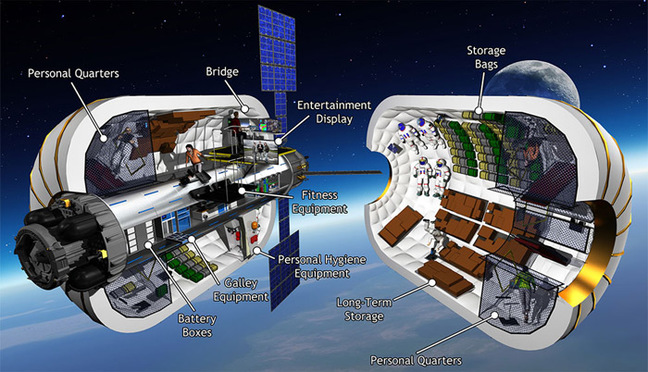
Cutaway image of the much larger B330 credit Bigelow aerospace. There's plenty of space for a large centrifuge here.
Indeed, though I hope the main aerospace agencies will do these experiments in the near future as they move towards deep space missions and the return to the Moon, if they don't, I wouldn't be surprised if private entrepreneurs explore it instead. For instance artificial gravity for toilet facilities or for eating and drinking could make space hotels much more convenient for tourists, so surely they will explore that if we have space hotels in the future. And if artificial gravity helps to keep the tourists healthy on return to Earth, able to stand immediately on return to Earth for instance, again that's a strong incentive for artificial gravity sleeping or exercise artificial gravity in space for medium duration tourist visits. Also artificial gravity could help prevent space sickness in hotels for tourists too.
NASA has recently been tasked by Congress with spending at least $55 million by 2018 on a "habitation augmentation module" that could be used in cislunar space and eventually for journeys to Mars. So I wonder if there is any possibility of a centrifuge for that?
The idea of using a small arm centrifuge in space instead of a large tether has some advantages in LEO, if it works
Then, depending on what the reasons are for extra spin tolerance for astronauts in zero g - the same thing might well work in lunar gravity too. For instance if it is due to conflicting sensations between the otoliths and the vestibular system, the astronauts would sense much reduced linear acceleration along the axis, not quite zero, but small compared to the level of artificial gravity perceived from the spinning motion. Could that mean that you can tolerate rapid spins in a lunar habitat too just as you can in the ISS, or perhaps intermediate between zero gravity and Earth gravity in tolerance? There's no way to know except by experimenting and researching. And whether it works for humans, it would also be an extra tool in our toolkit for other things, for instance some plants may do better with extra g even in lunar gravity.
However the least cost way to get started on this is in LEO first. We could do that in the very near future if there was the interest in doing it, and develop the understanding and ideas we need to then design the follow up experiments for the Moon. Then finally, we can design habitats for humans and greenhouses for plants on the Moon using the results of all this research. Again this could go through very quickly, a few years at most to get the early LEO experiments underway, if there was sufficient funding and interest in it.
Again this is a situation where a process of open discovery and development could lead to much better designs for lunar habitats than a "design it all first" approach. Perhaps the first habitat on the Moon should be an experimental module to test various ideas for closed systems and artificial gravity and human and plant tolerance of lunar gravity before we progress to build an entire village there.
For ideas for augmenting lunar gravity using centrifuges see my earlier section above: Artificial gravity on the moon to augment lunar gravity
See also my
Once the lunar mapping and research phase with robots is done, which might happen very quickly, only a few years with small capable rovers and satellites Google X prize style - then you start thinking about where humans would go on the Moon and what their role would be.
You could wind down the Artificial Gravity and biological closed systems labs in LEO at this stage, if we know the answers to the main questions already. We use the results of their research to design the habitats on the Moon and at L1 and L2 etc. Or the LEO lab could be retained as a staging post for missions to higher orbits. and the Moon when needed, or for continued AG research.
I'd see all this as costing less than the ISS to keep going, once the ISS ends, so it shouldn't impact at all on robotic exploration of the solar system. That's because the facilities are capable of running themselves without humans on board, controlled from Earth. Humans go there for weeks or months at a time first, then they are only occupied 24/7 by humans once you have closed systems working there, so much reduced resupply from Earth.
So, meanwhile we continue robotic missions to Mars, but also to many other places. The robotic exploration perhaps can step up even, since now it would be seen as part of the human exploration, on the Moon, and further afield. It might start to pay for itself as well on the Moon.
And if the humans on the Moon only need supplies once a year or less frequently, again it would probably cost less than the ISS to keep a lunar facility going, once it has been constructed, as it's the supply missions that are the biggest ongoing cost. We could run both the lunar base and the AG lab in LEO at the same time, for less cost, perhaps, than the ISS alone. So this period of time in LEO refining biologically closed systems and working on Artificial Gravity would lead to dividends later on as we design habitats for the Moon and then further afield.
Then building the lunar base would involve ISRU so again it might be easier to build than the ISS was. Meanwhile you have the private space industry, tourism etc. developing which could lead to many facilities in space that are designed for tourists, but can also be used by astronauts or are jointly run by tourist companies and space exploration companies / government entities funded as basic research.
And maybe by this time we have commercial resource utilization already too. If along the way you find that there are those resources on the Moon of commercial value, then it might be that humans on the spot are useful, and could be sent there as a natural part of commercial development. But if it costs less to extract the ice with a purely robotic facility, that might undercut a facility manned by humans. I think we might end up with some optimal mix of humans and robots at this stage.
So then, after a few years of exploration from Earth, when humans go to the Moon, they would have a whole network of robots on the surface that they can control via close telepresence and lunar communications satellites as well. This would also give us valuable experience for exploration of the solar system further afield. As well as that, the work on sending many robots to the Moon would mean that we have learnt a lot about the best and most mobile designs for them, and dealt with bugs such as the Chinese rover that couldn't furl its panels at night. By then, these lunar robots will be robust, mobile, semi autonomous and easily controlled. So it will then be much easier to build the human base from Earth via telepresence, and the robots will be much more capable tools for the humans on the Moon to control.
There are many dangers in any space walk on the Moon, including hazards of falling over and damaging your spacesuit (which could kill you), also the solar storms and cosmic radiation. So, I expect that most future exploration will involve controlling rovers on the surface via telepresence, or exploring the surface in enclosed rovers. There wouldn't be so much by way of EVAs by humans on the surface of the Moon as in Apollo, though of course there would still be some of that.
In this vision, one advantage of the caves idea (if those large lunar caves exist) is that you'd end up with a much more spacious habitat for humans to live in, easier to "build" than a city dome, which could be a plus if it turns out that they don't spend that much time on the surface. They could enjoy the lunar gravity inside the caves. Indeed, eventually, with kilometer scale caves filled with breathable air, they could explore the dream of human powered flight and lunar gravity athletics as well :). And as with the Stanford Torus ideas, they could have habitats with plants and so on inside the caves.
So, this is just a draft idea of how it might continue. In the spirit of this approach, we'd need to be ready to adapt it quickly and change plans depending on what we discover along the way.
We might find out something early on that makes either the poles or one of the caves an obvious first site for humans on the Moon, and go there earlier. We might also do early human missions to the Moon to test systems to use later on. Also commercial space may do it for adventure and tourism. Space Adventures have already advertised to tourists for the idea of a mission to fly around the Moon and back to Earth. It doesn't seem that it is going to go ahead quite yet, but we may see private missions like this in the future.
There's no reason why we can't have missions like this, and countries that have never sent astronauts to the Moon, including Russia, China, ESA, etc. might be keen to do this at an early stage to show that they can do it. The closed systems recycling is not needed at all for short duration missions to the Moon of up to a couple of months or so. (More on this in the section below, and see the conclusions, break even for recycling after a couple of months or so). So, this is not like a prescription to say we shouldn't do that :). It's just a case of taking the long view and showing what that turns up.
For more about the ideas for artificial gravity research in this section see my
For more about the BIOS-3 results and other ideas for ways we can achieve biological closed systems in space, see
Although most of the focus here is on the Moon as our most likely first destination, I think I should just digress for a short while to talk about mini moons and quasi-satellites of Earth, a rather surprising recent discovery in Earth Moon space. Also I'll look at the asteroid redirect mission which has been subject of so much study recently.
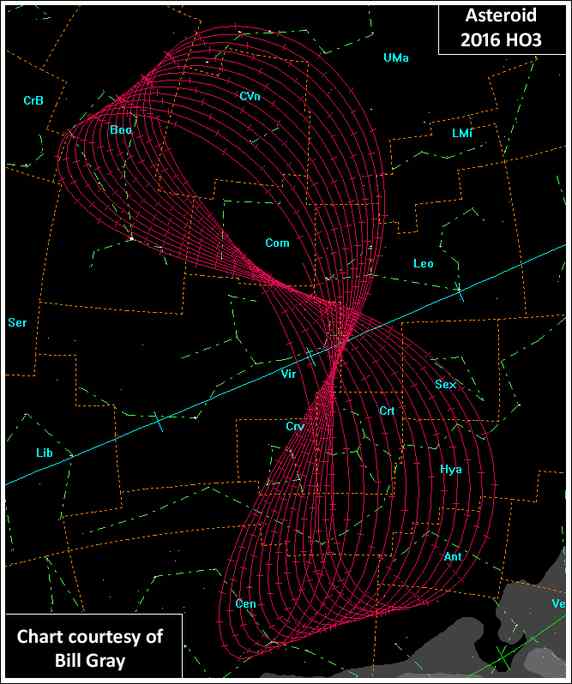
Earth's first 'quasi-satellite' identified
That seems bizarre at first, but think it through. It’s in a one year orbit around the sun like Earth and it's orbit has the same semimajor axis as Earth (by Kepler's third law that the period depends only on the semi-major axis and since it orbits the sun exactly once a year). So, if at some point it is between Earth and the sun, then half a year later, it’s going to be further away from the sun than Earth. That makes it still in the same direction in space from the Earth.
So - it’s a bit strange to call it a moon since it’s always in the same direction from Earth. But on the other hand, each year it crosses the Earth to Sun line twice, so in that sense, it sort of is in an orbit around Earth, but only in a rotating co-ordinate system.
This shows its orbit though not so easy to follow what is going on as its orbit is so unusual, this is in a rotating frame so with Earth stationary and from this point of view it seems to “orbit” Earth. It’s inclination is not as huge as it seems in this video, it’s inclination is only a bit over 7 degrees so it is pretty much in the same plane as Earth’s orbit:
The NASA announcement is here: Small Asteroid Is Earth's Constant Companion. The Wikipedia article with more details is here: (469219) 2016 HO3 and see also Surprise! Newfound Asteroid Is 'Quasi-Moon' of Earth
It’s about 5 km / sec delta v to get to it from Earth in an energy efficient orbit, and about 1 km / second to get back to Earth, relying on aerobraking in the Earth’s atmosphere. NHATS Object/Trajectory Details. It's
Could we do anything useful with it? Assuming two metric tons per cubic meter for a very rough idea, and diameter 40 to 100 meters as they suggest, that would be . between 2.26 million tons and 8.38 million tons so it's a lot of material. By comparison a Stanford Torus requires 10 million tons. So you could do a fair bit with it, depending what it is made up of.
If it has useful resources then you could also supply them to LEO or to the Earth’s surface using that 1 km / sec return trajectory with aerobraking. If it is an iron meteorite, you could mine it for the metals and return them. But we don't know what it is yet, could be a source of volatiles also. Might be useful in some way. If nothing else it could be useful for shielding for a spinning space habitat if there was a reason to build one there.
Or perhaps it is useful where it is at some point? Or just of scientific interest.
Also, I wonder if it could be the first of many smaller objects in similar orbits. At any time the Earth probably has at least one asteroid of diameter a meter orbiting it and probably many smaller ones
Path of a simulated mini moon. It approaches Earth along the yellow path, orbits it in this complex fashion for a number of "orbits" then escapes into interplanetary space again along the red line. At any time Earth probably has at least one asteroid of diameter a meter or more in an orbit like this, along with many other smaller "mini moons". The inset shows 1999 JM8 which is much larger than any of the expected mini moons, just included because the smaller mini moons are expected to look much like their larger cousins, only smaller. From: Simulations Show Mini-Moons Orbiting Earth
We actually know of one mini moon that's done this sort of thing, 2006 RH120 which is 2-3 meters in diameter and orbited Earth for three quarters of a year from September 2006 to June 2007. At it's closest, on 14th June 2006, it was 275,000 km from Earth, or about 71.5% of the distance to the Moon. At first it was thought to be a piece of lunar hardware but the observations weren't consistent with that. Bill Gray suggests it might instead be a piece of lunar rock ejected by an impact because it would be hard for a normal asteroid to lose so much energy relative to the Earth and Moon to get into such an orbit, while it would be easy for a rock ejected from the Moon to get into it. Assuming a density of 2 tons per cubic meter, then it could be up to 28 tons of material. A one meter diameter mini moon would be approximately one ton of material if of the same density. So a rather small amount of material.
I wonder if Earth has a cloud of these more distant moons as well?
Anyway this leads on to the asteroid redirect mission. This is a mission proposal by NASA which, if I understand right, they came up with basically because the Obama administration tasked them with sending humans to Mars but without going back to the Moon. Since a mission to Mars would be a long and dangerous mission, they needed something safer to do closer to home first to test the systems. So they came up with this idea of sending humans to a nearby asteroid. The problem is that even near Earth asteroids are not easy to get to as they only do occasional flybys of Earth, perhaps every decade or so. So you have a small window of opportunity to get there and back unless you are prepared to wait on the asteroid for a decade before it comes back to Earth's vicinity again and even those missions are long duration for our first flight beyond LEO for decades.
So then they came up with the idea of instead getting one of these asteroids and returning it into an orbit around Earth (or around the Moon) a bit like one of these mini moons.
One way of looking at it is, that since they were not permitted to send the astronauts to the Moon itself, they would create their own mini moon instead for them to visit first before going to Mars. It is also a mission you can do without first creating a dedicated lunar lander on the other hand landing a human occupied vessel on an asteroid has its challenges too.
Well that's how the project seems to me, I know this is a somewhat biased way of looking at it as I've never been keen on the idea :). Not the idea of doing this as a human mission which you do as your only precursor mission before going to Mars. But it does make sense as one mission of many you could do in the context of large scale exploration of cislunar space and further afield.
So, if you redirect a very small seven meter diameter asteroid, as they proposed, or a seven meter diameter boulder removed from an asteroid, you can choose what orbit to put it into. After studying many ideas they came up with the Distant Retrograde orbit.
What makes this proposal tricky is that first, even for a five hundred ton asteroid, only seven meters in diameter, though of minimal risk to Earth, they didn't want to return it to LEO for safety reasons. The safest is to return it to lunar orbit, but most orbits of the Moon are very unstable, that's for orbits around the Moon in the same direction that the Moon itself slowly rotates. Satellites close to the Moon get tugged this way and that by the gravitational anomalies and the satellite soon hits the Moon. For that reason also, we don't expect to find any natural satellites, even small ones, orbiting the Moon in a prograde direction. There are a few "frozen orbits" but they are very hard to get into, we can do them with our satellites but not likely a natural satellite would find them. Also the frozen orbits are very inclined orbits, and they are only stable over time periods of years and decades, not for millions of years.
However the retrograde orbits are more stable. These are only retrograde (i.e. orbiting in the "wrong direction") from the point of view of the Moon. They orbit Earth in the same direction as the Moon itself. Indeed from Earth they seem like a reasonably regular orbit, with a period of exactly one lunar month, except that they are in a more elliptical orbit. They come closer to the Earth than the Moon and as they do so they orbit Earth more quickly (by Kepler's equal areas rule). That then takes them ahead of the Moon and then as they move further away from Earth than the Moon, they slow down and then eventually fall behind the Moon, and complete the cycle. In this way they continually orbit the Moon but in the retrograde direction.
There are orbits like this at any distance from the Moon, even "orbiting" it so far away that when closest to Earth they dip down nearly all the way to LEO. Some of these orbits are very stable, with orbits of up to a century or more.
So, this could be a good orbit to nudge an asteroid into, or a boulder recovered from an asteroid, as it would be very accessible from both Earth and the Moon.
This diagram shows a typical DRO:
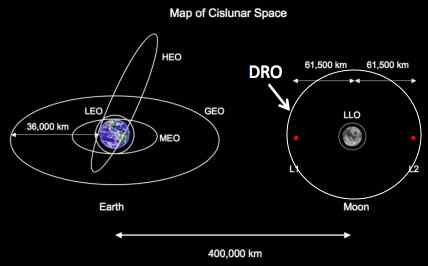
From Asteroid Final destination (Understanding NASA's Asteroid Redirect Mission).
Another possibility is to return it directly to the EML2 or EML1. These are not stable positions but it is easy to do station keeping around them and may be the location of a future human occupied base. For an idea of how the calculations go, Hop David shows how to put one of the asteroids into an orbit around Earth and eventually send it to EML1, asteroid 2008 HU4 in his case, with only 25 meters per second delta v - his calculation is for 2015. He first redirects it so that it does a close flyby of the Earth Moon system. He arranges for a flyby of the Moon in just the right direction to capture it into the Earth Moon system. Then he does another burn to get it to do a second swing by of the Moon, and a final nudge parks it in the EML2 position just a short way beyond the far side of the Moon. From there it is also easy to move it to EML1 if preferred, the similar point of balance between the Moon and Earth on the near side of the Moon.
An asteroid like 2008 HU4, about 7 meters in diameter, would weigh be around 500 tonnes and that's a lot of material if we had to send it all to EML1 from Earth, or even from the Moon. It may be well worth doing, even if it is just used as solar storm shielding. Depending on the asteroid, it could also be useful as a source of water which could be split into hydrogen and oxygen. It could also be a source of nitrogen, and also, iron, nickel and platinum group metals. So it could be used for propellants, and life support and structural components as well as the radiation shielding.
I wonder if one of these mini moons could be of interest for a human mission also? They are far more of a challenge to reach in one sense, because of their erratic orbits, but on the other hand you don't have to descend to the surface of the Moon, and they do spend a fair bit of time close to Earth if we happen to catch a large one that is in it's vicinity for a few months. So they could be an interesting target for a human mission if we can catch them at he right moment. Could one of them even perhaps be redirected into a DRO orbit during some suitable point in its erratic trajectory around the Earth Moon system?
2016 HO3 could also be of interest for a human mission - but a long one - it's either 154 days with only 8 days there for 6.114 km/s total delta v or 154 days including 8 days there for a 11.955 km / s delta v - but with frequent opportunities once a year at least and almost any time if you permit it to use more delta v. It seems more likely to be a robot destination.
I think these close flyby asteroids or mini moons could well be useful as part of our exploration of the Earth Moon system, either "as is" or redirected to a more convenient orbit. I don't think they are any kind of a substitute for going back to the Moon. But going to them as well as the Moon could be interesting, and a different challenge from a mission to the lunar surface as well as potentially useful for getting shielding and other resources for habitats in the Earth Moon system, for instance at the Earth Moon L1 and L2 positions balanced above the far side of the Moon or the near side. The mass of a small asteroid. 500 tons isn't that much, but it would be sufficient radiation shielding at one ton per square meter for a spherical habitat 12.6 meters in diameter - not so shabby! It could well be a useful support base between Earth and the Moon where a permanent crew can stay safely for years on end as they explore the Moon via telepresence and support the surface explorations there. It could also be a useful refuge for astronauts who encounter a solar storm during the 3 day journey from the Moon to Earth. And having done this asteroid return once, you can return more asteroids and do it many times.
Longer term, some have suggested we could terraform the Moon. Surprisingly, we can - well - sort of. With its weak gravity it can’t keep an atmosphere for long, but it can keep it for longer than you might expect. Thousands of years. It is a bit like building a huge domed city on the Moon - to turn a lifeless lump of rock into a habitat. The main difference is that it uses a lot more mass per unit area of atmosphere than a city dome because it is open above, and you have to keep replenishing it. The atmosphere does though have the advantage of shielding from even quite large meteorites. It seems like a project for a megatechnology future.
I work out here using work by Landis, that a comet 600 km in diameter, and 0.5% nitrogen from the Kuiper belt (say) (where there is more nitrogen) could spin it up to a 24 hour day, give it an ocean 1.3 km deep and it would have an atmosphere that lasts for thousands of years. Ordinary photosynthesis would take 100,000 years to make the water into a breathable atmosphere, so you’d do better if you have vast amounts of fusion power or similar to split it using electricity.
There are many major challenges however, including reactions of the atmosphere with the lunar crust and the need to keep replenishing the atmosphere without harming its inhabitants.
Other approaches such as city domes, lunar cave colonies and perhaps eventually paraterraforming (covering with a transparent”roof” to make a kind of a “world house” to keep in the atmosphere) are all easier than terraforming. And terraforming is a long timescale mega project. So not suggesting we try it :), but theoretically it is interesting to look at it.
So first, on atmospheric loss, it loses its atmosphere quickly. Geoffery Landis looked into this.
See his Air Pollution on the Moon for details. His main focus there is the adverse effect of the atmosphere created as a byproduct of industry on the Moon, leading to degradation of the valuable high vacuum there. But he does briefly touch on terraforming at the end.
Then Gregory Benford, the hard science fiction writer, thinks we can terraform it, in this rather intriguing article: A Terraformed Moon Would Be an Awful Lot Like Florida.
He envisions hitting the Moon with a hundred comets the size of Halley's comet - at the same time spinning it up so it has a day of 60 hours.(I'm not sure of his calculation, it seems that the number of comets needed is more like 10,000, see below).
Presumably you would keep adding new comets to it - but if he is right that 100 comets are enough - then just adding one new comet a century would keep it going - and you could do that without harm to the citizens of the Moon by breaking the comet up into tiny pieces before it impacts onto the lunar atmosphere. So what would it look like if we could terraform it? Well here is an artist's impression of a terraformed Moon.
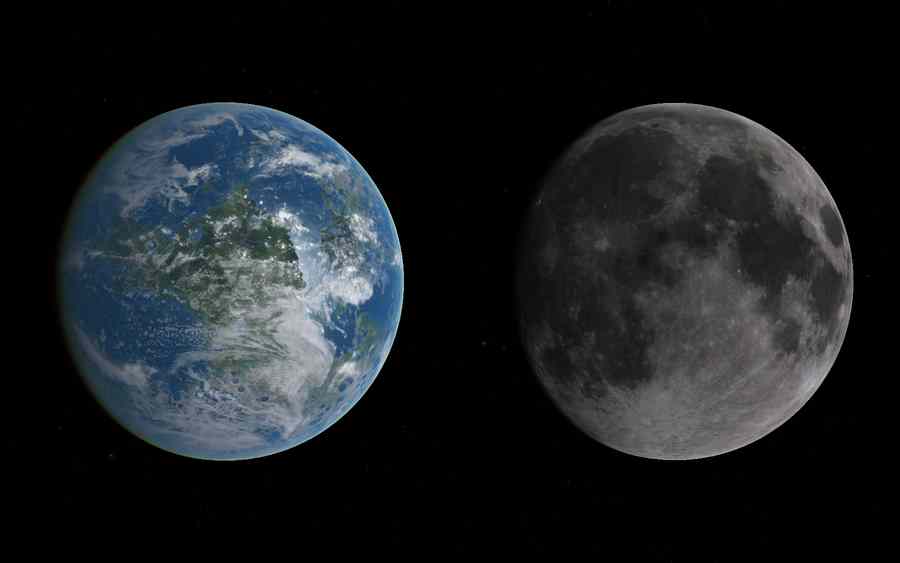
I prefer this to ideas for terraforming Mars, because there is no life on the Moon to be impacted by it. Also the Moon is close to Earth, and it is clear that it has to maintain a high technology to keep it terraformed, so if both Earth and Moon have high technology, they can work together. The Moon is at a fixed distance, and we can set up some easy way of getting back and forth with space elevators or space tether systems. And use the same factories - and exchange materials from one to the other easily etc. It is similar to the idea of a very huge Stanford Torus, to terraform the Moon. It turns a lifeless though very large region into a habitable area.
With Mars, then if it can be terraformed, it's on the thousands of years timescale, with lots to go wrong. It may seem like a new earth but if you can terraform it as quickly as that, it needs mega technology to stay terraformed, and it might unterraform as quickly as it terraformed.
On Mars the plants have to produce nearly three times as much oxygen to achieve the same partial pressure on Mars as on Earth (5,54 tons instead of 2.095 tons). For the Moon the plants have to produce six times as much oxygen as on Earth for the same partial pressure, but they get about double the levels of sunlight they get on Mars for photosynthesis.
If you work it out in detail, there is very little between them in this respect. Plants on the Moon need to create 2.29 times as much oxygen as on Mars to produce the same oxygen partial pressure, but they get 2.25 times as much sunlight as on Mars.
Detailed calculation: to achieve an Earth normal 10 tons per square meter of atmosphere pressure in lunar gravity - you need 60 tons per square meter of gas in mass. The plants need to maintain 12.7 tons of oxygen per square meter (2.095*9.807/1.622) instead of the 2..095 tons per square meter of oxygen for Earth. On Mars they need to maintain 5.54 tons per square meter (2.095*9.807/3.711). So they need to create 2.29 times as much oxygen on the Moon. Earth (and so the Moon) gets 2.25 times as much sunlight as Mars. So there isn't much in it.
Let's check his Halley's comet calculation, calculation indented and I'll include all the steps in detail to make it easy to check.
With a radius of the Moon of 1737.4 km I make the surface area of the Moon 4×π×1737.42 = 37,932,328 square kms. For an Earth pressure atmosphere we need (9.807/1.622)×10 tons per square meter, or around 60 tons per square meter, and multiply also by 106 for the number of square meters per square kilometer, that's 37,932,328 × 106×60 = 2.28×1015 tons or 2.28 quadrillion tons. Halley's comet is 242.5 billion tons.
So you would need around 2.28 quadrillion/242.5 billion or 9,402 of Halley's comet.Geoffrey Landis assumes a one psi atmosphere, of pure oxygen, at the Armstrong limit so about 6.9% and works out the total mass needed as two hundred trillion tons or about 825 Halley comets..But he works that out as 50 to 100 Halley comets so must be assuming a larger mass for Halley's comet of two to four trillion tons - it's an early paper from 1990 so I think he is just using older data for Halley's comet.
So, I think Gregory Benford's 100 Halley comets probably comes from Geoffrey Landis's paper. - it means 100 comets the size of Halley but with an older figure for the mass of Halley. And both are assuming the thinnest atmosphere a human can breathe without the moisture lining their lungs boiling.
Approaching it another way, our 2.28 quadrillion tons of atmosphere for an Earth normal atmosphere corresponds to around 2.28 million cubic kilometers of ice assuming average density of 1 (there are a billion tons to a cubic kilometer of water). Or assuming a density of 0.532 tons / cubic meter (same as comet 67p) that's 4.3 million cubic kilometers
So solving for radius, then you get
π×r3×4/3 =4.3 ×106
So r = cube root(4.3×106×3/(4×π))
= 100 km approx.
So in short, it seems that you need more like 10,000 copies of Halley's comet, or you could hit the Moon with a comet of about 200 km in diameter - or larger if the density is less than 0.532, less if it is more than 0.532. If you did that, you'd have enough material for an instant atmosphere. That is if it is all potential atmosphere, but of course a lot would be water, perhaps 80% which you'd need to convert to atmosphere somehow, perhaps split the hydrogen and oxygen to create an oxygen atmosphere. In Geoffrey Landis' paper he suggests UV from the sun could split the water to generate oxygen:
"Alternatively, if we could find an icecube fifty kilometers on an edge and crash it into the moon, the moon would acquire an atmosphere of water vapor. That, as it happens, is just fine--in a relatively short time (well, "short" might mean as much as hundreds of years) ultraviolet from the sun will split off the hydrogen, which leaks away, leaving atomic oxygen, which will quickly combine to form ordinary O2--just what we need to breath."
If you aim is to make a CO2 atmosphere, then assuming it is 80% water, then you'd need
= 166 km approx. Or 332 km in diameter.
If the aim is nitrogen, with 0.5% of the comet made of nitrogen, and needing 78% of the atmosphere as nitrogen, you are talking about cube root((100/0.5)×0.78×3.83×106×3/(4×π)) or 522 kim in radius, so about 1044 km in diameter. There would then be plenty of water, and carbon dioxide.
Once we can move large comets easily from the outer to the inner soar system, this could be possible selecting a large comet of a suitable composition. You'd have a lot of water as well which would be useful.
SPINNING IT UP TO A 24 HOUR DAY
How much mass would you need to use to spin it up to a
hour day?
Well it’s radius is 1,737 km
A comet could impact at 53 km / sec and possibly up to 70 km / sec if you could deflect a very long period comet to hit the Moon
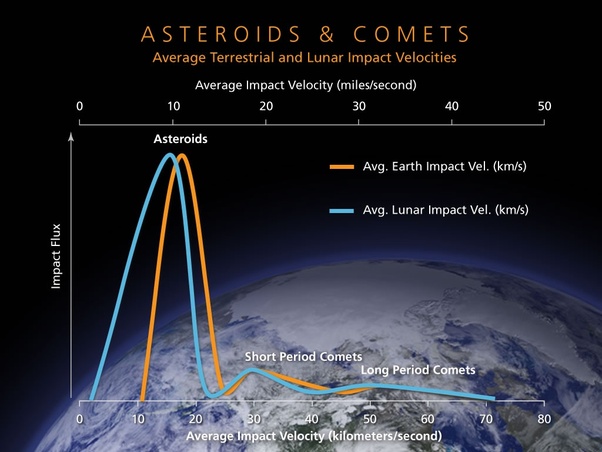
The angular momentum of the Moon in its current 28 day spin is
see Robert Walker
's answer to What is the angular momentum of the moon in its rotation around its axis?Using L = rmv then the angular momentum imparted by an impact by a 2.28 quadrillion tons, 200 km in diameter comet (the minimum needed if it is entirely Earth atmosphere, implausibly) would be
mass: 2.28 10^{18} kg
Radius = 1,737 km or 1,737,000 m
Velocity 70 km / sec or 70,000 m/s
Angular momentum 2.28 10^{18} 70,000 1,737,000 = 2.772252 10^{29}
So that would seem to be enough to more than halve its rotational period
655.728 hour rotational sidereal period Moon Fact Sheet
But suppose we have a larger impact like that comet that’s only 0.5% nitrogen? Let’s see how much mass we need to achieve a 24 hour day.
We need
M =
It’s diameter would be around 200×( 5× 10^19/ (2.28 ×10^18 ))^(1/3) or about 600 km in diameter. Or probably a bit smaller than that since it would be denser.
A large comet would both add enough nitrogen, and water for some lakes and seas as well as spin it up to 24 hours.
Suppose most of it is ice. Then
Surface area of Moon: 37.9 million square kilometers The Moon Compared to Earth - Universe Today
So that’s 5tons/ m2
= 1319 meters or about 1.3 km in depth of water.
So if you impact it with a large 600 km diameter comet (may be a bit smaller given that it’s going to be denser than the average comet) at 70 km/sec it would spin the moon up to a 24 hour day and add an ocean 1.3 km deep. And it would add more than enough nitrogen for a full nitrogen atmosphere.
Then - for a breathable atmosphere - then you need to have a buffer gas, which on Earth is nitrogen (CO2 is poisonous to humans in large concentrations). You can have a thinner pure oxygen atmosphere with no buffer gas, but this is a fire risk (as we found out in practice with the Apollo 1 disaster), so not likely to be used for terraforming or large scale habitats, though it is used for spacesuits as it reduces the pressure inside the suit so makes them more flexible and easier to use and the fire risk can be managed in a spacesuit by using fireproof materials. It's not really feasible though to make a terraformed Moon in its entirety fire resistant.
So most of that weight needs to be nitrogen - unless you have some alternative buffer gas. Halley's comet has hardly any ammonia (NH3). As for Kuiper belt objects, their interior composition is highly varied from rocky all the way to solid ice,
The compositions of Kuiper belt objects - but I can't find much about the ammonia and nitrogen abundances inside the objects (rather than on the surface). There are some meteorites also that are rich in nitrates. But finding enough nitrogen might be a problem if that's our buffer gas, seems to me. Titan has a dense nitrogen atmosphere, and is larger than our Moon and has an Earth pressure atmosphere so it has enough nitrogen, it's just in the wrong place and inaccessible from Earth. It doesn't seem practical to transport its atmosphere to the Moon. Also, it's unique and interesting in its own right, as the only moon of its type in our solar system.
So, it seems that we depend on comets. If a comet is only 0.4% ammonia, or nitrogen etc., you need nearly 200 times as many comets for the nitrogen, so two million copies of Halley's comet. Or a comet 6.3 times larger turning our 200 km comet into a 1,260 km diameter dwarf planet.
Maybe you have to hunt around - there are lots of Kuiper belt objects, we only have discovered a tiny fraction of them and maybe one of them has lots of nitrogen? For all we know, maybe when we expand the search, maybe we find tens of thousands of nitrogen rich Kuiper belt objects the size of Halley's Comet - far too small to spot from Earth with existing telescopes? We can't really do a decent calculation here unless someone has a good idea of a source with a well known nitrogen rich composition.
If we find one, then we have to move it into the inner solar system and hit the Moon (gently) before the nitrogen rich ammonia (or more difficult, nitrogen ice) gets a chance to evaporate. If it is a large body and we move it into the inner solar system quickly, this seems feasible, without going into details of the calculation. It would be a bit like storing ice through the summer which they used to do in high latitudes before freezers and refrigerators. Or for that matter, with the level of technology we are imagining here, we could just cover the comet with a reflective layer to keep it cool for the journey.
Another problem - if you want an oxygen rich atmosphere - well the Earth had reduced iron and it took millions of years to oxidize it before we managed to get an oxygen rich atmosphere. Basically, all the reduced iron has to rust. A process that has already happened on Earth, and on Mars (it's the reason the surface is red) - but not yet on the Moon.
So - same is likely to happen on the Moon. Maybe we can speed it up but for a long time all the oxygen we create will get absorbed by the lunar crust through chemical reactions, as happened on Earth in the early stages of the Great Oxygenation Event
"The upper few kilometers of the lunar surface contain several times 1018 kg of iron(II) which in the presence of water would readily react with oxygen to form iron(III). Such an amount of iron(II) could easily absorb all of the oxygen in the Earth atmosphere.
"A large fraction of the Moons crust consists of oxides of calcium, magnesium, and iron(II), which in the presence of water would react to form hydroxides that would (partly) dissolve in the forming seas to create a poisonously alkaline fluid, with pH 10--11. If enough oxygen were available to oxidize the dissolved iron(II) hydroxides, insoluble iron(III) hydroxides would precipitate on the sea floors and shores, creating vast quantities of slightly poisonous, orange mud. Such reactions would be violent and fast in the upper part of the crust, but their rate would decrease with increasing depth. The oxidizing, hydration, and other processes would continue for ages. In the meantime oxygen and other pressures would not be stable. Most of important all: the absorption of such enormous amounts of oxygen, water, by the upper part of the crust of the Moon would make the rocks expand by perhaps as much as ten percent or more. One can wonder if such expansion would be a tranquil process. It could create strong quakes for possibly many thousands of years. "
from: An Atmosphere for the Moon
So, the upshot of all this is, the terraforming the Moon may well be possible with future technology which may not be that far away, especially with nuclear fusion or such like. But I think it may be a little harder than Greg Benford suggests in his article.
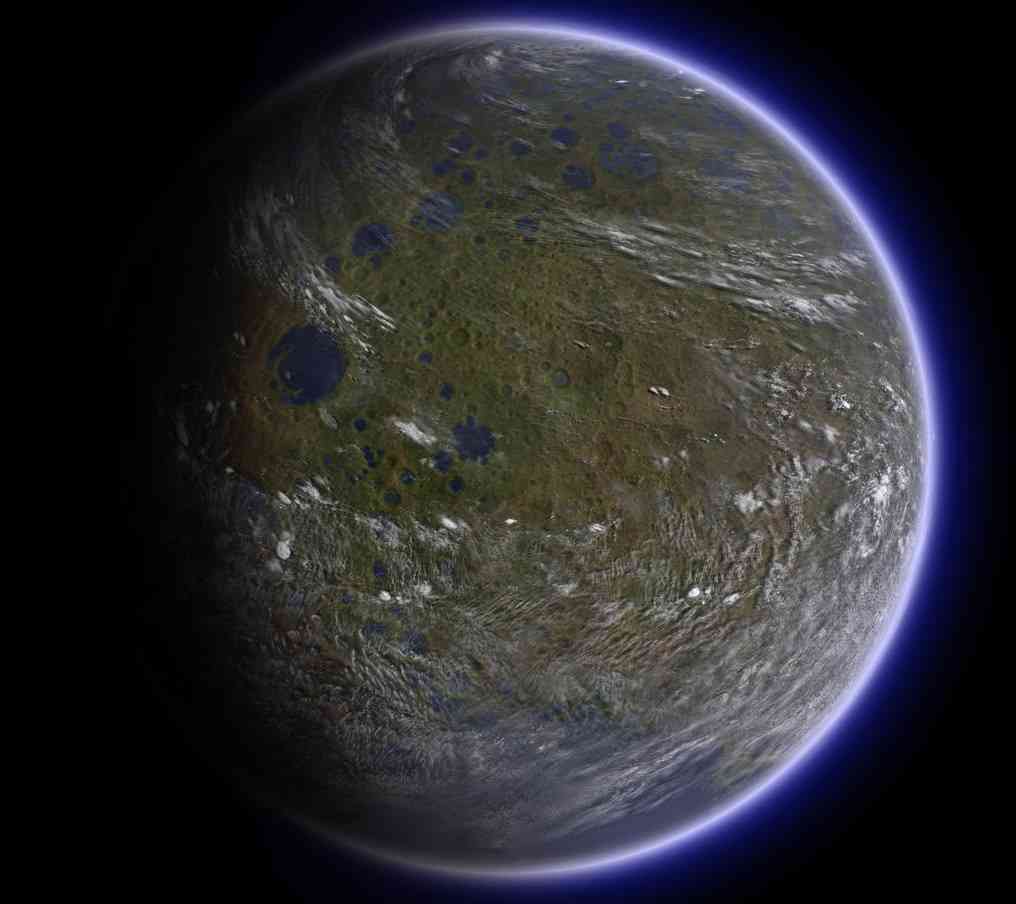
If I've got the figures right here, you need 10,000 Halley comets, or a giant comet 200 km in diameter. If you need to supply nitrogen as a buffer gas from comets with the same composition as Halley, you need two million copies of Halley's comet, or a larger dwarf planet perhaps up to 1,260 km diameter depending on how much nitrogen it has in its composition. After that, you would have many issues with reaction of the water with the dry lunar surface. And then the plants would have to work six times harder than on Earth to produce the same partial pressure of oxygen.
Do be sure to correct me if I have made any mistakes here!
Of course many of these issues would also turn up for Mars, and if you compare it with Mars it doesn't seem so bad.
Mars would need similarly huge amounts of nitrogen for instance, less per surface area but more in absolute terms.
Comparison of mass of nitrogen needed for Mars and the Moon: the Mars surface area is 144.8 km² and for the Moon, 37.9 km². To get the same atmospheric pressure, the Moon has to have 2.29 times as much mass per square meter than Mars. So the amount of mass needed for Mars is 144.8/(37.9* 2.29) so Mars needs 1.67 times the mass for the Moon. Or about 3.34 million Halley comets to supply it with nitrogen, unless it is available indigenously.
The plants have to work six times harder just as for the Moon. The atmosphere lasts longer on Mars, but it's not a permanent feature without megaengineering - it will disappear over millions of years timescales. On Mars you need to have global mirrors or greenhouse gases and still supply some volatiles with comets, for the Moon you don't need to compensate for reduced sunlight but need a constant input of volatiles.
New carbon cycles have to be set in place in both cases to return carbon to the atmosphere and these have to be based on novel principles as Earth's cycles won't work in the same way, especially the long term conversion of limestone back to CO2 as a result of subduction due to continental drift won't work on the Moon or Mars. As for the Moon, Mars also has deserts which are extremely dry and will take up much of the water if water is added to the planet (though it doesn't have the problem of oxygen reacting with the surface materials). And so on.
So - the Moon might not be so bad if you compare it to Mars, maybe you could terraform it a bit faster as a smaller object needing less total mass, and it doesn't need any supplemented sunlight or greenhouse gases. But it seems an impractically mega project even so with present day technology.
To last longer than a few thousand years, it would need constant maintenance in the form of extra volatiles from comets, which you could do safely by breaking up the comets into small chunks and sending those to hit the lunar atmosphere.But the same is true for ideas of terraforming Mars they need constant maintenance in the form of orbiting mirrors or greenhouse gases and need some resupply of volatiles as well to keep it terraformed (if it worked).
In the case of Mars constant maintenance is needed because the planet is too cold to remain habitable without orbiting mirrors or greenhouse gases, while in the cases of the Moon it is because its gravity can't hold onto its atmosphere. Mars loses its atmosphere also, but on much longer timescales.
However, it's not really that much different.
The timescales are similar too for creating the atmospheres. To create an oxygen rich atmosphere on Mars means sequestering out all the carbon assuming there is enough CO2 to make an Earth density atmosphere which most think there isn't (at most enough for 10%) and that process would take around 100,000 years using photosynthesis, as a result of which Mars would of course cool down even further without CO2 to warm it up so need more greenhouse gases or orbital mirrors.
I'm not suggesting we terraform either. I don't think we are anywhere near the stage where it makes much sense to attempt terraforming, a trillion dollars a year project that you have to commit to for thousands of years, whether it is for the Moon or for Mars or anywhere else. We find it hard to commit to a space project for a few decades and a few billion dollars a year. That's apart from planetary protection issues. And as well, we just don't know anything like enough about how ecosystems work, getting unpleasant surprises with "toy ecosystems" the size of Biosphere II, and not able to make even tiny changes to the atmosphere of Earth. If we could make a 0.01% change in the amount of CO2 in the atmosphere the global warming crisis would be over right away.
However, just as a matter of the physics. the Moon can in principle be terraformed though with many issues you'd have to sort out. But the same is true for Mars. I don't see them as that much different actually. Not with present day ideas of terraforming. We would need to understand this all in a lot more detail than we do now to see which is best, if either can be terraformed in practice. For more on this see: It is not at all clear that we can terraform Mars
Terraforming the Moon is another of those topics that doesn't seem to have a lot of attention in the academic literature. But apart from Greg Benford's article, here are forum discussions which are a good source of ideas, though of course not peer reviewed:
And then the An Atmosphere for the Moon and there's the Universe Today's HOW DO WE TERRAFORM THE MOON?
However there's another solution,
Paraterraforming means covering the surface with habitats, eventually domed cities and eventually the entire surface covered in habitats. Eventually they could merge together to make a kind of a sky to hold the atmosphere in - with lots of partitions for safety.
That needs far less atmosphere - because instead of 60 tons of mass per square meter to supply atmospheric pressure - you just have as much air as is needed to fill your greenhouses, which may have heights measured in meters. Even if the greenhouses are a hundred meters high, that's 122.5 kilograms per square meter instead of 60 tons per square meter of air, a huge saving (using density of air of 1.225 kg / m² )
Can a complex closed ecosystem work with a shallower atmosphere like that? They thought it might with Biosphere II but it proved harder than expected, still there doesn't seem to be any major reasons why not. You still have the problem also of oxygen and chemical reactions. But maybe at the same time that you enclose them from above, you can insulate them from the subsurface as well so they don't lose their oxygen through chemical reactions with the lunar soil. One way to do that would be to turn the surface into glass, though you might instead want to use bulldozers to remove a few meters depth of regolith, turn the layer below into glass then replace the regolith to use as soil. This is quite reminiscent of Biosphere II where one of the main reasons it failed was because of chemical reactions involving the concrete the habitat was made of.
This has many advantages
I can't find an illustration of a paraterraformed Moon but the same idea can be used for large asteroids and small moons too, if you can tolerate the low gravity. Here is an artist's impression of a paraterraformed Phobos by Ittiz
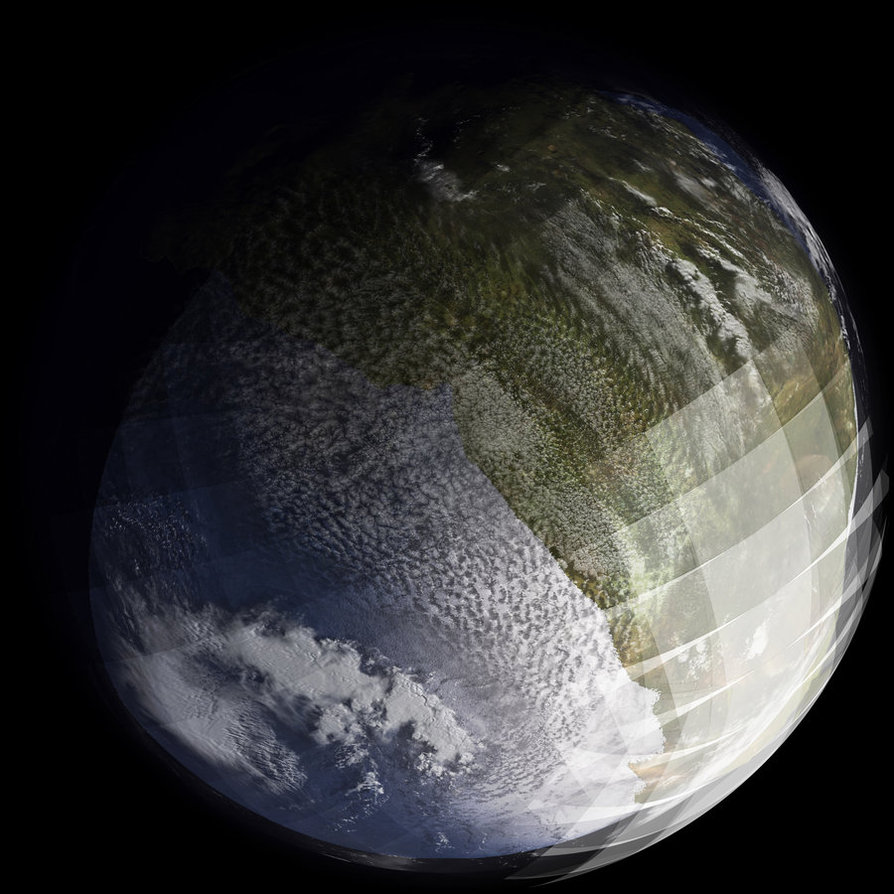
I've touched on this comparison a few times already but let's follow it through a bit further this time. We are like the first explorers to get to Antarctica.
To colonize space right now - Mars, the Moon or anywhere - is like Shackleton saying “Oh, we managed to survive a winter here, huddled under a boat and hunting seals, amazing, let’s colonize Antarctica”.

Those remaining on Elephant Island in Antarctica waving farewell to Shackleton and his five crew as he set off in the James Caird boat to find rescue in South Georgia. They managed to survive a winter in Antarctica, but they didn’t say “Oh great, let’s colonize Antarctica :) “ Ernest Shackleton and the Endurance expedition, The voyage of the James Caird, Elephant Island
(they weren’t first to overwinter, that honour goes to the Southern Cross Expedition)
Norway's most significant historic site in Antarctica Southern Cross expedition - first to over winter in Antarctica Southern Cross Expedition
Mars may look more habitable than Antarctica but that’s mainly because it is so dry. If it did have enough water, the whole planet would be covered in a thick sheet of ice. It is very very cold there, especially at night when the air gets so cold that some of it starts to freeze out as dry ice, even in equatorial regions, for many nights of the year forming the ice / CO2 frosts photographed by Viking.
Actually Antarctica is far more habitable than either Mars or the Moon. It has a breathable atmosphere to start with, it's hard to beat that, no radiation problems, and you don’t have to hold in the air in against an outwards pressure of several tons per square meter. That is why space habitats like the ISS are such massive feats of engineering, with living quarters made up of tubes with rounded ends, or spheres, or in future perhaps, donut shaped space settlements. Everything has to be contained in rounded surfaces of strong materials.
Also they usually have few or tiny windows, because it is a challenge to make a transparent pane to withstand several tons per square meter of outwards pressure. If the interior is pressurized to Earth sea level equivalent, as for the ISS, then it has nearly a ton pressing outwards on a tiny window 30 cms by 30 cms (ten tons per square meter). It's much the same on Mars also, as there's only 1% difference in the amount of outwards pressure on the walls of a habitat on the Moon and on Mars, when pressurized to Earth sea level equivalent.
Even the summit of Mount Everest is far far more habitable than Mars.

Compared to the surface of Mars, the summit of Mt .Everest is a paradise and would be a wonderful place to grow your tomatoes compared to Mars. You can almost breathe the air, with only supplemental oxygen, you don’t have to wear a spacesuit, your lungs won’t be damaged irreversibly with the water lining them boiling, you just need to warm it up and supply a bit of extra oxygen, easy peasy :). Well not really but compared to Mars it is.
If Shackleton's party had had that as their main objective, to "live off the land" they might well have succeeded for a while, killing seals and penguins for food and using their fat for fuel to keep warm, a bit like high tech Inuit. After all Shackleton's party did survive an Antarctic winter while he and five companions set off to find rescue for them in a small open boat. However with early twentieth century technology, however enthusiastic the first settlers were; soon, surely their children would decide they'd had enough, and want to come home, and not continue with the harsh difficult way of life their parents had chosen.
Instead of attempting this, the early Antarctic explorers did their exploring, and scientific study, and then came back to their warm comfortable homes at the end of each expedition. For year after year they continued to explore, built temporary bases, then more comfortable ones, and now we have many bases in Antarctica that are occupied all the year round (though with fewer people there in the Antarctic winter).
So, I think it's the same with space. First, we don't need to colonize space for the human interest. As with Antarctica, there will be plenty of interest with scientific exploration, adventure and tourism. Then, if we go into space to try to colonize right now, we will never succeed. Instead people will just get discouraged.
It is just too hard. Would you colonize a mountain plateau 30 kilometers into the atmosphere, more than three times the height of Mount Everest? At that height you'd have the same atmospheric pressure as Mars, but it would be much more hospitable in other ways. Perhaps it could be done, but why live in a place where everything is so difficult to do? Unless you have some very strong reason for living there, people just wouldn't set up home in a place like that, Not once the novelty wore off. But you'd go there for adventures, you'd have scientists studying, and so on.
There is no sign at all that we have come to an end of the science we can do in Antarctica, or that people will lose interest in going there as tourists, or going on adventures there. Yet, we are nowhere near to starting up a true colony there, and nobody has that as an objective at present.
Maybe eventually we will find a way to live in such harsh conditions as the Moon easily. Maybe we can do this with 3D printers, and biologically closed systems, living in the lunar caves, and eventually on a paraterraformed Moon. Maybe this will lead us to find a way towards a more sustainable future here on Earth as well. Still, if we achieve the ability to do this easily, the technology would still work much better on Earth than in space. You can use much the same design for your colony - except that you can drop all the cosmic radiation shielding, forget about airlocks and spacesuits, and just have windows and doors, instead, which you can walk out of, into a breathable atmosphere.
Put that habitat almost anywhere on Earth, in a desert, or floating on the sea - and that would be a far easier place to live than any space habitat. So if those self sustained habitats became possible in the future, even as a spinoff from space habitat research, I think most of them would be built on Earth rather than in space, at least to start with. Let's meet this miraculous future when it happens, if it does. Meanwhile it's not realistic to send colonists into space in the hope that 3D printers will save the day. They are likely to die waiting for the technology to be invented.
So, in this vision of the future, we have humans in space, but they aren't there to colonize. They are there rather to explore and study, and for adventure and so on, for many of the same reasons we have people in Antarctica. In the near future anyway. I think this is just being realistic; choosing a future that is within our reach rather than a rather beguiling far future science fiction fantasy that is probably centuries or even thousands of years out of reach, such as a terraformed Mars.
In this way, without that imperative that we have to colonize as quickly as possible, and turn everything into the nearest to a pale imitation of Earth as we can manage - then we can have a more open ended future. It gives us space to consider other possibilities; or at least, to look at them. For instance, in one possible future we could introduce Earth life to Mars, accidentally and irreversibly, perhaps from a crashed human occupied spaceship, creating a new geological era on Mars. But we don't have to do that. There is no need quite yet to make such an irrevocable decision for ourselves and all future civilizations on Earth.
Let's study Mars carefully from orbit first. There is no hurry, and this would be a fascinating exploration using telepresence, once we can get humans there. Maybe we will know enough in the future to make such far reaching decisions, but meanwhile, let's keep our options open for the future.
This next video is not telepresence as such; rather, it's a new way to explore the Mars landscape to help with controlling the rovers from Earth. However, I think it gives as good idea of what telepresence might be like for those operating rovers on Mars in real time from orbit, some time in the future with this vision.
See Scientists Can Virtually Wander Around Mars for Miles with HoloLens

At the moment, there's a tremendous impetus amongst Mars advocates to get to Mars as soon as possible. Elon Musk even hopes to send humans to the Mars surface as soon as the 2020s, recently suggesting a first human mission in 2024, with NASA talking about the 2030s. I think it would be wrong though to suggest that Elon Musk doesn't care about the science impact of introducing Earth microbes to Mars. Here he answers a question on this topic, in the 2015 AGU conference in San Francisco, 30 minutes into this video:
Q. "I am Jim Cole from Arizona State University. I was listening to Chris McKay, another advocate of humans to Mars, and he was talking about how if we do go to Mars and we find life either there or extinct, we should consider removing human presence so that we can allow the other life to thrive. I was wondering what your thoughts on that were. "
A. "Well it really doesn't seem that there is any life on Mars, on the surface at least, no sign of that. If we do find sign of it, for sure we need to understand what it is and try to make sure that we don't extinguish it, that's important. But I think the reality is that there isn't any life on the surface of Mars. There may be microbial life deep underground, where it is shielded from radiation and the cold. So that's a possibility but in that case I think anything we do on the surface is not going to have a big impact on the subterranean life.".
So, it's clear (as I'd expect actually), he does think it is important we don't extinguish any native Mars life. But he thinks there isn't any present day life on the surface. But is that right?
I did a survey of the scientific literature, to see what there is by way of proposed habitats and to investigate the range of views on the topic:
Are There Habitats For Life On Mars? - Salty Seeps, Clear Ice Greenhouses, Ice Fumaroles, Dune Bioreactors,... (long detailed survey article with many cites)
It's also available as a kindle booklet, and also online here with table of contents
As you see, there's an almost bewildering variety of suggestions for habitats on Mars for life. The main ones are (these links take you to the online booklet)
There's a wide variety of views also on the topic of whether any of these are habitable, and whether they actually have life in them, from almost impossible to very likely, see Views on the possibility of present day life on or near the surface, and for the idea that they may be inhabitable but uninhabited, see Uninhabited habitats.
So when will we resolve this? Well not for some time. Most of these potential habitats would be hidden from view, a few millimeters or centimeters below the surface. Some of the habitats might be quite productive, for instance methanogens in warm humid locations deep below the surface heated by geothermal processes. There might be enough life there to cause obvious effects on the atmosphere, such as the methane plumes. But as Mars changed from a warmish wet planet to a cold dry planet, any surface life would probably become more and more sparse, and have less and less effect on the atmosphere.
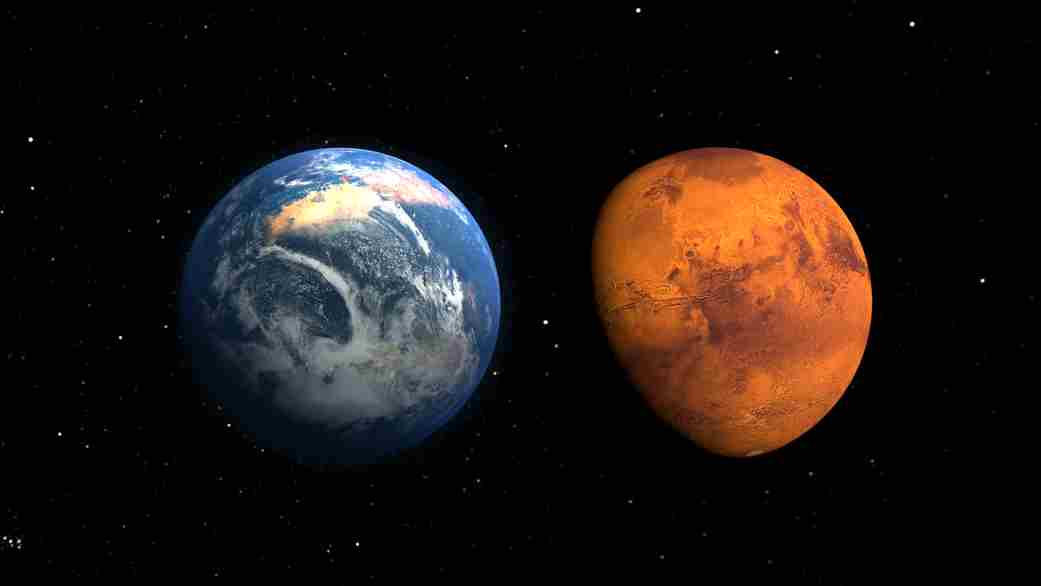
As Mars slowly changed from the warmish humid planet on the left to the dry cold planet on the right, then any surface life may have become more and more sparse, and had less and less effect. Image from NASA (Goddard space center).
So, if the life from early Mars still lingers but is sparse, it might easily have almost no effect on the atmosphere by now. The most habitable areas of Mars such as the warm seasonal flows, if we are lucky, might be about as habitable as the Antarctic dry valleys or the high Atacama dry desert. If that's the way of it, life in those few square kilometers of the Martian surface would have almost no effect on the atmosphere. Mars already has small amounts of oxygen (0.145% as measured by Curiosity). The signal of oxygen from photosynthetic life on the surface, at such low levels, would just be hidden in the noise.
Indeed, even if the entire surface of Mars is as productive of oxygen as Antarctic ice covered lakes - and even if all that oxygen ends up in the atmosphere, the signal from all of that photosynthetic life would still be lost in the noise and not noticeable in the atmosphere (I made it about 0.0002%, in a very rough calculation, by just assuming a residence time of oxygen in the Mars atmosphere of 4500 years, the same as for Earth - at any rate it would be a tiny, surely undetectable, signal).

Why Mars Surface Life May Leave No Traces In Its Atmosphere: Our Rovers May Need To Go Up Close To See It
also my Our Spacecraft Could Look Straight At an Extraterrestrial Microbe - And Not See a Thing!
You might think, why not go out and out, confront the issue head on, and whoever wins the confrontation gets the prize? Well, yes, sometimes confrontation can be good. Sometimes you have to do it. Or sometimes it's good to tackle an issue head on and you get more clarity from clearly exposing your differences from another person. If you are lucky, you may find that something new comes up that transcends either of your views or the things you knew, which you could only get to by clearly exposing the differences. Or you might be able to go different ways after the confrontation, with a bit more clarity. But sometimes you are "in it" together and can't just continue your separate ways, and sometimes after battling away at a confrontation, you find it is going nowhere.
At other times, you can compromise, find an approach that lets you accommodate both views at once to some extent. But sometimes a compromise satisfies nobody. It would satisfy nobody to pass a compromise law to let fruit importers import Hawaiian fruit into California on the first day of each month. The fruit importers would be severely restricted in what they can do, and every month there would be new opportunities for crop infestations by the oriental fruitfly, so the law wouldn't be much help to the fruit growers.
Sometimes then, confrontation isn't wise, as it only entrenches views, and it makes it harder to look at the good points of what the other person is saying. And sometimes compromise is impossible because it is a situation that just doesn't have a natural compromise that would satisfy both. When that happens, it's time to look for a non confrontational approach, a way ahead that while accepting the differences of views, leads maybe in an unexpected direction or in some way just takes a detour around the confrontation that was looming up. That can then be satisfactory to both.
That is what I'm attempting here. I think it's a situation where direct confrontation will only polarize positions and entrench ideas, I don't myself think that the compromise approach of sending humans to Mars with some extra precautions is adequate (highlighted by the problem of a human crash on Mars which would effectively end all possibility of planetary protection). But I do think it's a situation where a non confrontational approach is possible, satisfactory for both. That can give us some breathing space, which can lead to new ideas, discoveries and solutions for the way forward in the future, whatever it is.
This is an argument you often get from keen Mars colonization advocates. They've heard Zubrin speak about this and probably read the "Over protection of Mars" which got a lot of publicity as it suggested that we don't need to have any planetary protection of Mars because, they claimed, it has the same lifeforms as Earth in the same habitats already. The idea is that life gets back and forth between Earth and Mars on meteorites.
Now, that's certainly a decent hypothesis, panspermia, that some microbes might get from Earth to Mars and vice versa. But the case is not nearly as simple as you might think from those arguments. First, the "Over protection of Mars" by Alberto Fairén and Dirk Schulze-Makuch was immediately rebutted by a paper by the present and past planetary protection officers, Cassie Conley and Jim Rummel, called the "Appropriate protection of Mars". That got almost no publicity. The papers are behind paywalls, but you can read a summary of the arguments both ways in The Overprotection of Mars? in the NASA Astrobiology online magazine.
It's understandable that any proposal to reduce or drop planetary protection requirements would get so much more publicity. It's much more exciting for Mars advocates to learn that there are no planetary protection issues for humans to Mars. It's not nearly as interesting to learn that there are planetary protection issues. So any papers or articles suggesting that there will be no issues will get more publicity. So we need to bear this in mind, that the media is bound to be biased on this topic.
Why then is the situation not so simple as it seems? The problem with Zubrin's argument, and the arguments in "Over protection of Mars" is that
In more detail, then first it's true that there are meteorites going back and forth between Earth and Mars and that tons of Mars meteorites reach Earth from Mars every year, and probably from time to time many tons of meteorites get to Mars from Earth. But they don't leave Earth or Mars continuously. Most of those meteorites have spent several million years in transit.
It's easiest to see this for the Mars to Earth direction as we can look at empirical data here. You can tell this from the cosmic radiation ages of the meteorites - how long they were exposed to this radiation during the crossing from Mars to Earth (while geological age shows the age since the rock first formed). The youngest meteorite we have, EET 79001, left Mars 730,000 years ago. So it was thoroughly sterilized by the time it got here. The oldest meteorite is around twenty million years old (as expected, because Earth clears its orbit over around a twenty million year time frame). These meteorites come to use from impacts of asteroids of the order of 1 kilometer across at an oblique angle on Mars, such as he one that created the young Zumil crater, and you get one of those every one or two million years on Mars.
The young Zumil crater, strong candidate for source of some of our Mars meteorites - impacts like this happen on Mars roughly every one or two million years. Most of the material spends millions of years in transit from Mars to Earth but some may get here within the first century.
So, the opportunities are rare, not nearly as frequent as you might think from the amount of material that gets to Earth from Mars. Then next, you have to show how the life gets from Mars to Earth. First, it has to be hardy enough to withstand a century in transit, with vacuum conditions, the cold of space, cosmic radiation, and solar storms. But as well as that, the habitats suggested for life on Mars surface life are shallow (top few cms) and many of them are fragile as well, salts, dusts, thin films of brine, and ice / salt interfaces in the top few few cms of the Mars surface. And the most habitable areas are likely to be rare, a few patches here and there. There may be spores in the dust, but how likely is it that an asteroid impact will send the Mars dust to Earth? Actually, detailed models show that the material sent into space after a big impact typically comes from a few meters below the surface. So in short, it seems very unlikely for any surface or near surface life to get from Mars to Earth in present day conditions, though it could have happened in early Mars when there were large seas or later on when there were floods and lake conditions.
In the other direction, we don't have any examples yet of Earth meteorites on Mars, but they leave Earth much less frequently. You need an impact large enough to send material at escape velocity through our thick atmosphere, against the Earth's gravity. The last time this happened perhaps was the Chicxulub impact 66 million years ago, an impact into a shallow tropical ocean, not the most optimal for microbes likely to survive the vacuum and cold of the transit and on Mars once they get there.
So, does Mars have any life from Earth from 66 million years ago? Or from earlier than that? Well it's quite hard for Earth life to get to Mars also. Assuming it's the first species to get from Earth to Mars, you need:
The best candidate to fit all that might be something like Chrooccocidiopsis, a radioresistant polyextremophile that can also survive in ordinary conditions too, does fine in the tropics. I could see it surviving the impact into a tropical ocean, making it to Mars and making its way to a habitat there. So, if we do find Earth life there, that would be my personal favourite for a top candidate. It would have evolved independently on Mars for at least 66 million years, but it has been around on Earth since right back to before the great oxygenation event, one of our oldest lifeforms, so could also have got to Mars billions of years ago.
Nevertheless, it's not proven that there is any life from Earth on Mars. And the life that gets to Mars from Earth could play nicely with whatever there is there native to Mars. For instance my example of early RNA based life, if there is nothing from Earth to eat it, then perhaps it can get on fine with Chroococcidiopsis, might be a mixed Earth / Mars originated life ecosystem. Or maybe there's some life form on Mars that is so much better at photosynthesis, some method not yet explored on Earth, that it outcompetes Chroococcidiopsis, which if true would not mean that all Mars life out competes all Earth life, it might just be that it can do better than Earth life in the realm of photosynthesis only. Maybe even that it's RNA based life, highly vulnerable to Earth secondary consumers, but better at photosynthesis than Earth life, just to throw out an idea there.
I gave the example of Arctic terns. They fly over Europe and also fly over Australia and cause no harm to the native Australian life. But that doesn't make European rabbits safe for Australia. In the same way there could be shared life from Earth on Mars, maybe a mix of Earth and Mars life there. But that wouldn't make all Earth life safe for Mars, or Mars life safe for Earth. And so far panspermia is just a hypothesis and is completely unproven though many think it is possible or even likely.
There is another argument like Zubrin's, which does work and is used in planetary protection calculations. That's the natural contamination standard. If you can prove that what you are doing is equivalent to what happens naturally, then the mission is not a biological issue. That's used for sample returns from comets and asteroids to Earth. Since fragments of comets and asteroids hit Earth all the time, then it's not adding to the hazard, whatever there might be. If there is any life on comets or asteroids, which is not ruled out, then we've evolved to be able to cope with its influx into our atmosphere, so there's no problem returning those samples.
The problem with Mars is that sending humans to Mars or returning samples from Mars to Earth is not like the processes that happen naturally. The natural contamination standard would involve simulating somehow the equivalent of 100 years of interplanetary cosmic radiation, and vacuum and the cold of space. And even then, those are events that happen only every 100 million years or so. While in the reverse direction from Mars to Earth, it might not have happened at all for billions of years.
We'll only be able to fill in the gaps in this picture once we have life detection from Mars, if there is life there. From the evidence so far, we might well find habitats on Mars without Earth life in it, habitats that Earth life could inhabit.
There's another way also that Earth life might not be in those habitats. That is if they are very rare on Mars and form for a few centuries then go away. Maybe the Earth life just doesn't get there in time with a few spores spread in the dust storms before the habitat disappears again. It might be in some of the habitats and not in others. That happens on Earth also in newly formed lava flows but it only takes a few weeks for Earth life to colonize them. On Mars maybe it takes centuries or millennia.
So anyway - Zubrin and a couple of exobiologists have put forward a thesis according to which they think that habitats on Mars will have exactly the same lifeforms that the sam habitats have on Earth. But they don't go into details about how it would happen. It's largely "hand waving" arguments, and it's by no means proven and is rather controversial. I think many exobiologists would be very surprised if that's what they found. And would be bound to be some differences which you'd want to explore and understand, if he was right, to learn which lifeforms got to Mars, how they got there, and how they survived when they got there, what was the first lifeform to get there, and how they evolved and changed after spending tens of millions of years, perhaps billions of years, in Mars conditions.
But could also be that it just never happened. Or that there's a mix of Earth and native Mars life that gets on fine on Mars but won't work any more after you introduce more Earth species. Or perhaps Zubrin is right and somehow all the Earth lifeforms that could survive in those habitats are already there. If so that would be an extraordinary event that you'd want to understand well before introducing more present day Earth life to Mars. Or there might be habitats but no life, as Charles Cockell talks about, and again you'd want to understand that well too. It could give us insights into exoplanets that don't have life, and into the role of life in geological processes on Earth as a "control" and tell us something about how far complex chemistry can get on its way to life on a planet without life.
One way or another, I think it is just far too soon to say that it is okay to introduce Earth life to Mars.
For more on all this see my:
Does Earth Share Microbes With Mars Via Meteorites - Or Are They Interestingly Different For Life?
Could Microbes Transferred On Spacecraft Harm Mars Or Earth - Zubrin's Argument Revisited
No Simple Genetic Test To Separate Earth From Mars Life - Zubrin's Argument Examined
Mars life could also be hazardous for Earth (this question about whether microbes from one planet can harm life on another goes both ways). If you haven't come across the scientific papers and workshops and studies on this issue before, chances are you're first thought will be of the "Andromeda strain" or some other science fiction scenario. In that case it's viruses from outer space. But viruses aren't a likely problem for humans going to Mars, because they have to be adapted to their host. Any life on Mars has never encountered humans before so can't be adapted to us.
There are many other ways though that Mars life could be hazardous to humans and also to the biosphere of the Earth.
With this background, then you can see that ideas for quarantine just wouldn't work to keep Earth safe. There's a great tendency to look back at Apollo and assume we'd handle it as they did, put the astronauts in quarantine for a few weeks on return to Earth. But those quarantine precautions never had any peer review. They were published on the day of launch. And they were not even applied properly at the time. Buzz Aldrin noticed ants found their way into the quarantine facilities while he was in quarantine. He writes, in his book "No Dream is Too High":
“The unit was comfortable, but there was little to do and nowhere to go, so we got bored in a hurry.
"One day, I was sitting at the table staring at the floor, and I noticed a small crack in the middle of the floor, with tiny ants coming up through it! Hmm, I guess this thing isn’t really tightly sealed, I thought. Imagine, if we had brought some sort of alien substance back with us, those ants could have contracted it and taken it back out to the world!”
Earlier, the command module hatch was opened when they landed, and dust from the Moon surely went into the sea at that point, and there were other breaches of protocols as well. But even if it was done perfectly, it wouldn't have protected Earth from microbes from the Moon on the remote chance that it had any.
If we were to attempt to use quarantine today, for samples or astronauts returning from Mars, then problems with this approach include:
For all these reasons I think there is almost no point in attempting quarantine to protect Earth or to protect humans on Mars. It's largely symbolic and would give a false sense of security. It doesn't matter where you do the quarantine either, on Mars, or the journey back, or in orbit around Earth, or on the Moon, or back on Earth, none of that helps.
Instead I think there is no substitute for knowing what is in the samples before they are returned to Earth. I also think that we shouldn't send humans to Mars until we understand Mars conditions very well indeed and have done a reasonably complete biological survey of the planet, or for some other reason have a high level of confidence that there is no life there, or that any lifeforms there are safe for humans and for Earth. That's for safety reasons alone, apart from any other considerations, to protect both the astronauts and Earth (after they return).
The most recent ESF study on how to deal with samples returned to Earth from Mars recommends returning them to a new type of facility which has to contain them right down to the level of GTAs as well as the smallest size of microbe they think is possible using unknown extra terrestrial biology. Their recommendations are that it has to be capable of containing particles well below the optical resolution limit of 200 nanometers (ideally it shouldn't permit release of particles over 10 nanometers in diameter). In other words, the facility has to be able to contain particles only visible with electron microscopes or similar. This is well beyond the capabilities of a normal biohazard level 4 containment facility where the aim is to contain known hazards of known size and capabilities. It also has to protect the samples against contamination by Earth life, even by a few amino acids.
Also, there's all the extra legislation to pass. Margaret Race looked at it. You'd be astonished, there are many domestic and international laws, needing to be passed - which were not needed for Apollo because the world nowadays is legally far more complex. After reading her paper, I think it could easily take well over a decade just passing all the laws even if everyone agrees and there are no objections, and surely longer if there are objections.
I think that given that we have no experience at all in handling extraterrestrial biology, that it's better not to return them to Earth at all, but instead, to a telerobotic facility above GEO - furthest in terms of delta v from Earth or the Moon of any point in cislunar space.
We could return some samples to Earth right away so long as we sterilize them first. So that should satisfy the geologists. I suggest using ionizing radiation to sterilize them, as that happens anyway on Mars, and would still preserve some evidence such as chirality and complex chemistry to show that there was life there before it was sterilized, if that was the case. And easy to take account of for the geologists, who already disentangle the ionizing radiation effects of the journey from Mars to Earth when studying Martian meteorites.
If they are shown to be harmless quite quickly, we just return them as is, much as we did with the Moon rocks. This saves years of legislation (probably a decade or more to pass all the laws), and hundreds of millions of dollars of expense for designing, building and operating a facility that is never needed.
Returning to above GEO simplifies all that as no new legislation is needed, can be done within all the existing laws. Also, you don't have any concern about the staff not using the right protocols because it is all operated from Earth and there is nothing the staff could do by mistake or laziness that would lead to life from the facility escaping into the environment of Earth.
Yes, a plan to return to a facility above GEO would add to the expense of the mission, but nothing like as much as to a surface facility. The orbital facility could just be a single spacecraft that receives the sample, and does preliminary studies. Since some of the plans involve sending a spacecraft up to collect the samples anyway, it might not cost that more at all.
Then it's an open ended future after that. So any stages after that, to study the sample once it is in orbit, can be treated as extended missions. So this also reduces the up front cost and makes it much more likely to be accepted for funding. So I think this idea that a mission to return it to a spacecraft in a safe orbit above GEO for preliminary study would be the simplest one and lowest cost and most likely to be approved.
While if we decide that the samples are potentially hazardous for the environment of Earth, then by the time we do this, in the 2030s at the earliest, then it should be easy to send hundreds of tons of equipment to above GEO to study the samples, and this could be the basis of an international operation to study them in orbit via telerobotics if they turn out to be potentially harmful to Earth.
In that case we would design the facility on Earth around understanding of what is in the sample, or maybe just continue to study the samples above GEO. Either way we save major expense on designing a facility to handle any possible form of exobiology, and instead design our facility, on Earth or above GEO based on whatever is needed to contain an already studied sample. And if we do decide that the material can be returned to Earth in viable form for study as living organisms on Earth, then this will be for a known biology, so the legislation needed could be passed more easily.
For instance if it is viable early life, based on RNA or even just primitive autopoetic cells, it might be easy to establish at an early stage that there is no possible hazard for Earth at all, in which case perhaps it doesn't need to be studied in a biohazard containment facility at all, but just protected to keep Earth life out of the sample.
About the only thing that could damage and release the sample above GEO is an impact but there wouldn't be any risk from spacecraft debris, as any debris in GEO or the graveyard orbit a few hundred kilometers above GEO wouldn't travel far - those spacecraft are pretty much stationary relative to each other.
You'd place it far enough above GEO can put it out of way of any debris from defunct GEO satellites. So the chance would be very low of an impact leading to release of the material from the sample, only from natural debris from asteroids and comets, and being a spacecraft it could also maneuver to avoid such hazards like the ISS.
For more details see my:

Will NASA's Sample Return Answer Mars Life Questions? Need For Comparison With In Situ Search
No Simple Genetic Test To Separate Earth From Mars Life - Zubrin's Argument Examined
How To Keep Earth Safe - Samples From Mars Sterilized Or Returned To Above Geostationary Orbit - Op Ed
Need For Caution For An Early Mars Sample Return - Opinion Piece
Concerns for an Early Mars Sample Return - background material
Mars Sample Receiving Facility and sample containment
Mars Sample Return - Legal Issues and Need for International Public Debate

If there is Life in Venus Cloud Tops - Do we Need to Protect Earth - or Venus - Could Returned XNA mean Goodbye DNA for Instance?
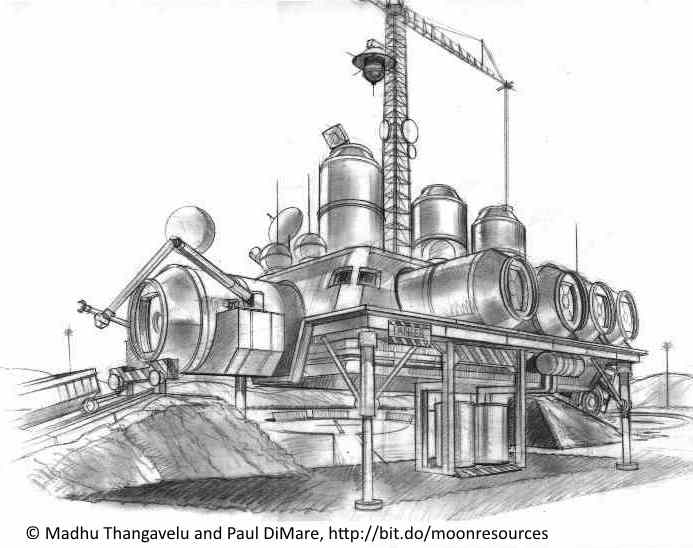
Hazardous Biology Facility on the Moon, telerobotically attended, surrounded by vacuum - Artist's impression, illustration by Madhu Thangavelu and Paul DiMare © from The Moon: Resources, Future Development and Settlement
If you return samples to a human occupied base on the Moon, then it's got the same issues as returning them to a human occupied facility anywhere.
As with anywhere else, like the above GEO idea, quarantine simply can't work unless you know what is in it and what precautions are needed. Even if they agreed, it's not at all clear you can ethically or legally commit humans to stay there for the rest of their lives, should it turn out to be potentially hazardous for humans or any other creatures or the environment of Earth (e.g. carried to Earth on the skin or inside bodies of humans). What do you do if they become ill and Earth is the only place they can be treated effectively?
But if you return it to a robotic facility on the Moon - well now, it's far better isolated than anything we could achieve on Earth, yet perhaps easier to build and work with than a large facility in orbit, especially if we develop infrastructure on the Moon. As with the facility in orbit, then it's fine to build it first, and then to send instruments to it, so long as it only goes that way, and any materials are sterilized in the reverse direction.
It could be useful for any hazardous biology generally, like an extra biohazard level above biohazard 4. So for instance if we wanted to experiment with synthetic biology using XNA in place of DNA, then we could use a facility like this on the Moon, to minimize any risk of it affecting Earth.
Even if the life did escape from the facility, e.g. after a meteorite strike, where would it go? About the only way it could be transported is via the levitating lunar dust, but that would surely be thoroughly sterilized by UV radiation before long. You could also turn the region around the facility into glass and remove any dust that strays onto that glass regularly.
You would have to think about the effects of larger meteorite strikes. And it would need to be evaluated by exobiologists, but seems very promising to me for hazardous biology!
One other suggestion, what about putting the hazardous biology facility in a lunar cave? There are many cave entrances discovered on the Moon now, and some of them might be not needed for human habitats and just lead to a small cave the right size for the facility. It might have smooth walls like a lava tube. Ideal for the facility. Protected from impacts by all except the very largest of the near Earth asteroids. And you could use a liquid airlock for the entrance, to have air inside as would be needed perhaps for some of the machines, but no risk of dust / air getting out onto the surface.
Returning samples to the Moon is a lot safer than returning them to the Earth's surface. However, the COSPAR guidelines for category 5 (sample return) missions currently say that
"(The Moon must be protected from back contamination to retain freedom from planetary protection requirements on Earth-Moon travel)".
So before samples can be returned to the Moon, that would need to be discussed and the guidelines altered. One issue I can see that would need to be looked into in detail is - what if the sample return mission crashes on the Moon somewhere different from its intended landing site?
This is a bit like asking how long a bit of string is. The surface of Mars is similar in area to the land area of Earth. If you had a couple of missions each to each of the Earth's main continents, how much would you learn about the makeup of Earth at ground level?
However, to make a start on it, Carl Sagan had to come up with a number of biological exploration missions, for one of his calculations. Writing in the mid 1960s, he assumed that about 60 missions to the Mars surface would occur before a human landing, giving enough time to get a first idea of the exobiology of Mars. He assumed 54 of those successful, and 30 flybys or orbiters, in a twenty year exploration phase before a human landing. So that's averaging nine missions for every opportunity to send spacecraft to Mars (See his "Decontamination Standards for Martian exploration programs").
So far we've had seven successful landers in the six decades since he wrote that: the two Viking spacecraft, the Mars Pathfinder lander (with its tiny Sojourner rover), Spirit, Opportunity, Phoenix and Curiosity. Of those seven, we have three landers able to travel kilometers, the Spirit, Opportunity and Curiosity rovers, and one tiny rover able to travel of the order of meters, the Sojourner rover. In addition, we've had 13 successful orbiters if I counted it right. And we have one extra lander and one orbiter on the way there right now (the ExoMars Trace Gas Orbiter and the Schiaperelli lander which is mainly just a technology demo and test for ExoMars, only able to survive a few days on the surface).
However, only two of those missions could really count as biological exploration - the two Viking missions. I think you could call the Trace Gas Orbiter, and Curiosity early stage pre-biological exploration missions. They could in principle discover life, but both would need a strong signal to have a chance to distinguish it from non life easily.
So that's only 4 missions so far with a strong biological focus: two stationary landers, one rover, and one orbiter. And only the Viking landers are really strongly focused on in situ life detection. You could say that Carl Sagan's planned "biological exploration phase " really started and then stopped immediately with the two Viking spacecraft. We have done no direct life detection tests on Mars since then, so I'm not sure if you can really include any of the missions since then as part of his biological exploration phase.
ExoMars in 2020 will probably be the first mission to be able to search for present day life in situ on Mars to some extent, and still is not as sensitive for this task as Viking was designed to be (with controversy of course about whether it discovered anything because of the unusual Mars chemistry). And even with ExoMars, its main focus is past life, with its search for present day life as a bonus. The area it's going to is not high on the list of candidates for present day life.
That's mainly because for about thirty years, most scientists thought that present day surface life on Mars was impossible. This is now changing, and on the plus side, our tools for investigating it have moved forwards by leaps and bounds since Carl Sagan's time, but the habitats on Mars have also turned out to be much more elusive than Carl Sagan could have imagined.
So I think we have to say that the biological search on Mars is just restarting, after a long pause after Viking in the 1970s. So, to venture a very rough guess, just based on Carl Sagan's numbers, it's at least a few more decades required. If we send, say, a couple of new landers for each launch opportunity, it would be 54 years to complete his preliminary survey, unless Mars exploration is stepped up hugely. If we can get it up to the levels envisioned by Carl Sagan or further, perhaps ten or more missions every two years, maybe we can do it in twenty years or less. Though, of course, in the other direction, if there is present day life on Mars, we might find it with the first mission to go to a promising habitat there. You never know.
Miniaturization may speed it up also, if we can scatter lots of smaller robots over the surface of Mars. See my Soaring, Buzzing, Floating, Hopping, Crawling And Inflatable Mars Rovers - Suggestions For UAE Mars Lander.
However, a swarm of 54 identical probes all sent to explore a single cave or a single region on Mars, and 30 identical orbiters similarly wouldn't hack it. Also, Sagan was thinking surely of missions with capability similar to Viking, so several instruments and very sensitive. We can certainly do with a lot less mass than Viking, today, and maybe we could get dozens of landers into a single launch of something like the Falcon Heavy, but they need to be carefully planned missions.
Imagine trying to get a clear view of the biological diversity of Earth with 54 landers, so about eight per continent, or in terms of countries, one lander for every three countries. When you think about it that way, it's not a lot to try to find out about a planet with a total land area similar to Earth, and with a complex and diverse geology.
There are many places we need to explore and dedicated missions for each. But if small, many of them could go on the same launch perhaps, then sent to many different locations on Mars from a mother spacecraft in orbit around the planet. Perhaps it could even send later missions in response to results of earlier ones.
This is a survey I did of some of the proposed surface habitats on Mars as well as some of the near surface ones. Are There Habitats For Life On Mars? - Salty Seeps, Clear Ice Greenhouses, Ice Fumaroles, Dune Bioreactors,... which may give an idea of the variety of possible surface habitats that have been suggested, most of them new suggestions in the last decade or so, and of course, the RSLs now confirmed to have liquid water (almost certainly) though not yet settled whether they are habitable or not.
So, what could we do if the funding was available to do an exobiological survey of Mars from Earth? I'd think you need a few missions to each of these targets myself:
There may be other places to target, but those are the main ones I can think of right away.
The orbiters would be like the Trace Gas Orbiter, searching for traces of gases produced by life on Mars as well as photographing the surface. For instance our photographs of the RSLs from orbit are all taken in early afternoon, the very worst time to spot effects of liquid water on Mars. That's because the spacecraft that takes those photographs is in an orbit that takes it closest to Mars when locally it's early afternoon there. We need orbiters to photograph Mars close up at other times of day such as early morning. We also need orbiters dedicated to broadband communications with Earth (probably doing their own observations of Mars as well). These would certainly be in place for human missions for Mars, best done right away at the biological survey stage.
With broadband communications, then instead of communicating with Mars once a day as is the current situation you have delays of between 8 minutes and 48 minutes there and back. So, between 15 and 90 times a day, or if you have powerful lights and are fully powered at night, between 30 and 180 times a day. When Mars is closest to Earth then with broadband you could do as much communication and control in one day as we currently do in a year. Or even more if you use artificial real time.
There would be some building on previous expeditions so I think you definitely can't do it all in one mission. You'd have survey missions and preliminary missions first, but if we had the funding, say a dozen missions every two years for twelve years :). Each wave of missions building on the previous ones, refining the search. Or some other combination including maybe building up to more and more missions as we get an idea of which places to target.
You'd also be looking for habitats with no life. If there are surface habitats, whether there is life in them or not, those are vulnerable to Earth microbes meaning that sending microbes there is irreversible so you want to know that too even if they are uninhabited. They could be of great interest for exobiology indeed, especially if they have complex organics, but no life, or "almost life". So it is specifically a search for present day surface habitats and life - or ones that are reasonably easily accessible from the surface.
If it's possible to get humans to Mars orbit, then they could oversee all these rovers on the surface, rather similarly to the game of Civilization. Many of those 54 landers would be doing routine tasks at any time, things they can do autonomously. They could be controlled remotely from Earth using broadband. But from time to time they'd be doing something more challenging and interesting and that's where astronauts in orbit would step in. So in that way, a half dozen astronauts in orbit could work with all of those 54 landers and more using telepresence.
For more about the potential habitats, see my Are There Habitats For Life On Mars? - Salty Seeps, Clear Ice Greenhouses, Ice Fumaroles, Dune Bioreactors,...
So, it's possible we could survey Mars more rapidly, but there aren't any planned missions yet to suggest we are going to do this in the very near future, as in, the next decade (say).
In the circumstances, if we send humans to Mars in the 2020s or in the 2030s, unless there is some big change, and someone does a large number of robotic missions first, we can't have anything like enough information by then to know what effect their microbes would have on Mars.
If you share Elon Musk's certainty that there is no life on the surface - which to be fair was the scientific consensus right up to 2008, then you may agree with his conclusions there. But ideas about Mars are changing fast, and we can't be so sure now about the apparent certainties of the early 2000s.
For this reason, I foresee a possibility of some kind of a confrontation, where experts who meet to make planetary protection guidelines for COSPAR just don't have enough information to say for sure if there is present day life or habitats for Earth life on Mars or not. So then it would come down to personal judgement. Experts who are skeptical about life on Mars might say to the Mars colonist advocates like Elon Musk, "Sure, go ahead, you probably won't do any harm". While those who are optimistic about the proposed habitats are quite likely to say "Slow down, we need more data". I wouldn't be surprised if the workshop was inconclusive with some saying it is okay and others saying it is not.
This potential confrontation was highlighted recently in my guest appearance on David Livingston's "The Spaceshow" on 3rd May 2016. I said, during the show, that it's possible that we might not have enough information for COSPAR to approve humans to Mars soon enough for Musk's plans, and also said that it is still a possibility that we could find out that there is vulnerable life on Mars. I was saying much the same things I've been saying in this book.
Anyway I expected this to be a controversial thing to say, knowing that many keen Mars advocates would be listening to the program - but I was surprised at quite how controversial it seemed. From the questions we got by email, it seems that many people would be very upset if their plans to attempt to colonize Mars were even delayed a few years because of issues such as this. David said that the possibility that planetary protection issues could delay their plans is never raised in the Mars colonization conferences at all, which are held every year in the States. So, if I'm right about this projection, it would be a great surprise and shock for them. What can we do to help defuse and resolve this possible future confrontation? This book actually came out of my deliberations after thinking over that show.
What's the way ahead? A compromise doesn't seem too likely to work, to me. If you try to reduce the number of microbes, but the exploration is still biologically irreversible, you haven't protected Mars from Earth life. Perhaps you've delayed its spread, and that's about it. That would be like responding to issues with the oriental fruitfly on imported fruit from Hawaii by saying that it must be kept out of California every day, except on the first day of every month. That would restrict the ability to import fruit and yet do nothing, or very little, to keep out the fruitfly, so nobody would be satisfied.
NASA is currently working towards the idea of an exploration zone, with the human occupied field station in the center, and robotic spacecraft heading off for in situ study around the perimeter, and returning samples to the center. This might seem a good compromise, with humans on the surface, but trying to limit the effects of the microbes by restricting human movement geographically.
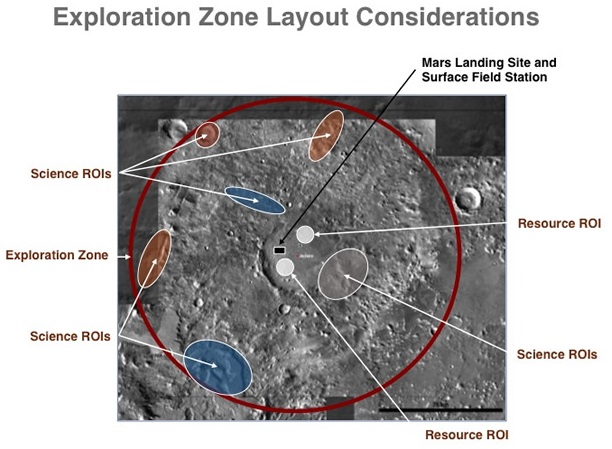
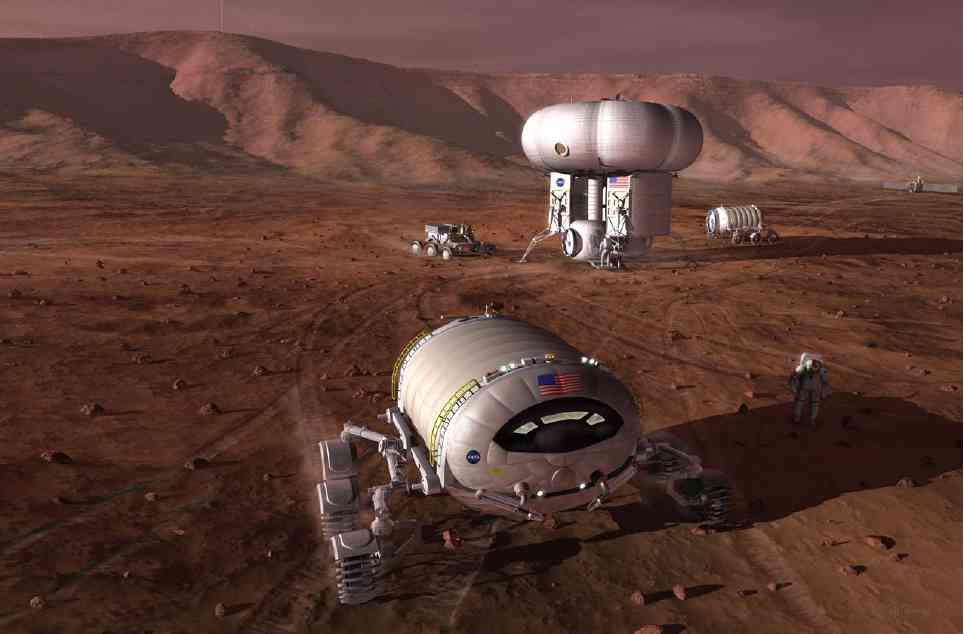
Here is another example, with the human exploration zone shown close to an area of special interest - the recursive slope lineae or warm seasonal slopes, which may have liquid salty brine seasonally, one of the suggested habitats for life on Mars:
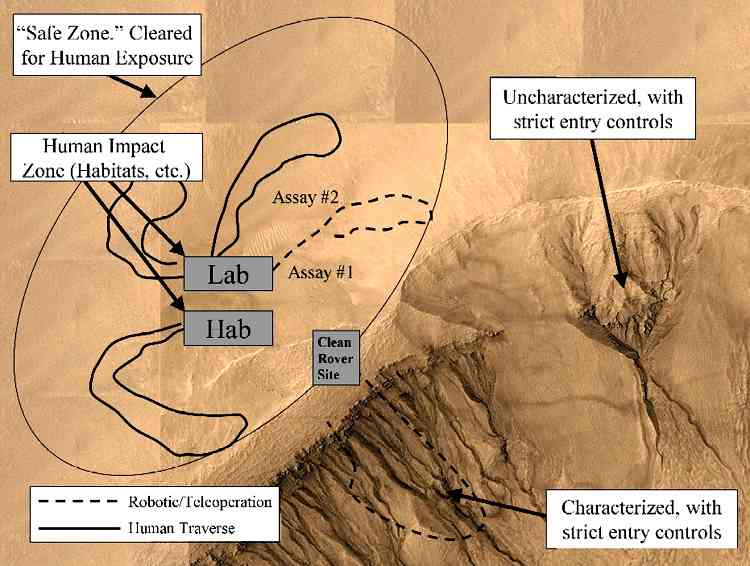
from: Mission to Mars: The Integration of Planetary Protection Requirements and Medical Support
As you can see, the idea is that the human exploration zone is contaminated with Earth microbes and this is just accepted as a necessary part of human exploration of Mars, but only clean rovers are permitted to travel to the habitats that potentially could host surface life on Mars. They bring samples back to the human base for analysis, or are used to study the site remotely.
That could work just fine on the Moon. If humans don't travel too far from their base, they will preserve pristine lunar surfaces just a few kilometers away, untouched by human footprints or wastes or debris from the habitat.
But how can this work on Mars with the Martian dust storms? That's my main question here for the scientists who suggest this approach. The main problem here is that microbes can form hardy spores, and on Earth these can survive for long periods of time, hundreds of thousands of years, and in rare cases, millions of years of dormancy. On Mars, they can get into cracks in the fine grains of dust and be partially protected from the UV radiation. And the numerous rocks on the surface will totally protect any microbes that get into their shadows from UV light. Even in equatorial regions, some areas under rocks will be permanently shadowed from UV light.
And then you get these:

This is a Martian dust devil - they race across the surface of Mars picking up fine dust and would also pick up any microbes imbedded in the dust.
The microbes would be protected from UV radiation by the iron oxides in the dust. HiRISE image from Mars Reconnaissance orbiter, of a dust devil in a late-spring afternoon in the Amazonis Planitia region of northern Mars. The image spans a width of about 644 meters.
The winds are very feeble on Mars in the near vacuum of the atmosphere. The strongest winds on Mars would barely move an autumn leaf. But the dust is also very fine on Mars and easily lifted by these feeble winds. And it's made of iron oxides too, which would help to shelter any spores imbedded in cracks in the dust, from UV light.
Then from time to time dust storms will cover the entire planet.
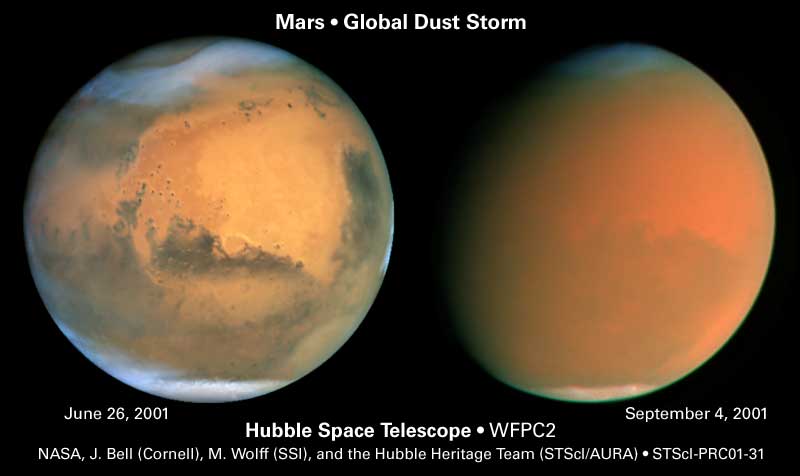
This relates to an observation Carl Sagan made Carl Sagan raised in an old paper "Contamination of Mars", back in 1967.
"The prominent dust storms and high wind velocities previously referred to imply that aerial transport of contaminants will occur on Mars. While it is probably true that a single unshielded terrestrial microorganism on the Martian surface - even the most radiation-resistant variety - would rapidly be enervated and killed by the ultraviolet flux, this by no means applies to all contamination scenarios. The Martian surface material certainly contains a substantial fraction of ferric oxides, which are extremely strongly absorbing in the near ultraviolet. In fact, apart from the ferric oxide identification, the red color of Mars clearly indicates major electronic transitions at short visible wavelengths. A terrestrial microorganism imbedded in such a particle can be shielded from ultraviolet light and still be transported about the planet."
He continues:
"A single terrestrial microorganism reproducing as slowly as once a month on Mars would, in the absence of other ecological limitations, result in less than a decade in a microbial population of the Martian soil comparable to that of the Earth's. This is an example of heuristic interest only, but it does indicate that the errors in problems of planetary contamination may be extremely serious."
Of course we know much more about Mars than they did back then. But the situation is still the same, the dusts do indeed contain large amounts of iron oxides. We have also found out that some microbes are far more UV hardy than realized in the 1960s. The dust storms and high wind velocities are the same as in the 1960s. The dust does contain perchlorates, which they didn't know back then, but microbes can survive exposure to perchlorates at the low temperatures on Mars.
If the spores can survive a few hours of exposure to UV within a dust storm, as some experiments suggest, they could be transported considerable distances. Those results suggest they could survive at least twelve hours of being blown over the surface within a Martian dust storm. See also Survivability of Microbes in Mars Wind Blown Dust Environment. Also, I think it might be worth considering the possibility that in addition to those twelve hours of daylight, spores could be transported at night during a dust storm, when there's no UV light, yet still dust suspended in the atmosphere.
With wind speeds of 10 to 30 meters per second average for the faster winds during a dust storm, then the spores could travel 20 to 60 miles in an hour, or 240 to 720 miles in twelve hours. Also, if they end up in a shadow at the end of that, they will then be protected from UV radiation until the next time they get transported by the winds. If the human habitat is positioned close to a special region as in the suggestion by Jim Rummel above, these figures suggest that they might get to a vulnerable region in a dust storm in much less than twelve hours.
So it would seem that Carl Sagan's concern still applies when you take into account this modern research into survivability of microbes in dust storms. My question for research here is, can a Mars exploration zone be kept biologically isolated through a Martian dust storm? As far as I can see, this plan could only slow down the advance of Earth life over Mars. The accidental introduction of Earth microbes would still be biologically irreversible after a human landing, if there are viable habitats for Earth microbes on Mars.
If there are any habitats for it to spread to, then it would get there eventually, carried in the dust. And that is the very thing we can't know by the 2020s or even the 2030s probably, except in the positive direction by confirming one of the many suggestions for habitats on Mars. So, a compromise solution like this wouldn't really work I think.
Then as well as that you have the issue of a crash. It doesn't seem too likely that we'll achieve 100% reliable spacecraft to land humans on Mars in the next few decades. So what happens if the spacecraft crashes? That would seem to mean an end to planetary protection of Mars. I'll look closer at this human spaceship crash on Mars scenario later in the section: What if there seems to be no alternative? - we must have Mars!
There is another kind of compromise, to put the human base in orbit, and we'll come to that later (in Telerobotics as a fast way for humans to explore Mars from orbit). That could be just fine for planetary protection. But the Mars colonization enthusiasts are dead keen to send humans to the surface, not just to orbit.
So, to try to see this in perspective, first lets try to look at something much smaller. Suppose you want to build a house and need to fill in a pond. You get an assessment done, and you are told that this pond is the breeding ground of a rare form of amphibian. In the UK it could be the great crested newt.
You might not give it a second glance, but this is a European protected species. Your would not be permitted to just build on its pond, but would have to preserve the pond and build somewhere else.
Of course some people couldn't care less about whether it goes extinct. But others do, and it's accepted, that we have to have laws like this to protect endangered species. It's not a big deal if you don't care for great crested newts. You accept that others do, so you just build somewhere else. I gave the example also of the oriental fruit fly which makes fruit unfit to eat and so you can't import some fruit and flowers into California from Hawaii. It's an annoyance I'm sure for fruit importers, but it is something they understand the need for, and so most will just keep to the regulations.
For another example, the Kakapo, a flightless parrot, is very trusting and vulnerable to cats, dogs, etc.

I think most people would understand and accept that you can't have cats and dogs on islands inhabited by the Kakapo. And similarly it's easy to understand why you wouldn't be able to get permission to melt through the ice above the Vostok lake in Antarctica to put a human occupied submersible into it and cruise around. That's perhaps the closest to Mars planetary protection, because there, the aim is to keep microbes from the surface out of the lake.
But where it gets much harder to cope with is if there seems to be no alternative. The Mars colonization enthusiasts want to colonize Mars. If the planetary protection rules were enforced as strictly for humans, as they are for robots, it would certainly keep humans away from Mars altogether. I think everyone would agree with that much. There is just no way you can sterilize a human occupied lander to robotic standards, because of the trillions of microbes that live in and on the human body, also in our food, and in the air.
Also, if you assessed human landings on Mars in the same way you do for a robotic mission, you'd have to do planetary protection assessments of the effects of a "hard landing", i.e. a crash on Mars, as I looked at in this booklet:

Can We Risk Microbes From Human Crashes - On Mars? If Not, What Happens To Dreams To Colonize The Planet?
The only way humans could be permitted to go to Mars surface under COSPAR recommendations in the near future would be if they had a consultation that reduced the planetary protection requirements to much less than that needed for robotic spacecraft. Also they would have to just choose not to investigate the effects of a crash of a human spacecraft on Mars (because that would count as an immediate fail of planetary protection). And if a human occupied spacecraft did crash on Mars, I think that would pretty much be the end of planetary protection for Mars.
The result seems inescapable to me -, if humans go to the Mars surface, we would probably have to relax the requirement of biological reversibility. Even if the microbes did not encounter any habitats on Mars, the spores would be spread over the surface in the dust, and it would probably be impossible to "put the genie back in the bottle".
Spores last for a long time, especially if they can get into a shadow, protected from UV light, and even more so if they get into a cave. They can sometimes last for millions of years on Earth. Eventually, in the global dust storms, some of those spores would encounter habitats, if there are any at all on Mars. They'd still be there thousands of years in the future also, to potentially cause problems with plans to transform Mars. For instance, if we try to roll back to early Mars, or to do step by step terraforming, or other transformations based on introducing some species before others (ecopoesis), these pesky spores could scupper all our plans.
It would still not be a confrontation if you could land humans somewhere on Mars isolated from everywhere else. But the Martian dust storms turn the whole planet into one connected system, apart from a few places perhaps, like the crater at the summit of Olympus Mons (on short timescales of thousands of years anyway, so long as it doesn't erupt). And even if you aim for the crater at the top of Olympus Mons, there's a possibility that the spacecraft crashes somewhere else on Mars during the landing attempt. And it might not be totally isolated even at that height surrounded by the rim of the crater.
So - it's like the example of the island of the flightless parrots, the Kakapos, or the pond for the great crested newts, except that it is now a planet sized "pond", and a planet that some humans want to attempt to colonize. And there seems to be nowhere on Mars that would be truly isolated.
Anyway - this becomes a confrontation when you think there is no way ahead. If you can just move your house to avoid the pond with the great crested newts, no problem. So that's when I realized, that what is needed is an alternative vision, somewhere else in the solar system that is as good as Mars. You can use the asteroids, and Phobos and Deimos for materials to build habitats, and some space advocates are very enthusiastic about such ideas. But for others similarly minded to Elon Musk, the asteroids don't quite cut it. Mars may seem a lot easier in some ways than building habitats from asteroids. At any rate, it may seem a rather different direction of space settlement, a different kind of vision.
But what about the Moon? Could that help defuse the situation? I was already a "Moon firster" and was aware of some of the material on the subject. But until I wrote this book, as I've said, I had no idea quite how many points there were in favour of the Moon as a place for human habitats and ISRU. Depending on what we find when we explore, study and prospect further, the Moon might actually be better than Mars for this. So - like the house builder moving the position of their house to deal with the issue of the great crested newt pond - is it possible that the Mars enthusiasts can move their base to the Moon, and use much of the same ideas for ISRU there, instead? For the first few missions at least?
Meanwhile also of course, we would explore Mars, and eventually send humans there, to explore it from orbit. We can also use many of the ideas for Mars Direct, and other Mars architectures to send robots to the surface - highly capable fast moving rovers fueled by the methane fuel that are used for humans in those designs. Similarly, use the Mars stationary satellites over the base to relay signals back to Earth via broadband.
In this way we can get some breathing space, of a few decades, hopefully, to find out about Mars on a scientific level. To find out if there are habitats there for Earth life and search for exobiology. Meanwhile, you are also building up an infrastructure on Mars and in Mars orbit that would be useful if we did ever decide to send humans to Mars. Or indeed, it could be useful for other things too, anything we might do on Mars. Perhaps you decide to try ecopoesis (duplicate the biological transformations of early Earth on much faster timescales), or turn the clock back to early Mars, or transform it in some other way, or even grow plants there (plants could be grown on Mars using sterile hydroponics without impacting on any native Mars life, since seeds can be sterilized). There would be many possible futures still open to you at that point.
Also meanwhile we can work on space habitats, closed systems, eventually build city domes on the Moon and large closed systems in the lunar caves, continue to explore ideas for creating larger and larger self sustaining habitats. Whether we eventually get to the point of terraforming entire planets, I think can be left to later, until we have much more understanding than we have now, with these early experiments. So, then it becomes an open path, where instead of closing off futures, we open out to more and more possible futures, and wider vistas at every step. These vistas don't just include Mars either but many destinations for humans in the solar system.
If this approach is valid, I'm sure it will still be a slow process. People don't change their ideas overnight, especially if they have been working for decades to try to get humans to Mars. And this is just one vision, which has to be part of a debate, to explore possibilities. But I hope perhaps that with this book I'm helping provide a greater diversity of visions for the future. :).
The idea isn't at all to prohibit humans on Mars. The humans are not the problem; it's only their microbes that are. And the idea is to do it step by step and to make sure we understand Mars and understand the implications of our actions before making a decision about whether it is okay to have human boots on Mars.
I'm a spaceflight and science fiction enthusiast myself and I'd love to be able to cheer on humans on an expedition to Mars. Just for the childlike wonder of seeing humans doing things like that in space. So it would be fun to see humans go to Mars. And at least we can send them to Mars orbit whatever we might discover about the surface - so long as it is done with care to make sure that they can't crash on Mars.
You couldn't do aerocapture in the Mars atmosphere as a way to get into orbit. It would be far too risky. Also Hohmann transfer with insertion burns are too risky also, as the insertion burn is done as close to Mars as possible to reduce the amount of fuel needed due to the Oberth effect. So you would need to be very sure that the insertion burn can't go on too long and end up on an impact trajectory with Mars.
I suggest ballistic capture is a far better method for human missions to Mars. The idea is that you launch the spacecraft to arrive ahead of Mars at just the right point for it to capture you as a temporary satellite. Once you leave Earth, you are already on a trajectory that ends up with your spaceship getting captured temporarily in a distant Mars orbit when it gets there, with no need for an insertion burn. Then once you are in that orbit, you use ion thrusters to spiral down to lower permanent orbits around Mars.
This is surely the safest of all the ways proposed to get into a Mars orbit, and the best way to prevent a crash of a human occupied spaceship on Mars.
Then you also have the flybys. Flybys are safe because although they involve precision targeting, you have months to set the target up. Also, the ones that are of most interest for Mars are free return, so even if your rocket fails, you are still on an orbit that will take you back to Earth again. You would use trajectory biasing of course, so that as you leave Earth you are biased away from Mars rather than towards it and use fine adjustment then to target the flyby orbit.
We have done many flybys, delicate ones, repeatedly for Saturn's moons with Cassini, and get them right every time, so it is obviously one thing we know how to do reliably. This has no time critical insertion burns. Just gentle thrusts nudging until you are in the right trajectory, which you set up long in advance of the actual flyby.
So, especially Robert Zubrin's double Athena flyby - a very interesting mission - is safe for humans to Mars. This has two flybys of Mars. The first diverts you into an orbit that closely parallels Mars for half of its year, so a full Earth year. The second flyby takes you back to Earth 700 days after the launch. It's free return - once you leave Earth you are already on a trajectory that will take you back to Earth 700 days later even if your rocket motors fail completely.
It's a great orbit for telerobotics as you spend several hours close enough to Mars for direct telepresence with each flyby, and days close enough for significant advantages relative to Earth, and over the entire one year period when you are almost paralleling Mars in its orbit, your crew are much closer to it for controlling robots on the surface than anyone on Earth.
Telerobotics lets us explore Mars much more quickly with humans in the loop. And you'd use an exciting and spectacular orbit for early stages of telerobotic exploration of Mars, following the HERRO plans. It comes in close to the poles of Mars, swings around over the sunny side in the equatorial regions and then out again close to the other pole, until Mars dwindles again into a small distant planet - and does this twice every day.
Imagine the view! From space Mars looks quite home-like, and the telerobotics will let you experience the Martian surface more directly than you could with spacecraft, actually touch and see things on the surface without the spacesuit in your way and with enhanced vision, blue sky also if you like. It's like being in the ISS, but orbiting another planet.
12th April 2011: International Space Station astronaut Cady Coleman takes pictures of the Earth from inside the cupola viewing window.- I've "photoshopped" in Hubble's photograph of Mars from 2003 to give an impression of the view of an astronaut exploring Mars from orbit.
This is a video I did which simulates the orbit they would use - in orbiter. I use a futuristic spacecraft as that was the easiest way to do it. Apart from that, it is the same as the orbit suggested for HERRO.
It would be a spectacular orbit and a tremendously humanly interesting and exciting mission to explore Mars this way. The study for HERRO found that a single mission to explore Mars by telepresence from orbit would achieve more science return than three missions by the same number of crew to the surface - which of course would cost vastly more. Here is a powerpoint presentation from the HERRO team, with details of the comparison.
Then, you'd also have broadband streaming from Mars. As well as being very safe, also comfortable for the crew, you'd also have wide-field 3D binocular vision. It's amazing what a difference this makes, I recently tried out the HT Vive 3D recreation of Apollo 11. We'd have similar 3D virtual reality experience of the Mars surface.
Also, it would actually be a much clearer vision than you'd have from the surface in spacesuits, digitally enhanced to make it easier to distinguish colours (without white balancing the Mars surface is an almost uniform reddish grayish brown to human eyes)|.
Here is this hololens vision again, which though it's not telepresence, I think gives a good idea of what it might be like for those operating rovers on Mars in real time from orbit, some time in the future with this vision.
It's safer too. No need to suit up. No risk from solar storms - at worst you have to go to a storm shelter in your spaceship, not rush back to your habitat as fast as you can to get out of the storm in time. No risk of falling over and damaging your spacesuit. And when you need to take a break, have your lunch, or whatever, you can just take it up again where you left off, indeed leave the robot doing some task while you have your lunch or sleep.
That's not to say that humans to orbit controlling robots on the surface would be better than robots controlled from Earth, bearing in mind the costs of the two types of mission. I don't know if anyone has done a comparison study there.
You might be able to compensate for the advantage of humans in orbit by having many more robots on the surface for the same cost, especially if broadband communication is possible, better robotic autonomy, and techniques from gaming such as artificial real time (building up a copy of the Mars surface explored by your robot in your computer on Earth and navigating that to help speed up movement from a to b on Mars).
But a human expedition might well capture the public imagination and so permit a much faster exploration of Mars from orbit. And would be an exciting and fun expedition to follow, and interesting for the crew too.
As a later mission you could then go on to explore Phobos and Deimos. They have many advantages for exploration. For instance Phobos has meteorites and micrometeorites throughout its surface layer of regolith, from the entire history of Mars, back to when Phobos first formed or was captured. This probably includes meteorites from the time when Mars had global oceans and then later on, lakes. Our Mars meteorites on Earth all left Mars no more than twenty million years ago (because the terrestrial planets clear their orbits so NEOs have to be replenished over a twenty million year time period).
Deimos also has a Mars facing crater which helps protect it from cosmic radiation, and solar storms - Mars obscures it from the sun in its local daytime, except for a few hours a day. Deimos may well have ice too, as it is related to a type of asteroid that often does have ice in its constitution.
There are many other advantages and points of interest of Mars' two moons.
For more on this, see my:

Exploring Mars By Telepresence From Orbit Or Phobos And Deimos
So, how soon can we do such a mission? I suggested that while we explore the Moon robotically, we work on closed systems research, and also artificial gravity in LEO. That makes sense for a Moon base which you plan to keep occupied for years on end. But what about a first flyby of Mars? When could we try that?
The HERRO comparison was just a small scale study, done several years ago. But I don't know of any other. It's surely high time that we had a much more thorough and detailed comparison study of the various possible ways of exploring Mars.
We may get practical experience of telerobotics in space with lunar missions in the near future. When that happens I think we'll find that machines are far more capable than they were in the days of lunakhod, operated from Earth most of the time, semi-autonomous, route finding on their own, able to do many things just by themselves with occasional help from Earth.
In a situation like that - operated remotely from Earth, or semi-autonomous, doing a lot of their own driving from place to place and then the crew in orbit around Mars step in to control robots that need particular help. I think that it would be much more than a 3 to 1 ratio compared with them working directly on the surface in spacesuits.
And everything they saw would be streamed back to Earth in HD meaning that after an astronaut has just walked past a place and maybe glanced at a rock via telerobotics, amateurs and experts back on Earth can explore that footage with the same direct telepresence, binocular vision etc. experience, and maybe alert them to something they missed.
I think a proper comparison study has to take all of this into account. I think a proper comparison study is probably best done by neutral parties or best perhaps, a workshop / panel that includes proponents of both sides in the debate as well as neutral parties. The cost of such a panel or workshop would be peanuts compared to the costs of the missions that we might commit to in the future for the exploration of Mars.
We don't need biological closed systems or efficient mechanical recycling for short duration missions into space. For very short duration spaceflight, such as the Apollo missions to the Moon, we can use open systems with no recycling at all.
So when does the break-even point come, where it's worth the extra mass to send a system with better recycling into space? Maria Johansson worked it out for us in her thesis from 2006, which I summarize in Could Astronauts Get All Their Oxygen From Algae Or Plants? And Their Food Also?
The area you need to grow all the food for the astronauts is far less than you might expect from field agriculture which typically requires about an acre (4,000 square meters) per person. If you use hydroponics or aeroponics, and rapidly growing crops, this can be reduced hugely. In the BIOS-3 experiments, the Russians needed only 30 square meters of growing area per crew. The crops were grown on a culture conveyor with 2 to 10 plantings of different ages simultaneously. They grew wheat, sedge-nut, beet, carrots, and other crops, ten crops in total. With those 30 square meters per person, they produced 95% of the daily requirement for oxygen, water, food etc (by weight), reducing the supplies needed per day for the crew of three from 13.01 kg to 0.5982 kg. The remaining 5% consisted of animal products, salt for the humans, nutrients for plants and personal hygiene supplies. They could produce 45% of the food and nearly all the oxygen and water with only 13 square meters.
This section is mainly calculations. Skip to the next section if you just want to read the conclusions. I've done the best here using the materials available, but there are gaps in the calculations as you'll see. Maybe it gives a good first idea however, a rough picture to get started and highlight some of the main questions.
The three systems she looked at are BIOS-3 developed by the Russians, MELiSSA which is under development by the ESA and the system used currently on ISS. The main difference between BIOS-3 and MELiSSA is that in BIOS-3 the plant wastes are burnt, while with MELiSSA they are composted (which adds a fair bit to the mass of the MELiSSA system). Burning the plant wastes is not as wasteful as you would think as it just completes the cycle with the CO2 produced incorporated in the next generation of plant growth. Both BIOS-3 and MELiSSA are closed systems which recycle just about all the carbon dioxide, oxygen, and water.
The MELiSSA system is not in the picture for the shorter duration missions, with a startup mass of 15,711 kg for four people - it is a hydroponics system and the water takes up most of the mass at 8.89 tons, and much of the rest is taken by the centrifuges at 2.8 tons.
The ISS used 6.5 kg per day for four people. Or 1.635 kg per person. With a startup mass of 1773 kg. The BIOS 3 system uses 0.5 kg per day for four people, so a tiny amount. But that's with a startup mass of 6250 kg for BIOS-3 .
Note though, that this is before the new approach of recovering the oxygen from exhaled carbon dioxide using the Sabatier reaction which reduces the daily mass requirement but increases the startup mass. It also omits some the mass required for resupply of parts, and spares.
A more recent calculation for the ISS (or as a pdf) makes the startup mass (upper bound) 2,563 kg/person or 10,252 kg startup mass for a crew of four and supplies of 467.1 kg/person/year or 5.12 kg per day for a crew of four.
So, in this section I'll do my best to work it out from those figures, but it probably needs to be looked into in more detail. I can't find a more recent comparison of the mass needed for mechanical recycling with that needed for biological recycling in the literature, Maria Johansson's thesis seems to be the only source to attempt this (do let me know if you know of any other material on the subject).
I think the ongoing logistics figures are probably reasonably accurate here, and the 0.5 kg / day of BIOS 3 for a crew of 4 is a lot less than the 5.12 kg day for an ISS type system. I'm not so sure about the startup masses. She has a lower figure for the ISS than the more recent figures. And for BIOS-3 her figure does not include the mass for the habitats used for growing the plants.
The paper just cited suggests that the BEAM module for the ISS would supply food for a crew of 2, with mass of 1,360 kg for the module, which seems reasonable. So for a crew of four, that would be 2720 kg, so I'll add that to Maria Johansson's figures, making the startup mass 2720 + 6250 or 9320 kg. If these figures are right, then a BIOS-3 type system would score over an ISS type system from the get go with less startup mass as well as providing a somewhat more spacious spaceship with two BEAM modules added to it.
Both are much better than open supply even for short duration flights, as those require 12,775 kg per person per year when you include everything. That's about 140 kg / day for a crew of four. Another source though puts it at 38.1 kg / day for a crew of four. I'll go with the lower estimate here.
So, assuming a crew of four, which I think sounds about right for a very minimal interplanetary mission, then for Dennis Tito style 589 day flyby, that's
589×5.12 +10,252 kg = 13,267 kg for the ISS type system
589×0.5+ 9,320 kg = 9,614.5 kg for BIOS-3
(589×140 = 82,460 kg with no recycling - larger estimate)
589×38.1 = 22,460 kg with no recycling
For a 700 day mission such as Robert Zubrin's double Athena:
700×5.12 +10,252 kg = 13,836 kg for the ISS type system
700×0.5+9320 kg = 9,670 kg for BIOS-3
(700×140 = 98,000 kg with no recycling - larger estimate)
700×38.1 = 26,670 kg with no recycling
If you know of good sources to use to refine these calculations or any other comparisons of the biological systems with the ISS type system since Maria Johansson's thesis, do say!
If those figures are approximately right, then biological recycling would save on the ISS system for all durations of mission. Break even for BIOS-3 over a mission with no recycling would happen after = 9320/(140-0.5) or 67 days and for the ISS type system at 10252/(140-5.12) = 76 days. So those forms of recycling are worth doing for missions of more than a couple of months or so, and biological recycling such as BIOS-3 works much better than the current ISS for very long duration missions.
However we know how to do the ISS system right now, while BIOS-3 hasn't been tested in space. Also, BIOS-3 probably wouldn't work so well in zero g as plants behave differently in zero g. If combined with artificial gravity, it looks promising to be better than the ISS system. So if the astronauts were in artificial gravity for health, and also grew crops using aeroponics and hydroponics, then the BIOS-3 system seems likely to work well.
So far we have no information about how well the crop plants of BIOS-3 would do in lunar gravity. They might do fine, or we might be able to breed plants or use genetic manipulation to get plants that grow well in lunar g. Also, just as for interplanetary and orbital missions, we could have artificial gravity to augment lunar gravity if necessary, centrifuges around a vertical axis for the plants, wouldn't have to rotate that quickly, for instance a 1 meter radius centrifuge, 30 rpm, tangential velocity 3.13 meters per second (seven miles per hour) produces full gravity, which seems practical enough for plants in a lunar greenhouse.
Where much more efficient recycling really scores is for long duration missions. That could also make a big difference for safety factors. Suppose you want to add a safety factor of two years to a mission to Mars orbit, in case they are stranded ed in Mars orbit, and need resupply from Earth, only possible every two years. Then the figures for the extra mass needed for a two year extension for four people are:
730×5.12 +10,252 kg = 13,989.6 kg for the ISS type system
730×0.5+ 9,320 kg = 9,685 kg for BIOS-3
730×140 = 102,200 kg with no recycling (using larger estimate of 140 kg / day for a crew of four
730×38.1 = 27,813 kg with no recycling (using lower estimate of 38.1 kg / day for a crew of four).
If you have a longer, ten year mission, it's going to make a huge difference to have biological recycling. This also makes a big difference for the lunar base - once you have people living there for years on end.
These figures change a bit if you also add in the cost for developing new systems. Resupply without recycling has the least development costs.
For a long mission such as a mission to Mars with no "lifeboats" to get you back to Earth, then you also have to factor in the need for redundancy. Adding triple redundancy for everything for the start up mass, then for a 700 day mission for four, you get
700×5.12 + 3×10,252 kg = 34,340 kg for the ISS type system
700×0.5 + 3×9,320 kg = 28,310 kg for BIOS-3
700×140 = 98,000 kg with no recycling (using larger estimate of 140 kg / day for a crew of four)
700×38.1 = 26,670 kg with no recycling (using lower estimate of 38.1 kg / day for a crew of four).
The no recycling option still requires a lot more mass. But with triple redundancy, it can actually be less mass than the recycling options. Then as well as that, you can throw away the mass as it is used up, so by the time you get to Mars, the amount you need to boost back to Earth is reduced, so less fuel is needed to accelerate your spacecraft if you need an extra burn to get back to Earth (this will make no difference for free return flyby missions however as all the acceleration is done at the outset as you leave Earth).
For a Mars base, if we did send humans to the surface, resupply works better than recycling for short missions of 500 days or so. Here is a breakdown of the costs for the various styles of mission, including cost break downs for lunar missions: The Life Cycle Cost (LCC) of Life Support Recycling and Resupply.
You could also use a hybrid mission, with some biological and some mechanical components, which you could do because the ISS type system is the one most thoroughly tested to date, but it could be worth adding some easily testable biological systems. A simple form of redundancy would be to add algae to a mechanical system like the ISS.
Algae are extremely low mass for the amount of recycling they do. By the figures for Bios-1, a Russian experiment carried out in 1965, you require 18 liters of algal culture per person to scrub the atmosphere and provide all the oxygen they need. So around 18 kg per person, or just 54 kg for the entire crew of six. You also need containers, and solar collectors. It needs to have a surface of eight square meters exposed to light per person which you achieve by filling the container with light pipes to pipe light into its interior. So you also need light tubes to pipe light into the middle of the mixture. For the algae, they used chlorella which is toxic and inedible by humans, but does a great job of producing oxygen.

This shows the chlorella cultivar used in the originally rather secretive Russian BIOS-1 experiment. Image from this paper. I can't find much by way of details of its construction so far and how it worked. But the principle was simple - supply lots of light to Chlorella algae and it photosynthesizes, absorbs carbon dioxide and produces oxygen. In modern designs, they do this by piping light into the container using light tubes, which gives you a compact design.
In the first experiment it was in a separate room, tended from outside, and supplied all the oxygen for a single volunteer. In BIOS-2 they put the cultivar inside the habitat, recycled other wastes as well, and produced some crops. In BIOS-3 they made the habitat larger, with a crew of 3, and changed to growing crops as their sole source of oxygen.
I can't find a total mass for the equipment as the BIOS-1 summary doesn't go into a great deal of detail, but it doesn't require much space to install it and it can't be that massive.
So how long does a mission have to be, for it to be worthwhile to include green algae as a way to reduce the amount of mass supplied to the mission? You are saving 0.84 kg of oxygen a day per astronaut over a system with no recycling (from table 2 of this paper). This makes, the time for payback of the mass of the algae mixture alone, through oxygen savings, 18 / 0.84 or 21 days. So, in terms of payload mass, there is no point in doing this for missions less than three weeks. The exact timescale for payback would depend on how much mass of extra equipment you need. For instance if it is roughly half in half algae and equipment, the payback period is 42 days.
When you take account of the light collectors to collect sunlight from outside the spacecraft and pipe it in, and the light pipes that must pervade the solution, it is probably going to be a lot more mass. I don't know of any detailed figures for the mass of those, I've searched but can't find any figures. If anyone knows of any do let me know. But the payback time is surely going to be of the order of months rather than years.
This approach really scores long term, as a low mass system. It would only be a modest amount of mass compared to the payload of a three year mission to Mars orbit and back, say, and the algae give you a way to buy extra time in a situation where something goes wrong with the carbon dioxide scrubbing and oxygen recovery. Even if the mechanical life support system fails when you leave Earth, with the prospect of having to come back to Earth via Mars before you can repair it, even then, you have a chance that the algae could save the life of the crew.
I'd say it is more reliable too. There is very little by way of equipment to go wrong, and if anything happens to the algae, then so long as you have a few viable cells left, you can just grow a new batch. Try doing that with machines. Also, it would last indefinitely, with no mass supply per day needed. The algae grow on the carbon dioxide exhaled by the astronauts. All that is necessary is for the astronauts to have enough food to eat, taken along as provisions. So long as the astronauts eat well, they will produce more than enough carbon dioxide for the algae to grow, and so it will continue to produce more than enough oxygen, with no need for any other supplies.
This idea of using algae for oxygen is being explored on the ISS with occasional experiments there. It's part of the MELiSSA project.
They use Spirulina which is better than the Chlorella used in BIOS-3 because it is edible, nutritious and safe to eat with no toxic byproducts. It contains 60% protein and has all the amino acids though with less methionine, cysteine and lysine compared with meat and milk. It's a decent source of protein but has to be supplemented with vitamin B12. It's not such a good source of carbohydrates however, so though it can supply all the oxygen needed in a small space and with not much mass, and can provide some of the protein the crew need, it can't supply all of their food.
It could replace part of the mechanical systems, or double up with it. It worked fine for BIOS-1 and the only reason they went on to crops later, was because they wanted to see if they could grow all the food as well. The spirulina algae used in modern algae recycling systems are also edible, though they can't provide a complete diet, so some of it would be used to supplement food.
Some worry about reliability of these biological systems. But they don't have soil borne pests, and as for airborne pests, only whatever you might have in the habitat (e.g. mold). The BIOS-3 system was very reliable. And as for algae, then if you get some disaster that kills nearly all the culture, then as long as you have a few cells left, then it will recover quickly. It's more reliable than a mechanical system in some ways - you don't need spare parts for the vital components, can just grow more of them in the presence of light and water.
It could be a multi-redundant system for extra safety. Choose whichever works best, the algae or the mechanical method as your main system and the other as backup, or both at once, but with capacity enough so either can also work on its own. That's something you could test quite easily at an early stage in LEO also.
Also another technology that could be useful in a hybrid system is the food printer. This reduces waste, and deals with issues of storage and food going off / getting stale.
Video from 3D food printer in space.
And more here
And here is a commercial 3D food printer which is going to be available in market.
The logistic figures support the idea that you could send humans to Mars at an early stage with life support based on the systems already used in the ISS. The ISS systems have failed several times, but what we have now may be reliable enough for a Mars mission. It's hard to be sure though, with a sample size of 1. In a recent evaluation the conclusion is:
"With several readily apparent exceptions, WRS [water recovery system] and OGS [oxygen generation system] equipment has been shown to be capable of achieving operational lifetimes on the order of those needed to support such missions. It is important to note, however, that the sample size represented by the fleet of WRS and OGS ORUs (Orbital Replacement Units) that have been used in operational service remains very small (sample size of 1 in most cases) and that statistical reliability predictions cannot be supported by this data alone. Furthermore, other challenges likely to be faced in developing Mars transit and surface vehicles, such as mass and volume constraints, water and oxygen loop closure needed to support mission scenarios, dormancy management, equipment reparability, etc., also will need to be considered as part of an integrated Mars exploration mission and vehicle design. But in terms of highlighting first-order trends and focus areas needing improvements, the daily operation of the ISS WRS and OGS is providing an invaluable first step towards human Mars exploration. "
So how would that work out? If your main aim is to send humans to Mars, I think you would need to start with a "shake down" cruise in LEO testing the actual systems you would use for the mission for a similar duration mission in LEO with no resupply from Earth.
You wouldn't need to go to the Moon for this. However, I have a suggestion here for a shakedown cruise. Of all the interesting missions we could do in the Earth Moon system, the one most like a Mars flyby or orbital mission might be a mission to the Earth Moon L2. They'd have the psychological isolation of living for several years with Earth not visible at all, hovering over an alien landscape (in some ways more isolated than a Mars trip with the Earth visible as a star in the distance if you know where to look).
It would also help with lunar exploration and you could do teleoperated exploration of the far side of the Moon which would prepare you for telerobotic exploration of Mars. And it would be a similar cosmic radiation environment to the mission to Mars. It would be an interesting mission, with the crew doing many tasks of value so not just a "makework" mission, with many of the challenges of a mission to Mars. Yet it's safe also, permitting "lifeboats" to get you back to Earth within three days, or resupply in an emergency if the equipment fails.
As for the mission to Mars, flyby or orbit, itself, the calculations suggest that you could do it with only the systems we already use in the ISS. I wonder if it might help to look into the option of adding algae recycling as that's low mass and a simple system to test, and could give more time to solve problems in an emergency.
So, to sum it all up, if we have developed closed system biological recycling by then, it has the advantage that you don't need to add much mass to the system to allow for unexpected extensions, even of several years. I think the biological one is safest for that reason, if it turns out to be equally reliable. But if you want to go to Mars at an early stage, the ISS approach is better tested and lower mass. Perhaps a hybrid system with algae for oxygen generation might be worth looking into because even though it would add to the mass, the extra mass is low and it would add a safety margin for oxygen generation and carbon dioxide scrubbing.
We could decide what to do later on, based on what we find out. If we find that there is some vulnerable early RNA based life on Mars for instance, I think that public opinion might well swing in the direction of saying we need to go slow here, and study it first before doing anything that could make it extinct on Mars. The scientists would be on the TV talking about how exciting it is, and I think nearly everyone would soon understand the importance of what we had found.
In the other direction, there might be other findings that show that microbes would have minimal impact on Mars. For one example, suppose that none of the proposed habitats turn out to be habitable for Earth life? I think that's an unlikely scenario myself, and it would be a disappointment for exobiologists, but it's a possible future as of writing this.
Or maybe new technology gives us the capability to send humans to Mars in a biologically reversible way. Again, it's hard to see that with present day technology, at least not for an interesting mission for the humans involved. But the human in a metal sphere idea shows that it is at least possible in a minimal rather uninteresting way.
Could there be some other more flexible and more interesting ways to achieve the same thing? I can't imagine how that would happen but there are many technologies today that I couldn't have imagined in the 1960s when I watched the Apollo landing on the moon on TV as a child of 14. Indeed right up to not long before the landing, the science fiction writers never imagined that it would be watched on global TV as it happened. So sometimes your ideas about the future can be upturned like that, suddenly, in just a couple of years.
If you have any other ideas for biologically reversible human exploration of Mars, do share in the comments!
I don't think we can answer this at this stage in any definitive way. It's asking us to predict future science. You can't know what direction it will go and what we will learn about Mars. So it can't be timetabled. Carl Sagan's 60 rover missions and 30 orbiters searching for life, mentioned above, was just for the sake of having a number to work with for his probability estimates.
Let's take it step by step, and send humans to the Moon and asteroids and Mars orbit first, and make the next decision based on what we find out from that first phase. The main thing right now should be not to close off future possibilities. If we make that decision in the future, it will be an informed decision.
We wouldn't know Mars completely, as that would take for ever. We don't understand Earth completely yet. But we'd know a lot more about Mars than we do today. We need to leave it to our future selves or descendants to evaluate what they know then, and to decide whether they know enough yet to make this decision. I think that with the rapid pace of science, you can only foresee the future perhaps ten or twenty years ahead in detail, and even on that timescale, surprises are likely.
I see two possible futures here. One, where we find that the Mars surface is uninhabitable and humans land there just as they did on the Moon. That would be fun and exciting just as it was for the Moon. The young space geek, science fiction loving kid in me would just love that!
In this future, humans could perhaps land early on - though there are still issues to think over about introducing earth microbial spores that could interfere with future plans to transform Mars. It is after all, an entire planet, connected through the dust storms, and the dust able to protect spores from UV light. Also, after the initial excitement, it might well turn into a place like any other with humans cramped in habitats, complaining about food and the difficulties of being cut off from Earth, sending video clips talking about how they never get to see a blue sky or sunlight or trees or grass any more, saying how homesick they are, and how they can't get out of their habitat - I'm sure there'd be some grumbling from people who didn't realize quite what they are getting into. It might not be as glamorous as it seems in advance.
The other future is one where the Mars surface turns out to be habitable. In the most exciting future here, perhaps nearly all those suggested habitats turn out to be habitable. Nilton Renno's salt / ice interfaces, the seeps of briny water, the pure water at 0 C in Richardson crater due to solid state greenhouse effect through pure ice, and on the surface using the 100% night time humidity, all of those inhabitable.
Almost anything that could happen in this future is exciting. Even Zubrin's picture of a Mars with the same lifeforms as Earth would be exciting, how could that possibly happen? How did they all get there, and when, and why didn't they evolve in some different direction from their cousins on Earth? The future of uninhabited habitats would be interesting too. We'd learn a lot from both these futures.
The most thrilling future of all here, though, would be the discovery of indigenous life or early life precursors. Like the possible life forms in ALH84001, with the debate going both ways about whether it is life or not. Mars has such a different past from Earth, at its most habitable for just a few hundred million years, with oceans, early life could have evolved there and still be there. Those early life forms might never have gone extinct on Mars. That would be the most exciting of all, life that was made extinct on Earth, and they could be extremely vulnerable to Earth life. That would fill in a huge gap in our understanding of life.
Either an early form of life on Mars, or some form of life that's followed a totally different direction of evolution from Earth life. Even perhaps more than one form of biology, different directions explored and perhaps none of them have yet taken over as the only form of biology on Mars.
That would be like discovering an exoplanet, complete with its own extraterrestrial life, in our own solar system. Ok, humans can't land on the planet, not early on anyway. But to compensate, they can explore it by telepresence, and we can all participate, looking at the streaming feeds from Mars and walking via virtual reality through the landscapes they uncover in their explorations from orbit. It would be exciting to follow the expeditions of the telenauts exploring Mars from orbit. And there's something also fascinating about a place you can't go to in person, for whatever reason. It would add to the interest and mystique of Mars.
For me, that's by far the most exciting future here. So I'm rooting for that future where the habitats turn out to be inhabited - and most exciting of all, a future with some form of indigenous life, early or life precursors or alternative biology. This is a scientific possibility at present, something that could turn out to be true. I hope this is what we'll discover on Mars in our near future.
There might be other possibilities that we can't see yet. I hope we don't end up in a future where we accidentally introduce Earth life to Mars however. That would be so sad, to do that by mistake, if that's not what we want to do.
These planetary protection issues arise so acutely for us because there is only one Mars within reach.
And so on for all the other various possibilities for what we may find there. Mars is our only opportunity to study a terrestrial planet of that type. And because we can't travel outside of our solar system easily then this means it is the only terrestrial planet of its type in the habitable zone of its star in the entire universe that is accessible to us to study close up.
If we could travel at warp speed to distant star systems within days or week, maybe we might know of thousands of Mars like planets with pre-DNA life, or whatever it is that makes Mars unique in our solar system. Then, it might perhaps be a matter of less consequence what we do to Mars. We could try experiments then with some of those many planets.
Even then I think we have a fair bit of responsibility for those planets. Even though we would have many planets at our disposal, it would be an irreversible change, still for any of them. We'd have responsibility for the future beings that might evolve on those planets which we transform, maybe millions of years into the future. We'd have to think through whether they would be able to keep their planet habitable in the long term future, especially future intelligent lifeforms that may arise there which we may not even be able to predict at present. For instance, to start a new habitable planet that would unterraform a few thousand or a few million years into the future might well be seen as irresponsible even if we have thousands of planets at our disposal to experiment with. We might still have some kind of a "prime directive" that applies even to planets with only primitive life.
But - it would be a different situation. We would still have ethical dilemmas and responsibilities, but we wouldn't have so much to lose by transforming the planet. As it is though, we have only the one Mars in our solar system, just as we have only the one Earth.
There is no immediate prospect of developing a realistic warp drive as far as we know, ideas yes but nothing concrete. There are issues with warp drives also as if it is possible, it may permit travel backwards in time which is an idea that challenges causality. Faster than light travel is common in science fiction, but though we do have theoretical possibilities for it in our own universe already, such as the Alcubierre drive, this requires exotic matter with negative energy which we don't know how to make. It's not yet at all clear that we will ever be able to do it in practice. Certainly we have not got any spacecraft able to do this yet, and I don't think many would say we should plan on the assumption that we will be able to do this in the near future.
So we need to proceed carefully with actions that may change Mars irreversibly. We may never be able to access another planet like this, within a travel distance less than decades even traveling at a tenth of the speed of light.
Even in future if we ever do develop a warp drive, it may still be unique. It might be that only Mars has early life that's related in some way to Earth life, to give some example (the hypothesis that Earth life originated on Mars first). There may be many other such connections, including just that it is a planet of exactly the same age (to within a few million years) around the same sun and with a shared history.
Other planets may have other forms of early life in other solar systems but that close connection to Earth could make Mars of especial interest to us. That's just one example. It's not impossible that Mars, and Earth are unique in various ways in the entire galaxy. Also, on the knowledge we have so far, it's not impossible that our solar system is the only solar system that has life in it in the entire galaxy.
So one way or another, Mars could be unique and very precious to us, as the only planet of its type accessible to us, right now, and quite possibly also for many or all future civilizations that arise on Earth in the future.
The main principle here is that we should advance by increases of knowledge until we have know enough to make informed decisions. And for as long as we have fundamental gaps in our understanding,with significant unanswered questions about whether this course of action could cause problems for us and our children and future civilizations on Earth, we just shouldn't introduce Earth life to Mars irreversibly, or indeed, to anywhere else in our solar system.
Colonization advocates will often argue that since we don't know that we will cause problems on Mars, we might as well just go ahead and see what happens, and "learn on the job" what impact we will have on Mars. But for me that's not nearly good enough reasoning to back up an action that risks potentially irreversibly introducing Earth life to Mars. This section comes out of attempts to make this clearer, and to explain why I think it is so important that we don't proceed here out of ignorance, but make sure we have a reasonably clear understanding of our situation first.
It's similar to the Precautionary principle guideline in International Law
"When an activity raises threats of harm to human health or the environment, precautionary measures should be taken even if some cause and effect relationships are not fully established scientifically.
"In this context the proponent of an activity, rather than the public, should bear the burden of proof.
"The process of applying the Precautionary Principle must be open, informed and democratic and must include potentially affected parties. It must also involve an examination of the full range of alternatives, including no action."
My suggestion for a new principle here is based on the idea of a "super positive outcome" - a potential but not certain outcome which could have transformative effects on us, our children and all future generations and civilizations. In this case discovering some alternative form of life or early life on Mars could revolutionize biology, could potentially benefit medicine, agriculture, and indeed anything that we do that uses products of life, also nanotechnology. It could potentially, in the best case scenario be a hugely positive transformative discovery.
The precautionary principle can't be applied here, if we start an irreversible process that makes some unique or early form of life extinct on Mars .There is no risk of harm to human health and the environment, at least not on Earth. But there's a risk of destroying a potential future benefit of immense value. The consequences would be so positive if it exists, and it would be so tragic if we found that there was something unique like that on Mars right up to the first human landing or crash on Mars, and that we made it extinct. And as with the precautionary principle, there may be no way we can establish the cause and effect relationships thoroughly before it happens. We don't even know what the possible effects are until we find out whether Mars has habitats and whether those habitats contain life.
I suggest we should have similar guidelines for super positive outcomes like this - things of potentially overwhelming positive value that we could discover:
"When an activity impacts on a potential super positive outcome, precautionary measures should be taken even if some cause and effect relationships are not fully established scientifically.
"In this context the proponent of an activity, rather than the public, should bear the burden of proof.
"The process of applying the Precautionary Principle must be open, informed and democratic and must include potentially affected parties. It must also involve an examination of the full range of alternatives, including no action."
So I'm not saying we should never land there. But that if we do, then as with the precautionary principle, it has to be on the basis of knowing clearly the consequences of our actions, with public debate and open and informed democratic discussion of whether we should do it.
But to have informed public discussion, first we have to know what is there. For that we need to explore and discover first, before making any irreversible decisions such as whether to introduce Earth life to a planet.
For more about this see my "Super Positive" Outcomes For Search For Life In Hidden Extra Terrestrial Oceans Of Europa And Enceladus
For discussion of how we could explore Mars first, in detail, see my section How many years are needed to do a biological survey of Mars? (above)
Here are some of the main points again, to review some of the material covered above:
This is one of the questions I was asked on the SpaceShow on 27th May 2016 (one hour and twenty minutes in).
So first, many of the things developed for Mars are also useful for the Moon. One example, the suitport, to keep dust out of the habitat. Also Dava Newman's counter pressure spacesuit.
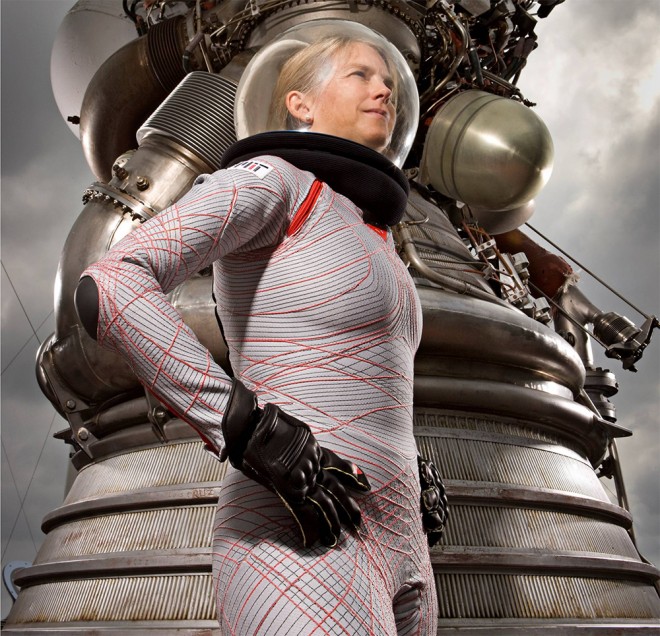
The same approach can be used on the Moon. Also the ideas for making fuel on the Mars surface for feedstock hydrogen from Earth - we can use it for fast telepresence rovers exploring the surface, and for robotic avatars which might be quite energy guzzling to start with. SpaceX's supersonic retropropulsion could be used to land multi-ton robotic missions on Mars.
Then there are many ideas for exploring Mars with robots, and we'll need more ideas there. Requires just as much invention to explore it robotically. The jumping cave bots, flying entomopters (fly like a bumble bee in the thin atmosphere), and so on, see my Soaring, Buzzing, Floating, Hopping, Crawling And Inflatable Mars Rovers - Suggestions For UAE Mars Lander
And the in situ search for life on Mars will revitalize the whole field of astrobiology. Astrobiologists have been designing instruments to send to Mars since before Viking, to search for life in situ. We have an extraordinary array of instruments designed over the last decade, and maybe at last they will get a chance to fly them.
Indeed, keeping the surface of Mars free of Earth life, of maximum interest for science, is the best way, I think, to make sure we have a long term interest in the planet, rather than a short term mission like Apollo that starts and then almost immediately stops.
And meanwhile we'd be doing really exciting things closer to Earth. For instance, things like the human factors research in LEO. Astronauts find this sort of research very interesting, to be taking part in experiments to learn how to survive better in space long term.
And I think if we went very quickly to Mars, necessarily without any lifeboats, that there's a strong possibility of a disaster like Apollo 13, that doesn't have such a happy ending, which could really be a downer for human spaceflight. I think we need a step by step approach, as for Apollo. We might make such rapid progress that we feel we are ready for a humans to Mars mission early on, but if our "shake down cruises" closer to Earth, in LEO or at L2 turn up problems, maybe we shouldn't do it for some time until we sort out whatever the problems are. A triply redundant system is not much good if all three copies of it have similar problems.
So in short, some of the research can be used for the Moon. Some for Mars robotic exploration. And some for human missions to Mars orbit and flybys. And by the time we've done all that, if we are not in too much of a hurry, maybe we've learnt enough about Mars to make more informed decisions about what to do next.
This section originated as a Quora answer
It was run by Forbes magazine as
The debate about going back to the Moon focuses on the commercial value of the Moon, for exports to LEO, to Earth or to other locations in outer space, see The Moon is resource rich. But what about Mars, does it have any commercial value for exports to Earth or anywhere else? This is relevant whether or not we send humans to the Mars surface, so let's forget about planetary protection issues for this section. If there is anything of great commercial value on Mars then either
Elon Musk has said several times that he doesn't think there will be anything material from Mars that would be worth transporting back to Earth.
"I don't think it's going to be economical to mine things on Mars and then transport them back to Earth because the transport costs would overwhelm the value of whatever you mined, but there will likely be a lot of mining on Mars that's useful for a Mars base, but it's unlikely to be transferred back to Earth. I think the economic exchange between a Mars base and Earth would be mostly in the form of intellectual property. Anything that can be transmitted by photon, that's the most likely exchange of things that will occur"
(Elon Musk, 2012. Video: the future of Energy & Transport : 1: 15: 20) - and more quotes like this from him.
Robert Zubrin covers this in more detail:
"Another alternative is that Mars could pay for itself by transporting back ideas. Just as the labor shortage prevalent in colonial and 19th century America drove the creation of Yankee Ingenuity's flood of inventions, so the conditions of extreme labor shortage combined with a technological culture and the unacceptability of impractical legislative constraints against innovation will tend to drive Martian ingenuity to produce wave after wave of invention in energy production, automation and robotics, biotechnology, and other areas. These inventions, licensed on Earth, could finance Mars even as they revolutionize and advance terrestrial living standards as forcefully as 19th Century American invention changed Europe and ultimately the rest of the world as well."
I discuss this in the next section, Would a space colony survive with only exports of intellectual property to pay for imports?. So will set it to one side for now and look at the other suggestions.
Elon Musk is skeptical about space mining generally thinking it probably won't be possible to export from the asteroids - "I'm not convinced there's a case for taking something, say, platinum, that is found in an asteroid and bringing it back to Earth." Of course many think that this will be possible. Myself I just don't know, I've heard the arguments on both sides and remain on the fence here.
Anyway Elon Musk doesn't go into any more detail about the case for or against material exports. Robert Zubrin however has discussed this in a paper "The Economic Viability of Mars Colonization " in the Journal of the British Interplanetary Society from 1995, and later on in the Interplanetary Commerce section of Case for Mars. He first outlines the need for exports to make a Mars colony viable:
"A frequent objection raised against scenarios for the human settlement and terraforming of Mars is that while such projects may be technologically feasible, there is no possible way that they can be paid for. On the surface, the arguments given supporting this position appear to many to be cogent, in that Mars is distant, difficult to access, possesses a hostile environment and has no apparent resources of economic value to export. These arguments appear to be ironclad, yet it must be pointed out that they were also presented in the past as convincing reasons for the utter impracticality of the European settlement of North America and Australia."
..."While the Exploration and Base building phases can and probably must be carried out on the basis of outright government funding, during the Settlement phase economics comes to the fore. That is, while a Mars base of even a few hundred people can potentially be supported out of pocket by governmental expenditures, a Martian society of hundreds of thousands clearly cannot be. To be viable, a real Martian civilization must be either completely autarchic (very unlikely until the far future) or be able to produce some kind of export that allows it to pay for the imports it requires."
..."Mars is the best target for colonization in the solar system because it has by far the greatest potential for self-sufficiency. Nevertheless, even with optimistic extrapolation of robotic manufacturing techniques, Mars will not have the division of labor required to make it fully self-sufficient until its population numbers in the millions. It will thus for a long time be necessary, and forever desirable, for Mars to be able to pay for import of specialized manufactured goods from Earth. These goods can be fairly limited in mass, as only small portions (by weight) of even very high-tech goods are actually complex. Nevertheless, these smaller sophisticated items will have to be paid for, and their cost will be greatly increased by the high costs of Earth-launch and interplanetary transport. What can Mars possibly export back to Earth in return?"
(emphasis mine)
So according to his ideas, the Mars colony is supported on the basis of outright government funding for the early stages of exploration and base building. He thinks that in these early stages you need something over and above ISRU (In Situ Resource Uitilization) for a commercial case unless the base is autarchic - a word which usually refers to individual liberty and governing oneself - but in this context I think he must mean, producing everything it needs, independent of Earth.
So it is rather similar to Elon Musk's idea except that in Elon Musk’s vision, the settlement is supported by private funding from Earth in the early stages rather than government funding. I will discuss that later in this section (under the idea of using the free return flight in an empty BFR to sustain the colony).
Robert Zubrin's idea of it being paid by the government initially would work. But it's a huge outlay of probably many trillions of dollars (or a very small colony of maybe a half dozen people) and what US government or any government is going to commit to that?
If they do, how do you know they will continue to do so through the next presidency, with the US feeling the pinch as a result of spending so much on trying to set up a Mars colony? Especially with e.g. high profile crashes and a 100 people dying on Mars with Elon Musk's idea of transporting 100 at a time to Mars? However much one president who really got on board this project might enthuse the US population, after the first few humans on Mars they may well yawn and lose interest in the project with the next president.
Zubrin then discusses the possibility of ores on Mars, and we'll come back to this later in this section:
..."Mars may have concentrated mineral ores, with much greater concentrations of ores of precious metals readily available than is currently the case on Earth due to the fact that the terrestrial ores have been heavily scavenged by humans for the past 5000 years. It has been shown that if concentrated supplies of metals of equal or greater value than silver (i.e. silver, germanium, hafnium, lanthanum, cerium, rhenium, samarium, gallium, gadolinium, gold, palladium, iridium, rubidium, platinum, rhodium, europium, etc.) were available on Mars, they could potentially be transported back to Earth at high profit by using reusable Mars-surface based single stage to orbit vehicles to deliver the cargoes to Mars orbit, and then transporting them back to Earth using either cheap expendable chemical stages manufactured on Mars or reusable cycling solar sail powered interplanetary spacecraft. The existence of such Martian precious metal ores, however, is still hypothetical."
In his section on Interplanetary Commerce in “Case for Mars” page 239 and following he also suggests deuterium as an export. I'll look at that below, between the section on geological products and the section on fuel exports.
He then goes on to suggest that Mars may play a crucial role for supply of ores and other exports to the asteroid belt once we have humans living there. He suggests Phobos and Deimos may also be valuable as a staging post on the way to the asteroid belt. Which may be true, but that's a rather later stage. I'm interested here in the earlier stages before we have large numbers of humans in the asteroid belt.
Do correct me if anyone knows of any other papers with detailed discussions of possible exports from Mars. That's all I've been able to find so far.
However it is discussed a fair bit online in places like Reddit, and the various Mars forums and spaceflight forums, and enthusiasts have suggested many other ways that they think a Mars colony could become profitable. So what I present here is based on that, as well as some thoughts of my own.
So, let's look at this a bit more closely, is there anything physical that could be worth exporting, (apart from the science value of the search for life and the information returned). Also is there anything worth exporting at a reasonably early stage such as the first few decades of a human exploration of Mars either on the surface or telerobotically from orbit?
However, the price would go down quickly as we get more samples from Mars of the order of tons of material. You'd only return as much as was needed for the scientific research you need to do due to the high price of return of material from Mars.
Also, individuals might want to buy Mars rocks at high prices, but only for as long as they are rare. This would be like supporting a lunar mission by returning and selling Moon rocks. The first few rocks could be valuable to collectors, and if they were issued with a certificate of authenticity as the first rocks to be returned from Mars or the Moon maybe the first few rocks would retain their value. But longer term, how many people would want to buy into something of continually reducing value?
The only reason to buy Mars rocks would be because you want to study them scientifically or - for the kudos of being one of the first people to own a Mars rock. You know that this rock you paid a million dollars for will soon be worth only a thousand dollars. Even with a certificate of authenticity as one of the first Mars rocks returned TO Earth, it's value is still likely to go down by a few orders of magnitude as they become more common - like "Interesting, but so what". But if you are a billionaire it may still be worth the extra bragging rights that you had a Mars rock before anyone else. It might get a few takers but not nearly enough to support a colony.
You'd think they must be rare or we would have spotted them on the surface. There's no sign at all of outcrops of oil shale. But on the other hand - cosmic radiation is very damaging. Would there be anything left of a surface oil shale deposit after billions of years?
It's an exponential process so you get very rapid reductions. Every 650 million years you get a 1000 fold reduction in the concentrations of small organic molecules such as amino acids on the surface because of cosmic radiation. So that's a million fold reduction every 1.3 billion years.
Cosmic radiation has little effect over time periods of years, decades, centuries or millennia. But over time periods of hundreds of millions of years the effects are huge. After 1.3 billion years, a thousand tons of amino acids gets reduced to a kilogram, with the rest converted mainly to gases like carbon dioxide, water vapour, methane and ammonia. After 2.6 billion years it's down to a microgram (millionth of a gram) and after 3.9 billion years you are down to less than a picogram (a millionth of a microgram) of your original thousand tons deposit.
So, I don't think absence of these deposits on the surface, at least ones easy to see from satellites, really shows that they don't exist below the surface. There could be millions of tons of organics from past life ten meters below the surface, and our rovers so far would probably not spot a thing. The organics of course also have to be there in the first place (surely likely to be patchy, in some places more than in others) and buried quickly - if it took several hundred million years to bury them, much of the organics would be gone also.
Oil itself is surely not worth the trouble of mining to return to Earth. But if there was some unique biological product on Mars that we don't have on Earth - which you could mine to find there, maybe that could be worth returning to Earth.
Mars could potentially be competitive with Earth for export of food for use on spacecraft and other space colonies due to the much lower launch cost, provided that the costs of growing the crops on Mars are also comparable to Earth's (quite a big if in the early stages).
But what about greenhouses in space? It would also have to compete with those. This would require it to be much easier to build a greenhouse on the surface than in space. Since it's a near vacuum and also has such huge diurnal swings in temperature, I'm not sure that it has much by way of advantages over, say, Phobos or Deimos, or indeed the Moon which has much less delta v than Mars. Even for export to Mars orbit, it could be as economical or more so to export from the Moon for foodstuffs that can keep for months long transport journeys. See section above: Greenhouse construction - comparison of the Moon and Mars
It could be more economical to export from Mars to Mars orbit rather than from the Moon perhaps for food that can spoil quickly, though this is not a net export from the Mars system. Another thought, if the natural Mars gravity was an advantage, and for some reason, easier to use than artificial gravity, perhaps it could be worthwhile.
It could also be worth doing if conditions on Mars let you produce unusual food or decorative plants more easily. As an example, it could be worth doing, if you can grow rare flowers on Mars that are very expensive to grow elsewhere, or similarly unusual and tasty rare new food stuffs that grow best on Mars for some reason, perhaps genetically designed for Mars conditions. This is related to the next topic:
Continuing to
Products you could export could include
For this to work there must be some reason they can't be grown on Earth
This case might also be another reason to be really careful not to contaminate Mars with Earth life, so that you can continue to grow the native Mars life there without interference from Earth life to make unique products that can only be produced easily from the native Mars life.
However, even if you can't grow the products safely on Earth, at some point you'd have the capability to grow them in Stanford Torus type habitats, biologically isolated from Earth and designed to mimic Mars conditions. Still, by the time that's feasible, export costs from Mars could go down at the same time that prices of such habitats go down, so keeping Mars competitive with them.
This does seem a potential early export that may continue to be commercially viable for quite some time, maybe even indefinitely. But it depends entirely on what we find as we search for life on Mars and also on how easy or safe it is to grow them on Earth, the Moon or elsewhere.
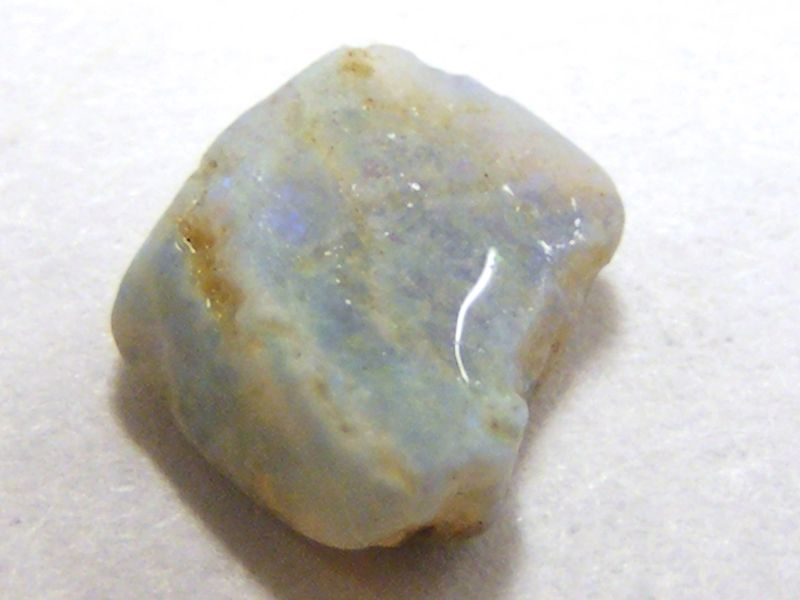
Raw opal found in Andamooka South Australia - photo credit CR Peters
Mars is different from asteroids or the Moon here, so it could have unique deposits. It's the only place we know of with deposits formed in ancient seas billions of years ago and its past and present climate is unique too. It might have unique minerals of decorative value.
What about:
Remember, that
So, in short, it has to be competitive with platinum, gold etc. mined elsewhere in the solar system, and you have to bear in mind that the prices you can get from Earth will surely go down, or else your exports are limited to keep the prices artificially high. On the other hand if the material you are mining is very valuable, and launch costs are low, perhaps the margin due to cost of export from Mars doesn't make such a big difference. E.g. suppose the launch costs a few hundred million dollars but you are returning tons of material, worth billions of dollars, perhaps it doesn't matter so much that a few percent of your product's price is due to transport. Maybe other elements of the price such as mining are somewhat less expensive than they are for asteroids?
However for this to work, there has to be a reason why other elements of the cost of mining are low. Asteroids and the Moon have the advantages of:
It seems unlikely that the thin Mars atmosphere would help much with mining operations. Would the Mars gravity help, or be a hindrance? And the large temperature swings from day to night, could they help in any way to make it easier to mine materials?
Elon Musk says that prospective colonists with half million dollar homes will sell their homes to go to Mars and he says this is how the colony will sustain itself to start with through the sale of the homes of its prospective colonists. Here is his interview where he says so (on the SpaceX channel):
What is the Business Model for Mars?
If you get colonists who pay in advance for their flight out to Mars - and they use the Mars Colonial Transporter - a 100 people at a time, if SpaceX succeed in producing that spaceship - then the spacecraft has to come back to Earth after every run to transport colonists to Mars, and would be able to take exports with it, which is essentially free transport. So there would be a multiplier effect there of the original passage fee.
However unless the products are already worth returning for one of the other reasons, then at most they could get back their original passage fee by selling the material. Otherwise you'd have a case for sending empty colonial transporter ships to Mars just to return the products.
So, you'd get exports, yes, for as long as the colony continues to expand rapidly. However, that's not a business case in the long term, as it's not going to be sustainable, as a way of supporting a colony there. Even if they can get their money for the flight back from the goods returned from Mars, they then have to support themselves on Mars indefinitely, not just pay for the flight out.
And with increasing numbers of colonists on Mars, each new colonist adds to the numbers of colonists that have to go out there every year to support them with the passage fees. Suppose for instance that 1 colonist needs one extra colonist a year to bring enough into the economy of Mars to support them. So you start with 1 colonist. Next year you have 2, and next year 4, next year 8 and so on. It is similar for any other ratio of numbers of colonists needing to arrive each year to support each colonist there. You are talking about an exponential progression, and that gets large very rapidly.
If you get increasing numbers of spaceships sent there to send them their supplies, again you need to pay for that somehow.
So, I don't think relying on the nearly empty transporter as it returns to Earth as a way to support the colony is likely to work long term. It works only as long as you have exponentially increasing numbers of colonists going to Mars and nobody coming back or few people coming back.
At most it's a doubler effect. And it is hard actually to see how the colonists could pay even to get established on Mars with a habitat and a spacesuit, surely the minimum you need.
After all, even spacesuits currently cost two million dollars each and are good for a couple of dozen or so space walks from the ISS (much less wear and tear than you get for a Mars suit) and need constant servicing. Even if they are reduced in cost ten fold, it's $200,000 each, and they will need to be repaired - and will need to be replaced from time to time. Then what about the cost of your habitat on Mars? It will probably cost hundreds of millions of dollars. And it will have a finite life - if it is like the ISS it will last a few decades before most of it has to be replaced.
You have got to Mars, but you are planning to live there for the rest of your life and raise a family there too, presumably, or it is not really a colony. Your half million dollars won’t last long. Some is gone on the ticket out there - Elon Musk says the ticket price is $200,000. So after buying your spacesuit as well, now you have a $100,000 deposit on your (much smaller) habitat on Mars and that’s your half million dollars already gone before you have done anything on Mars. Suppose you can earn $200,000 by returning materials you found on Mars to Earth in the empty return flight you get for free with your ticket price (assuming they do it that way). So now your deposit on your habitat is $300,000. There is still no way you are going to make any more payments on your mortgage for your habitat. Never mind sustain yourself on Mars. And Mars as a whole has made a loss on you, you have got there and you start with a debt and you have a very expensive mortGage to pay off now. With no way to earn anything to pay for it.
What next?
I don't really see how that's going to work. It is only possible if there is some other way to pay for it on top of the passage fee and the money they pay for a spacesuit and deposit on the habitat.
After the initial romance of being “the first settlers on Mars” is over, would there be such huge demand to retire to Mars with not so much by way of home comforts as Earth and far away from their friends, relatives and children? Many older people take a lot of interest in their younger relatives and might not want to retire to Mars on their own and leave them behind on Earth.
Also, presumably the idea is that they can pay for the colony because they won't live long when they get there. But it doesn't work like that. If you have survived, say, to 65, your total life expectancy is much higher than for someone who has only survived to 20, because everyone who died before 65 are removed from the population at that point. Quote from here:
That's an average, so many of the population will live more than 20 years after they reach their 65th birthday.
It continues like that. The life expectancy of an 85 year old woman isn't 1.6 years, it's 7 years. The life expectancy of a 90 year old woman, if they live that long, is still 5 years. Then on top of that, they have to be healthy enough to get to Mars, so it would be biased towards healthier old people. Those figures are from the US social services life expectancy calculator.
Even if you only accept 90 year olds, you'll want super fit 90 year olds which mean they will probably live for more than five years, maybe a decade or more, especially with improvements in medicine.
So, we have to expect retired people to live for decades after they retire. They need more hospital care, and nursing than the general population. They may also get Alzheimer's, and are less strong, on average (some may be super fit of course, for their age, but still they are not quite as strong as a 20 year old, athletes "retire" at a young age). How could that work?
I can’t see the retirees migrating from Earth paying for their own requirements for the rest of their life. And if it is a mix of older and younger people, even more so, I can't see the retirees paying for the requirements of all the younger people for the rest of their life.
This again becomes a case where you would need exponentially increasing numbers of immigrants needed to pay for the colony, and exponential growth can’t continue for long. Of course retirees would have a place to play in a colony that can support itself financially, as in any society. Just saying that the one off sum of money that retirees pay to go to a space colony can't be used as an income to support it. It's just the same as for younger folk, they need some way to continue to support themselves once there. So we need to keep looking.
This is one of the main points in the International Commerce section in Case for Mars, and is also often mentioned in discussions, so I should go into it in some detail.
So first, let's look at the data on deuterium abundances in our solar system. Curiosity measured a deuterium to hydrogen ratio five times greater on Mars than in the Earth oceans, probably due to the loss of hydrogen from the upper atmosphere of Mars over billions of years. See Heavy hydrogen excess hints at Martian vapour loss. This is for near surface ice. The Mars meteorite studies also suggest another reservoir of water below the surface with a lower ratio of two to three times that for Earth’s oceans which probably comes from an earlier phase of Mars history. Meteoritic evidence for a previously unrecognized hydrogen reservoir on Mars.
Deuterium occurs naturally on Earth in water as 1 in 6,400 hydrogen atoms or 1 part in 3,200 by weight. On Mars it is one deuterium for every 1,284 hydrogen's. Though Mars has a higher deuterium to hydrogen ratio than Earth, it’s not the most abundant source of it in the solar system. Rather, Earth’s abundance is if anything rather low, compared with many sources although high compared to the concentrations in the Sun and Jupiter and hydrogen from the solar wind. The solar wind hydrogen trapped in the lunar regolith also has a very low deuterium concentration.
Venus has the highest deuterium / hydrogen ratio recorded in our solar system of 120 times Earth’s and so 24 times that on Mars in its atmosphere. Implications of the high DH ratio for the sources of water in Venus' atmosphere.
Most meteorites that hit Earth have close to terrestrial abundances of deuterium but some have very high levels. This meteorite has 13 times the abundance of Earth’s oceans, so more than twice the abundance for Mars (many types of rock contain hydrogen and so you can measure their deuterium concentrations, this is a chondrite meteorite ).
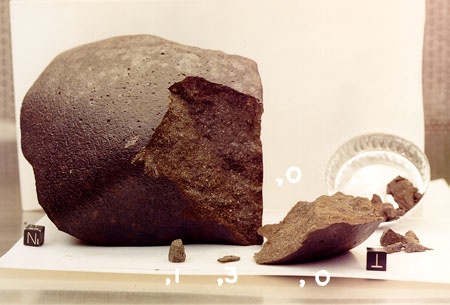
Antarctic Meteorite Lab Photo of Sample WSG 95300 - details about it here - the deuterium measurements for this meteorite are here: Deuterium enrichments in chondritic macromolecular material—Implications for the origin and evolution of organics, water and asteroids
(see table 2, the δD there is measured in parts per thousand relative to terrestrial abundances, so for instance δD +1000 for double terrestrial values)
Jupiter family comets have higher deuterium abundances than Earth, perhaps around three times terrestrial abundances as for Comet 67p from the Rosetta mission, though there is some question here about whether comet outgassing may somehow concentrate the deuterium and lead to over estimates of the abundances.
So is Mars the best extraterrestrial source for deuterium? And is it worth importing from space at all?
Currently the main use of deuterium is as a moderator in a nuclear reactor. You have the choice of enriching the uranium, and using ordinary water, which is the method used currently in many reactors, or of using ordinary unenriched uranium and heavy water, as is used in heavy water reactors such as the ones developed by India. That works because heavy water slows down neutrons without capturing them so permitting a chain reaction with a lower concentration of radioactive Uranium than light water which captures many of the neutrons.
However his quoted price of $10,000 per kilogram for deuterium seems a bit high. You can get 99.96% pure deuterium oxide for $1,000 per kg from Cambridge Isotopes. (Deuterium Oxide 100%) You can get 99% pure deuterium oxide for $721 per kg (Deuterium oxide 99%) Unless he’s referring to the price for pure deuterium separated from the oxygen?
99% pure deuterium oxide is sufficiently pure for the production of plutonium from uranium. Because of this application, the technology to produce heavy water is tightly regulated and the deuterium produced in a plant is tracked carefully. (For an example of how this is done, see "Selection of a safeguards approach for the Arroyito heavy water production plant" )
He says that the price of deuterium would go up if we develop deuterium / tritium fusion. I don’t really see that, since the main cost comes from extraction and there is no shortage of water to extract it from. Would a higher demand not just lead to us building more deuterium extraction plants, and a search for methods to reduce the costs using larger scale production facilities, for economies of scale, and other methods of generating it, which would reduce the price rather than increase it?
And what if some other form of fusion power turns out to be more efficient or have advantages over deuterium / tritium fusion? It’s a bit tricky arguing based on a technology we don’t have yet, and there are many possible ways of generating fusion power being explored at present.
He says deuterium would be a natural byproduct of electrolysis of water sourced on Mars, which would produce around one kilogram of deuterium for every six tonnes of water electrolyzed on Mars. However to do this then you have to add a deuterium / hydrogen separation stage to the hydrogen production plant. How easy is that? He doesn’t go into details of how it would work.
That 5 times enhancement over the deuterium in Earth’s oceans is still a long way from 100% concentration. It’s normally extracted by using many stages, and each time the amount of deuterium is increased. With only one atom in 1,284, or 0.078% consisting of deuterium you would still need to concentrate it many times over to reach 99% concentrations. For instance water electrolysis, one of the most effective methods of concentrating it, would increase the deuterium concentration 5 to 10 times each time it is used. The 5 times higher concentration on Mars would just save one stage of water electrolysis of many that would be needed. Though in practice electrolysis has such high energy costs it is best used only once for a final stage, for water that is already 50% D2O. The Argentinian plant uses methane as a feedstock because the hydrogen can be dissociated thermally from methane, much more easily than from water. Similarly for other techniques. There are many methods used to extract deuterium. Each of them requires many stages of concentration and I don’t see how an enhancement of 5 times in the feedstock would make a significant difference here.
So that then leads to the practicality of building and operating an extraction plant on Mars and providing the high power levels needed to extract the deuterium (the main reason for its high cost). If it needs vast amounts of electricity to do the separation, it’s not going to be worth doing I think. Also heavy water plants on Earth are large scale and massive structures. This is the heavy water plant in Argentina:
.jpg)
Heavy water plant near Arroyito, photograph by Frandres This plant produces most of the world’s deuterium, at a rate of 200 tons per year, and is powered by a nearby hydroelectric power station at Arroyito dam with a power output of 128 MW. (I'm not sure how much of that power output is used for the plant, do say if any of you know).
The equipment for extracting deuterium weighs 27,000 tons including the support structures and includes 250 heat exchangers, 240 pressure vessels, 90 gas compressors 13 reactors and 30 distillation columns. (Statistics from Arroyito Heavy Water Production Plant, Argentina)
Would the five times higher concentration of deuterium lead to more than a minor saving in the costs of the plant? And how would that offset all the difficulties of setting up and operating the plant with near vacuum conditions outside it, as well as transport costs for equipment that can’t be built on Mars?
Of course Mars is different in many ways and though most of them seem to be disadvantages for operating such a planet, could any of them be advantages, such major advantages that it makes it worthwhile to build and operate it on Mars? For instance, could the near vacuum of its atmosphere be made an advantage somehow? (E.g. for distillation).
On the face of it, there doesn’t seem to be a compelling commercial case for this. If there is, it needs to be spelt out in more detail.
Details here come from Heavy Water: A Manufacturers’ Guide for the Hydrogen Century and Future Trends in Heavy Water Production (1983) - has details of the Argentina plant. and heavy water.
Some of the internet discussions talk about this as a business case. The main issue I see with supplying fuel from the Mars surface is, would it compete with fuel generated on Deimos or indeed on the Moon for astronauts in orbit around Mars? Also, is methane valuable enough as a fuel in space, to make it worthwhile to export hydrogen to the Mars surface to convert into methane and return to orbit, or to split the hydrogen from water on Mars and use it to make methane?
That leads to the next idea:
This is the premise of the Deimos Water Company outlined by David Kuck. The delta v back to Earth is much less than from the Mars surface, and you can produce your own fuel for the journey. It would have to compete with volatiles on the Moon if those exist and are easy to mine. I think it's hard to judge this at present as we don't know what the volatiles are like on the Moon. We know they exist but don't know how abundant they are locally, or how easy or hard they are to extract. And so far we don't yet know for sure if there are any volatiles on Deimos, although spectroscopically it resembles a type of asteroid that often has them.
Supposing Deimos and the Moon have volatiles equally easy to extract, then the Deimos volatiles would still be favourable for use on Deimos and Phobos and for export to the Mars surface. They would also be favourable for delivery to Mars orbits such as Mars capture orbit at a delta v of 0.57 km / sec from Deimos. So, it would make a lot of sense for a base on Deimos to supply fuel to the Mars system. But that's not a commercial case for colonization. As Zubrin says - you need something over and above ISRU for a commercial case for exports you sell to pay for the things you can't produce there.
So we need to look into whether this can be competitive with the Moon for supply to the Earth Moon system. For the Moon to LEO the delta v is 5.7 km / second, and a bit more if supplied from polar regions - while it's 4.87 km / sec for Deimos to LEO which would seem to favour Deimos. However that does not take account of Hoyt's cislunar tether transport which could make the delta v for supply from the Moon to LEO almost zero.
So, in summary, there do seem to be a number of potential exports from Mars even at quite an early stage, although this is mainly based on internet discussions with not much actually published on the topic in peer reviewed journals. But they all depend on future discoveries so we won't know if this is possible until we know more about Mars. A few of the potential exports, involving exobiology, might require us to keep Earth microbes out of Mars.
There may also be exports from Deimos, but that depends on how easy it is to extract the volatiles, and if the lunar volatiles are as easy to extract as the ones from Deimos, then it might be hard to put a business case for export from Deimos to the Earth / Moon system, though it may be very useful for volatiles for spacecraft in orbit around Mars, on its moons or on its surface. As for exports to the asteroid belt, the chances are that they will find a way to mine their own volatiles out there, so it seems an unlikely case to me for the special case of volatiles.
Here I'm using the delta v figures from Hop David's cartoon delta v map.
Here are some of the online discussions I looked at. Of course they are not always 100% accurate. This is just enthusiasts discussing the topic, some more knowledgeable than others, and it may also contain a fair bit of nonsense in some of the discussions, so you have to filter and look up details to see if what they say is correct. Anyway if you are interested in doing that, see for instance:
Wikipedia also has a page on Space Trade, though there isn't much in it yet. Then there's Robert Zubrin's paper, already mentioned, and the Interplanetary Commerce section of Case for Mars.
That's about it, do let me know if you have more sources!
This is a nice idea in principle, to set up its economy - like another planet. Earth doesn’t need exports so why would Mars?
However the difference is that conditions are so hostile on Mars. Remember if you could do anything there, you could do it far easier in a desert on Earth. We have not yet got to the point where someone could do that.
Even if you had e.g. a spacesuit making factory in the middle of the Gobi desert then it would need imports, and the people in the factory would need to be fed, and their clothes imported and generally it would have loads of imports which it would pay for by selling its spacesuits to the rest of the world.
But you can't do that on Mars. Not until you have all that stuff already there.
I don't know if eventually you could, if you had big city domes and inside can do Earth industry with an ultra low maintenance outer skin to the dome - or if you paraterraformed it and covered it with a low maintenance reliable meteorite proof transparent roof over the Valles Marineres or something. Maybe then you have areas where humans can work on Mars as easily as on Earth and produce things at low cost locally. It might then have an economy that can work on its own without imports or exports to other planets.
But if so, there is a long way from here to there. Right now, there's no way that it would work unless you have exports to Earth from Mars to pay for your spacesuits and other high tech imports - or you have people on Earth with big pockets willing to pay out trillions to get a Mars colony underway.
As we saw, Elon Musk and Robert Zubrin both are skeptical about any possibility of material exports from Mars, at least in the early stages (though Zubrin thinks there might be a case for deuterium exports), and both think that a space colony could pay for imports solely through licensing of intellectual property to Earth. Robert Zubrin draws the analogy with the "Yankee Ingenuity's flood of inventions" which he says was due to a situation of acute labour shortage in the US in a technological culture, which would be paralleled on Mars. But how would that work in practice?
First, for US readers, I'd like to point out that this whole idea is based on a US perspective on inventions. I'm from the UK and we also talk about our country as the source of a flood of inventions, frequently. Here is an example.
"We're a nation of inventors, from the worldwide web to the electric vacuum cleaner - here's a rundown of our most influential innovations", intro to a list of the 50 greatest British Inventions from the UK in the Radio Times.
And putting aside national pride, which all countries have, surely for such a small country, we have indeed made many inventions here. We don't have the same narrative that it was due to a labour shortage, nor do we think of the US that way either. I'm not talking about historians here, but ordinary folk. Robert Zubrin's quote was the first I heard of this idea, which I assume from the way he put it, must be quite commonly accepted in the US. We just think that we are a nation of inventors, and leave it at that. We don't try to explain why.
At any rate if it's true of the US, surely it can't explain why we have so many inventions from the UK as we've never had a significant labour shortage. Indeed the opposite, here technology put many skilled people out of work leading to uprisings by working people during the industrial revolution followed by military repression

The leader of the Luddites - self employed weavers who feared getting put out of work by the newly introduced weaving technology of the late eighteenth and early nineteenth century, and replaced by less skilled workers. They destroyed industrial equipment in protest. Later on agricultural workers joined in, destroying threshing machines. The UK government responded by military action against them, executions, deportation, and they made destroying industrial machinery a capital offence. The US narrative that invention was the result of a labour shortage just doesn’t work when applied to UK inventions. It was almost the opposite, inventions caused a labour shortage here, at least of skilled workers
Let’s look at some of the metrics that measure the talent and creativity of a country. The rankings vary from year to year, but in 2015,
When you combine all these measures, the US comes second with only Australia ranked higher. So it doesn’t seem that being inventive is the most important attribute when it comes to becoming a leading technological nation. It is one of several factors. Availability of education, tolerance and openness to ideas also has a lot to do with it as well as the numbers of people in the creative classes in society. See list of the most creative countries and then for the detailed stats, Global Creativity Index.
Perhaps there is some correlation with labour shortage, for instance, Japan, second in the list of inventiveness by patent applications, is top in the list of countries facing acute skill shortages - but which way does it go? Does innovation lead to skills shortages or vice versa? The whole question is a complex one. Here is a survey of the literature from 2005 from the Department of Trade and Industry in the UK which looks at some of the drivers of innovation. The focus is more on trying to find ways to fill the gaps in skill shortages, and ways to encourage workers to get involved in innovation since innovation often comes from the less skilled workers - it also looks at different styles of innovation - the radical creativity that we may be most familiar with and incremental accumulation with a slow and steady pace of innovation.
I think it is hard to say for sure whether space colonies would be more innovative than countries on Earth on the basis of this information.
Also, the space colonists would be using many inventions from Earth, so surely they would have to pay many royalties in the other direction back to Earth? How could it be possible to set up a system where the Earth has to pay royalties to Mars and not vice versa?
And then - how also could it work, even if a space colonists did turn out to be much more inventive than Earth? The only people who would be able to earn foreign currency for imports to Mars would be the ones who make these inventions. But it's not enough to be inventors. They have to make their inventions into paying inventions also. And highly profitable inventions too, to pay for such items as spacesuits.
It’s best to think of spacesuits as more like mini spaceships than the suits of science fiction stories and movies, which are depicted as not much more complicated than wetsuits with aqualungs. They have to be pressurized to hold in atmosphere at a pressure of tons per square meter when surrounded by a vacuum, yet also flexible too with many joints, also able to withstand minute micrometeorites hitting at kilometers per second, and to keep the astronaut cool because the vacuum of space is a good insulator, like a vacuum flask. This makes them far more complex than any diving equipment.
A typical NASA spacesuit would probably cost about $2 million dollars to build from scratch - that’s as a recurring item, not including the initial design costs. It requires about 5,000 hours of work and would take someone who had all the necessary skills about two and a half years to build, given supply of all the parts and materials needed. I get those details from Space suit evolution (NASA). It’s possible that this could change with future designs. But that’s the current situation, and for the foreseeable near future.
I'm an inventor, and I have invented dozens of things (mainly games and software ideas) but I only earn dollars per day from them, and many have never been published in any form (attempted to publish some of them with no success).
Similarly I've written many original articles, but again, though I earn a bit from the kindle booklets, it's only a dollar or two a day, at present anyway. And that's not at all unusual. For instance I have many composer friends, but it is rare for them to earn a living entirely from composing.
As for composers, artists, writers, or other creative people, earning amounts that would let them buy multimillion dollar spacesuits for all their friends, and ship them to a space colony - well forget about it, unless the next Harry Potter is written on Mars. Even then, J. K. Rowling’s estimated wealth is 1 billion - enough to buy spacesuits for 500 people. She earns 23 million a year, enough to pay for 11.5 spacesuits a year. You’d need a lot of J. K. Rowling’s to support a large Mars colony.
Amongst all my friends and relatives here in UK, another country with a high proportion of inventors, then yes many of them are indeed innovative and creative and inventors in spirit. But I can't think of many that make a living from their inventions, especially just as intellectual property rights. It's the same also for software programmers - most independent shareware developers that I know, often authors of very inventive software, do it part time, and couldn't earn enough from it to support themselves or their families.
Only a few of all the people who invent things go on to make millions of dollars from their inventions, enough to pay for spacesuits and the like for all their friends and colleagues if they so wished. Even Elon Musk came close to bankruptcy once, in his worst year.
"We were running on fumes at that point," Musk says. "We had virtually no money... a fourth failure would have been absolutely game over. Done." Elon Musk in an interview with Scott Pelley, March 30 2014.
So there is a measure of luck there as well. SpaceX would not be here today if his fourth test flight had gone wrong.
So, if you had a million colonists, I don't think we can expect to have a million Elon Musk's. You might be lucky to have one. I think it is fair to say he is at least a one in a million success story. And however brilliant he is, would he earn enough just through intellectual property rights on Earth, managed remotely from, say, Mars, to pay for all the imports needed for a colony of a million people? Even a billion dollars a year of earnings is only $1000 per person which wouldn't get you far importing expensive components from Earth to Mars.
There's also the question of how that would work in practice. Is it going to be a communal system or even communist (in the good sense) where the inventor's earnings are used equally to support everyone? If so, where is the incentive for the inventor to not just invent, but to go to all the work to get their invention into production, or for entrepreneurs to join in with them? Or is it the case that the inventors who are successful are the only ones who earn anything in Earth currencies, and so are the only ones who can afford to import goods, and they then sell them on to the other colonists at any price they care to set in the local Mars currency? And what’s to stop them from emigrating to Earth once they become financially successful, especially since most of their earnings would accrue on Earth and the on the spot business decisions would be made on Earth, and the meetings with investors and manufacturers etc. would also be done there?
I'm not expert in politics or economics. I may well be missing something here. But it seems on the face of it to be quite a problematical way to support a colony. I'm interested in any thoughts on this - do say in comments on the Science20 articles or the kindle booklets pages or here.
On the face of it, at least, this seems a major advantage of the Moon, that you'd have many different revenue streams to pay for imports, at least potentially.
I haven't listed exports of Helium 3 for fusion here. Although it gets a lot of publicity, it's based on technology we don't have, and some experts think we will never have. Also, Crawford calculates (page 25)"* that manufacturing a square meter of solar panels on the lunar surface - which you can do by melting the indigenous silicon and using the high grade lunar vacuum to form panels in situ - would create as much power through solar power in seven years as you'd get from mining the same region for Helium 3 to a depth of three meters.
So, if mining for helium 3 is viable, this suggests that beaming solar power from the Moon back to Earth or to spacecraft in LEO would also be viable and a better business case than Helium 3. It may however be a useful byproduct of other mining operations on the Moon, for cryogenics, neutron detection, and MRI scanners, and possibly for fusion in the future. For details, see Helium 3 .
Of those, only the first, intellectual property, applies to Mars, at least in the early stages.
That is of course, apart from the ideas mentioned in the previous section, but they are none of them things we can count on right away, and some may depend on keeping Earth microbes out of Mars.
Also, if Mars geology could lead to unique gems such as the possible Mars opals of the previous section, then what about the Moon? Might it also have unique exports that can only form in the lunar conditions? For instance, could there be lunar gems?
Surprising discovery in 2008 - the near side of the Moon has large deposits of relatively pure chromite spinel, which is a gemstone on Earth. This was discovered from orbit. The moon rocks have small amounts of spinel mixed up in them, but this was a much stronger signal. Could the Moon have spinel gemstones? As with the Mars gems, if they exist, they probably wouldn't be worth the cost of returning to Earth unless they have something distinctive about them due to formation in lunar conditions.
Or might there be anything else unique to lunar geology that we might prize back on Earth?
For a profitable colony, I think the main thing in the very long term is how easy it is to maintain habitats and equipment in the years and decades into the future. If habitats have to be replaced every few decades (as for the ISS), and spacesuits similarly, the long term costs are going to be very high even if the startup costs are reduced.
As an example, the ISS cost €100 billion so over $110 billion, see How much does it cost? with a design life of about three decades (though it may be extended), and normal maximum number of inhabitants six. That makes the cost about 600 million a year or so per inhabitant with most of that due to the limited design life of the ISS.
The projected cost for the Stanford Torus was over $200 billion in 1975 US dollars for ten thousand inhabitants. That’s around a trillion dollars in 2016 dollars (Inflation Calculator), or a hundred million dollars per inhabitant.
If we can find a way to pay for a habitat as a one off cost, for instance through government funding, private funding, or it pays for itself commercially (the Stanford Torus was going to be paid for by exports of solar power from space to Earth), then the main issue after that is how to maintain it.
If the habitats costs a few hundred thousand dollars a year per inhabitant, then still, only the very rich could live there even after the build costs are paid off, and no matter how much the initial build costs are reduced, unless its exports are very valuable.
Then, if you can build the same habitats on Earth, for instance in a desert or floating on the sea, with no cost for its breathable atmosphere or cosmic radiation, solar flare and micrometeorite shielding, the exports from space have to be very valuable to make the space colonies competitive.
If you can reduce the maintenance cost to say hundreds of dollars per year per person then space does have some advantages over Earth, with no storms or earthquakes (depending where you build), no weathering from rain, wind, etc. Then a “home in space” might become a viable long term prospect.
On the downside you have micrometeorites, cosmic radiation, need for spacesuits etc. Can the cost of those really be reduced so much, or the exports from space be so valuable, that they compete with costs of maintenance due to weathering of buildings on Earth?
In this way, an easy to maintain colony will need exports mainly to pay for luxuries, while a hard to maintain colony will need many high value exports just to survive.
The three things here of most importance I think are:
1. An envelope that is low maintenance to preserve the habitat - to keep in air, and protect against any external hazards such as cosmic radiation, solar flares and micrometeorites.
2. A closed system biosphere inside - we need this for any long term space habitat as the logistic requirements and expenses are just too high otherwise. The variation in maintenance costs here would be mainly due to variations in how you supply light and heat to the habitat, and whether you get leaks of gases, water, and other materials that need to be replenished from time to time.
3. Maintenance and resupply of equipment for essential needs, for instance space suits, environment control, solar cells
For 2, I know a lot is made of the CO2 atmosphere for Mars but you don’t actually need much by way of in situ resource utilization. For instance if it is a reasonably closed system, you don’t need constant supply of water, CO2, or nitrogen. You just need to be able to top up any losses that there may be in the system. Plants don’t need a constant supply of CO2 to grow, they get the CO2 from the exhaled air of the astronauts. The astronauts in turn get their food and oxygen from the plants. In a biologically closed system those numbers all add up. If you produce enough food from plants, you automatically produce enough oxygen too and the astronauts eating that food produces enough CO2 for the plants to use in their next growth cycle, as the Russians proved in practice with their BIOS-3 experiments.
The costs can be reduced if you have a single envelope enclosing a large area, for instance a domed city or a cave or a Stanford Torus or O’Neil Colony style spinning space habitat. That’s because it requires less mass per volume to enclose a larger volume (area of envelope goes up as the square of the radius and the volume enclosed as the cube). So the launch mass and cost per inhabitant of maintenance for the envelope will be much lower for a larger colony.
The Stanford Torus design has 20 tons per colonist, or five colonists for every hundred tons of structural mass, excluding the radiation shielding. The ISS weighs 400 tons for up to 6 astronauts typically. As a Stanford Torus habitat, that much mass could support 20 colonists,s, and later designs are more efficient per colonist, for instance flattened torus or multiple levels inside the torus.
Apart from the radiation shielding, there isn't much difference between the Stanford Torus and other habitats on the surface of a moon or planet. The radiation shielding for the Stanford Torus would be supplied by mass drivers fed by bulldozers on the Moon, so doesn't need to be launched from Earth.
See also Using the Moon to build habitats in free space
The Moon scores over just about anywhere else for the early stages, because of the lunar caves - at least, if they are as large as the Grail data suggests. See Lunar caves. They may be up to kilometers in diameter and over 100 km long. That’s as much internal area as an O’Neil colony.
Somewhat smaller ones, of up to a few hundred meters across would be preferable because the mass of the atmosphere becomes significant for larger ones. If it is easy to convert them into a low maintenance envelope for the habitat, turning interior walls to glass perhaps, the maintenance costs might go right down. They would protect from cosmic radiation, solar flares, micrometeorites and hold in the atmosphere against the vacuum of space.
You might wonder about power requirements to produce food on the Moon with the 14 day lunar night. Robert Zubrin uses figures of 4 MW per acre for artificial sunlight in his Case for Mars (page 237) or about a kilowatt per square meter.
However the power requirements per habitant are far less than you might think as with efficient hydroponics, you only need 30 square meters per person, to provide 95% of their food and oxygen, from the BIOS-3 experiments. Also those figures for the power requirements to illuminate the crops must be for the older halogen lights. Modern LEDs are far more efficient and can be optimized to emit only the frequencies of light that are most useful for plant growth. The result is that you only need 100 watts per square meter or about a tenth of the figures in Case for Mars.
When you combine those lower power requirements per square meter with the small growing area needed per inhabitant from the BIOS-3 experiments, that makes it only 3 kilowatts per inhabitant, which you’d need for 12 hours a day. On the Moon you’d only need it during the lunar night (in the caves, you can use solar collectors on the surface and light pipes during the lunar day). That's 12 hours a day for the lunar night of 14 earth days, so 504 kWh in total. That’s a power level that could be supplied using solar cells during the lunar day then power storage such as fuel cells or batteries for the lunar night.
Alternatively you can lower the temperatures of the crops during the lunar night from 24 °C to 2.5-3 °C (which helps maintain plant vitality during darkness) and leave them in darkness, which results in edible crop yields reduced by 30 - 50%. So that would require up to double the growing area, or around 60 square meters per astronaut, and no need to supply extra illumination during the lunar night.
For more on this see:
For need for artificial gravity in the lunar caves, see:
However if you want to reduce maintenance to an absolute minimum in space habitats, well there is one other place that has far lower maintenance costs even than a lunar cave. It also has greatly reduced initial costs for the habitats as they are very low mass. It’s a surprising one to most of you perhaps. That’s Venus cloud colonies. So I’ll briefly mention those too.
Venus, just above the cloud top level, is in some ways the most habitable region in our solar system outside of Earth. The temperature and pressure there is the same as for Earth. There’s abundant sunlight, and clear skies. The atmosphere above you provides the mass equivalent of ten meters of water, shielding you from cosmic radiation and solar flares, also from micrometeorites - they are not an issue at all. Solar flares will cause large scale magnetic effects because Venus has no magnetic field to shield from them - but this is only an issue if you have kilometers long conductive cables - which are not likely to be needed.
Earth’s atmosphere is a lifting gas in the dense CO2 of Venus’ atmosphere. And just as with a weather balloon or airship - the pressure is the same inside and outside the envelope. So an airship could be filled with Earth pressure atmosphere with just a thin envelope to hold it in. Even if it is damaged, the air would leak out only slowly and the Venus acid filled atmosphere would also percolate in slowly too. Unlike any other space habitat, it would not be an emergency that you have to respond to in seconds, but something you could repair over a timescale of minutes or hours or even longer.
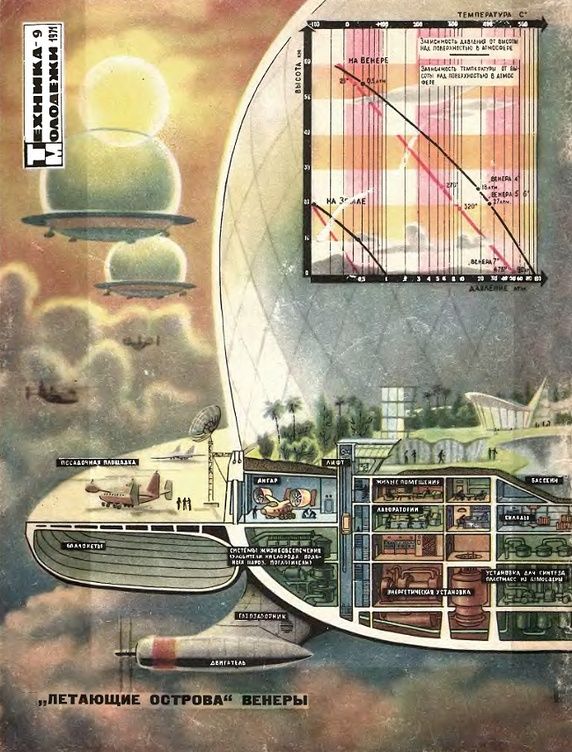
Russian idea for a cloud colony in the upper atmosphere of Venus, proposed in 1970s. This illustration is from Aerostatical Manned Platforms in the Venus atmosphere - Technica Molodezhi TM - 9 1971
This makes the Venus atmosphere the place offworld with the lowest maintenance costs of anywhere, I think. Also its atmosphere has all the main chemicals for life. It has carbon, oxygen, hydrogen, nitrogen and sulfur in abundance. The concentrated sulfuric acid is a source of water (it dissociates naturally into water and SO2 in the Venus sulfuric acid cycle). You can make plastics, and you can grow trees and other plants. You could even build new habitats using mainly wood and plastics and some thin layer to protect against sulfuric acid and UV light. To protect suits, airships, cloud colonies etc. from the acid involves covering them with an acid resistant coating, such as teflon (suggested here on the basis of tests simulating Venus atmosphere conditions).
Instead of $2 million spacesuits, you have acid resistant suits, which eventually you’d make locally, and aqualung style air breathers. This is a major saving since spacesuits are so complicated, and components for them when they fail would be a large budget item in any space colony I think.
Venus also has gravity levels identical to Earth, so if full Earth gravity turns out to be best for human health, this is easily achieved in the Venus cloud colonies.
Its long day may seem a disadvantage, as its solar day is a very long 116.75 Earth days. However the upper atmosphere super rotates once every four Earth days in a steady jet-stream like flow which gives the cloud colonies a two Earth day “night” and a two day “day” which is much more acceptable.
The cloud colonies also score at an early stage because you can launch a much larger habitat to the cloud colonies for far less mass per inhabitant. Or much more living space for the same mass sent to Venus. This would be an inflatable habitat like the Bigelow Aerospace idea - but one that is as lightweight as an airship.
Much of this will seem unfamiliar and unlikely to many of my readers. The thing is that ideas for Mars have been worked out in considerable detail, by the Mars colonization enthusiasts and the Mars Society etc. We don’t have any similar advocacy group for Venus or even the Moon. So there’s a tendency to look at everything with “Mars spectacles” and see how the Mars solutions would work on Venus or the Moon. And not surprisingly you find out that the solutions devised for Mars work better on Mars than anywhere else. But once you start looking at these other places in their own right, then a different picture may emerge.
If you are interested in this idea and want to follow it up further, see my Will We Build Colonies That Float Over Venus Like Buckminster Fuller's "Cloud Nine"?
So I think at least potentially Venus cloud colonies have the lowest maintenance requirements of all and might well hit that $100s per colonist per year figure at an early stage.
Still you need to pay back the initial build costs. The Stanford Torus was projected to take 22 years to build for 10,000 colonists at a cost of around a trillion in 2016 US dollars (see Building the Colony and Making It Prosper). A Venus colony wouldn't need anything like as much mass, for instance no regolith shielding is needed, you only need thin envelopes and there is no need to contain the pressure of an Earth atmosphere against a vacuum. The engineering is simpler as well. You could probably launch it all from Earth for a similar number of colonists over a similar timescale at a much lower cost than the Stanford Torus
But you still need some motivation for doing it. Even if it costs much less, and is easier to maintain once built, how can you do it if there are no profitable exports and they can't pay back the build costs? So let’s just look briefly at its commercial value for exports.
This depends a lot on how easy it is to export from Venus. That’s why I don’t see this happening in the very near future, for as long as you need massive rockets to launch from the colonies to orbit similarly to the ones needed for Earth. However JP Aerospace are working slowly and steadily on their idea for orbital airships. Even in the near vacuum of the Earth’s upper atmosphere, hydrogen and helium float in the near vacuum of oxygen and nitrogen. And that’s even more so with the denser Venus CO2 atmosphere. They accelerate using ion thrusters, slowly over several days, and meanwhile also rise higher and higher in the atmosphere. Eventually they break the speed of sound barrier - but by then they are so high it is an almost vacuum and it is not a problem.
Artist’s impression of orbital airship from JP Aerospace’s Airship to Orbit handout - this would be a very lightweight 6,000 foot airship which slowly accelerates to orbit from the upper atmospheric station using hybrid chemical and electrical propulsion over a period of several days
You need a staging post at a high level in the atmosphere for Venus or Earth where passengers and goods are transferred to a high altitude orbital airship which is much larger and lighter, designed for upper atmosphere operations. See my Projects To Get To Space As Easily As We Cross Oceans for an overview, also see their book: The Airship to Orbit Program
Note that this also applies to Mars too. Their orbital airships would be able to accelerate to orbit from the Mars surface with no need for an upper atmosphere staging post. If this is possible, then you could have both Venus and Mars as “garden planets” and Venus would score over Mars in that respect because the greenhouses would be far less substantial for a larger living area and much lower maintenance.
But the Moon also would have low cost exports because of its low delta v and because of Hoyt’s cislunar transport system which could reduce costs to almost zero (see my Exporting materials from the Moon)
Apart from this idea of a garden planet, it needs to be some product of the Venus atmosphere. Sulfuric acid is the obvious one, but not especially valuable. Might there be some really high value product? One possibility might be deuterium. As I mentioned in the discussion of Mars exports, Venus has a deuterium / hydrogen ratio 120 times Earth’s (and 24 times that of Mars) Implications of the high DH ratio for the sources of water in Venus' atmosphere. Instead of six tons of water electrolysis yielding one kilogram of deuterium, as is the case for Mars water, this would yield 24 kilograms of deuterium, or four kilograms per ton. However as for Mars, can we count on deuterium to be a valuable commodity in the future? And would the higher deuterium levels lead to more than a modest saving in the costs of extracting deuterium? Even with one atom in 54 consisting of deuterium, that’s still far from pure and would require many stages of whatever process is used. On the other hand unlike Mars, Venus does have abundant solar power, even more so than Earth, which may help. Still, as for Mars, this seems a bit of a stretch to me, unless some method is developed for making it much easier to extract deuterium quickly with minimal power requirements - but in that case costs would also be reduced hugely on Earth as well.
As for Mars, another possibility is products of indigenous life, as there is a small chance of life in the Venus clouds. There is indirect evidence in the form of asymmetrical microbe sized particles in the atmosphere and carbonyl sulfide, a clear sign of life here on Earth (though it could be created inorganically on Venus). See my: If there is Life in Venus Cloud Tops - Do we Need to Protect Earth - or Venus.
Again, as for Mars there’s the possibility of growing plants if conditions in the Venus clouds let you produce unusual food or decorative plants more easily, for instance, rare flowers on Mars that are very expensive to grow elsewhere, or similarly unusual and tasty rare new food stuffs that grow best on in the Venus clouds for some reason, perhaps genetically designed for those conditions, since the environment of the Venus clouds would be hard to replicate on Earth.
As for Mars, we have to explore Venus first.
Concept for a robotic airship called VAMP to explore Venus. It weighs only 450 kg, although its wingspan of 46 meters dwarfs the space shuttle . It would inflate while still in orbit around Venus attached to its mother ship, and then spiral down to the cloud tops in a slow motion re-entry that needs only minimal thermal protection. Incredible Technology: Inflatable Aircraft Could Cruise Venus Skies, details here Venus Atmospheric Maneuverable Platform It could explore the Venus atmosphere for years at the cloud tops, the same level that’s suggested for the Venus cloud colonies. Video discussion here.
At a later stage, we could send astronauts to explore the atmosphere using airships, then return to Earth as explored in NASA’s HAVOC concept study. See project home page. The return to orbit would be accomplished using something like the Pegasus air launched rocket. This is an internal study, so it's at an early stage at present.
NASA Study Proposes Airships, Cloud Cities for Venus Exploration. Technical details here.
Perhaps it’s possible that we might discover something of high value as we explore and study the Venus clouds. However, we can’t count on it at present.
I mentioned earlier that Robert Zubrin talked about the Mars system as a base to support asteroid miners in the more distant future. He thinks that Deimos and Phobos might be especially useful here. So, let’s just look at this for the more distant future. Intuitively, Mars is closer to the asteroid belt so you’d think, surely it’s the best place to support asteroid miners? However, the situation is not as clear as you might think.
First, asteroid mining is likely to start with NEOs - we get many asteroids that do close flybys of Earth, Venus or Mars, some with orbital periods close to the Earth or Venus year. The ones that do low delta v flybys of Earth seem the most likely ones for early mining operations after the Moon. We have dozens of large NEOs to mine first, kilometers in diameter. It’s not likely we’ll exhaust those any time soon, and this also has the extra benefit that we are removing asteroids that have the potential to hit Earth at some point in the maybe distant future. For NEOs ranked in various ways including commercial value, see astrorank.
We can also mine the Moon for asteroid resources - the Moon has been hit by many asteroids in the past, so whatever materials you have in asteroids are probably also on the Moon or in it. It's mainly a question of how accessible those materials are. There's some evidence suggesting that the Moon may have rich surface deposits of platinum (and so also of other metals) from the metallic core of the 100 km asteroid that created the Aitken basin as well as other iron rich asteroids and other asteroids of other compositions in the past (see Metals). The Apollo missions only explored a small part of the Moon and a few spots within that region and didn't travel far from their landing sites. Also they did nowhere near to a thorough survey of the places they did visit. They just didn't have the time for that, and only had a geologist there for the last mission. As for later investigations, you can only do so much with the few orbital missions we've had since then.
Then, when we do have humans in the asteroid belt, it's a lot of delta v to go from one asteroid to another and going via Mars doesn't help except on rare occasions. Most of the time, it will take much more delta v to get to an asteroid via Mars than a direct route, and the same is true for travel to / from Earth. Mars is only useful when you have an energy efficient trajectory that takes you from Mars to the asteroid, for instance via Hohmann transfer.
However, Geoffrey Landis has made a rather surprising observation here in his Colonization of Venus. See Accessibility of Asteroids from Venus in this paper. Even though Venus is closer to the Sun than Earth, because of Venus's faster orbit, the flight time to Ceres or Vesta is actually less from Venus than from Earth or Mars via Hohmann transfer. So Venus actually has advantages as a main asteroid belt mining hub over Mars, a bit counterintuitively. The transfer time is less and you have more opportunities also to get there because of Venus’s shorter year of 225 days instead of Mars’s 687 days, which is three times longer. So you’d get several opportunities to visit an asteroid from Venus for every single opportunity to visit it from Mars, though of course the delta v required is greater.
Hop David suggested the idea of Asteroid Cyclers to work in the same way as a Mars cycler, to cycle materials between Earth orbit and "railroad towns" colonies in the asteroid belt where the mining goes on. The same idea could be used to cycle materials between Venus and the asteroid belt.
Hop David has also suggested that Venus, and Mars would be good places to park large asteroids for mining operations - if it's too hazardous to risk parking them in Earth orbits. The Case For Asteroids. Of course this is for asteroids that already do close flybys of those planets.
Venus cyclers, like the more famous Mars "Aldrin cyclers", can get passengers from Earth to Venus by shuttling them to large spacecraft in permanent orbits that takes them back and forth between Earth and Venus over and over. The result is a somewhat shorter journey time than for Mars cyclers, and you can travel to Venus frequently, every 1..6 years instead of more than 2 years between visits. See his Case for Venus. If this happened, the cloud colonies could be useful for supplies to the asteroid miners, in return for supply of metals and other asteroid derived resources to the colonies.
So - though Mars might well be a useful staging post later on if we have a lot of people in the asteroid belt - the case is not as clear cut as you might think, and Venus might be as useful as Mars, even for supplies to the asteroid belt, depending on your priorities and the exact future situation. In the shorter term it might well be useful for mining asteroids that do close flybys of Venus, captured into Venus orbit temporarily for the purposes of mining.
So in short my conclusion is that the Moon is far superior over Mars in this respect and I am skeptical of the idea that a Mars colony could pay for itself via intellectual property. I just don’t see why the flow of intellectual property of commercial value has to be from Mars to Earth rather than vice versa or most likely both ways and I don’t find Robert Zubrin’s labour shortage argument in favour of that at all compelling.
Also it depends on not just inventing things but having the commercial talent to spot how to make the invention financially viable and the persistence and luck to take an invention all the way through to success. Why should Mars colonists be much better at this than anyone else? I don’t get it.
By contrast, I think a Lunar base could potentially be of commercial value, mainly because it has a low escape velocity and is so close to Earth and always at the same distance - especially so if something like Hoyt’s cislunar tether transport system is in place reducing transport costs almost to zero. It is also close enough for tourism to be a major industry eventually.
Mars I think will be the province of government sponsored or philanthropic explorations for some time - like Antarctica, where the return is not financial but scientific knowledge or just interest / excitement. I think that the initial stages of lunar exploration are also likely to be supported in a similar way - but that there is some possibility there of commercial value entering into the mix as well.
And I think we should explore Mars from orbit until we have a good understanding of surface conditions and especially not introduce Earth life to the planet. We could exploit it commercially from orbit through telerobotics, but that would depend on finding something there of commercial value to export. And I think conceivably there might be commercial exports from Mars in the future. Especially if the Mars biology produces some unique valuable biological product that can’t be made anywhere else - that might be worth exporting. But there’s currently nothing we know of that could be worth the cost of export from Mars, and whether there will be in the future, only the future can tell.
Longer term, Venus cloud colonies also seem of special interest. I suggest they are the least maintenance of all offworld habitats outside of Earth, so would need less income per habitant than any other space colony, but even so, it isn’t so easy to find a commercial case for more than an Antarctic style habitat maintained because of its science value and perhaps some tourism, because of the high costs of exports to orbit. Long term, if the orbital airships work out and reduce export costs to orbit almost to zero, perhaps Venus could be a place to grow food for export with the lowest mass and least maintenance greenhouses anywhere in the solar system outside of Earth. Orbital airships would also make Mars more commercially viable too. However, orbital airships would make it easier for Earth to export to space as well so both would have to compete with Earth, and of course the Moon.
In the more distant future both Mars and Venus could become a mining hubs for the asteroids, perhaps with asteroids parked in orbit around the planets for mining. In such a future, Venus, perhaps surprisingly, has some advantages over Mars for ease of access to the asteroid belt in terms of faster journey times and more frequent opportunities for travel.
The idea is to go to the Moon first before we decide whether to go to Mars, but while researching this book I've found many advantages of the Moon suggesting it's a far better place for humans anyway.
The main advantage of Mars, as far as a colony of hundreds of thousands or a million, is the somewhat higher gravity. But we don't know if Mars gravity is okay for human health, or indeed maybe lunar gravity is just fine. Or in both cases we may need to augment the local gravity. I cover this in What about gravity - isn't that a big advantage for Mars over the Moon? and Artificial gravity on the moon to augment lunar gravity.
The Mars surface also has some natural protection from solar storms due to its atmosphere, also Phobos's Stickney crater has advantages there too, however there's more risk for radiation on the journey to Mars or in orbit. In both cases it's possible to take precautions to prevent the worst effects. See Solar storms and radiation shielding - Moon and Mars
This is an idea from this book by William Burroughs, which had a lot of mentions for a year or two then seems to have been forgotten.
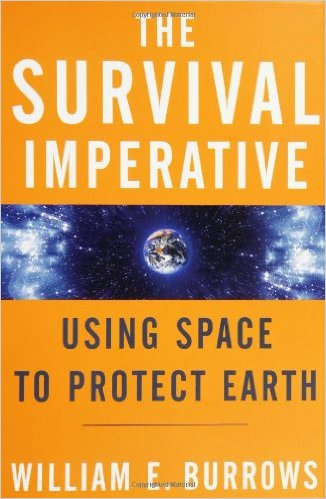
I find this suggestion much more plausible than Elon Musk's ideas of a backup on Mars. The idea is not to try to set up a colony that would survive the implausible complete destruction of Earth to the point that Mars is more habitable than Earth. Rather, it's more like a seed bank, like the Norwegian seed bank, but one on the Moon, combined with a library of human knowledge, and a small group of people who could sustain themselves there for a century or two if necessary until the time comes to return to Earth. And they could even restore humanity to Earth if they became extinct here (though this seems very implausible to me for the reason mentioned above that humans with stone age technology can survive almost anywhere on Earth from the cold of the Arctic to the hottest deserts, so we are amongst the least likely species to go extinct).
So anyway - this is an idea that's much more within our reach in the near future, to set up a colony on the Moon with sufficient supplies of the things they can't make on the Moon to last them for a century or two. Together with enough "lifeboat" spaceships to return to Earth easily, spacesuits to last them out / repairs for them etc. We don't need to make it totally self sustaining, just self sustaining enough for a small community of, say a dozen or a couple of dozen people to last for a few centuries.
And - I don't actually think we will lose all our technology on Earth, I think looking at past history that even when civilizations end, the technology doesn't vanish completely. Since the iron age, the world never lost the ability to smelt iron even though many small tribes can't do it. It never lost writing after it was invented. It never lost simple maths ideas like how to count, addition etc.
As it is now, I think we will never lose the place notation, fractions (quite a late development in maths), zero, and very very unlikely to lose algebra or calculus. Only a certain percentage can differentiate or integrate, but you don't need everyone to be able to do it to have a few teachers to pass it on to the next generation.
In medicine, we won't forget anesthetic, the microbe theory of diseases, the need for surgeons to wash their hands before surgery and nurses to keep clean, or vaccination,
I don't think we'll lose the ability to build airplanes either. Or bicycles. Both are really easy to do with a small amount of technology and mainly based on knowing it is possible and if we have engineering - even if we forgot most of it, we can reinvent it quickly.

The only remaining photograph of the original Colditz Glider made by British prisoners of war using bits of wood and wiring, including bed slats and floor boards. They designed it using details from a 1939 book Aircraft Design which they found in the prison library of Colditz.
And here is a video of the flight of its modern replica (no people on board, remote controlled for safety).
So, future humans could build a glider like this just based on a single book surviving from our era on the topic plus ingenuity and understanding of technology. You don't need very advanced tools to build a successful glider.
Probably similarly, our descendants in some such post disaster Earth won't forget the principle of the jet engine, or the rocket, even though they were innovative ideas at the time. Probably they would remember what a transistor is and the idea of an integrated chip even if we lose ability to make computers. They are not likely to forget how internal combustion works, or indeed steam engines. They would surely retain the knowledge of telephones, and of radio transmission. Once you know how to do it, it's easy to generate and receive radio waves, or to build a simple electric motor or generator.
Here for instance is how to build a simple "foxhole radio". You can alternatively use a crystal such as galena in place of the pencil and razor blade, and make one of the early crystal radios. You can use anything that rectifies the alternating current from the radio waves.
This is so simple, that it's surely unlikely that we'll lose the capability to listen to radio in some crude way or another so long as there are people around who understand some of the basic concepts of how radio works and are reasonably good with their hands, and we have access to wire and other basic components.
So long as some "higher education" continues, each generation teaching ideas to the next, or some library of books remains somewhere on Earth to explain these concepts to us, these ideas will surely not be forgotten. But we could lose the organization of society. Again I think we are probably in many ways much more robust than previous societies but looking forward, what if there was some "perfect storm" of nuclear war say, followed by a super volcano eruption, then maybe a giant impact just as we are recovering?
Possible "one-two punch" for dinosaur extinction. The Chicxulub impact surely was a significant factor in the extinction of the dinosaurs. Probably the earlier supervolcanoes of the Deccan Traps helped push the dinosaurs into a situation which made them more vulnerable - this artist's impression shows the Deccan Traps. That double whammy was separated by 100,000 years.
However a recent idea is that the asteroid impact itself could have triggered volcanic eruptions from the Deccan traps.
Could some closely spaced double whammy cause problems for Earth civilization? (Credit: Zina Deretsky for the National Space Foundation)
Even then I find it implausible that there wouldn't be some pocket of technology left. For instance after a global nuclear war, if we ever came to it, then the nuclear free zones such as Australia, New Zealand etc. would surely be spared and they have the entire Pacific ocean around them.

In this diagram, blue stands for nuclear weapon free zones. In these zones, even if the territories are owned by nuclear weapon states they have agreed not to station weapons there. This makes them very unlikely to be targets in a nuclear war. As you see, apart from a few islands, pretty much the entire southern hemisphere is free of weapons. Red stands for nuclear weapons states,, orange for territories where US nuclear weapons are stationed under a sharing agreement, and yellow for none of the above, but still subject to the non proliferation treaty. After a global nuclear war, should it ever come to that most of the Southern hemisphere would probably be unscathed and retain its technology.
This for instance is the South Pacific nuclear free zone, established by the treaty of Rotaronga. No testing, stationing or use of nuclear weapons permitted anywhere in this zone.
And with technology, even with a nuclear winter, or an asteroid impact winter, surely many would survive and carry through our knowledge and libraries into the future. After all we are not like the dinosaurs. With the most primitive of tools and our intelligence we can survive many things that would kill us easily without technology. It's only because of our technology of course, but that makes a huge difference. You don't get many great apes living in the Arctic or the Sahara desert.
But still, you could imagine that if we are unlucky and encounter turbulent political and environmental conditions, that we might lose some of our most important libraries, seed collections etc. If the billions of dollars semiconductor fabrication plants stop making computer chips, many of our modern machines depend on their output and could no longer be built. We could also lose the ability to send rockets into space, maybe even lose ability to make jet engines for a while. In that future, without computers and the internet, after living in a world increasingly dependent on it, perhaps we would indeed forget some of the vast store of our present day knowledge, even if we surely wouldn't lose it all.
All that knowledge could be preserved on the Moon so then later when we restore the ability to get into space we go up there and find it. Or else, if there's a small colony there, they can educate us via radio and come back to Earth when conditions are suitable here.
With present day technology, if we lose the capability to launch rockets into space, anyone living in a lunar colony could still return to Earth. That would be easy, using its "lifeboat" spacecraft which could be permanently kept next to the colony. But this would be a one way trip as there would be no way to return to the Moon without new large booster rockets to get them back into space again, along with a dedicated space launch pad and the staff and equipment to man it.
This may well change with future developments, if so, perhaps members of a lunar colony could return to Earth, refuel, pick up supplies, do what they can to help residents here, and go back to the Moon using just their own spacecraft without dependence on Earth. But until then, they would be dependent on supplies sent to the Moon in advance, to last them as long as needed for anything they can't make in situ on the Moon.
We don't actually need a permanent presence of humans on the Moon to preserve DNA and knowledge there. Some of the lunar caves probably have an internal steady temperature of around -20 °C (see page 5 of this paper). This is similar to the −18 °C for the Svalbard Global Seed Vault and should be perfect for an off world seed bank.
Entrance to the Norwegian Svalbard seed vault, photo by Bjoertvedt. The seeds need to be kept refrigerated, which is done using locally mined coal. A similar seed vault in a lunar cave would keep the seeds at the right temperatures by passive cooling.
As for preserving our knowledge, well we could leave physical written texts on the Moon, or we could leave engraved glass or diamond, or DNA, or radiation resistant glass DVDs amongst the various suggestions.
There is a Bible on the Moon already, perhaps it would be readable in the distant future?
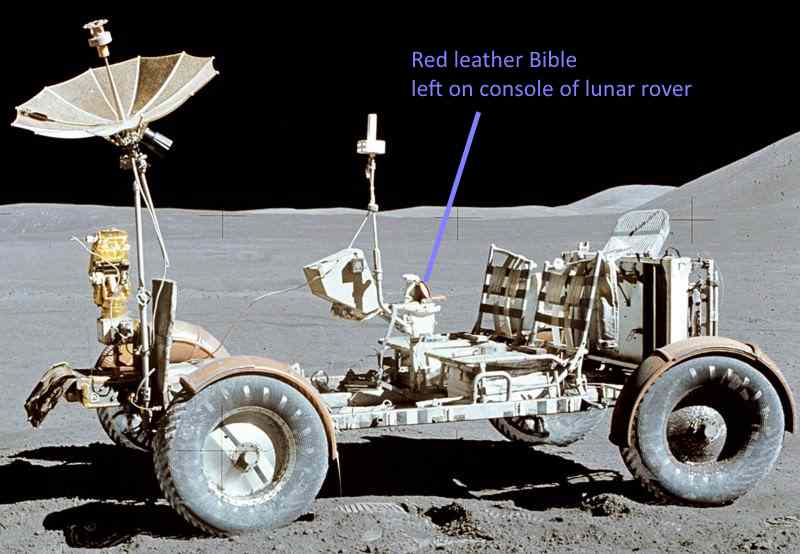
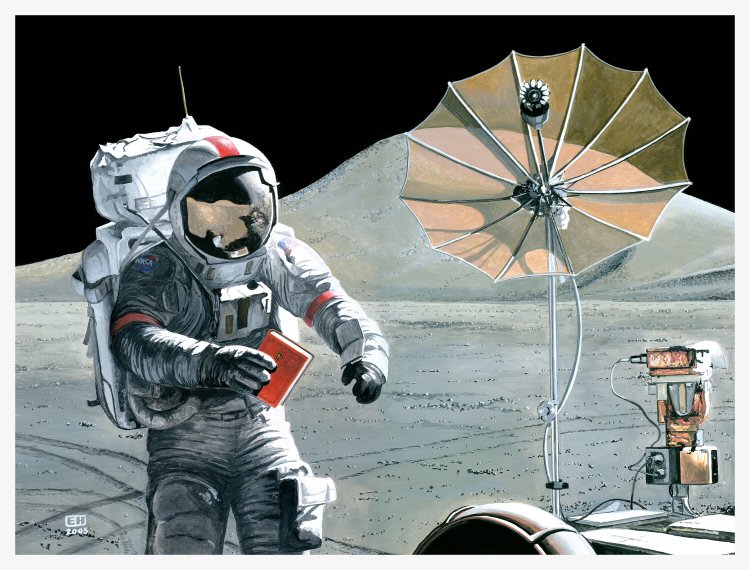
“A Moment of Reflection” painting by Ed Hengeveld depicts Apollo 15 Commander Dave Scott placing a red leather Bible on the console of the lunar rover before departing the moon.
There's a company wants to send a Torah to the Moon as a hand written scroll preserved in an airtight compartment. They asked SpaceIL to take it to the Moon but were refused, but eventually surely texts like this will be taken to the Moon. The idea is to preserve some of our most ancient texts as a project for preservation of culture. If they succeed, they would send other ancient texts later on such as the Hindu Vedas and the I Ching
Lunar Mission One have as their goal to send a spacecraft to the lunar poles to drill into the ice - and when the mission is over, to bury a capsule with both DNA from human hairs, personal messages, and a digital archive of Earth's knowledge.
Lunar mission one, artist's impression. The aim is to drill and obtain an ice core to return to Earth. But before it returns to Earth, it will put a digital archive in the hold buried deep below the surface at the lunar poles. See "A time capsule on the Moon".
The Part time scientists, one of the teams left in the Lunar X Prize challenge, as a partner with, are planning to take a disk with part of Wikipedia on it to the moon as Wikipedia to the Moon.
Back in 2004, Transorbital, a California based company was first to get permission from the US government to launch to the Moon, planned to use a decommissioned Russian ICBM for the task. They also had the idea to set up a server on the Moon for digital backup services for companies worried about security of data on the Earth after September 11. These plans don't seem to have come to anything though they did send a small satellite into orbit around Earth.
KEO is a more ambitious plan to send data into orbit in glass radiation resistant DVDs into an orbit that will decay and return the satellite to Earth 50,000 years later as a kind of a space time capsule. The idea is that everyone on Earth can store a four page message for the future. The DVD could be played on a DVD player - but of course in the future they wouldn't have our players so it includes information on how to build the player.
The KEO glass DVD is a bit like the idea of the Voyager golden record though in their case the record is in audio format like one of the old analogue records but more durable. We could send a copy of both to the Moon.
A copy of the Voyager record on display at the Udvar-Hazy Center in Washington Dulles International Airport
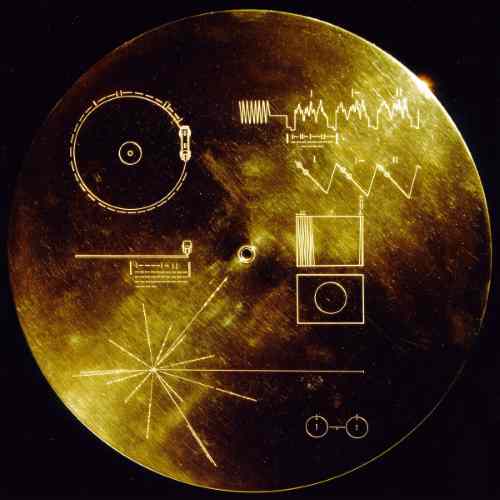
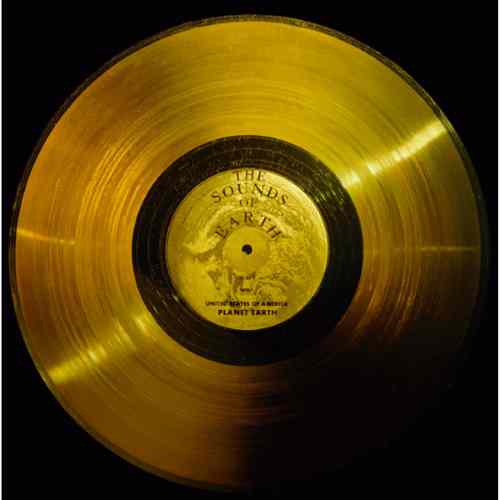
Photographs of the cover and contents, of the actual record sent on Voyager
See Contents of the Voyager Golden Record to find out what is on it.
As it gets easier to send missions to the Moon, I think it is certain that we will leave various physical and digital data repositories on the Moon. The idea of the lunar backup is a more extensive version of the same. We could build a seed vault / library / small human colony with supplies sufficient for at least a century or two on the Moon with no imports from Earth.
Examples of what it could preserve digitally include:
Physically it could preserve
And it could have human caretakers
It does have advantages over repositories on Earth, as the lunar caves provide perfect conditions for passive preservation of seeds and anything else that is best preserved in cold conditions in a geologically stable environment. The best analogue we have here might be in Antarctica, if we could arrange some backup in a cave excavated into the cold and stable conditions of some of the Antarctic mountains. Temperatures at the surface on the high Antarctic plateau seldom rise above 20 C, though they can dip down to below 60 C. So there may be places there also where you could build a passively cooled seed vault, which would cost far less than a lunar seed vault and be easier to supply. But you couldn't duplicate the lunar vacuum and very long term stability even over geological time scales. Also you would have to cope with the six months long Antarctic "night" for anything that requires solar power, while on the Moon it's a maximum of only 14 days of darkness, and less if close to the poles.
Of course, eventually, you would duplicate your lunar repositories. Especially you would have more than one copy of the most important information and materials on the Moon. You would need that as precautions in the remote chance that it gets a direct hit from an asteroid hitting the Moon. That's about the only thing that could happen there, and would be exceedingly rare, especially if it is located in a cave protected beneath the surface from most asteroids.
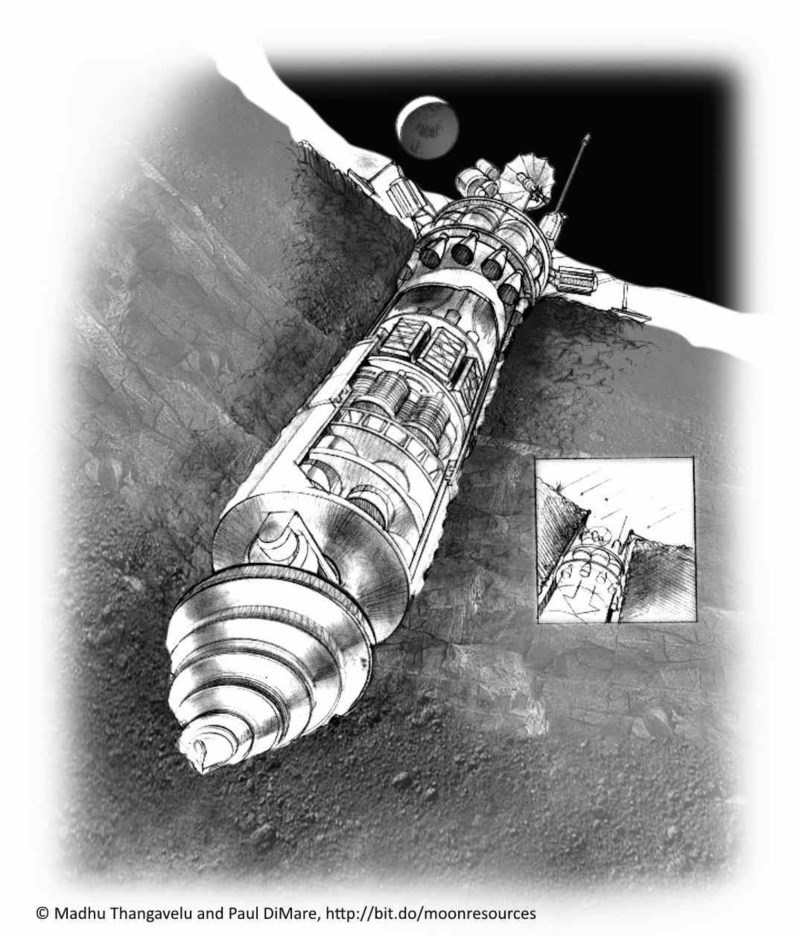
Future Humanity Archives on the Moon - Artist's impression, illustration by Madhu Thangavelu and Paul DiMare © from The Moon: Resources, Future Development and Settlement
Artist's impression of a vault on the Moon.
It's also scaleable. You can start off by just sending archives to the Moon which can't be read from Earth, but are there for future lunar visitors to discover. The next stage would be archives that you can read remotely from Earth, like the lunar server backup idea. And later, you could have a telerobotic facility on the Moon which can be controlled remotely from Earth, getting the telerobots to look up things that are stored there, even recover seeds and "post" them back to Earth. And then finally, presence of a small group of human "caretakers" normally rotating in and out every few years if they want to - but with sufficient supplies to last them out for centuries on the Moon if needed, with closed system recycling.
I'm not sure if this is really needed for a backup. Can we not do the same on Earth, as we are doing already with the likes of the Svalbard seed vault? Even set up an identical self sufficient small colony underground in Antarctica?
But it's going to happen anyway, at least in a limited way, and the passive cooling is a great advantage for seeds, which are also light things to send into space. It would also provide perfect conditions for long term preservation, for billions of years into the future, even for future civilizations on Earth. And, in my view, it seems a lot more practical than ideas of a "backup on Mars", because it is so much closer to Earth, more accessible if we ever need it, far easier for its human inhabitants to get back to Earth, and easier to communicate with via radio.
We have so many other things humans can do in our solar system, apart from the usual objective of colonization and boots on Mars. Including exploring the Moon, asteroids, Venus, Mercury, Jupiter's Callisto, Mars from orbit and its two moons, maybe even further afield. Plenty to sustain interest.
If the aim is just to "land boots on Mars / Moon / Venus / Mercury / Callisto" I think our space explorations to all these places will be short lived, just as they were for the Moon. And I happen to think that attempts at colonization would be short lived also, as they run out of funds, and can no longer get people from Earth to support their expensive attempts to live in places with a near vacuum, where they have to create all their own oxygen to breathe, etc. etc., and many of their needs, can only be met by supplies sent to them on rockets.
While settlement in space supported because of their benefits to Earth, with humans accompanied by robotic explorers finding out new things about our solar system, would grow and grow. Look at how much interest there is in Curiosity, the Dawn mission, Philae the comet lander, and the New Horizons mission to Pluto? And there's no sign that any country wants to pull out of scientific exploration of Antarctica.
We need some longer term positive vision, and what I outlined here is a suggestion for first steps towards an alternative to the usual colonization motivation for sending humans into space.
The main message is that whatever we do, with Mars, we should do it as a choice, not as an accident. We shouldn't just have a human occupied ship crash on Mars, and then say "Oops, we have now introduced Earth life to the planet". The main thing is that we shouldn't just jump off a cliff into the sea with our eyes shut and hope for the best. We need to understand what we are doing and to go in with open eyes.
So, then if we hold back from sending humans to Mars, this leaves all our options open. We can always send them next year, or ten years later, or fifty years or a century later. Mars will still be there. But if we send microbes to Mars in an irreversible way, this closes off many futures. For instance, maybe we want to introduce particular microbes to Mars only, maybe only methanogens, or methanotrophs, or photosynthetic life. Maybe we want to keep the predatory secondary consumers away from Mars until much later.
Or maybe we have an opportunity to set aside Mars for the Martians. There's plenty of material in the asteroid belt for human habitats. But perhaps on Mars we have the opportunity to restore an early Mars like early Earth, with pre-DNA life on it. Imagine how wonderful that would be. Or some alternative biology not based on DNA at all. Maybe that is one of the futures we would be closing off - to have an exoplanet in our own solar system, which has ETs on it, even if they are just microbial or lichen like ETs, with a totally different biology from Earth life.
When we have a choice that closes off futures for an entire planet, or for some vulnerable habitat, or unique form of life, I think we need to look long and hard at that choice. And whatever we do, we shouldn't do it just through carelessness, by accident, or without thinking through the consequences.
While when our choices are open ended, and open out to more and more future possibilities, as exploring the Moon seems to do, then that's a way forward that we should encourage and walk into with open eyes. We can follow a path like that with a sense of wonder indeed!
I was on David Livingston's "the Space Show" on 27th October 2016. It was a one hour and 27 minutes program, with many interesting questions sent in by email from listeners to the show.
You can listen to it here:
This is work in progress, and I'm interested to hear whether you think it is a positive vision for the future. Or is there anything else that could make it more positive? It might well be missing something that I just haven't seen yet.
Also do share your own visions for the future too.
And - what do you think about "boots on Mars"? Do you think there's a chance we will find a way to land humans on Mars compatible with planetary protection and preserving its interest for science? Or is this likely to be impossible? What about a crash on Mars, how does the potential for that change the situation?
Should we explore Mars in a biologically reversible way until we understand it better? If so, can you think of any way that could be done with humans on the surface, or should they remain in orbit?
Some think we should just land humans on Mars anyway. That we should do our best we can to study it scientifically first, and then, whatever the state of science, once the technology is there to land humans, forget about planetary protection and just land humans, taking the best precautions we can in the circumstances.
Is that your view? If so do say so. Don't be shy. I'm interested to hear all views on the topic.
The main reason for writing this is to stimulate debate on these topics, and to help make sure the debate is done with an informed background.
What do you think about these ideas? Do say in the comments on the online article - or you can start a discussion on the kindle booklet page. Or comment in the Case for Moon for Humans - Open Ended with Planetary Protection at its Core facebook group. Or just send me an email to support@robertinventor.online.
Also if you see any errors at all, whether typos, or more fundamental errors, please don't hesitate to let me know or say so in the comments. Thanks!
If you want to get alerts every time I do one of these posts, join my Robert Walker
- Science20 Blog Alerts facebook page.To get a red facebook alert every time I post a new science20 article, or post an idea for a new article, then select "all on" in the page's Liked drop menu above.
Or subscribe to the associated twitter feed.
For email alerts about once every month or so, subscribe to Robert Walker
's Science 20 blog Monthly Alerts on Google GroupsAnd I have many other booklets on my kindle bookshelf
 My kindle books author's page on amazon
My kindle books author's page on amazon
I've made a new facebook group which you can join to discuss this and other visions for human exploration with the Moon first, and with planetary protection and biological reversibility as core principles.
When I founded it, to discuss the approaches outlined in Case for Moon, I was so surprised that I couldn't find any other group on facebook for discussing Moon first approaches to humans in space, although it's easy to find groups for discussing colonizing Mars.
So, as the group description says, it's for anyone interested in a Moon first approach. With the vision in Case for Moon as one of many.
Case for Moon for Humans - Open Ended with Planetary Protection at its Core
You may also be interested in this group to discuss my newer book:
You can get notifications of new posts on my Science 2.0 blog by 'liking' my page:
You may also be interested in Moonwards, Kim Holder's Virtual Moon Colony project, to explore a vision of what a focused drive to settle the Moon could create. Listen to her talk about it on the Space Show.
If you know of any other good groups or websites focused on Moon first ideas, or on exploration of our solar system with planetary protection as one of the core values behind the exploration, do say and I'll add them in.
This is a test of a possible way of adding citations to my books. Amazon requires that you have a hyperlink in both ways to take you back to the text after you read the footnote.
The only solution I can think of is this one, which is just a test to see how it works - to cite the same paper multiple times, to use the same symbol for all the citations in both directions so an * to get to the footnote and a ^ to get back (for instance) - and since there are no natural page divisions in the web page version of the article - to put them all at the end of the chapter, or more easily at the end of the book like this: Maybe I can find a way to automate it e.g. using <ref> </ref> tags as for Wikipedia and a pre-processor to auto generate the links both ways. For now doing it by hand.
It would need to be autogenerated in some way to have numbers for the footnotes, so that the numbers still work when I add new cites or new material.
^"Lunar Resources: A Review", Ian Crawford,, Progress in Physical Geography, vol. 39, pp. 137-167, 2015
^"Lunar Resources: A Review", Ian Crawford,, Progress in Physical Geography, vol. 39, pp. 137-167, 2015
^"Lunar Resources: A Review", Ian Crawford,, Progress in Physical Geography, vol. 39, pp. 137-167, 2015
^"Lunar Resources: A Review", Ian Crawford,, Progress in Physical Geography, vol. 39, pp. 137-167, 2015
^"Lunar Resources: A Review", Ian Crawford,, Progress in Physical Geography, vol. 39, pp. 137-167, 2015
^"Lunar Resources: A Review", Ian Crawford,, Progress in Physical Geography, vol. 39, pp. 137-167, 2015
^"Microwave sintering of lunar soil: properties, theory, and practice", LA Taylor, TT Meek - Journal of Aerospace Engineering, 2005^"Lunar Resources: A Review", Ian Crawford,, Progress in Physical Geography, vol. 39, pp. 137-167, 2015
^"Lunar Resources: A Review", Ian Crawford,, Progress in Physical Geography, vol. 39, pp. 137-167, 2015
^"Lunar Resources: A Review", Ian Crawford,, Progress in Physical Geography, vol. 39, pp. 137-167, 2015
^"Lunar Resources: A Review", Ian Crawford,, Progress in Physical Geography, vol. 39, pp. 137-167, 2015
More new sections:
Minor changes:
New sections:
Minor changes:
(some of this also later in the day on 2nd)
Have added several of Madhu Thangavelu and Paul DiMare's wonderful illustrations from The Moon: Resources, Future Development and Settlement with permission from Madhu Thangavelu :).
New sections:
Added Buzz Aldrin quote about the ants to Why quarantine won't work - protecting Earth, and humans sent to Mars, from Mars life (if it exists)
Added calculation about rate of loss of water exposed to a vacuum to the section Liquid airlock
Added Uranium to: Thorium and KREEP (Potassium, phosphorus and rare earth elements), and some uranium
Added discussion of Deuterium to Commercial value for Mars
Added discussion of Luddites to Would a space colony survive with only exports of intellectual property to pay for imports?
Added mention of Gerald Kulcinski's helium 3 reactor to the Helium 3 section.
Added an image and a video to Orbital airships for Venus and Mars, also mentions VAMP - an interesting proposal for a robotic airship mission to Venus upper atmosphere, and HAVOC (again) I thought a good way to end it.
Also a small amount of extra work, formatting and discussion of what drives innovation to Would a space colony survive with only exports of intellectual property to pay for imports?
Added (See chapter II, Experiment M131. Human Vestibular Function in Biomedical results from skylab) as a citation for the mention of otoliths in Small centrifuge based artificial gravity experiments in LEO - about the hypothesis that the reason you don't get sick or dizzy in zero g when you spin like Tim Peake is because the otoliths which sense gravity along the spin axis on Earth are not stimulated in space when there is zero g along the spin axis.
Later in the day:
Some more work on the interplanetary commerce sections.
New sections:
Moved the list of processes that can concentrate ores to the head of the Metals section, and added meteorite impacts to the list.
Expanded Using the Moon to build habitats in free space with discussion of the mass per colonist.
Added calculation about RTGs to Power during the night and discussion of power storage for LED night time illumination of plants.
Divided the section Earth length day on Mars versus advantages of close to 24/7 solar power at the lunar poles up with two new sections Lower power LEDs for plant growth through the lunar night and Plants capable of good yields when kept in darkness for the lunar night
For Greenhouse construction - comparison of the Moon and Mars - added extra info to the image: this was for the Lunar Oasis proposal for a ten year program to establish a self sufficient science outpost on the Moon to act as a test bed for space settlements. A bit more work on Power during the night mainly presentation but also included a couple of new paragraphs on molten salt thermal storage and superconducting magnetic storage.
Added photograph of Joshua Lederberg to the Planetary protection section.
Added example of cocoa plants which produce theobromine which kills dogs if they eat too much chocolate, to Why quarantine won't work - protecting Earth, and humans sent to Mars, from Mars life (if it exists)
Added more Joshua Lederberg cites and a quote to Why quarantine won't work - protecting Earth, and humans sent to Mars, from Mars life (if it exists)
Bit more work on intro to We are like the early Antarctic explorers with photos of Shackleton's expedition and Everest.
Expanded the section on paying for space settlements through retirees in Commercial value for Mars, explains about life expectancy, how anyone who lives to 65 still has a life expectancy of about 20 more years in the US, and a 90 year old still has a five year life expectancy, so they still have to support themselves once there, can't just be a one off cost.
---
Added links to David Schrunk et al's "The Moon: Resources, Future Development and Settlement" to The Moon is resource rich.
Have done some copy editing of the sections of Case for Moon First used in my new article An Astronaut Gardener On The Moon - Summits Of Sunlight And Vast Lunar Caves In Low Gravity, including the sections Long shadows on the Moon, especially at the poles, added a photo of a marigold flower to Fertility of lunar and Mars soil
Work on the preface and new cover picture based on the famous Apollo 8 Earthrise photograph.
Added estimates of the total land area needed to feed the world by the various systems to the Fertility of lunar and Mars soil section. Added information about the mass of a typical heavy goods train and calculation of percentage of population that could be fed using BIOS-3 system using indigenous resources from the Moon to Can we fill lunar caves with air?
New section: Ballutes - return of high value resources such as platinum to Earth and copy editing of Exporting materials from the Moon
New subsection headers and some copy editing for:
Also added new material to this section with title changed
Also new cover image.
Added images to the preface, with captions, for the ESA village and for Shackleton's Endurance caught in the Antarctic ice.
Added some more on biological closed systems to CO2 on the Moon . Added a shorter versions of the contents list to the title page.
Typos, copy editing, and sizing of pictures. Also expanded a bit on Ideal location for radio and infrared telescopes to observe space and organized in bullet points. Added link to experiment on the Wake Shield Facility on the Space Shuttle to Solar cells from lunar materials - solar panel paving robot
Added Bigelow aerospace to Moon firsters - ESA, Russia, Many astronauts, Bigelow aerospace, former US Vision for Space Exploration etc
Added Myth of automatic terraforming
Added details about the 18.6 year axial precession of the Moon and it's value for liquid mirror telescopes to Ideal location for radio and infrared telescopes to observe space
Added Most habitable Gaia for Mars would have a methane atmosphere or some stronger greenhouse gas
Expanded the section on Ideal location for many types of radio and infrared telescopes and other observatories (now renamed)
copy editing and minor fixes
New section Solar power at the lunar poles with new material on TransFormers
Two dimensional planetary surface landers
Added link to See Toxicity of lunar dust to Lunar dust inhalation compared to Mars dust
Added lunar vacuum cleaner idea to Coping with the dust
Added NASA's lunar resource prospector to Robots first
Added Could some co-operation be possible between the US and an ESA village that incorporates China?
Added new interpretation of Ina depression to Geologically active moon
Updated Robotic missions to the Moon, already planned, or near future, from 2017 onwards to say that astrobiotic have pulled out of the competition in 2017 (but still plan to go there in 2018)
Corrected figures for Hybrid system - adding algae to an ISS type system. I said 17 kg per person but it was 18 kg per person on checking the cite.
Expanded Small centrifuge based artificial gravity experiments in LEO
Added Protection of the historical Apollo landing sites
Minor rewrite and subdivision into two sections of
New sections
Solar cells from lunar materials - solar panel paving robot - added layer by layer details of the composition of the solar cells proposed.
Power during the night - fixed mistake here - I'd misread Wh as kWh in one of the cites about Nickel Hydride batteries (oops) - fixed it. Also mention that keeping liquid hydrogen cool would be much easier at the lunar poles and also be a natural power storage system if you are already splitting the ice for export of fuel to LEO. Also tried the calculation for equivalent power per colonist of the ISS on top of the lunar agriculture.
Commercial value for Mars - added a bit more about Elon Musk and the video on the SpaceX channel of an interview "Business Model for Mars"
Liquid airlock - expanded with new sections:
More detail to Hoyt's cislunar tether transport system (new section)